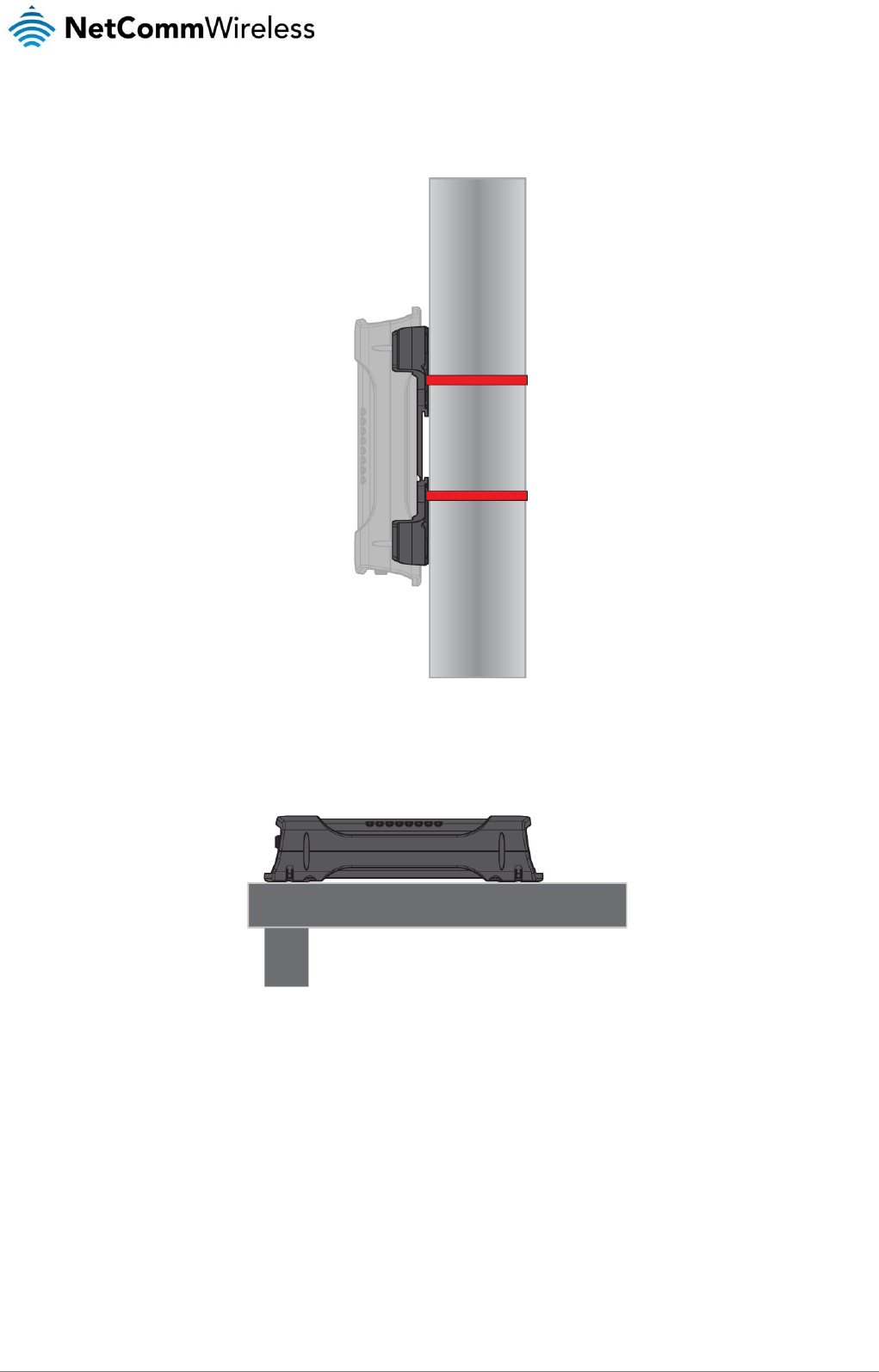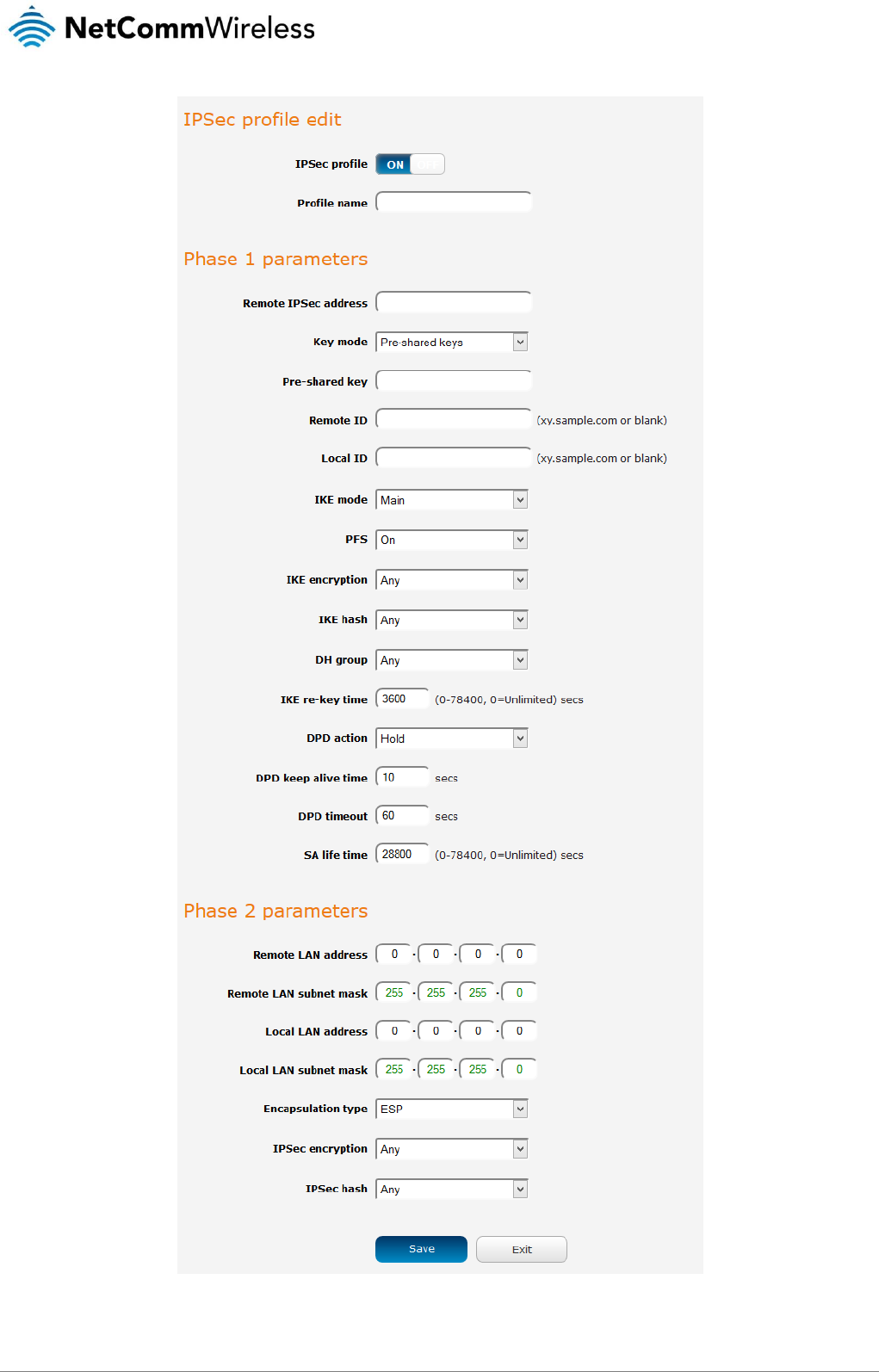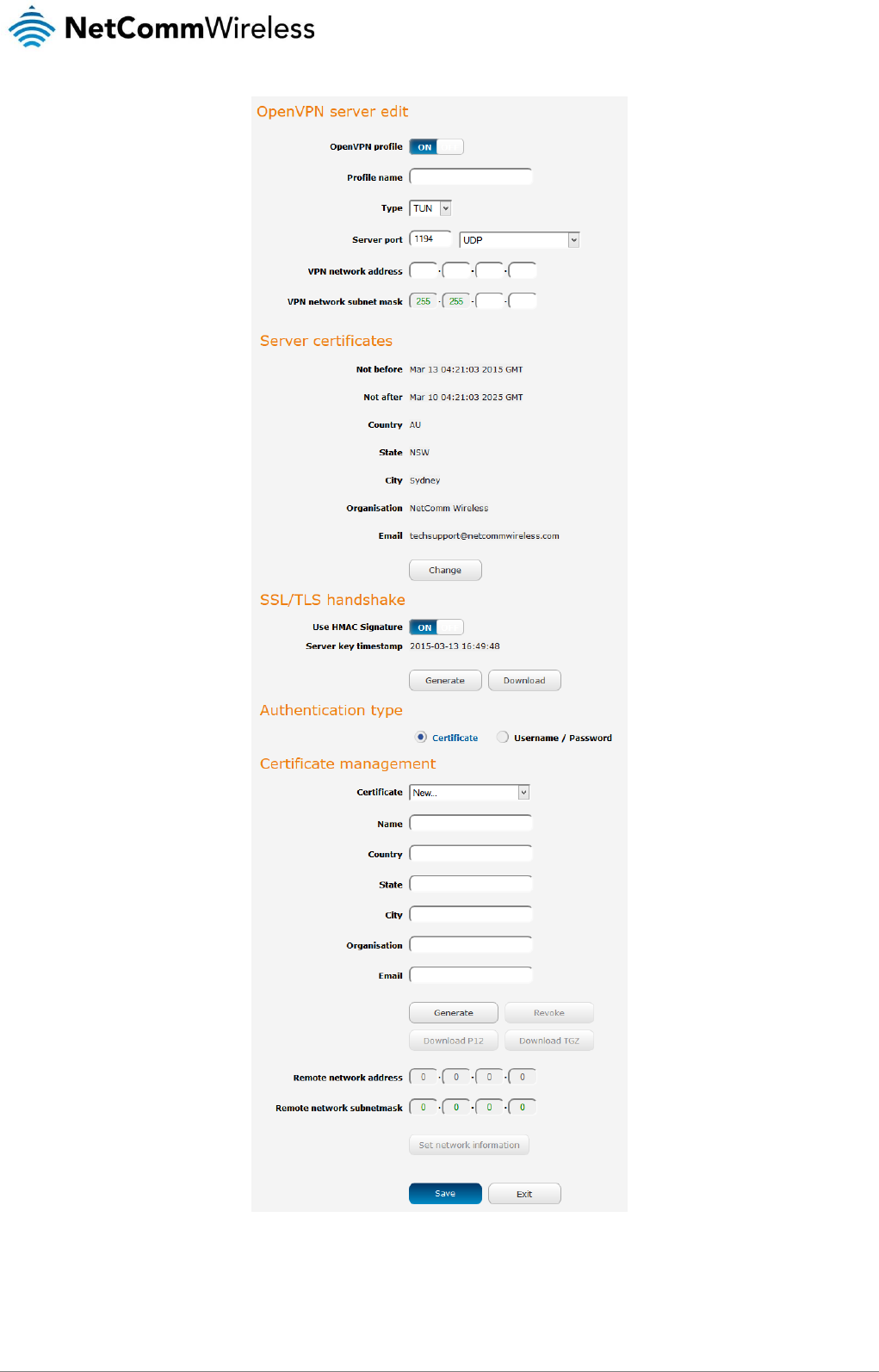NetComm Wireless NTC140 NTC-140-01 User Manual
NetComm Wireless Limited NTC-140-01
Contents
- 1. user manual
- 2. User Manual
user manual
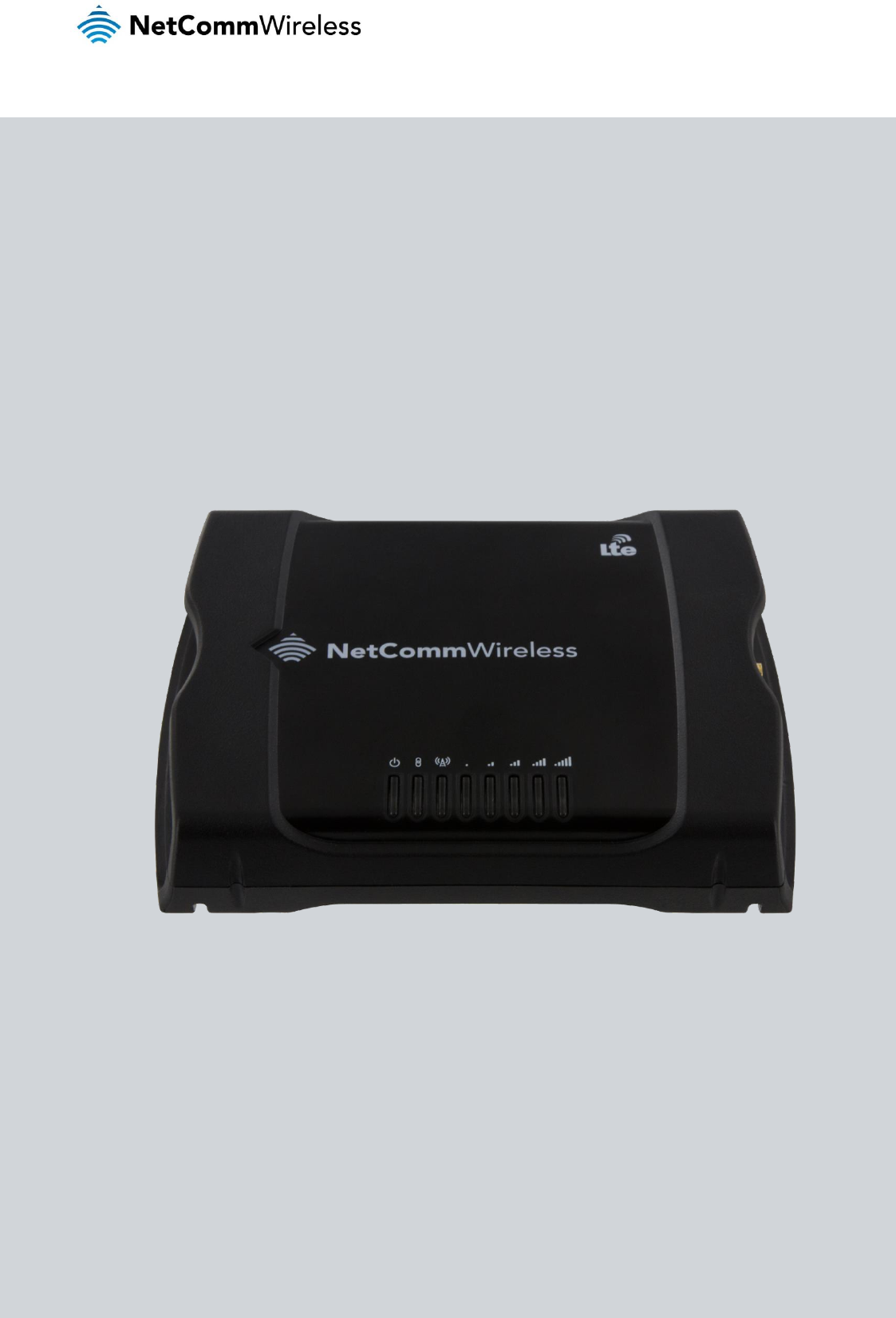
User Guide
NTC-140-01 – 4G M2M Router

2
NetComm Wireless 4G M2M Router
www.netcommwireless.com
v1.0
Important Notice
This device, like any wireless device, operates using radio signals which cannot guarantee the transmission and reception of data in
all conditions. While the delay or loss of signal is rare, you should not rely solely on any wireless device for emergency
communications or otherwise use the device in situations where the interruption of data connectivity could lead to death, personal
injury, property damage, data loss, or other loss. NetComm Wireless accepts no responsibility for any loss or damage resulting from
errors or delays in transmission or reception, or the failure of the NetComm Wireless NTC-140-01 to transmit or receive such data.
Safety and Hazards
Do not connect or disconnect cables or devices to or from the USB port, SIM card tray, Ethernet port or the terminals of
the Molex power connector in hazardous locations such as those in which flammable gases or vapors may be present, but
normally are confined within closed systems; are prevented from accumulating by adequate ventilation; or the location is
adjacent to a location from which ignitable concentrations might occasionally be communicated.

www.netcommwireless.com
NetComm Wireless 4G M2M Router
3
v1.0
Copyright
Copyright© 2017 NetComm Wireless Limited. All rights reserved.
The information contained herein is proprietary to NetComm Wireless. No part of this document may be translated, transcribed,
reproduced, in any form, or by any means without prior written consent of NetComm Wireless.
Note: This document is subject to change without notice.
Save our environment
When this equipment has reached the end of its useful life, it must be taken to a recycling centre and processed separately from
domestic waste.
The cardboard box, the plastic contained in the packaging, and the parts that make up this device can be recycled in accordance
with regionally established regulations. Never dispose of this electronic equipment along with domestic waste. You may be subject
to penalties or sanctions under the law. Instead, ask for disposal instructions from your municipal government.
Please be responsible and protect our environment.
This manual covers the following products:
NetComm Wireless NTC-140-01
DOCUMENT VERSION
DATE
1.0 - Initial document release
31 January 2017
Table 1 - Document Revision History

4
NetComm Wireless 4G M2M Router
www.netcommwireless.com
v1.0
Table of contents
Overview ........................................................................................................................................................................................ 6
Introduction ................................................................................................................................................................................................... 6
Target audience ............................................................................................................................................................................................. 6
Prerequisites ................................................................................................................................................................................................. 6
Notation ........................................................................................................................................................................................................ 6
Product introduction ...................................................................................................................................................................... 7
Product overview ........................................................................................................................................................................................... 7
Product features ............................................................................................................................................................................................ 7
Package contents .......................................................................................................................................................................................... 7
Physical dimensions and indicators ............................................................................................................................................. 8
Physical dimensions ...................................................................................................................................................................................... 8
LED indicators ............................................................................................................................................................................................... 9
Ethernet port LED indicators ........................................................................................................................................................................ 11
Interfaces .................................................................................................................................................................................................... 12
Placement of the router ............................................................................................................................................................... 13
Mounting options ......................................................................................................................................................................................... 13
DIN rail mounting bracket ............................................................................................................................................................................. 13
Wall mounted via DIN rail bracket ................................................................................................................................................................. 14
DIN rail mount ............................................................................................................................................................................................. 14
Pole mount using DIN rail bracket ................................................................................................................................................................ 15
Desk mount ................................................................................................................................................................................................. 15
Via vertical DIN rail mounting bracket and metal bracket ............................................................................................................................... 16
Via horizontal DIN rail mounting bracket ........................................................................................................................................................ 16
Installation and configuration of the NTC-140-01 router ........................................................................................................... 18
Powering the router ..................................................................................................................................................................................... 18
Installing the router ...................................................................................................................................................................................... 18
Advanced configuration .............................................................................................................................................................. 19
Status ........................................................................................................................................................................................... 20
Networking ................................................................................................................................................................................... 23
Wireless WAN.............................................................................................................................................................................................. 23
LAN ............................................................................................................................................................................................................ 36
Ethernet LAN/WAN ...................................................................................................................................................................................... 40
PPPoE ........................................................................................................................................................................................................ 42
Routing ....................................................................................................................................................................................................... 45
VPN ............................................................................................................................................................................................................ 54
Services........................................................................................................................................................................................ 67
Dynamic DNS .............................................................................................................................................................................................. 67
Network time (NTP)...................................................................................................................................................................................... 68
Data stream manager .................................................................................................................................................................................. 69
PADD .......................................................................................................................................................................................................... 78
Remote management .................................................................................................................................................................................. 79
IO configuration ........................................................................................................................................................................................... 85
Event notification ......................................................................................................................................................................................... 87
Email settings .............................................................................................................................................................................................. 90
SMS messaging .......................................................................................................................................................................................... 91
System ....................................................................................................................................................................................... 107
Log ........................................................................................................................................................................................................... 107
System configuration ................................................................................................................................................................................. 112
Administration ........................................................................................................................................................................................... 116
Watchdogs ................................................................................................................................................................................................ 124
Power management .................................................................................................................................................................................. 127
USB-OTG.................................................................................................................................................................................................. 130
Storage ..................................................................................................................................................................................................... 131
Reboot ...................................................................................................................................................................................................... 132
Appendix A: Tables.................................................................................................................................................................... 133
Appendix B: Default Settings .................................................................................................................................................... 134
Restoring factory default settings ............................................................................................................................................................... 135
Appendix C: Recovery mode .................................................................................................................................................... 136
Accessing recovery mode .......................................................................................................................................................................... 136
Status ....................................................................................................................................................................................................... 137
Log ........................................................................................................................................................................................................... 137
Application Installer .................................................................................................................................................................................... 138
Settings ..................................................................................................................................................................................................... 138
Reboot ...................................................................................................................................................................................................... 138
Appendix D: HTTPS - Uploading a self-signed certificate ....................................................................................................... 139
Appendix E: RJ-45 connectors ................................................................................................................................................. 141
Appendix G: Input/Output ......................................................................................................................................................... 142
Overview ................................................................................................................................................................................................... 142

www.netcommwireless.com
NetComm Wireless 4G M2M Router
5
v1.0
Appendix H: Obtaining a list of RDB variables ......................................................................................................................... 147
Appendix I: Using USB devices and MicroSD™ cards ............................................................................................................ 148
Accessing USB/SD card storage devices ................................................................................................................................................... 148
Host and Device mode .............................................................................................................................................................................. 148
Safety and product care ............................................................................................................................................................ 149
Product Warranty....................................................................................................................................................................... 154

6
NetComm Wireless 4G M2M Router
www.netcommwireless.com
v1.0
Overview
Introduction
This document provides you all the information you need to set up, configure and use the NetComm Wireless NTC-140-01 router.
Target audience
This document is intended for system integrators or experienced hardware installers who understand telecommunications
terminology and concepts.
Prerequisites
Before continuing with the installation of your NTC-140-01 router, please confirm that you have the following:
An electronic computing device with a working Ethernet network adapter and a web browser such as Internet Explorer,
Mozilla Firefox or Google Chrome.
Notation
The following symbols are used in this user guide:
The following note requires attention.
The following note provides a warning.
The following note provides useful information.

www.netcommwireless.com
NetComm Wireless 4G M2M Router
7
v1.0
Product introduction
Product overview
Powerful and flexible industrial cellular router platform supporting LTE with fallback to 3G/UMTS and
GSM/GPRS/EDGE (Fallback only applies to certain models)
Ideal for providing primary and backup wireless connectivity over LTE networks
Industrial Features – rugged enclosure, wide operating temperature range, wall mount option and a flexible range of
power options
Embedded Linux operating system allowing for the installation of custom applications. Software Development Kit (SDK)
is available
Web interface for easy centralized configuration and management from any PC
Two 10/100/1000 Base T ports for Ethernet connection
VPN support for establishing a secure connection over public cellular network using OpenVPN
Supports SNMP with cellular specific MIB, PPPoE, RIP, VRRP. DDNS, MAC /NET address filtering, Open VPN,
DHCP/DHCP relay
System monitoring, remote diagnostics and configuration over the air, diagnostic log viewer via browser
TR-069 device management (optional)
Ignition Sense capability for graceful shutdown and startup in vehicle applications
Configurable power save mode with minimum current draw when not operational
Tested for vehicular applications IEC Class 5M2 and MIL-STD-810F Method 516.5.
Product features
The robust and intelligent NetComm 4G M2M Router is designed to provide real-time M2M data connectivity even in harsh
environments. The NTC-140-01 creates reliable point-to-point or point-to-multi-point wide area network (WAN) connections for a
variety of mission critical applications such as primary broadband, video surveillance, retail, payments, in-vehicle wireless hotspot
and business continuity.
Package contents
The NetComm Wireless NTC-140-01 router package consists of:
1 x NetComm Wireless NTC-140-01 router
2 x SMA to FAKRA Pigtails (pre-installed)
1 x 24 inch twisted pair UL with 4-pin Molex power cord
1 x End mount bracket
1 x DIN bracket adapter
1 x DIN mounting bracket
2 x DIN clips
4 x ¼ inch screws
If any of these items are missing or damaged, please contact NetComm Wireless Support immediately. The NetComm Wireless
Support website can be found at: http://support.netcommwireless.com.
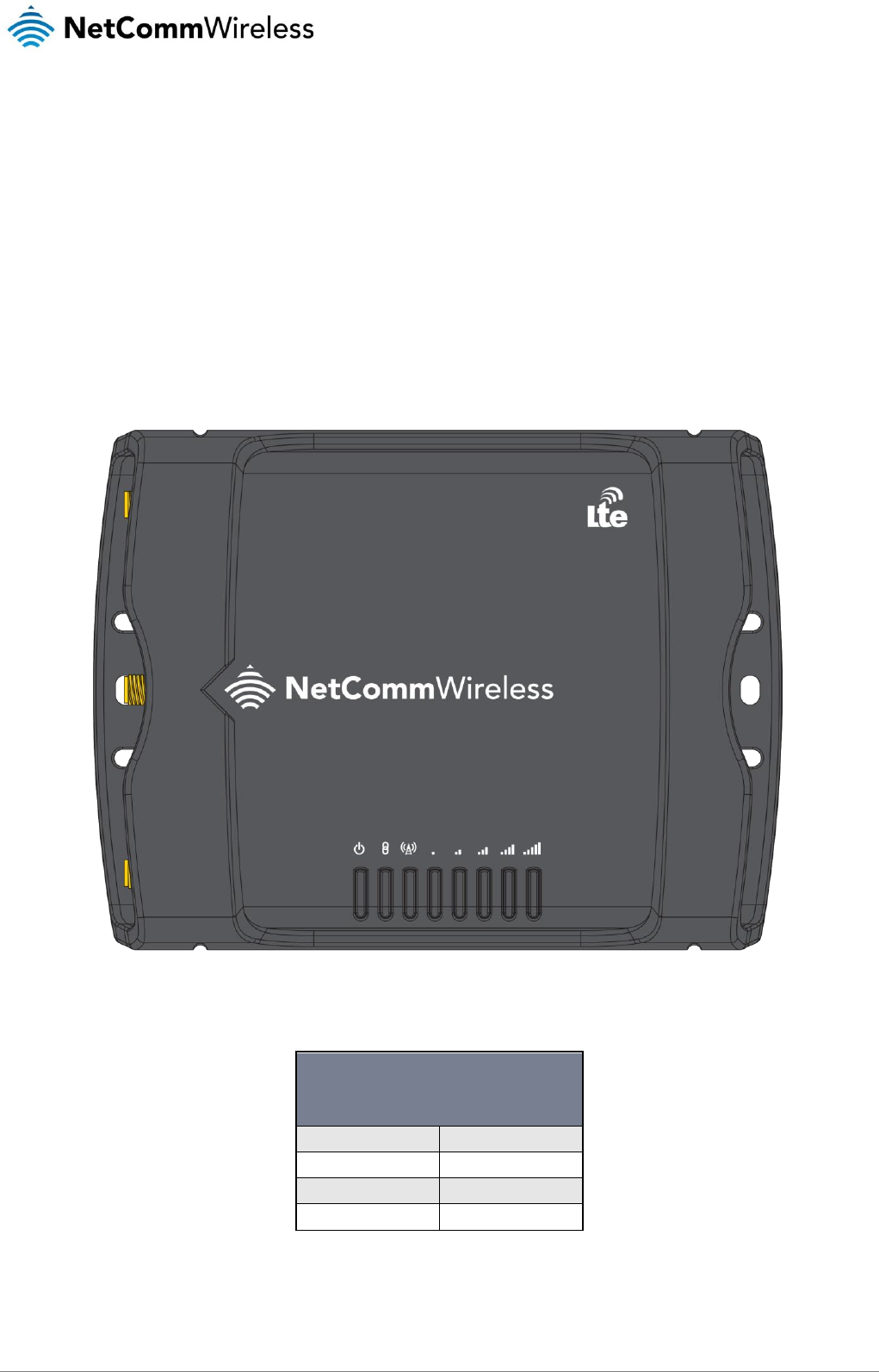
8
NetComm Wireless 4G M2M Router
www.netcommwireless.com
v1.0
Physical dimensions and
indicators
Physical dimensions
Below is a list of the physical dimensions of the NTC-140-01 router.
Figure 1 – NTC-140-01 router Dimensions
NTC-140-01 ROUTER
(WITHOUT EXTERNAL ANTENNAS
ATTACHED)
Length
143 mm
Depth
107 mm
Height
34 mm
Weight
~235g
Table 2 - Device Dimensions
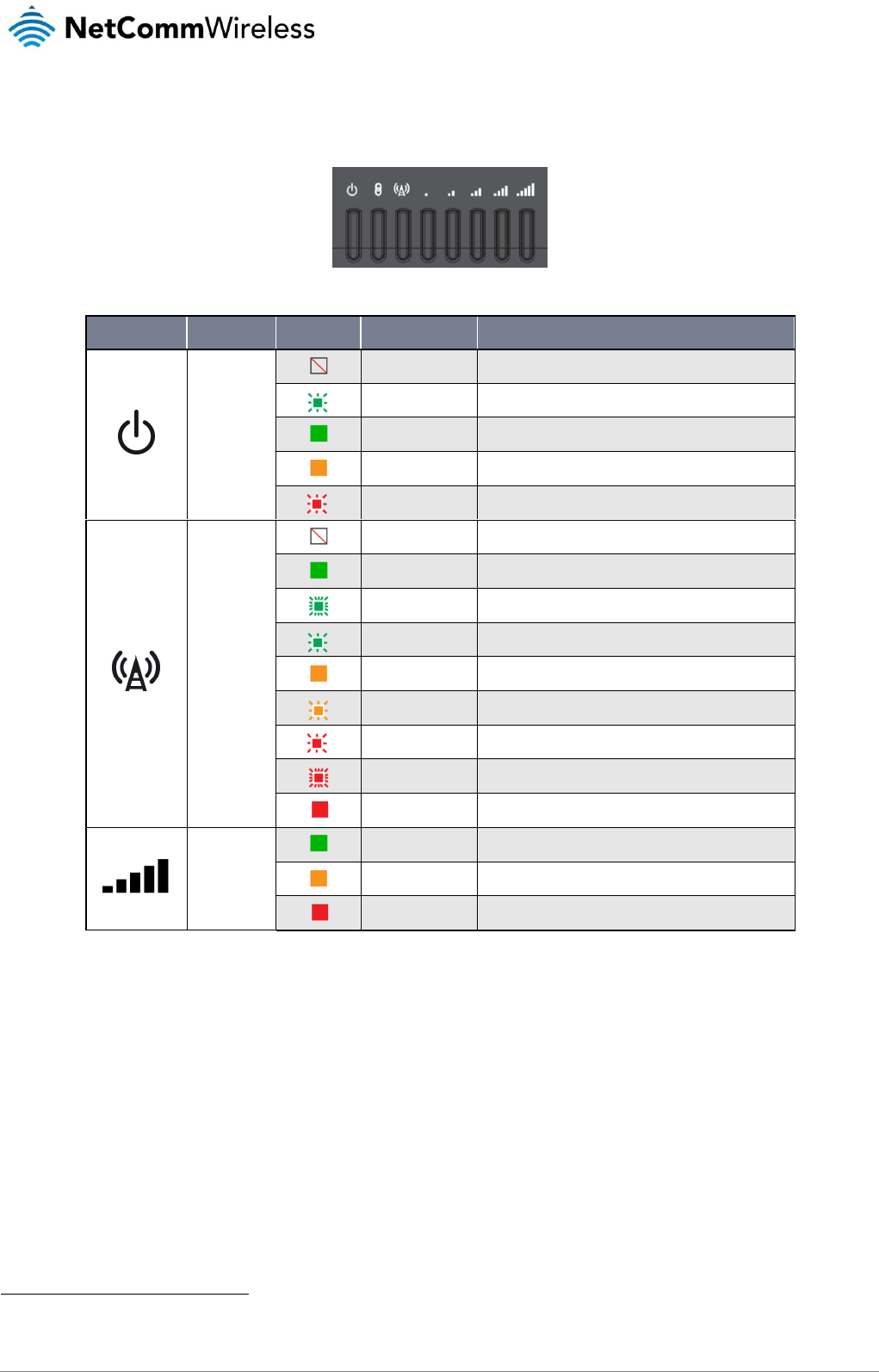
www.netcommwireless.com
NetComm Wireless 4G M2M Router
9
v1.0
LED indicators
The NTC-140-01 router uses 8 LEDs to display the current system and connection status.
Figure 2 - NTC-140-01 router LED Indicators
LED ICON
NAME
COLOUR
STATE
DESCRIPTION
Power
Off
Power off
Double flash
Powering up
On
Power on
On
Power on in recovery mode
Slow flashing
Hardware error, such as SIM not inserted
Network
Off
Radio Off
On
Connected via WWAN
Blinking1
Traffic via WWAN
Slow flashing
Connecting PDP
On
Registered network
Slow flashing
Registering network
Slow flashing
SIM PIN locked
Fast flashing
SIM PUK locked
On
Can’t connect
Signal
strength
On
LTE signal
On
WCDMA signal
On
GSM signal
Table 3 - LED Indicators
1
The term “blinking” means that the LED may pulse, with the intervals that the LED is on and off not being equal. The term “flashing” means that the
LED turns on and off at equal intervals.
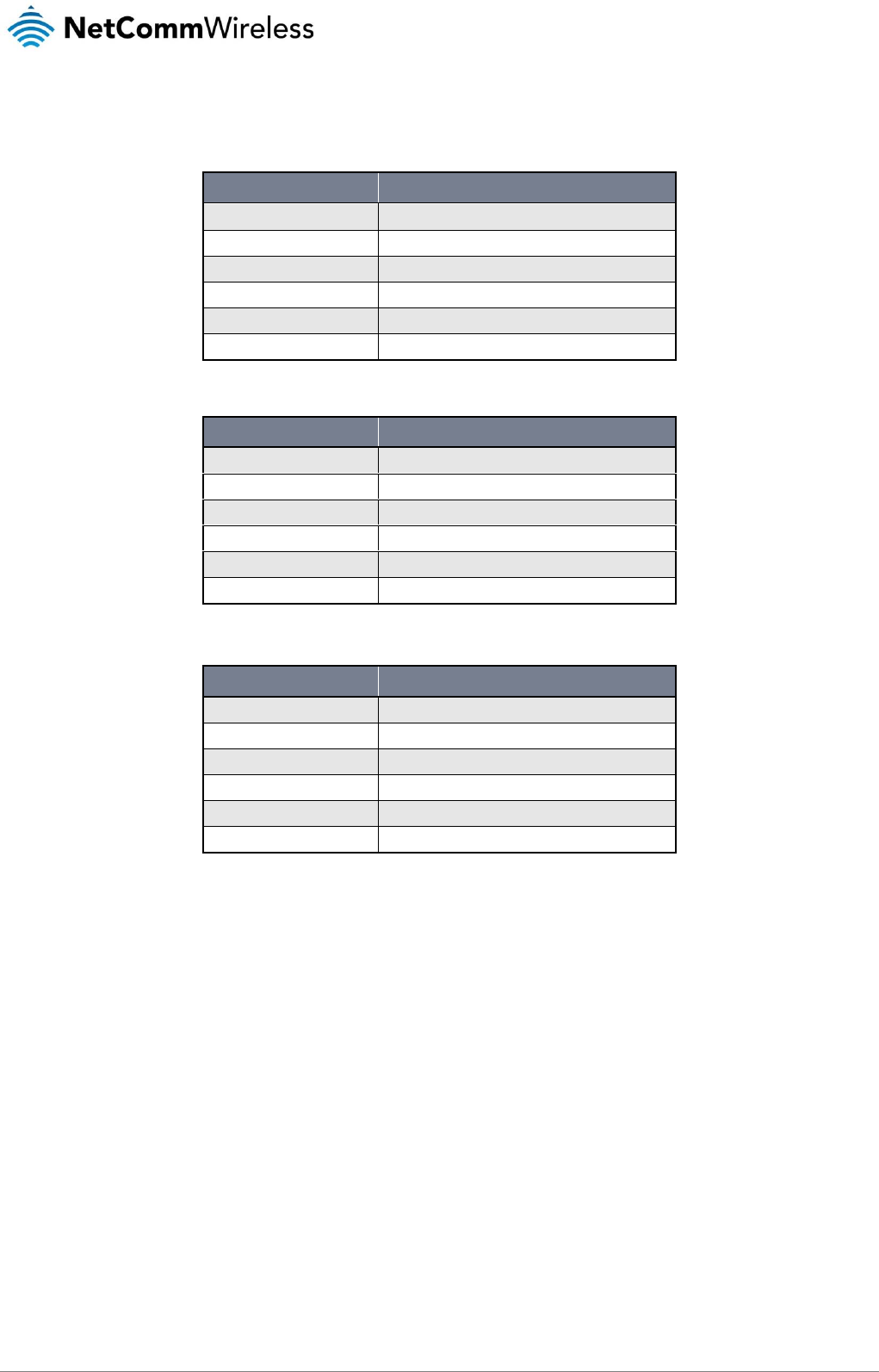
10
NetComm Wireless 4G M2M Router
www.netcommwireless.com
v1.0
Signal strength LEDs
The following tables list the signal strength range corresponding with the number of lit signal strength LEDs.
LTE signal mapping (Green)
NUMBER OF LIT LEDS
SIGNAL STRENGTH
All LEDs unlit
≤ -120 dBm
1
-115 dBm to -119dBm
2
-105 dBm to -114 dBm
3
-100 dBm to -104 dBm
4
-90 dBm to -99 dBm
5
> -90 dBm
WCDMA signal mapping (Amber)
NUMBER OF LIT LEDS
SIGNAL STRENGTH
All LEDs unlit
< -109 dBm
1
-109 dBm to -102dBm
2
-101 dBm to -92 dBm
3
-91 dBm to -86 dBm
4
-85 dBm to -78 dBm
5
≥ -77 dBm
Table 4 - Signal strength LED descriptions
GSM signal mapping (Red)
NUMBER OF LIT LEDS
SIGNAL STRENGTH
All LEDs unlit
≤ -109 dBm
1
-102 dBm to -108dBm
2
-93 dBm to -101 dBm
3
-87 dBm to -92 dBm
4
-86 dBm to -78 dBm
5
> -78 dBm
LED update interval
The signal strength LEDs update within a few seconds with a rolling average signal strength reading. When selecting a location for
the router or connected or positioning an external antenna, please allow up to 20 seconds for the signal strength LEDs to update
before repositioning.
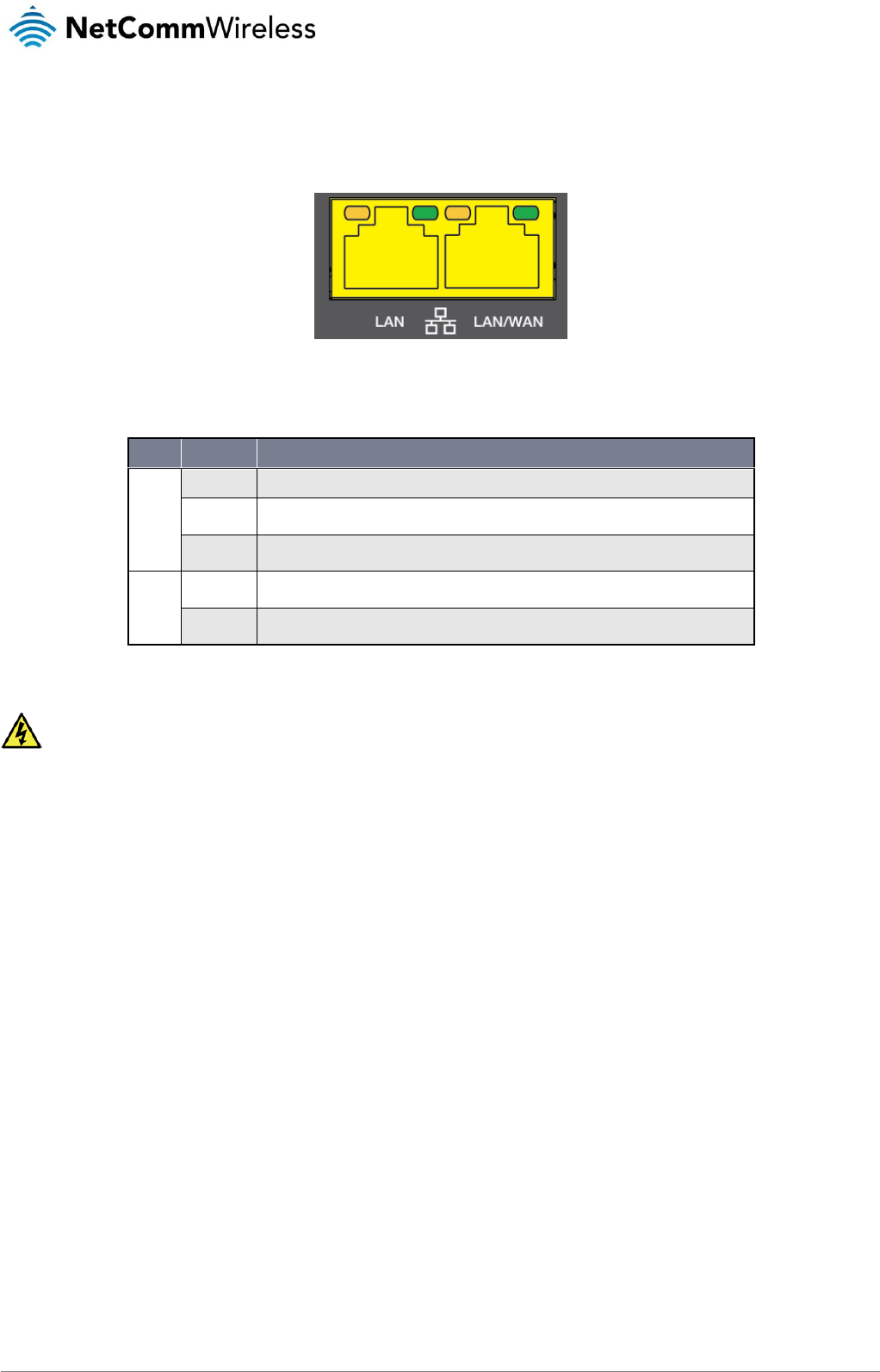
www.netcommwireless.com
NetComm Wireless 4G M2M Router
11
v1.0
Ethernet port LED indicators
Each of the Ethernet ports of the NTC-140-01 router have two LED indicators on them.
Figure 3 - Ethernet port LED indicators
The table below describes the statuses of each light and their meanings.
LED
STATUS
DESCRIPTION
Green
On
There is a valid network link.
Blinking
There is activity on the network link.
Off
No valid network link detected.
Amber
On
The Ethernet port is operating at a speed of 1000Mbps.
Off
The Ethernet port is operating at a speed of 10/100Mbps or no Ethernet cable is connected.
Table 5 - Ethernet port LED indicators description
Do not connect or disconnect cables or devices to or from the Ethernet ports in hazardous locations such as those in
which flammable gases or vapors may be present, but normally are confined within closed systems; are prevented from
accumulating by adequate ventilation; or the location is adjacent to a location from which ignitable concentrations might
occasionally be communicated.
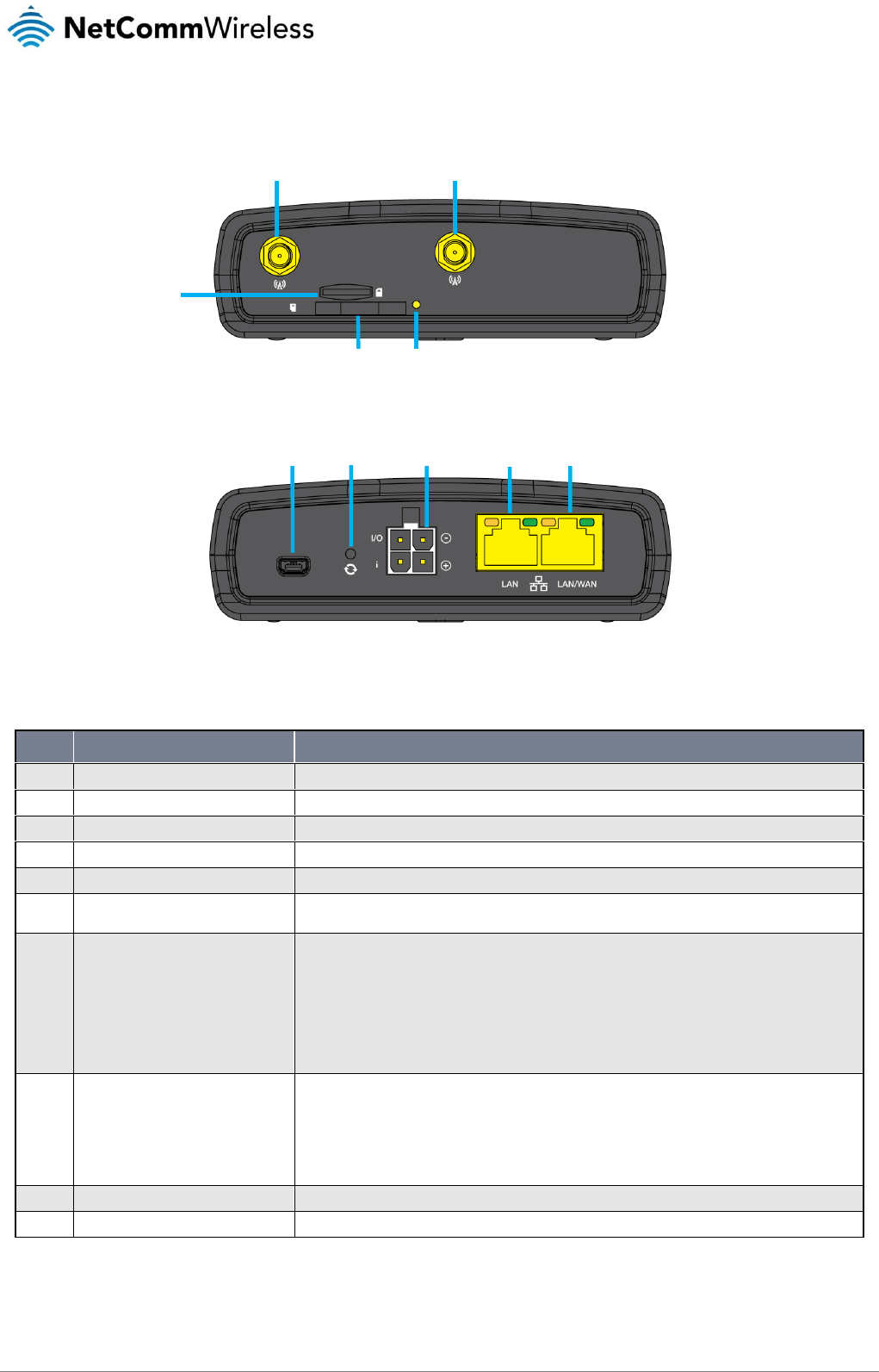
12
NetComm Wireless 4G M2M Router
www.netcommwireless.com
v1.0
Interfaces
Figure 4 - Interfaces
NO.
ITEM
DESCRIPTION
1
Cellular Main antenna connector
SMA connector for main cellular antenna.
2
Cellular AUX antenna connector
SMA connector for auxiliary cellular antenna.
3
microSD™ card slot
Insert a microSD™ card here to provide additional storage (Optional).
4
SIM card slot
Insert SIM card here.
5
SIM tray eject button
Press to eject the SIM tray
6
Micro USB 2.0 OTG port
Provides connectivity for optional external storage or a USB Ethernet dongle. Supplies up to 0.5A to
connected device.
7
Reset button
Press and hold for less than 5 seconds to reboot to normal mode. The LEDs are green and extinguish in
sequence to indicate that the router will reboot normally if the button is released during this period.
Press and hold for 5 to 15 seconds to reboot to recovery mode. The LEDs are amber and extinguish in
sequence to indicate that the router will reboot to recovery mode if the button is released during this
period.
Press and hold for 15 to 20 seconds to reset the router to factory default settings. The LEDs are red and
extinguish in sequence to indicate that the router will reset to factory default settings if the button is
released during this period.
8
Molex Mini-Fit™ Jr. 2 x 2 receptacle
Connect the provided power supply here. The Molex receptacle provides:
Ground (−)
Power (+)
I/O terminal
(i) ignition input detection terminal.
9
LAN port
LAN port for wired Ethernet clients.
10
LAN/WAN port
LAN or WAN port for wired Ethernet clients or to bridge another network connection.
Table 6 – Interfaces
6
7
8
9
10
3
4
5
1
2
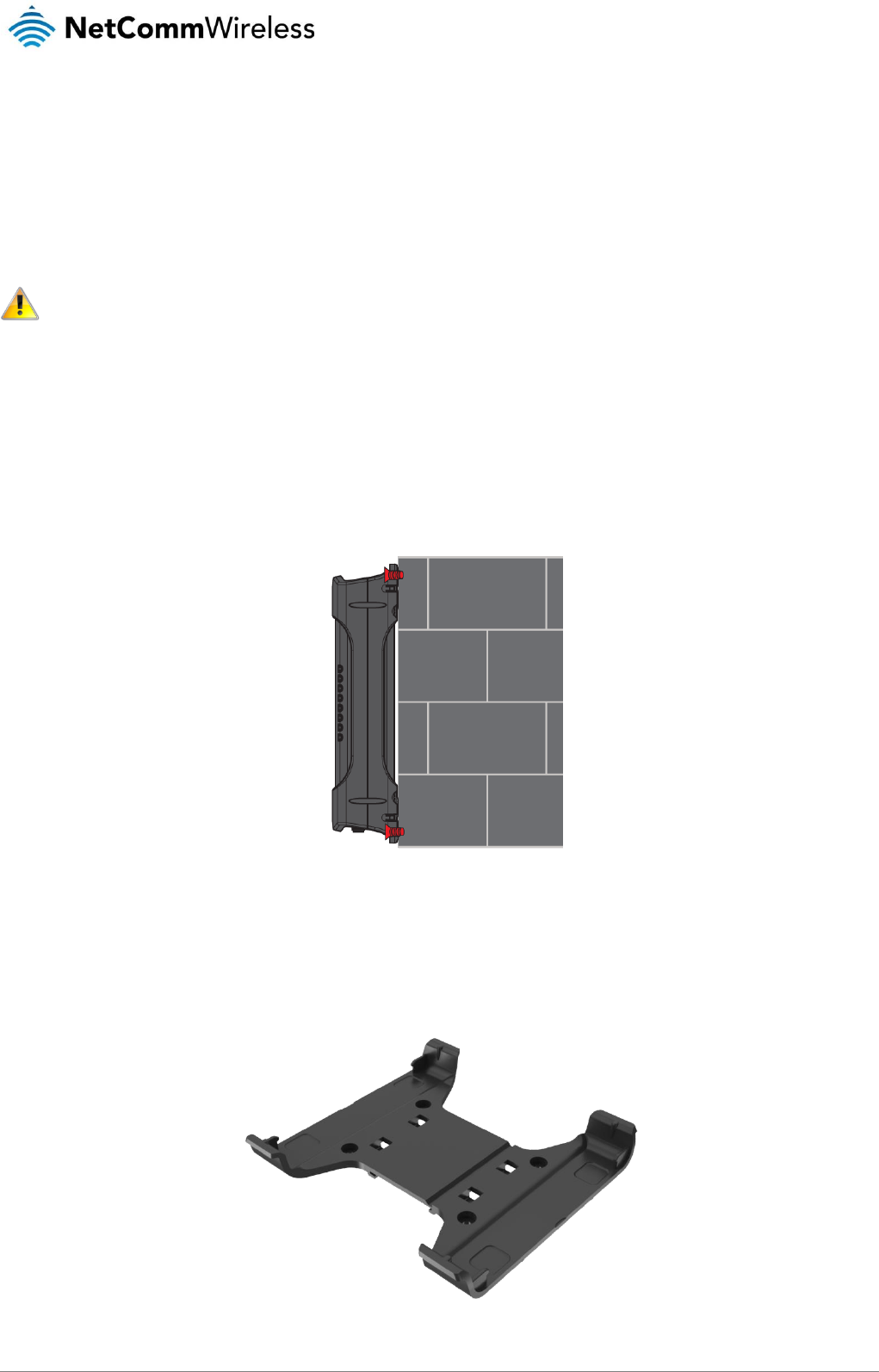
www.netcommwireless.com
NetComm Wireless 4G M2M Router
13
v1.0
Placement of the router
The four external high-performance antennas supplied with the router are designed to provide optimum signal strength in a wide
range of environments. If you find the signal strength is weak, try adjusting the orientation of the antennas. If you are unable to get
an acceptable signal, try moving the router to a different place or mounting it differently.
Note: When selecting a location for the router, allow at least 20 seconds for the signal strength LEDs to update before trying
a different location.
Mounting options
The NTC-140-01 router can be quickly and easily mounted in a variety of locations.
Mounted flat against the wall
When mounted flat against the wall, the NTC-140-01 router has a slimline form factor. Use appropriately sized screws in the
mounting holes provided on the base of the unit.
Figure 5 - Wall mount - Flat against the wall
DIN rail mounting bracket
V Bend allows you to snap the DIN bracket onto the middle of a DIN rail rather than sliding it onto the end.
Figure 6 – DIN rail mounting bracket
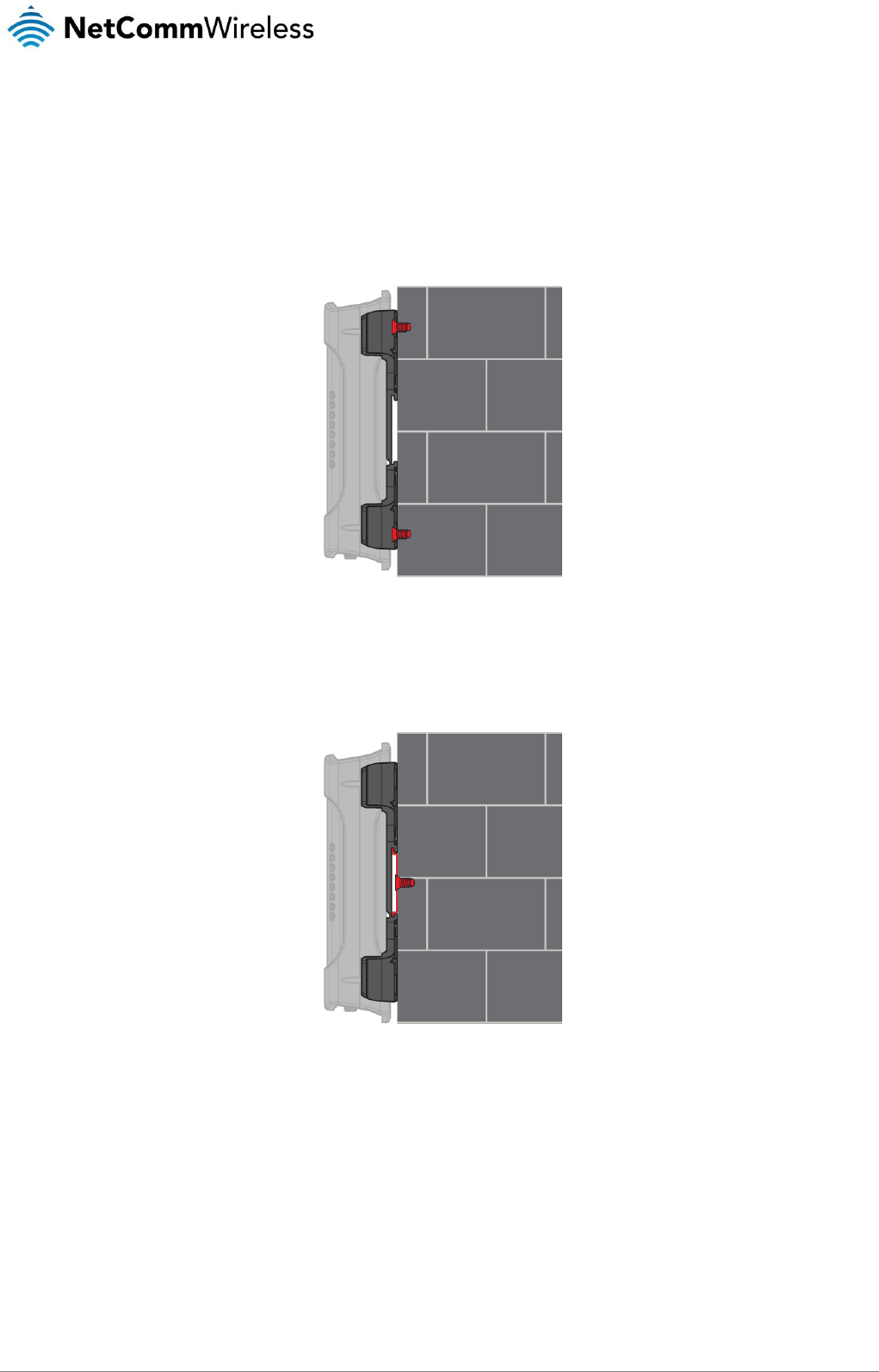
14
NetComm Wireless 4G M2M Router
www.netcommwireless.com
v1.0
Wall mounted via DIN rail bracket
Figure 7 - Wall mounted via DIN rail bracket
DIN rail mount
Figure 8 – DIN rail mount
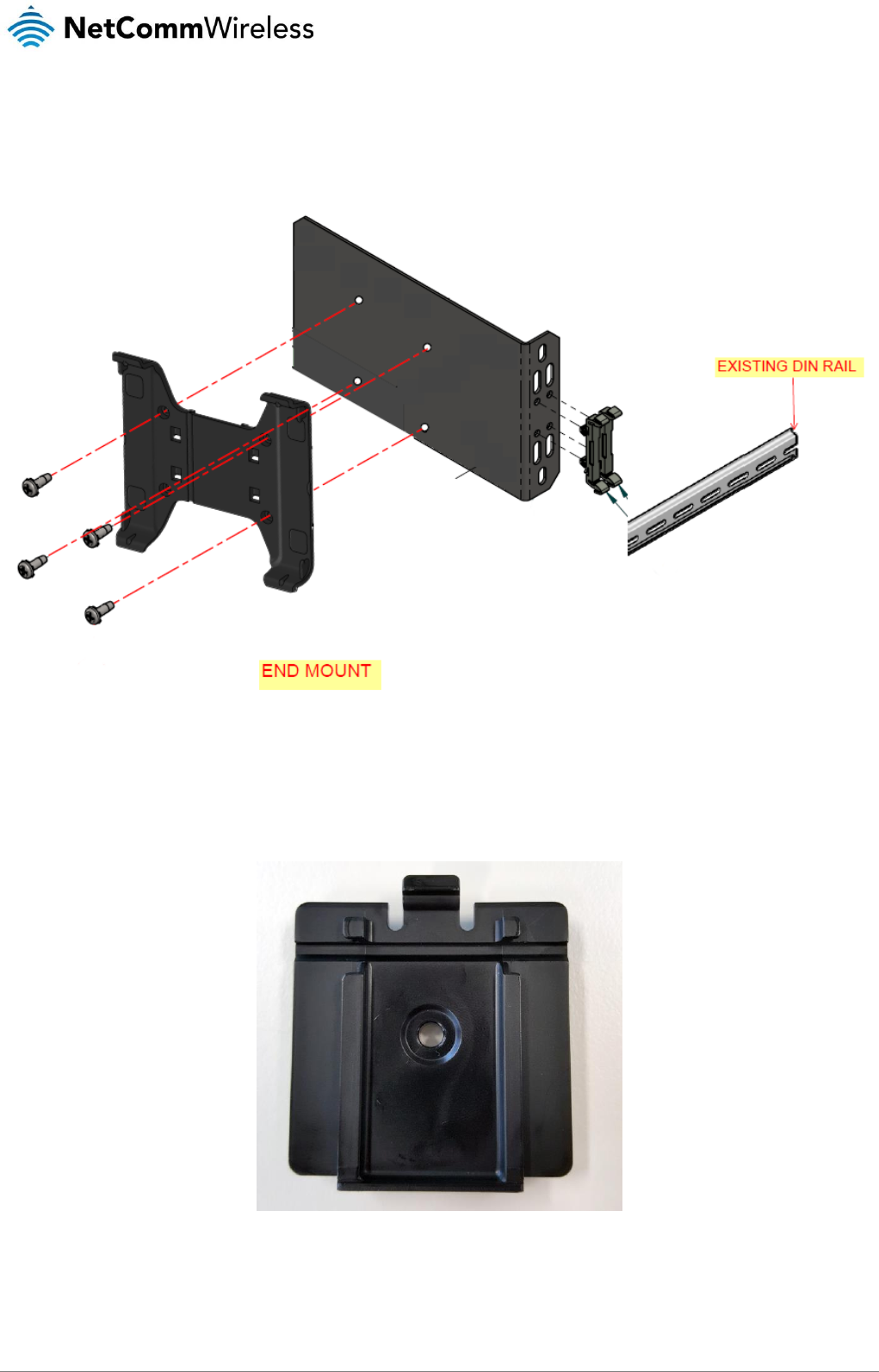
16
NetComm Wireless 4G M2M Router
www.netcommwireless.com
v1.0
Via vertical DIN rail mounting bracket and metal bracket
Put four screws through the vertical DIN rail mounting bracket and line them up with the four holes on the metal bracket. Tighten
them to affix the vertical DIN rail bracket to the metal bracket. The NTC-140-01 router may then be snapped into the vertical DIN rail
bracket.
Via horizontal DIN rail mounting bracket
Attach the horizontal DIN rail mounting bracket to the DIN rail by either snapping it onto the rail using the bend line and the tab at
the top or sliding it on to the rail from the end. Optionally, you may put a screw through the centre hole of the bracket so that it
doesn’t move along the DIN rail.
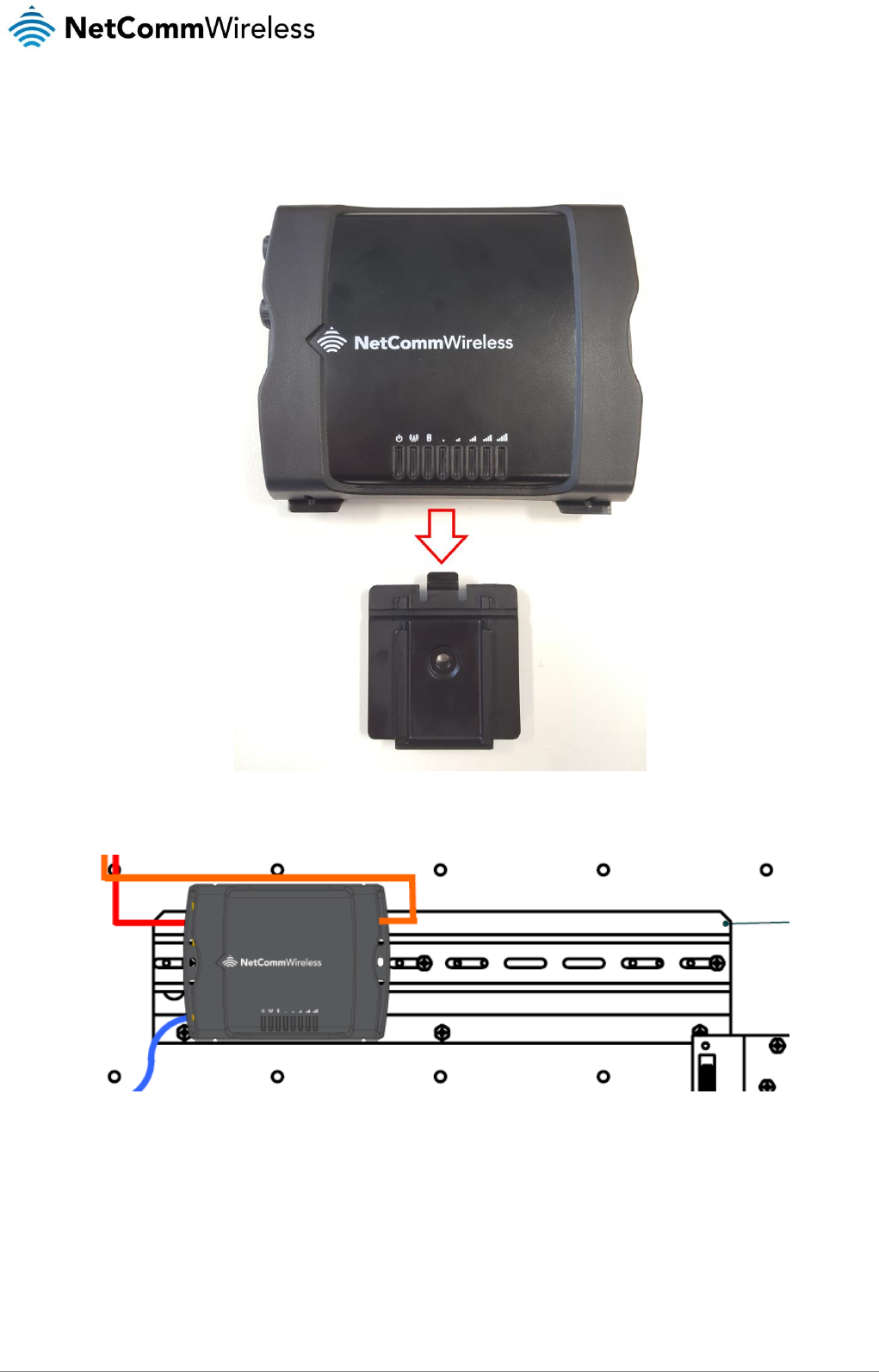
www.netcommwireless.com
NetComm Wireless 4G M2M Router
17
v1.0
Attach the vertical DIN rail mounting bracket to the NTC-140-01 by snapping it on to the back of the router, then slide the NTC-
140-01 router on to the horizontal mounting bracket.
The NTC-140-01 router is successfully mounted in a horizontal orientation.
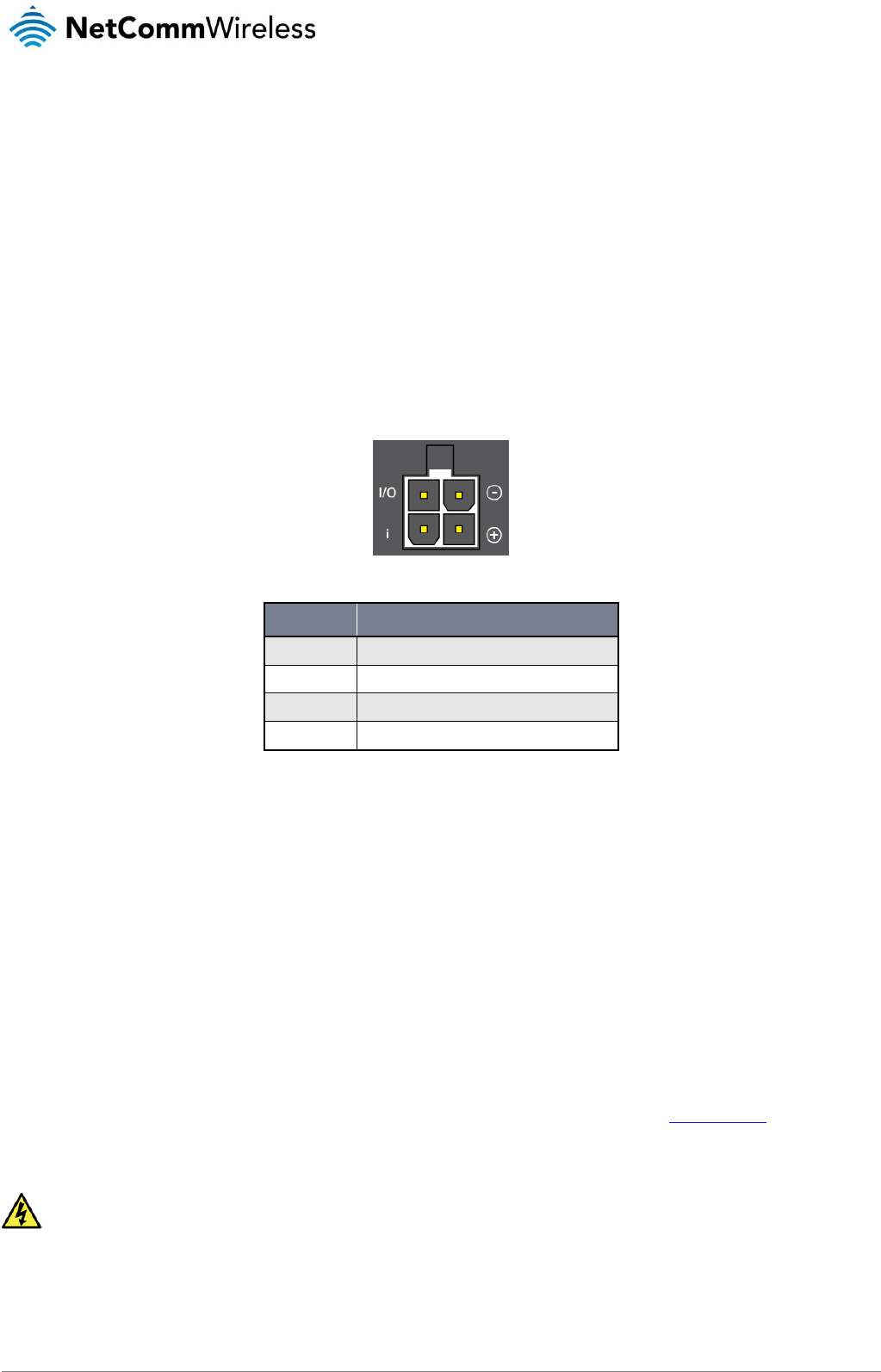
18
NetComm Wireless 4G M2M Router
www.netcommwireless.com
v1.0
Installation and configuration
of the NTC-140-01 router
Powering the router
The NTC-140-01 router may be powered using the included power supply cable with 8-40V to the Molex connector. A suitable
power supply (PSU-0067) is available as an accessory. The output of the DC power supply shall comply with the Limited Power
Source requirements (LPS) of the IEC 60950-1 safety standard.
Figure 11 - Molex connector
TERMINAL
DESCRIPTION
−
Ground wire.
+
Positive wire for power.
i
Dedicated terminal for ignition detection.
I/O
Input/output detection.
Table 7 - Locking power block pin outs
Installing the router
Follow these steps to complete the installation process. For a more detailed description, please refer to the Quick Start Guide
included in the package contents.
1. Using a paper clip, press the SIM Eject button to eject the SIM card tray. Place the SIM card in the tray and then insert the
loaded tray into the SIM slot with the gold side facing up.
2. Attach the cellular antennas to their respective connectors.
3. Connect equipment that requires network access to the LAN port of your router. This may be your computer for advanced
configuration purposes, or your end equipment which requires data access via the NTC-140-01 router. You can connect
one device directly, or several devices using a network switch.
4. Connect the power source to the router. Wait approximately 2 minutes for your NTC-140-01 router to start up. To check
the status of your router, compare the LED indicators on the device with those listed in the LED indicators section of this
guide.
Do not connect or disconnect cables or devices to or from the USB port, SIM card tray, Ethernet port or the terminals of
the Molex power connector in hazardous locations such as those in which flammable gases or vapors may be present, but
normally are confined within closed systems; are prevented from accumulating by adequate ventilation; or the location is
adjacent to a location from which ignitable concentrations might occasionally be communicated.
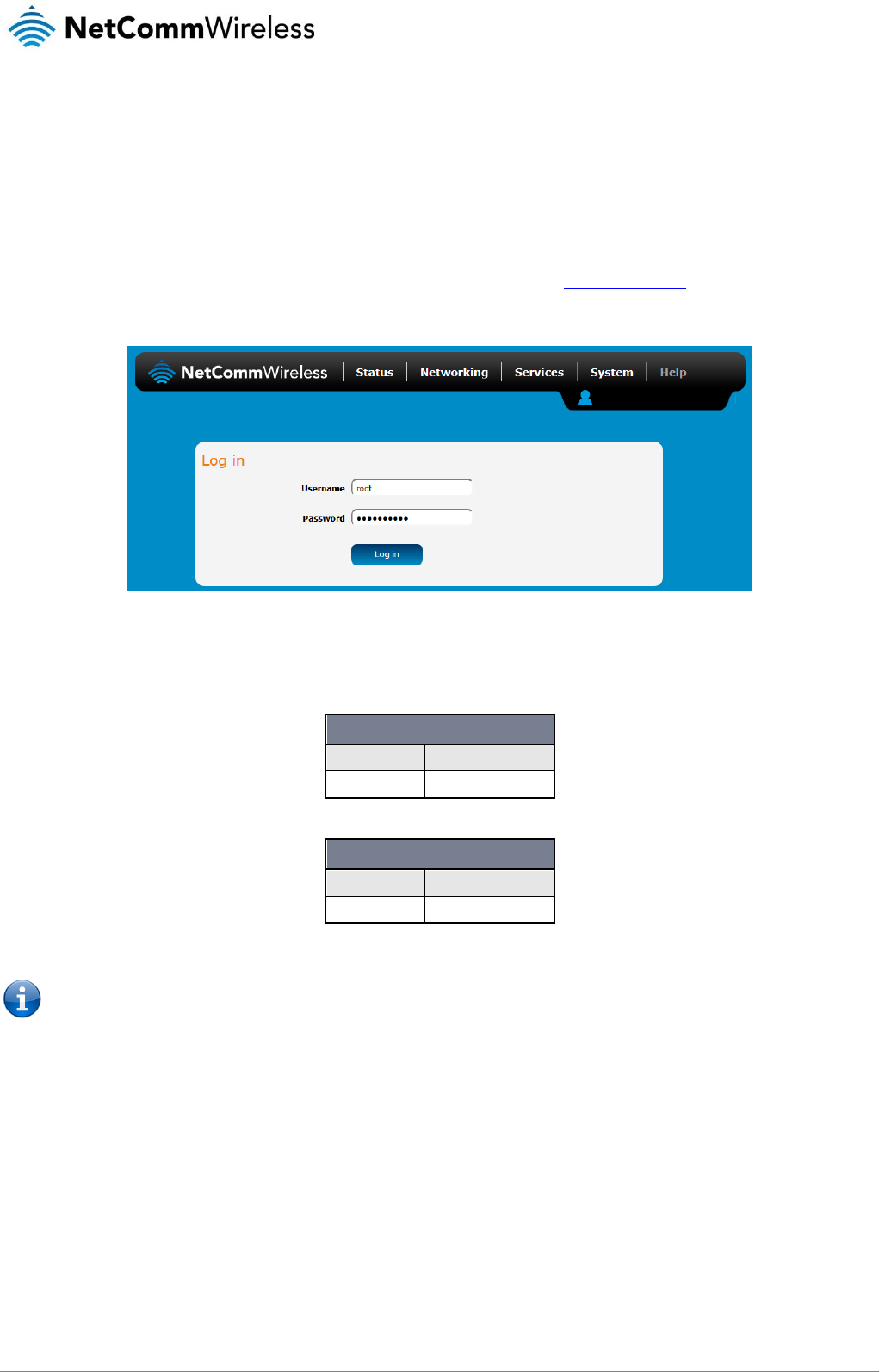
www.netcommwireless.com
NetComm Wireless 4G M2M Router
19
v1.0
Advanced configuration
The NTC-140-01 router comes with pre-configured settings that should suit most customers. For advanced configuration, log in to
the web-based user interface of the router.
To log in to the web-based user interface:
1. Open a web browser (e.g. Internet Explorer, Firefox, Google Chrome), type http://192.168.0.1 into the address bar and
press Enter. The web-based user interface log in screen is displayed.
Figure 12 – Log in prompt for the web-based user interface
2. Enter the login username and password. If this is the first time you are logging in or you have not previously configured the
password for the “root” or “admin” accounts, you can use one of the default account details to log in.
ROOT MANAGER ACCOUNT
Username:
root
Password:
tkemAx177a
Table 8 - Management account login details – Root manager
ADMIN MANAGER ACCOUNT
Username:
admin
Password:
tkemAx177a
Table 9 - Management account login details – Admin manager
Note:
• The admin manager account allows you to manage all settings of the router except functions such as firmware upgrade,
device configuration backup and restore and reset to factory default settings, which are privileged only to the root manager
account.
• For security reasons, we highly recommend that you change the passwords for the root and admin accounts upon initial
installation. You can do so by navigating to the System and then Administration page.
The Status page is displayed when you have successfully logged in.
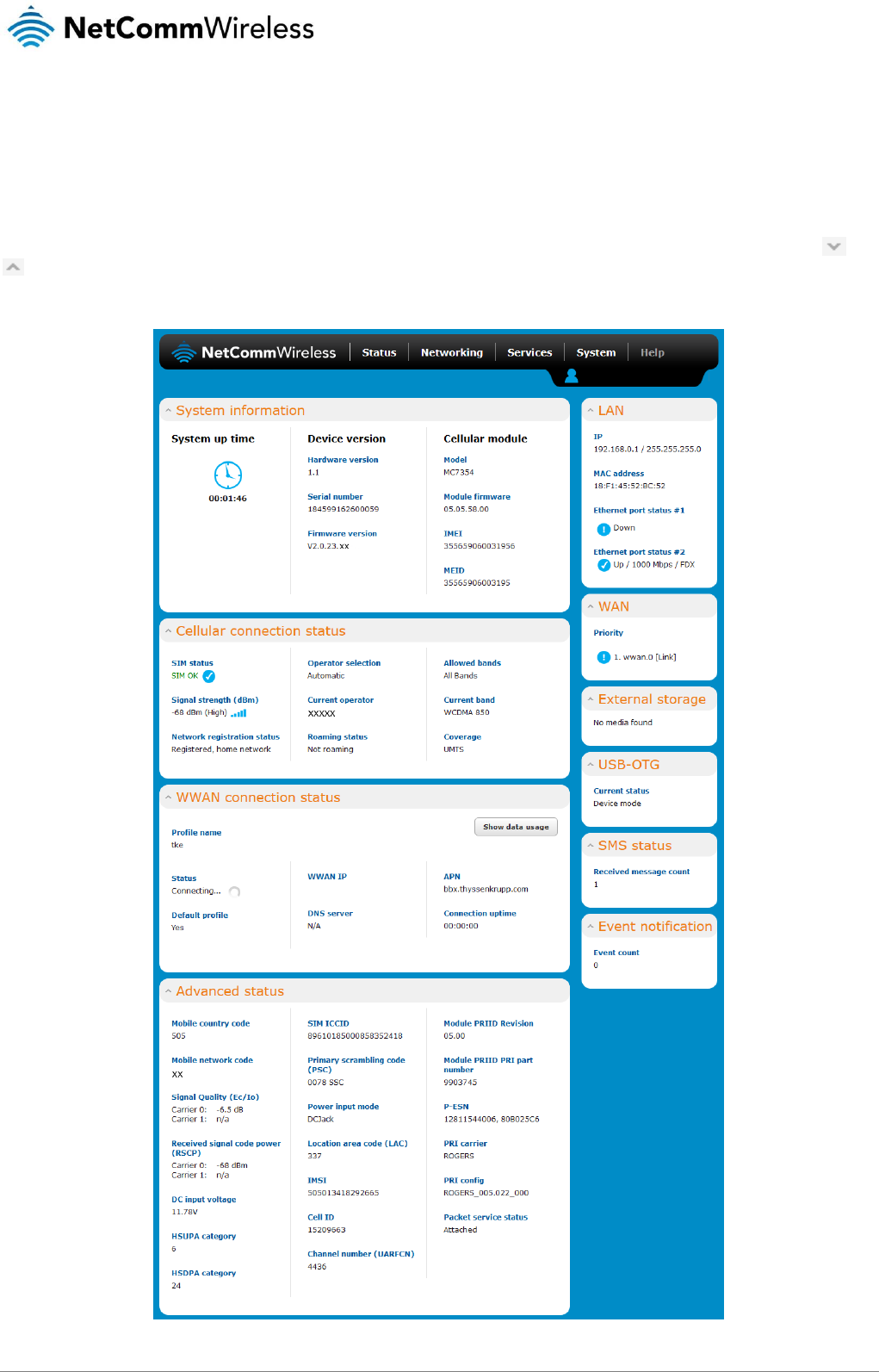
20
NetComm Wireless 4G M2M Router
www.netcommwireless.com
v1.0
Status
The status page of the web interface provides system related information and is displayed when you log in to the NTC-140-01
router management console. The status page shows System information, LAN details, Cellular connection status, Packet data
connection status, Wireless LAN status and Advanced status details. You can toggle the sections from view by clicking the or
buttons to show or hide them. Extra status boxes will appear as additional software features are enabled (e.g. VPN
connectivity).
Figure 13 - NTC-140-01 status page

www.netcommwireless.com
NetComm Wireless 4G M2M Router
21
v1.0
ITEM
DEFINITION
System information
System up time
The current uptime of the router.
Board version
The hardware version of the router.
Serial Number
The serial number of the router.
Firmware version
The firmware version of the router
Model
The type of phone module and the firmware version of the module.
Module firmware
The firmware revision of the phone module.
IMEI
The International Mobile Station Equipment Identity number used to uniquely identify a mobile device.
LAN
IP
The IP address and subnet mask of the router.
MAC Address
The MAC address of the router.
Ethernet Port Status
Displays the current status of the Ethernet port and its operating speed.
WAN
Priority
Displays the priority of the available WAN connections.
External Storage
Lists the type and size of external storage (onboard/USB), if connected.
USB-OTG
Displays the current status of the USB-OTG port (Device or host mode)
SMS status
Received message count
Displays the number of SMS messages received by the router.
Event notification
Event count
Displays the number of notifications sent using the Event notification feature.
Cellular connection status
SIM Status
Displays the activation status of the SIM in the router.
Signal strength (dBm)
The current signal strength measured in dBm
Network registration status
The status of the router’s registration for the current network.
Operator selection
The mode used to select an operator network.
Current operator
The current operator network in use.
Roaming status
The roaming status of the router.
Allowed bands
The bands to which the router may connect.
Current band
The current band being used by the router.
Coverage
The type of mobile coverage being received by the router.
WWAN Connection Status
Profile name
The name of the active profile.
Status
The connection status of the active profile.
Default profile
Indicates whether the current profile in use is the default profile.
WWAN IP
The IP address assigned by the mobile broadband carrier network.
DNS server
The primary and secondary DNS servers for the WWAN connection.
APN
The Access Point Name currently in use.
Connection uptime
The length of time of the current mobile connection session.
Advanced status
Mobile country code
The Mobile Country Code (MCC) of the router.
Mobile network code
The Mobile Network Code (MNC) of the router.
DC input voltage
Displays the current voltage of the power input source provided via the DC Input jack
HSUPA category
Displays the HSUPA category (1-9) for the current uplink
HSDPA category
Displays the HSDPA category (1-8) for the current downlink.
SIM ICCID
The Integrated Circuit Card Identifier of the SIM card used with the router, a unique number up to 19 digits in length.
Power input mode
Displays the power source being used.

22
NetComm Wireless 4G M2M Router
www.netcommwireless.com
v1.0
Tracking Area Code (TAC)
Identifies a tracking area within a particular network.
IMSI
The International mobile subscriber identity is a unique identifier of the user of a cellular network.
Cell ID
A unique code that identifies the base station from within the location area of the current mobile network signal.
Channel number (UARFCN)
The channel number of the current cellular connection.
CID
Cellular configuration ID
Module PRIID Revision
Module version used for customization.
Module PRIID PRI part number
The part number of the Module PRIID.
PRI carrier
The carrier network.
PRI config
Configuration file for the current carrier network.
Reference Signal Received
Quality (RSRQ)
RSRQ calculates signal quality taking into consideration the RSSI. It is calculated by N x RSRP / RSSI where N is the number of
Physical Resources Blocks (PRBs) over which the RSSI is measured.
Reference Signal Received Power
(RSRP)
A cell-specific reference signal used to determine RSRP.
Packet service status
Displays whether the packet service is attached or detached. When APN or username/password is changed, the device
detaches and reattaches to the network.
Table 10 - Status page item details
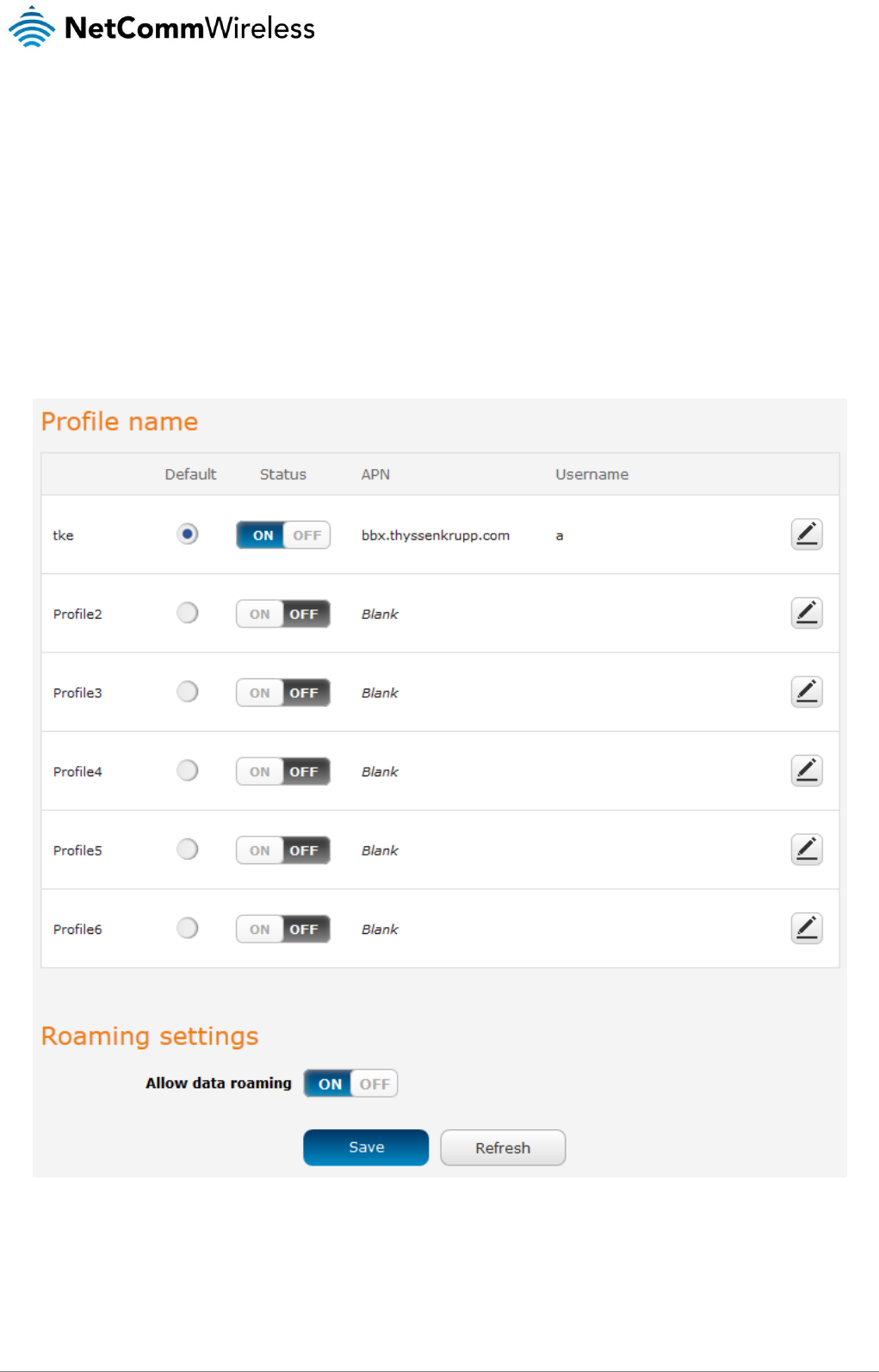
www.netcommwireless.com
NetComm Wireless 4G M2M Router
23
v1.0
Networking
The Networking section provides configuration options for Wireless WAN, LAN, Routing and VPN connectivity.
Wireless WAN
Data connection
The data connection page allows you to configure and enable/disable the connection profile. To access this page, click on the
Networking menu, and under the Wireless WAN menu, select the Data connection item.
Figure 14 – Data connection settings
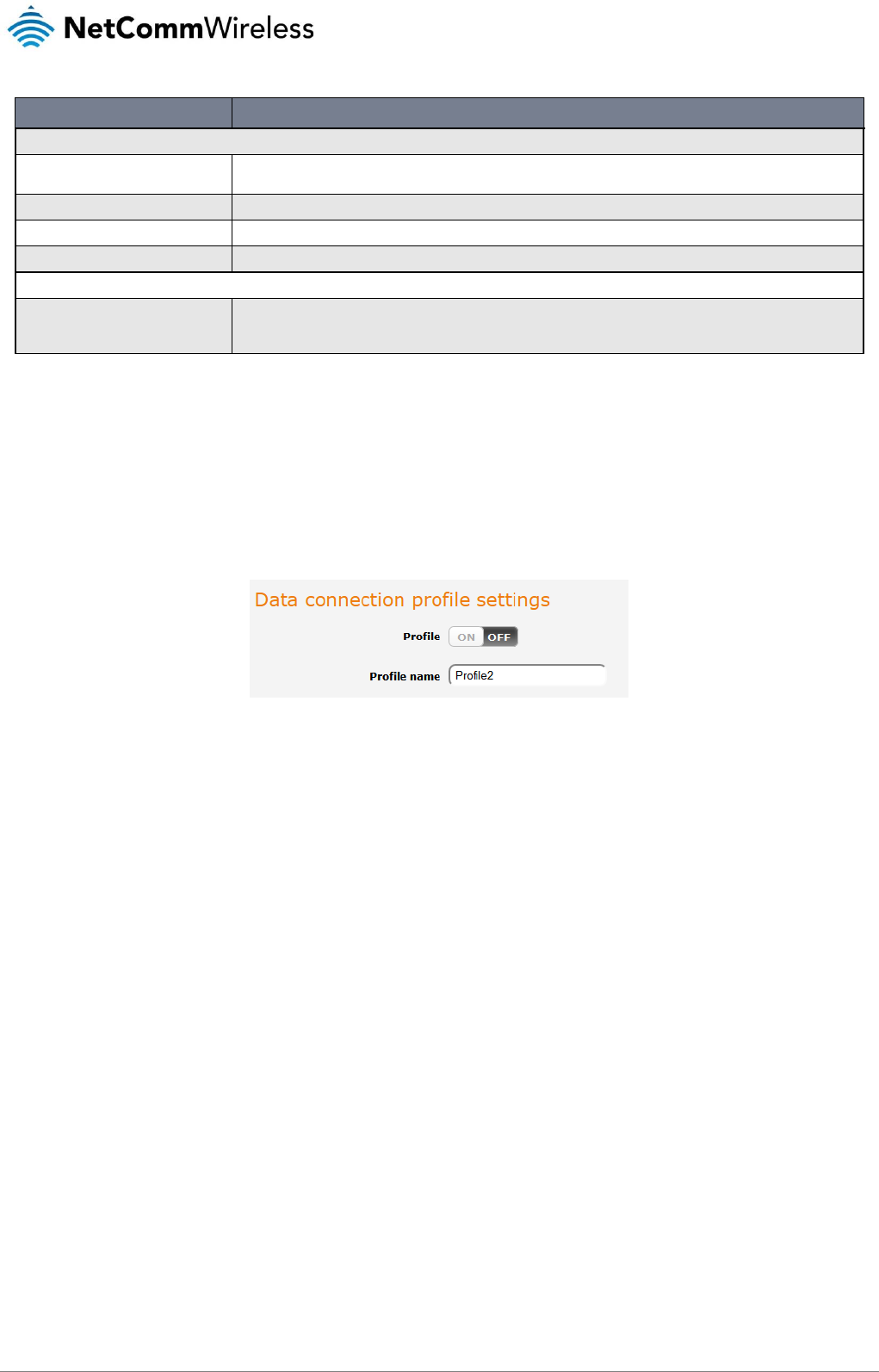
24
NetComm Wireless 4G M2M Router
www.netcommwireless.com
v1.0
ITEM
DEFINITION
Profile name
Default
Sets the corresponding profile to be the default gateway for all outbound traffic except traffic for which there are
configured static route rules or profile routing settings.
Status
Toggles the corresponding profile on and off. Only one profile may be turned on at any time.
APN
The APN configured for the corresponding profile.
Username
The username used to log on to the corresponding APN.
Roaming settings
Allow data roaming
When set to ON, the router will allow local devices to access the Wireless WAN network when it is roaming onto a
foreign network. When set to OFF, the router will deny network access to data services when roaming onto a foreign
network. This setting is OFF by default. Note that additional costs may apply when using roaming data services.
Table 11 - Data connection item details
Connecting to the mobile broadband network
The router supports the configuration of up to six APN profiles; these profiles allow you to configure the settings that the router will
use to connect to the broadband network and switch easily between different connection settings.
Manually configuring a connection profile
To manually configure a connection profile:
1. Click the Edit button corresponding to the Profile that you wish to modify. The data connection profile settings page is
displayed.
Figure 15 - Data connection profile settings
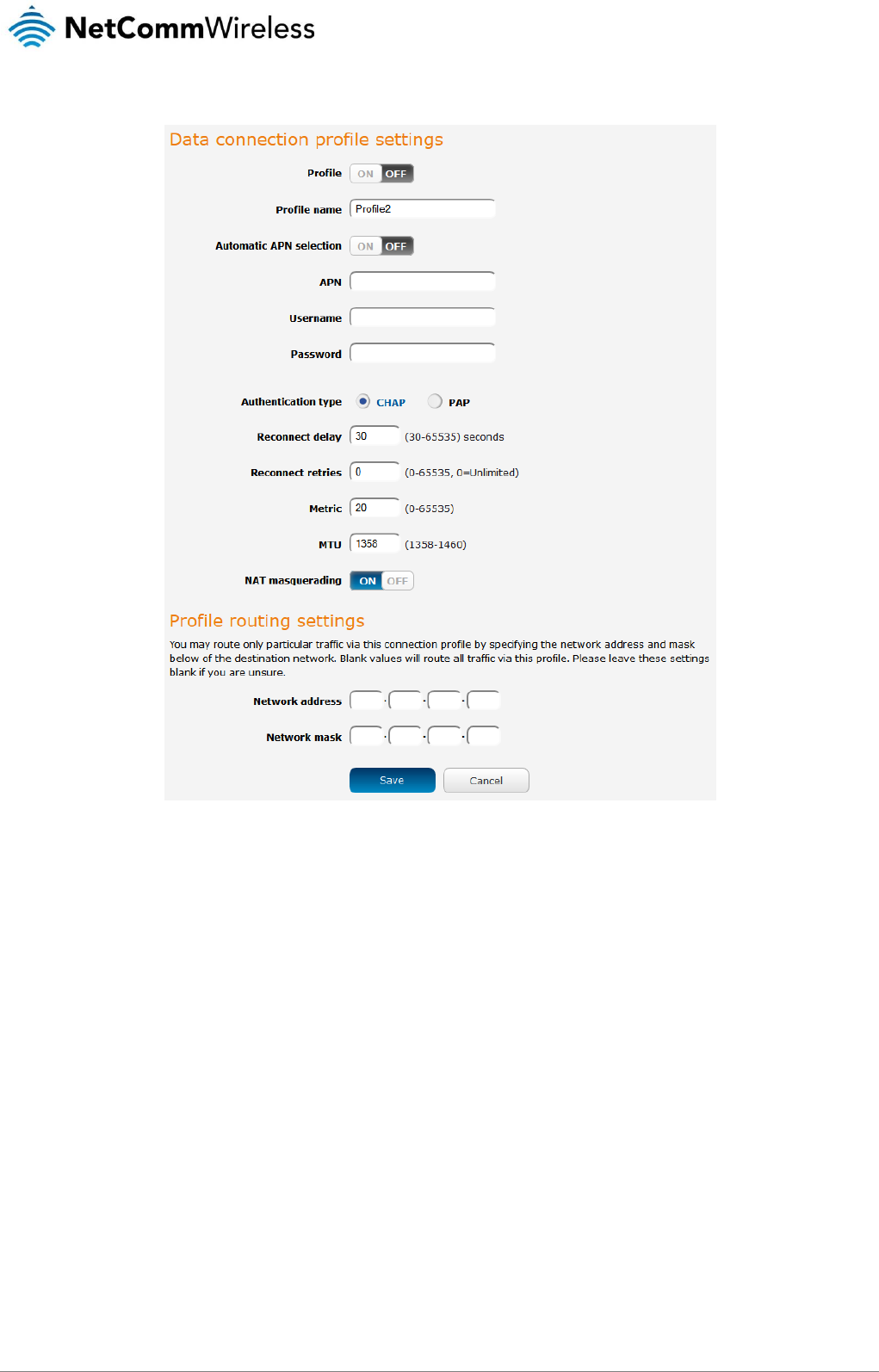
www.netcommwireless.com
NetComm Wireless 4G M2M Router
25
v1.0
2. Click the Profile toggle key to turn the profile on. Additional settings appear.
Figure 16 - Data connection settings - Profile turned on
3. In the Profile name field, enter a name for the profile. This name is only used to identify the profile on the router.
4. Ensure that the Automatic APN selection toggle key is set to off. If it is not, click it to toggle it to the off position.
5. In the APN field, enter the APN Name (Access Point Name) and if required, use the Username and Password fields to
enter your login credentials. Note that the APN and username fields have a limit of 81 characters.
6. Next to Authentication type, select either CHAP or PAP depending on the type of authentication used by your provider.
7. The Reconnect delay field specifies the number of seconds to wait between connection attempts. The default setting of 30
seconds is sufficient in most cases but you may modify it to wait up to 65535 seconds if you wish.
8. The Reconnect retries field specifies the number of times to attempt a network connection if the router fails to establish a
connection. It is set to 0 by default which causes the router to attempt to reconnect indefinitely.
9. The Metric value is used by router to prioritise routes (if multiple are available) and is set to 20 by default. This value is
sufficient in most cases but you may modify it if you are aware of the effect your changes will have on the service.
10. The MTU field allows you to modify the Maximum Transmission Unit used on the connection. Do not change this unless
instructed to by your carrier.
11. Use the NAT Masquerading toggle key to turn NAT Masquerading on or off. NAT masquerading, also known simply as
NAT is a common routing feature which allows multiple LAN devices to appear as a single WAN IP via network address
translation. In this mode, the router modifies network traffic sent and received to inform remote computers on the internet
that packets originating from a machine behind the router actually originated from the WAN IP address of the router’s
internal NAT IP address. This may be disabled if a framed route configuration is required and local devices require WAN IP
addresses.
12. Click the Save button when you have finished entering the profile details.
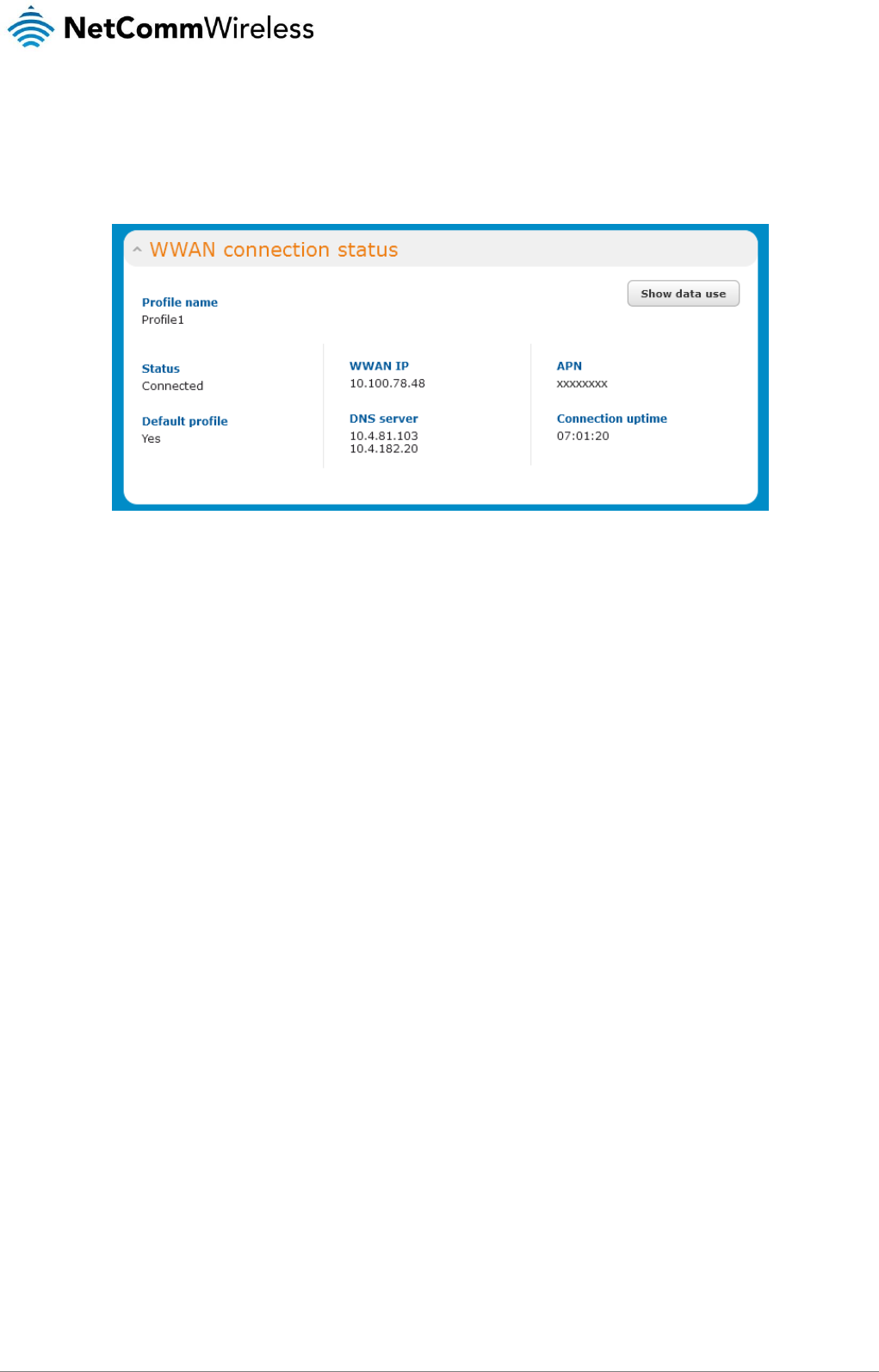
26
NetComm Wireless 4G M2M Router
www.netcommwireless.com
v1.0
Confirming a successful connection
After configuring the packet data session, and ensuring that it is enabled, click on the Status menu item at the top of the page to
return to the Status page. When there is a mobile broadband connection, the WWAN section is expanded showing the details of
the connection and the Status field displays Connected. To see details on the connected session, you can click the Show data
usage button.
Figure 17 - WWAN connection status section
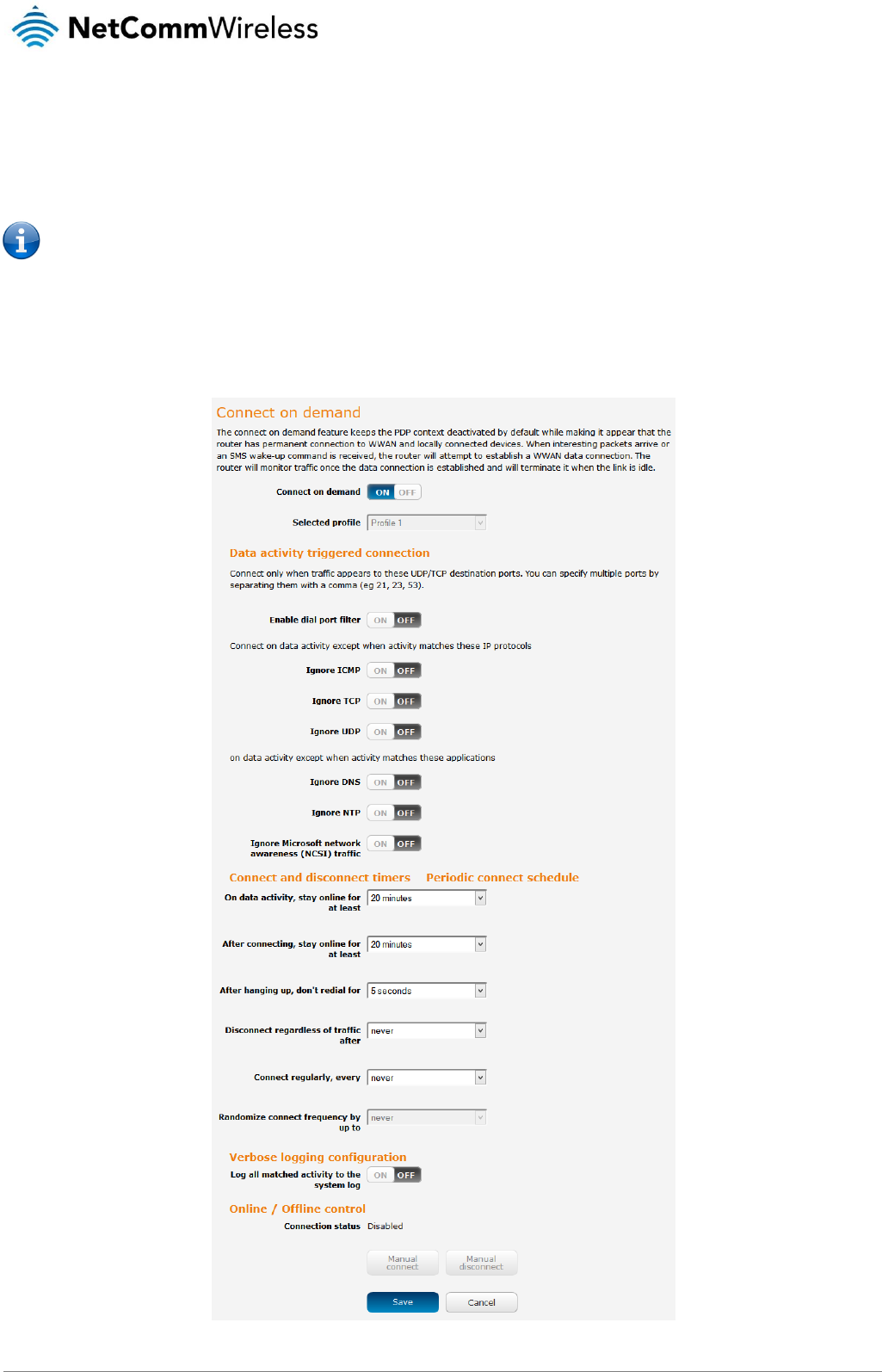
www.netcommwireless.com
NetComm Wireless 4G M2M Router
27
v1.0
Connect on demand
The Connect on demand feature keeps the Packet Data Protocol (PDP) context deactivated by default while making it appear to
locally connected devices that the router has a permanent connection to the mobile broadband network. When a packet of interest
arrives or an SMS wake-up command is received, the router attempts to establish a mobile broadband data connection. When the
data connection is established, the router monitors traffic and terminates the link when it is idle.
Note: When interesting packets arrive, the recovery time for the wireless WAN connection is approximately 20-30 seconds.
Configuring Connect on demand
To configure Connect on demand:
1. Click the Networking menu item from the top menu bar.
2. On the Connect on demand page, click the Connect on demand toggle key so that it is ON. Extra options appear. See the
following sub-sections for further instructions.
Figure 18 - Connect on demand configuration options
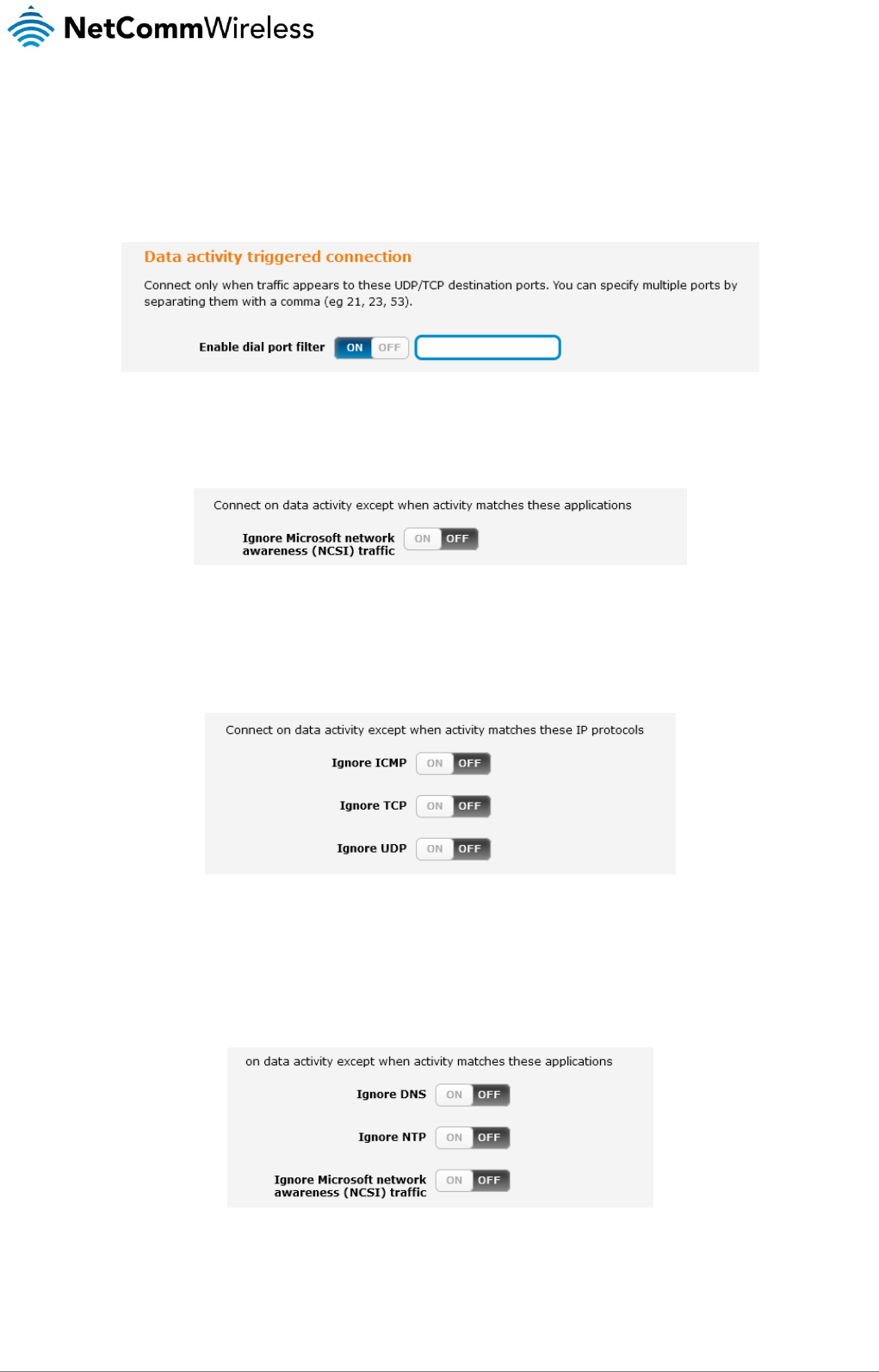
28
NetComm Wireless 4G M2M Router
www.netcommwireless.com
v1.0
Setting the router to dial a connection when traffic is detected on specific ports
In some situations, you may wish to have the internet connection disabled except at times when outbound traffic to a particular
external host’s port or group of ports is sent to the router. To use this feature, click Enable dial port filter and enter the port number
or list of port numbers separated by commas. When you select this option, all outbound ICMP/TCP/UDP packets to any remote
host on the specified port(s) will trigger the connection to dial. Note that when this feature is enabled, the options to ignore specific
packet types are not available.
Figure 19 – Connect on demand - Data activity triggered connection
You can allow Microsoft network awareness (NCSI) traffic through but if you prefer that they do not trigger the connection, click the
Ignore Microsoft network awareness (NCSI) traffic toggle key to set it to ON.
Figure 20 - Connect on demand - Ignore NCSI traffic
Excluding certain packet types from triggering the connection to dial
Depending on your environment, you might prefer to exclude certain types of traffic passing through the router from triggering the
data connection. You can tell the router to ignore outbound TCP, UDP or ICMP packets. When any of these options are checked
the router will not dial a connection when that type of outbound destined data packet reaches the router from a locally connected
device.
Figure 21 – Connect on demand - Excluding IP protocols
Excluding certain application types from triggering the connection to dial
Some devices may generate general traffic as a part of normal operation which you may not want to trigger the data connection.
You can set the router to ignore Domain Name System (DNS), Network Time Protocol (NTP) or Microsoft network awareness (NCSI)
traffic from devices behind the router. When you check the box for these options, it tells the router to ignore the request from that
application type and will not dial a connection when this data type is received.
Figure 22 - Connect on demand - Excluding application types
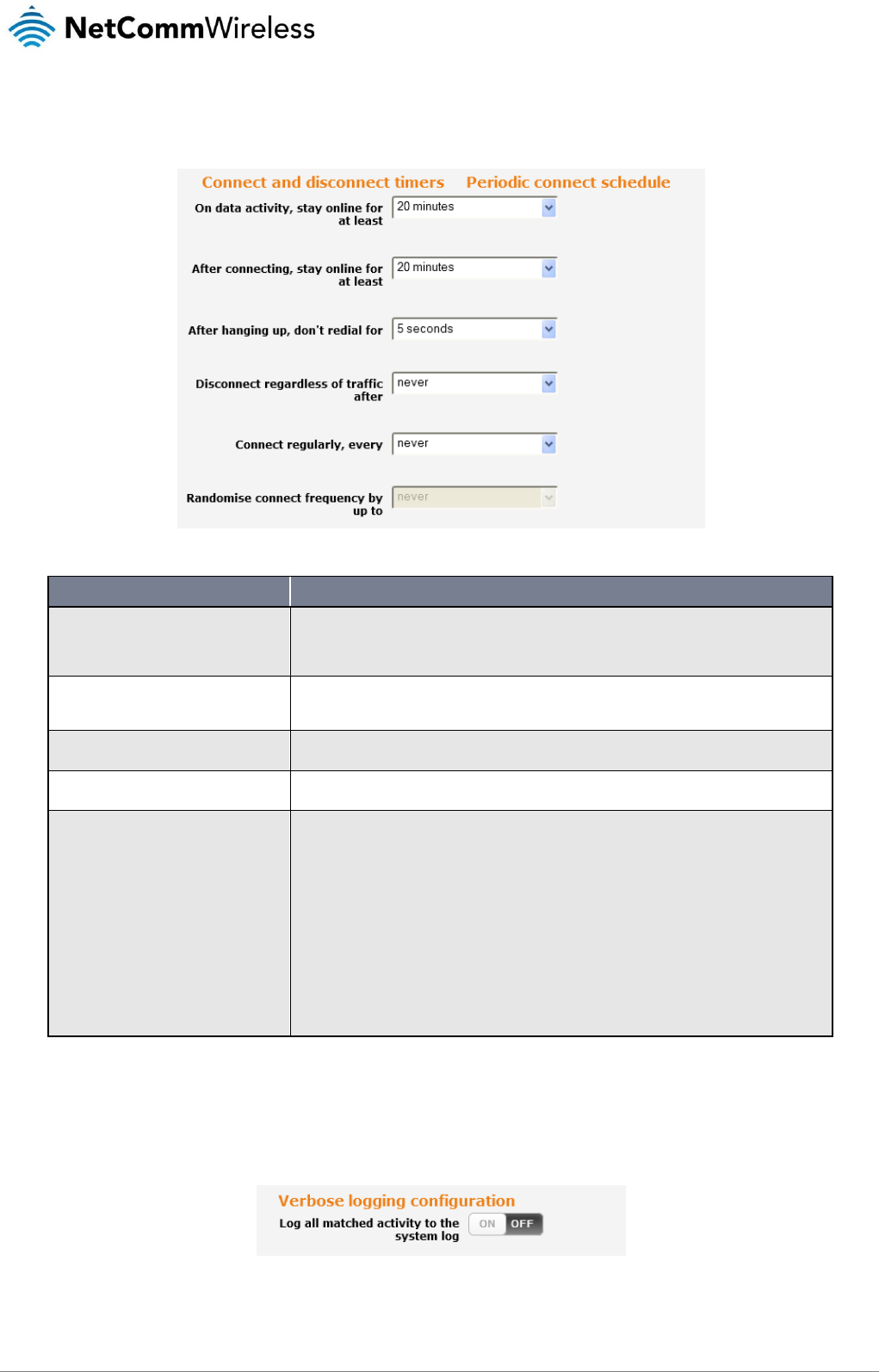
www.netcommwireless.com
NetComm Wireless 4G M2M Router
29
v1.0
Setting timers for connection and disconnection
The router has a number of timer settings which let you determine when a connection is dialled and when it is disconnected.
Figure 23 – Connect on demand - Connect and disconnect timers
OPTION
DESCRIPTION
On data activity, stay online for at least
When traffic as per the configured settings above appear, the router will either continue to stay
online, or dial a connection and will not disconnect it for the specified time period (min. 1 minute,
max. 1 hour). This timer is continuously reset throughout the duration of a dial-up session, whenever
data activity is detected matching the rules above.
After connecting, stay online for at least
This timer configures the router to not hang-up the connection for the specified time period after
initially dialing the connection. This setting cannot be less than the keep online period above. This
timer affects the connection only once per dial up session, at the beginning of the session.
After hanging up, don’t redial for
After a connection has been disconnected, you can tell the router to rest for a period of time before
re-dialing.
Disconnect regardless of traffic after
Forces the router to disconnect the connection regardless of the traffic passing through it. The
default setting is
never
.
Connect regularly, every / Randomize
connect frequency by up to
If you want to have the router dial a connection at regular intervals, use Connect regularly, every to
specify the interval between dials. Setting this to
never
effectively disables this option.
The router also features the ability to randomize the time at which the first dial action is performed.
This is useful in situations such as where you have numerous routers in an area where a power
outage has occurred. Setting a random dial time helps to reduce network congestion when all the
routers are powered on so they do not all try to connect simultaneously.
When Connect regularly, every is set to at least 2 minutes, you are able to configure the router to
randomize the time it begins to dial. The randomized dial timer only affects the initial dial after the unit
powers on or after the settings are saved. For example, if you configure the router to dial every 2
minutes with a randomized dial starting time of 1 minute, the router waits for the Connect regularly,
every time (2 minutes) and then randomly selects a time less than or equal to the Randomize connect
frequency by up to time (1 minute). After the randomly selected time has elapsed, the router dials
the connection. After the first dial, the router dials the connection every 2 minutes, ignoring the
Randomize connect frequency by up to time.
Table 12 - Connect on demand - Connect and disconnect timers descriptions
Verbose mode
The router provides the option of logging all the data activity which matches the settings for the Connect on demand feature for
advanced troubleshooting purposes. To enable the logging of the Connect on demand feature, click the Enable verbose mode
toggle key to switch it ON. See the System log section for more information.
Figure 24 – Connect on demand - Verbose logging configuration
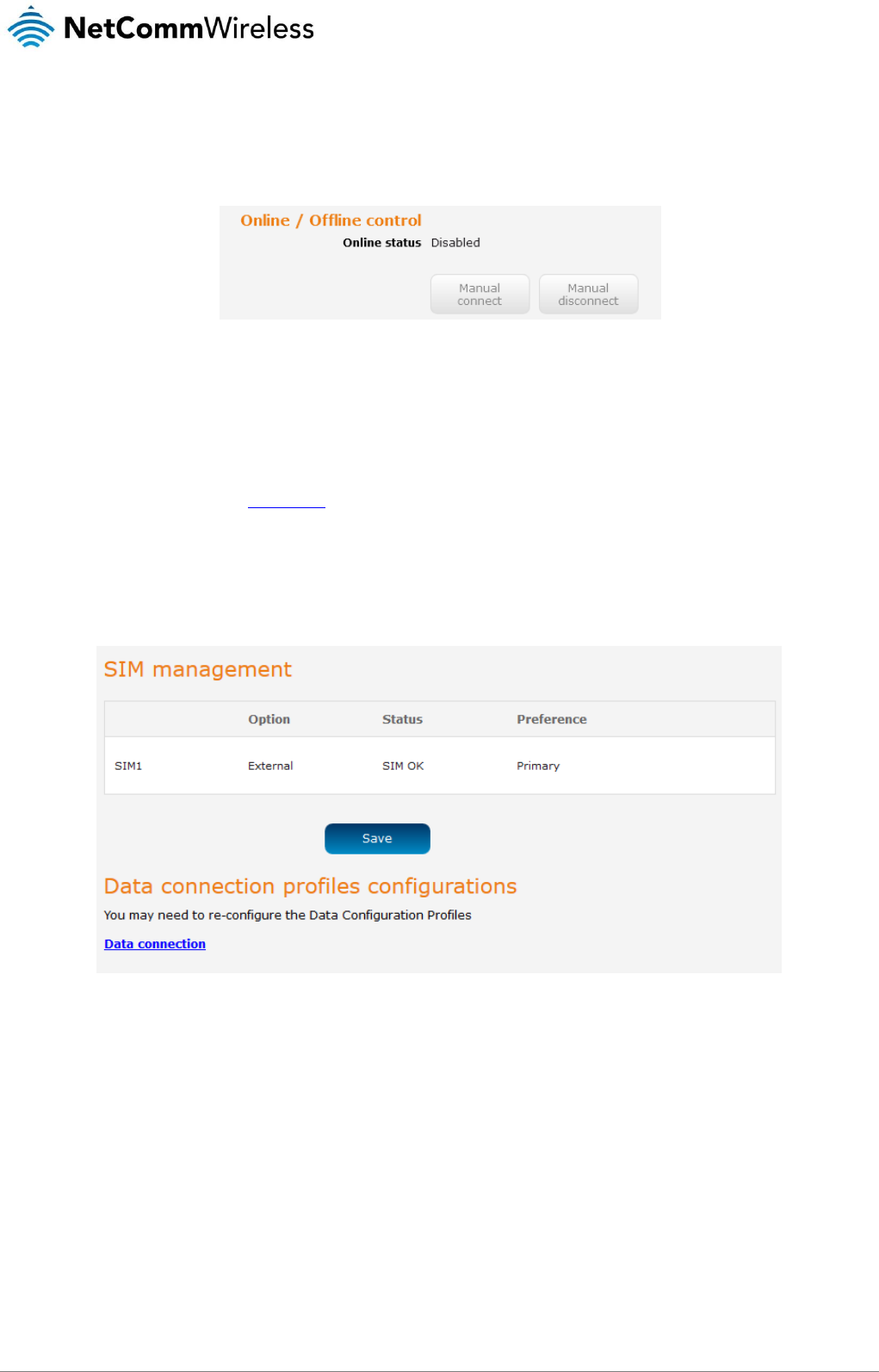
30
NetComm Wireless 4G M2M Router
www.netcommwireless.com
v1.0
Manually connecting/disconnecting
There may be times when you need to either force a connection to be made or force a disconnection manually. You can use the
Manual connect and Manual disconnect buttons to do this whenever necessary. The online status of the connection is displayed
above the buttons.
Figure 25 - Connect on demand - Online/Offline control
When you have finished configuring the options for the Connect on demand feature, click the Save button at the bottom to save
your changes.
SMS Wake up
The router can also be woken up by means of an SMS message using the SMS diagnostics feature by sending an executable
wakeup command via SMS. See the Diagnostics section for details on using the SMS Wake up function.
SIM management
The SIM management page displays the status of the SIM card.
Figure 26 – SIM Management
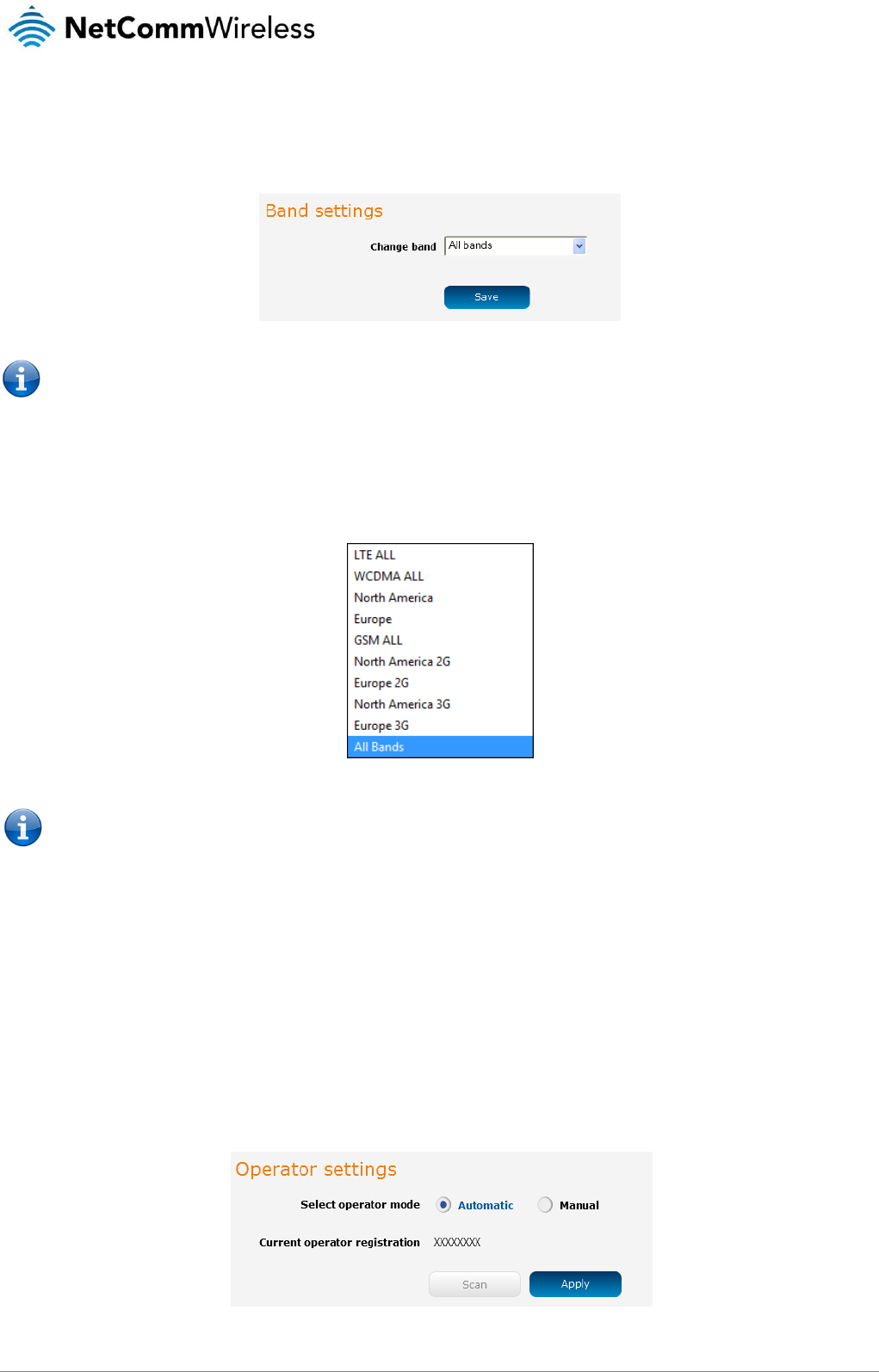
www.netcommwireless.com
NetComm Wireless 4G M2M Router
31
v1.0
Operator settings
The Operator settings page enables you to select which frequency band you will use for your connection and enables you to scan
for available network operators in your area.
Figure 27 - Band settings
Note: In order to change the operator’s band settings, the data connection must be disabled. When you access this page,
you are prompted to disable the data connection if it is already active.
You may want to do this if you’re using the router in a country with multiple frequency networks that may not all support High Speed
Packet Access (HSPA). You can select the router to only connect on the network frequencies that suit your requirements.
Use the Change band drop down list to select the band you wish to use.
The following band settings options are available:
Note: The available bands may vary depending on your variant of the product.
It is not necessary to change the default setting of All bands in most cases. In fact, locking to a particular band can cause
connection difficulties if the device is moved to a location where the forced band selection is no longer available.
When All bands is selected, the router attempts to find the most suitable band based on the available networks for the inserted SIM
card.
The “2G all”, “WCDMA all”, “LTE all”, “3G/2G all” and “LTE/3G all” options allow you to force the device to lock to those particular
networks only.
Click the Save button to save and apply your selection.
Operator settings
The operator settings feature allows you perform a scan of available networks, and to optionally lock to a particular network
returned by the network scan. To scan for available networks, set the Select operator mode from automatic to Manual then click the
scan button. This operation can take a few minutes and requires that the packet data session be disconnected prior to scanning.
Figure 28 - Operator settings
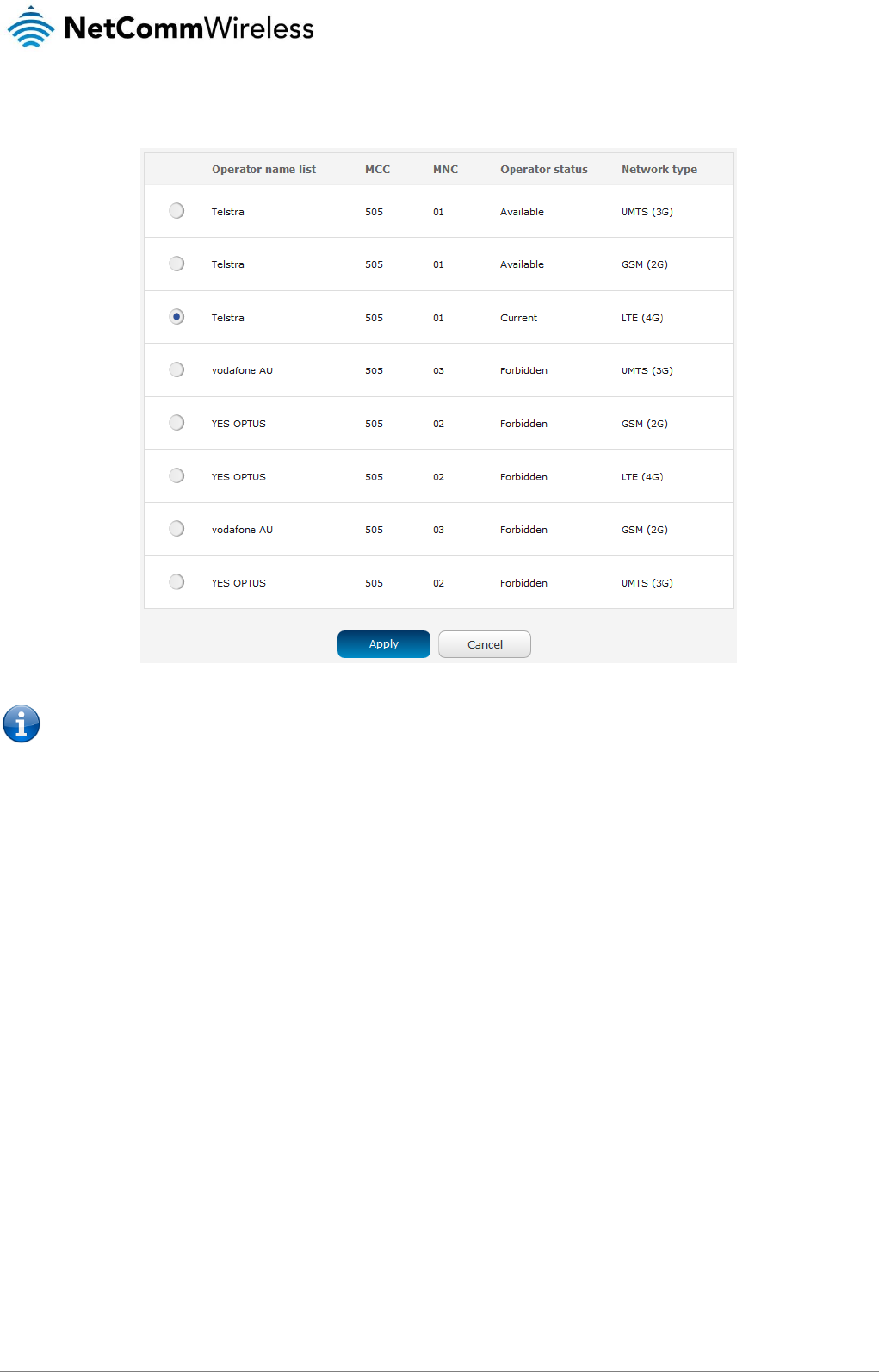
32
NetComm Wireless 4G M2M Router
www.netcommwireless.com
v1.0
A list of the detected cellular service carriers in your area is displayed.
Figure 29 - Detected operator list
Note: Certain module firmware versions may not allow forbidden operators to be selected.
Select the most appropriate service from the list shown and click Apply.
When Select operator mode is set to Automatic, the router selects the most appropriate operator based on the inserted SIM card.
This is the default option and is sufficient for most users.
SIM security settings
The SIM security settings page can be used for authenticating SIM cards that have been configured with a security PIN.
Unlocking a PIN locked SIM
If the SIM card is locked, you will receive a notice when you access the Status page after which you will be directed to the PIN
settings page to enter the PIN. The PIN settings page lists the status of the SIM at the top of the page.
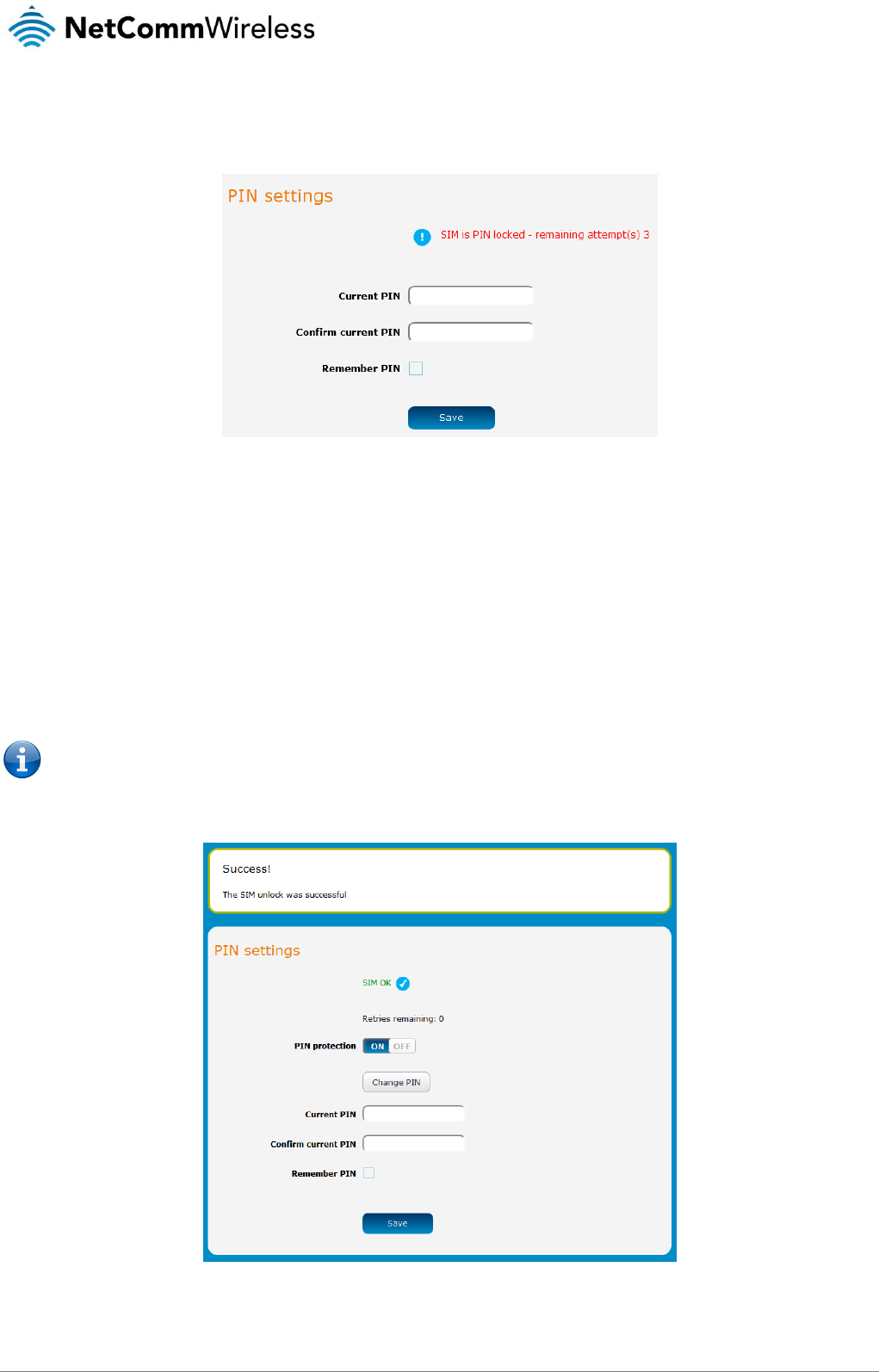
www.netcommwireless.com
NetComm Wireless 4G M2M Router
33
v1.0
If you are not redirected to the PIN settings page, to unlock the SIM:
a) Click on the Networking menu from the top menu bar, and then click SIM security settings.
Figure 30 - SIM security settings - SIM PIN locked
b) Enter the PIN in the Current PIN field and then enter it again in the Confirm current PIN field to confirm the PIN.
c) If you are placing the router in a remote, unattended location, you may wish to check the Remember PIN option. This
feature allows the router to automatically send the PIN to the SIM each time the SIM asks for it (usually at power up). This
enables the SIM to be PIN locked (to prevent unauthorised re-use of the SIM elsewhere), while still allowing the router to
connect to the cellular service.
When this feature is enabled, the PIN you enter when setting the Remember PIN feature is encrypted and stored locally on
the router. The next time the SIM asks the router for the PIN, the router decrypts the PIN and automatically sends it to the
SIM without user intervention.
When this feature is disabled and the SIM is PIN locked and the PIN must be manually entered via the router‘s
configuration interface. In situations where the router will be unattended, this is not desirable.
Note: Select Remember PIN if you do not want to enter the PIN code each time the SIM is inserted.
d) Click the Save button. If successful, the router displays the following screen:
Figure 31 - SIM security settings - SIM unlock successful
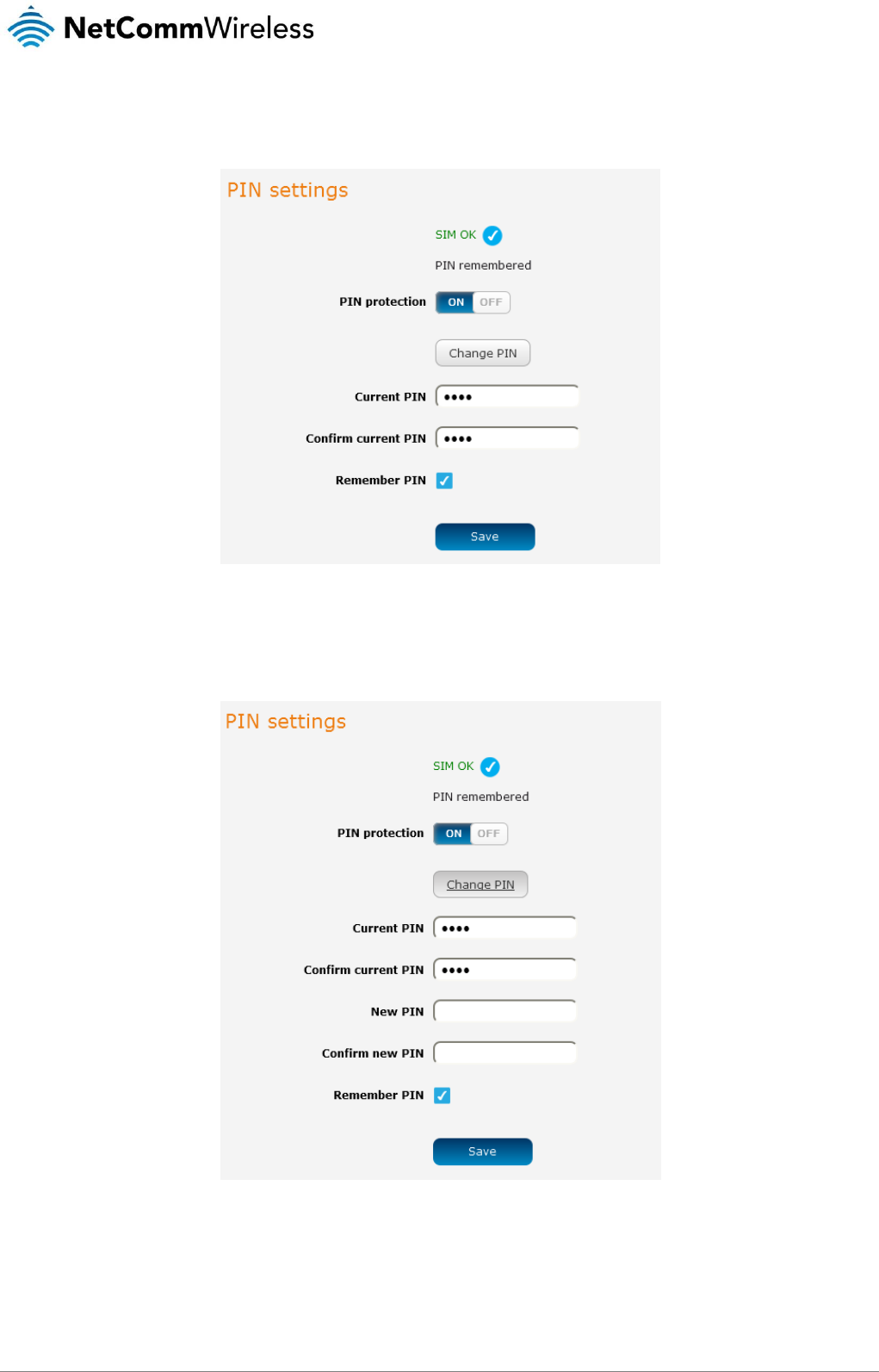
34
NetComm Wireless 4G M2M Router
www.netcommwireless.com
v1.0
Enabling/Disabling SIM PIN protection
The security PIN protection can be turned on or off using the PIN protection toggle key.
Figure 32 - PIN Settings
Changing the SIM PIN code
If you would like to change the PIN, click the Change PIN button and enter the current PIN into the Current PIN and Confirm current
PIN fields, then enter the desired PIN into the New PIN and Confirm new PIN fields and click the Save button.
Figure 33 - PIN settings - Change PIN
When the PIN has been changed successfully, the following screen is displayed:
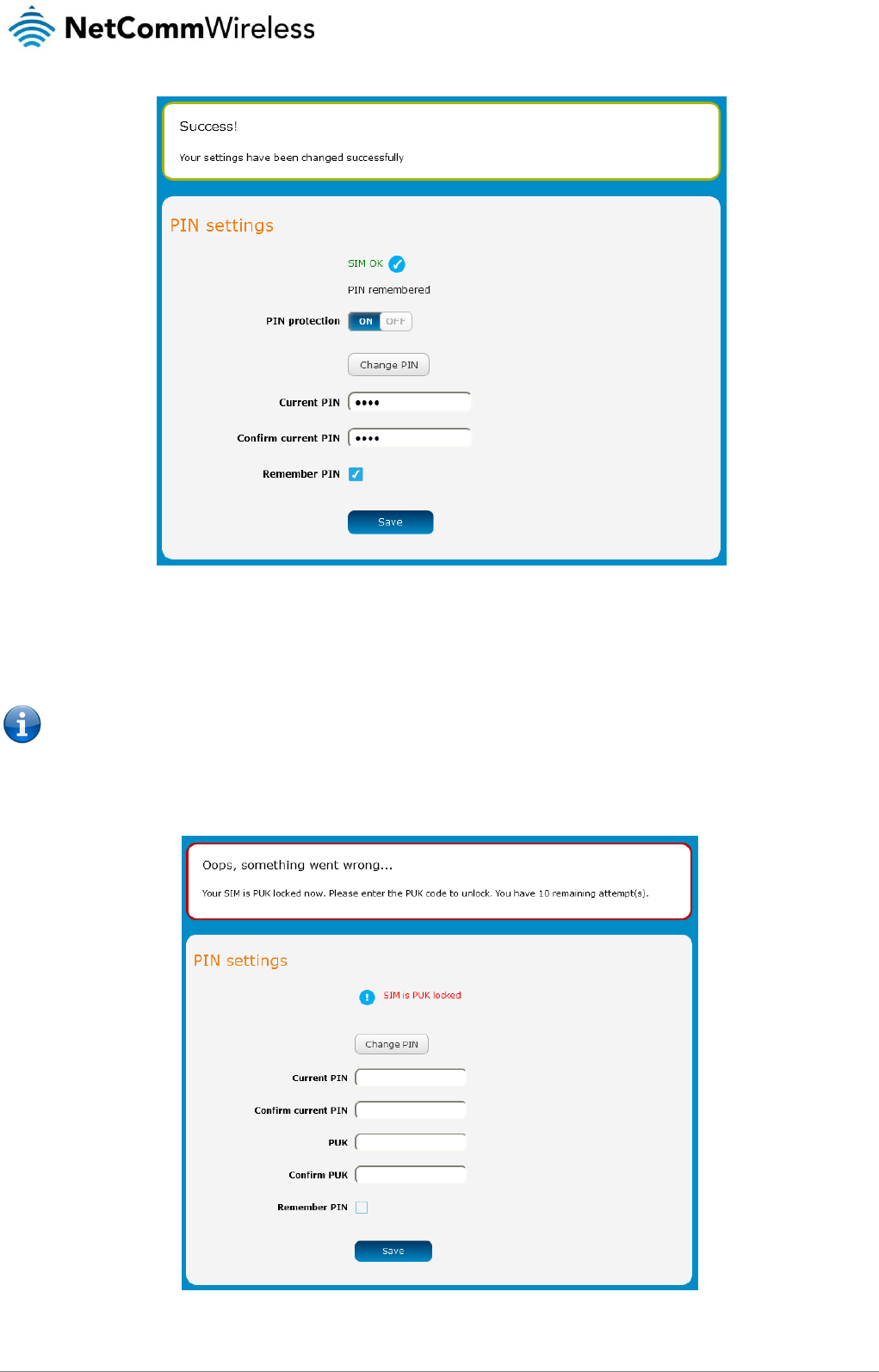
www.netcommwireless.com
NetComm Wireless 4G M2M Router
35
v1.0
Figure 34 - SIM security settings – PIN unlock successful
Unlocking a PUK locked SIM
After three incorrect attempts at entering the PIN, the SIM card becomes PUK (Personal Unblocking Key) locked and you are
requested to enter a PUK code to unlock it.
Note: To obtain the PUK unlock code, you must contact your service provider.
You will be issued a PUK to enable you to unlock the SIM and enter a new PIN. Enter the new PIN and PUK codes.
Click the Save button when you have finished entering the new PIN and PUK codes.
Figure 35 - SIM security - SIM PUK locked
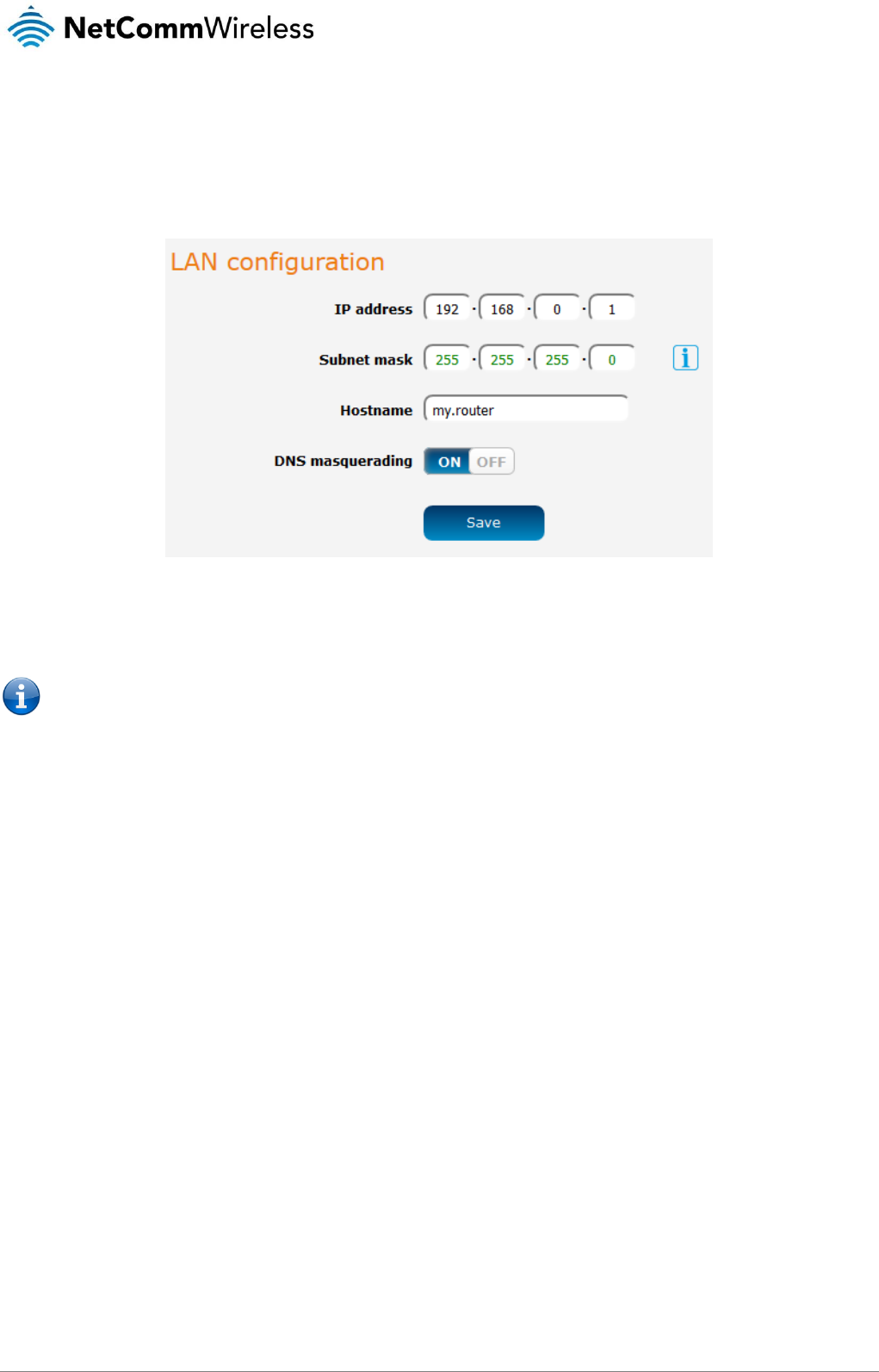
36
NetComm Wireless 4G M2M Router
www.netcommwireless.com
v1.0
LAN
LAN configuration
The LAN configuration page is used to configure the LAN settings of the router and to enable or disable DNS Masquerading. To
access the LAN configuration page, click on the Networking menu at the top of the screen, then click on the LAN menu on the left.
Figure 36 – LAN configuration settings
The default IP of the LAN port is 192.168.0.1 with subnet mask 255.255.255.0. To change the IP address or Subnet mask, enter
the new IP Address and/or Subnet mask and click the Save button.
Note: If you change the IP address, remember to reboot the router and enter the new IP address into your browser address
bar.
DNS masquerading
DNS masquerading allows the router to proxy DNS requests from LAN clients to dynamically assigned DNS servers. When enabled,
clients on the router’s LAN can then use the router as a DNS server without needing to know the dynamically assigned cellular
network DNS servers.
With DNS masquerading ON, the DHCP server embedded in the NTC-140-01 router hands out its own IP address (e.g.
192.168.0.1) as the DNS server address to LAN clients. The downstream clients then send DNS requests to the NTC-140-01 router
which proxies them to the upstream DNS servers.
With DNS masquerading OFF, the DHCP server hands out the upstream DNS server IP addresses to downstream clients directly,
so that downstream clients send DNS requests directly to the upstream DNS servers without being proxied by the NTC-140-01
router.
You may also override the DNS Masquerading option by specifying custom DNS Server IP addresses in the DHCP Server
configuration mentioned in the next section of this guide. In this case the DHCP server assigns downstream devices the manually
configured addresses and the DNS Masquerading option is ignored.
In most cases, it is not necessary to disable DNS masquerading but if you need to, click the DNS masquerading toggle key to turn it
OFF and then click the Save button.
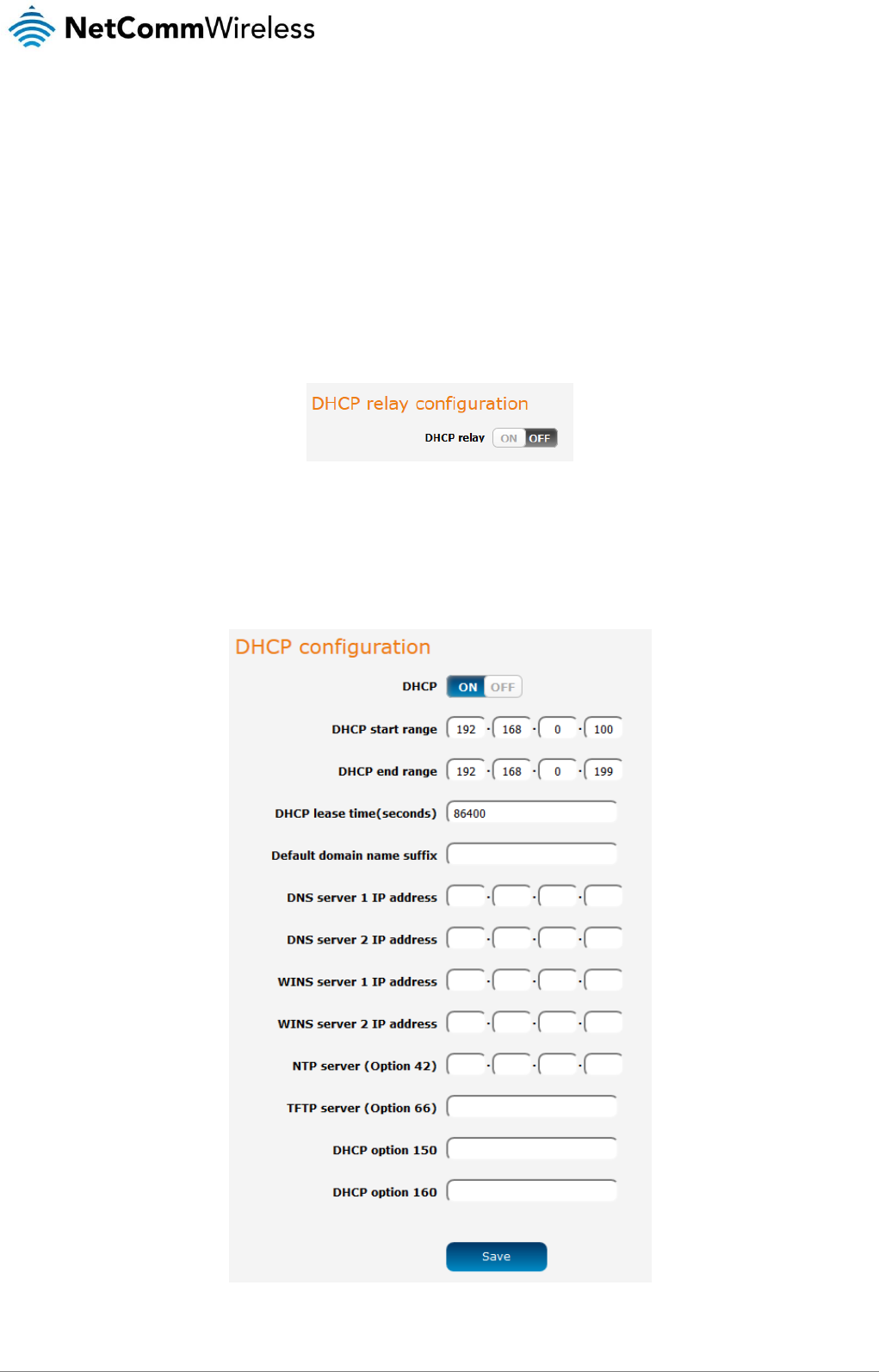
www.netcommwireless.com
NetComm Wireless 4G M2M Router
37
v1.0
DHCP
The DHCP page is used to adjust the settings used by the router’s built in DHCP Server which assigns IP addresses to locally
connected devices. To access the LAN configuration page, click on the Networking menu at the top of the screen, click on the LAN
menu on the left then select the DHCP menu item.
DHCP relay configuration
In advanced networks configurations where the NTC-140-01 router should not be responsible for DHCP assignment, but instead an
existing DHCP server is located on the Wireless WAN or LAN connections, the clients behind the NTC-140-01 router are able to
communicate with the DHCP server when DHCP relay is enabled. This enables the NTC-140-01 router to accept client broadcast
messages and to forward them onto another subnet.
To configure the router to act as a DHCP relay agent click the DHCP relay toggle key to turn it ON and enter the DHCP server
address into the DHCP server address field. DHCP relay is disabled by default.
Figure 37 – DHCP relay configuration
DHCP configuration
You can manually set the start and end address range to be used to automatically assign addresses within, the lease time of the
assigned address, the default domain name suffix, primary and secondary DNS server, the primary and secondary WINS server, as
well as the advanced DHCP settings such as NTP, TFTP and Option 150/Option 160 (VoIP options).
Figure 38 - DHCP configuration
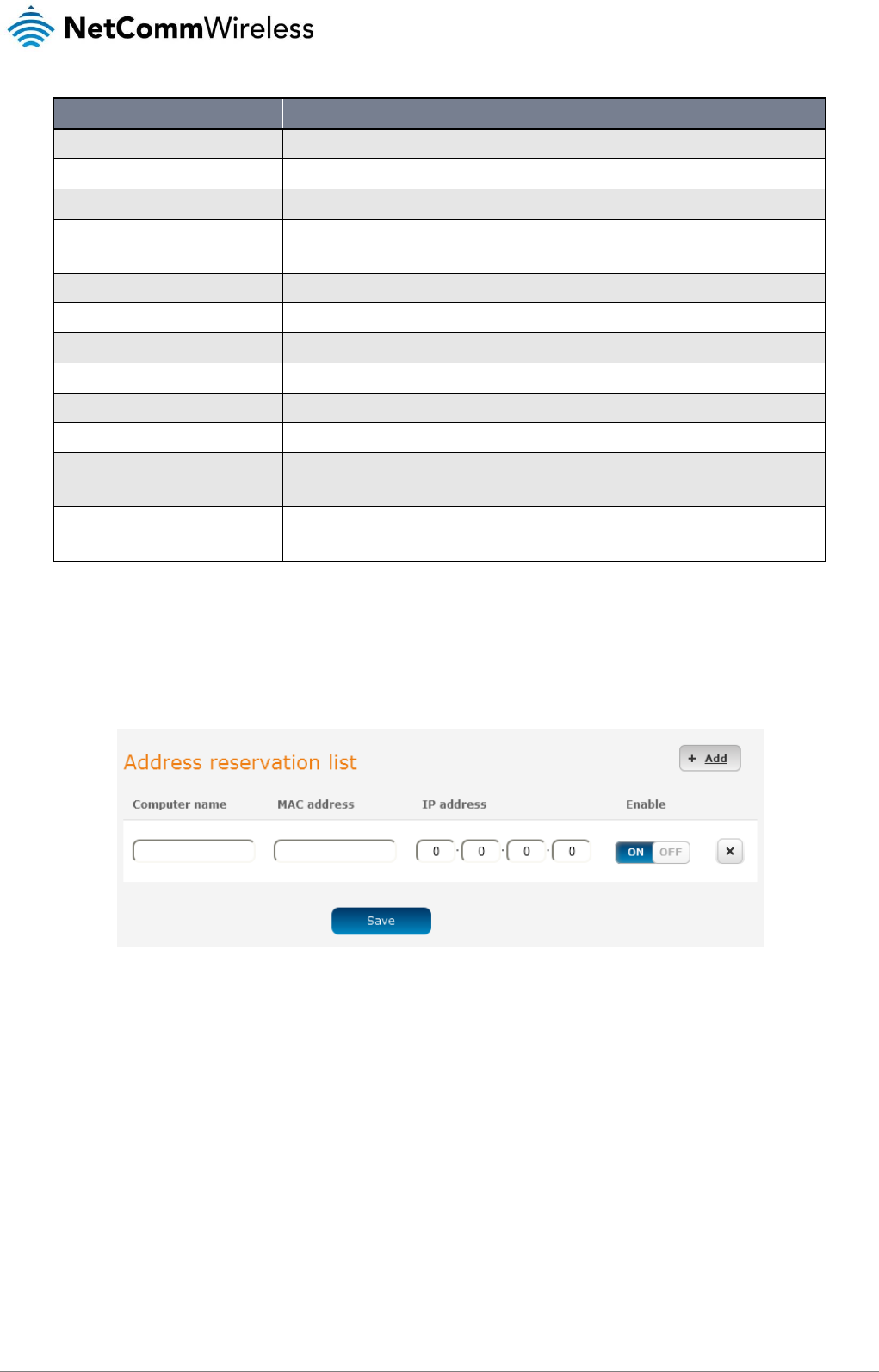
38
NetComm Wireless 4G M2M Router
www.netcommwireless.com
v1.0
OPTION
DESCRIPTION
DHCP start range
Sets the first IP address of the DHCP range
DHCP end range
Sets the last IP address of the DHCP range
DHCP lease time (seconds)
The length of time in seconds that DHCP allocated IP addresses are valid
Default domain name suffix
Specifies the default domain name suffix for the DHCP clients. A domain name suffix enables users
to access a local server, for example, server1, without typing the full domain name
server1.domain.com
DNS server 1 IP address
Specifies the primary DNS (Domain Name System) server’s IP address.
DNS server 2 IP address
Specifies the secondary DNS (Domain Name System) server’s IP address.
WINS server 1 IP address
Specifies the primary WINS (Windows Internet Name Service) server IP address
WINS server 2 IP address
Specifies the secondary WINS (Windows Internet Name Service) server IP address
NTP server (Option 42)
Specifies the IP address of the NTP (Network Time Protocol) server
TFTP Server (Option 66)
Specifies the TFTP (Trivial File Transfer Protocol) server
DHCP option 150
This is used to configure Cisco IP phones. When a Cisco IP phone starts, if it is not pre-configured
with the IP address and TFTP address, it sends a request to the DHCP server to obtain this
information. Specify the string which will be sent as a reply to the option 150 request.
DHCP option 160
This is used to configure Polycom IP phones. When a Polycom IP phone starts, if it is not pre-
configured with the IP address and TFTP address, it sends a request to the DHCP server to obtain
this information. Specify the string which will be sent as a reply to the option 160 request.
Enter the desired DHCP options and click the Save button.
Address reservation list
DHCP clients are dynamically assigned an IP address as they connect, but you can reserve an address for a particular device using
the address reservation list.
Figure 39 – DHCP – Address reservation list
To add a device to the address reservation list:
1. Click the +Add button.
2. In the Computer Name field enter a name for the device.
3. In the MAC Address field, enter the device’s MAC address.
4. In the IP Address fields, enter the IP address that you wish to reserve for the device.
5. If the Enable toggle key is not set to ON, click it to switch it to the ON position.
6. Click the Save button to save the settings.

www.netcommwireless.com
NetComm Wireless 4G M2M Router
39
v1.0
Dynamic DHCP client list
The Dynamic DHCP client list displays a list of the DHCP clients. If you want to reserve the current IP address for future use, click
the Clone button and the details will be copied to the address reservation list fields. Remember to click the Save button under the
Address reservation list section to confirm the configuration.
Figure 40 - Dynamic DHCP client list
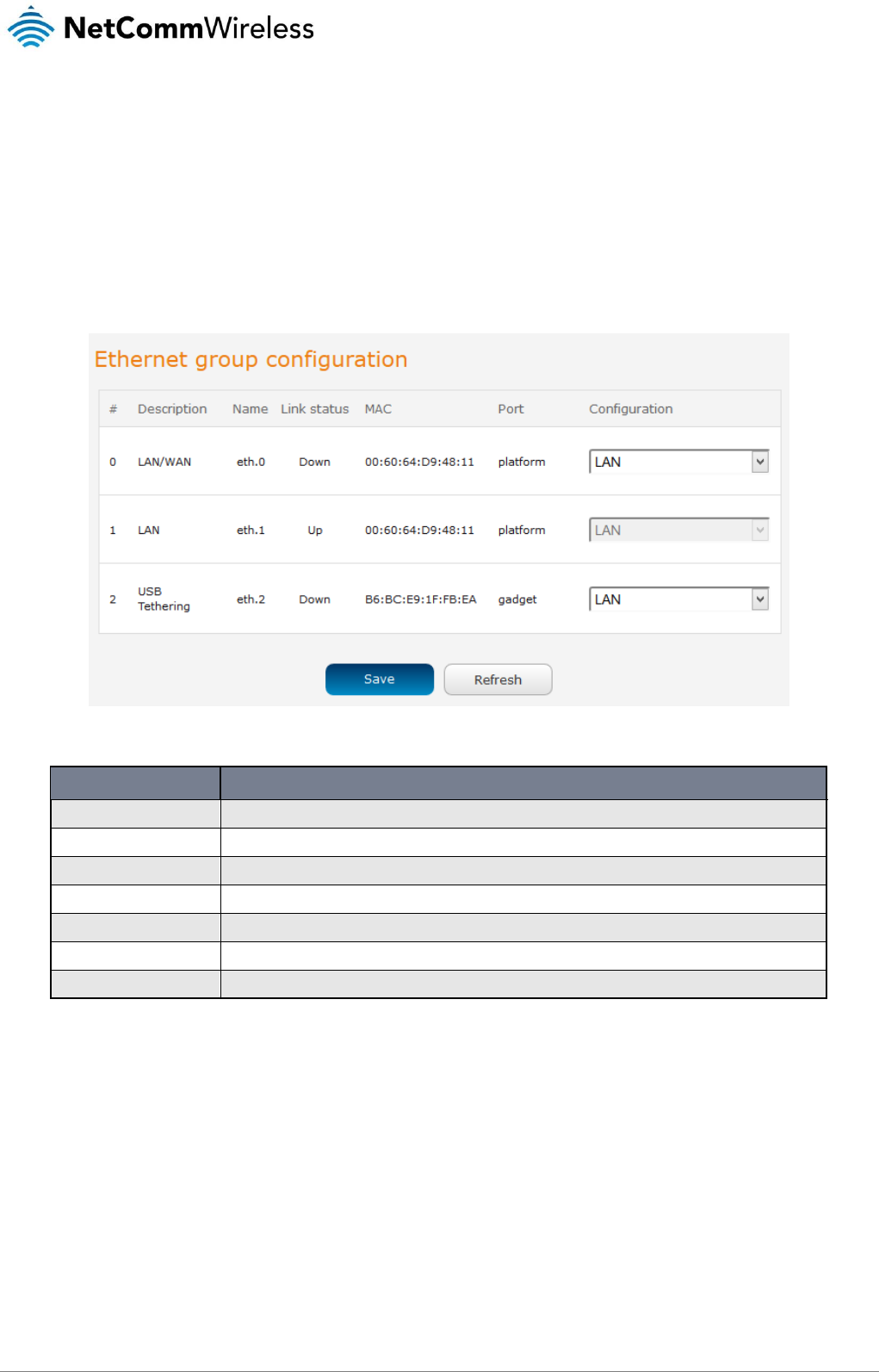
40
NetComm Wireless 4G M2M Router
www.netcommwireless.com
v1.0
Ethernet LAN/WAN
The Ethernet LAN/WAN pages provide configuration options for the two built-in Ethernet ports and any USB-to-Ethernet ports you
may connect.
Ethernet group
The Ethernet group page displays the Ethernet interfaces and allows you to configure whether they operate in LAN or WAN mode.
To access the Ethernet group page, click on the Networking menu at the top of the screen, click on the Ethernet LAN/WAN menu
on the left then select the Ethernet group menu item.
Figure 41 - Ethernet group configuration
OPTION
DEFINITION
#
A number identifying the interface on the router.
Description
A description of the type of interface.
Name
The name used to identify the interface on the router.
Link status
Displays whether the interface is inserted
MAC
The MAC address of the interface.
Port
The type of port.
Configuration
Select whether the port operates as a LAN or WAN port.
Table 13 - Ethernet group configuration items
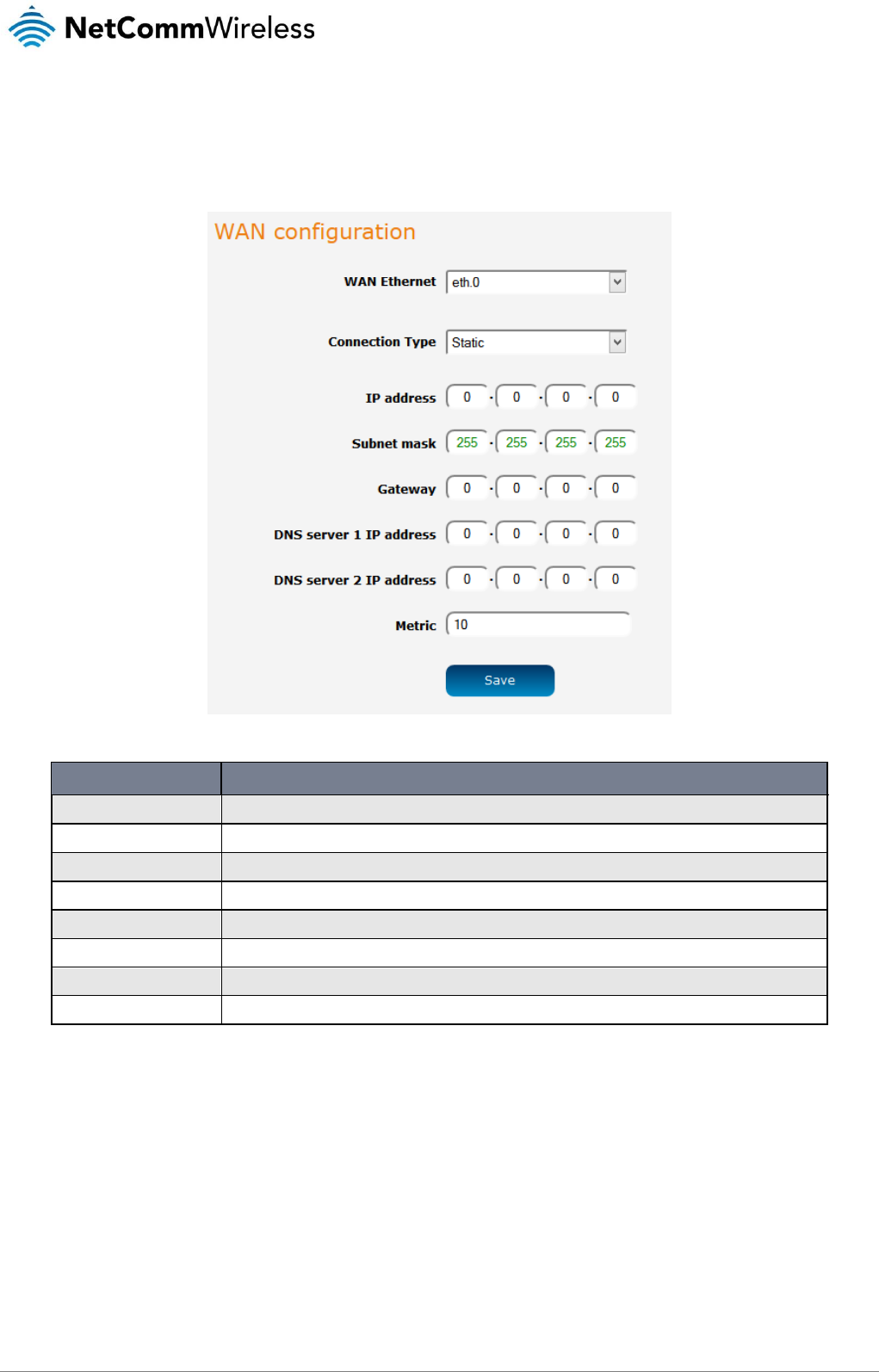
www.netcommwireless.com
NetComm Wireless 4G M2M Router
41
v1.0
Ethernet WAN
The Ethernet WAN page allows you to configure the connection type and metric of the available WAN connections. To access the
Ethernet WAN page, click on the Networking menu at the top of the screen, click on the Ethernet LAN/WAN menu on the left then
select the Ethernet WAN menu item.
Figure 42 - Ethernet WAN configuration
OPTION
DEFINITION
WAN Ethernet
Use this field to select the WAN interface to configure.
Connection Type
Selects whether the WAN interface has static IP settings or DHCP.
IP address
The IP address to assign to the selected WAN interface.
Subnet mask
The Subnet mask of the IP address above.
Gateway
The gateway to assign this WAN interface.
DNS server 1 IP address
The first DNS server for the WAN interface.
DNS server 2 IP address
The second DNS server for the WAN interface.
Metric
The metric value is used to define the priority of the interface. Lower metric values indicate higher priority.
Table 14 - Ethernet WAN configuration options
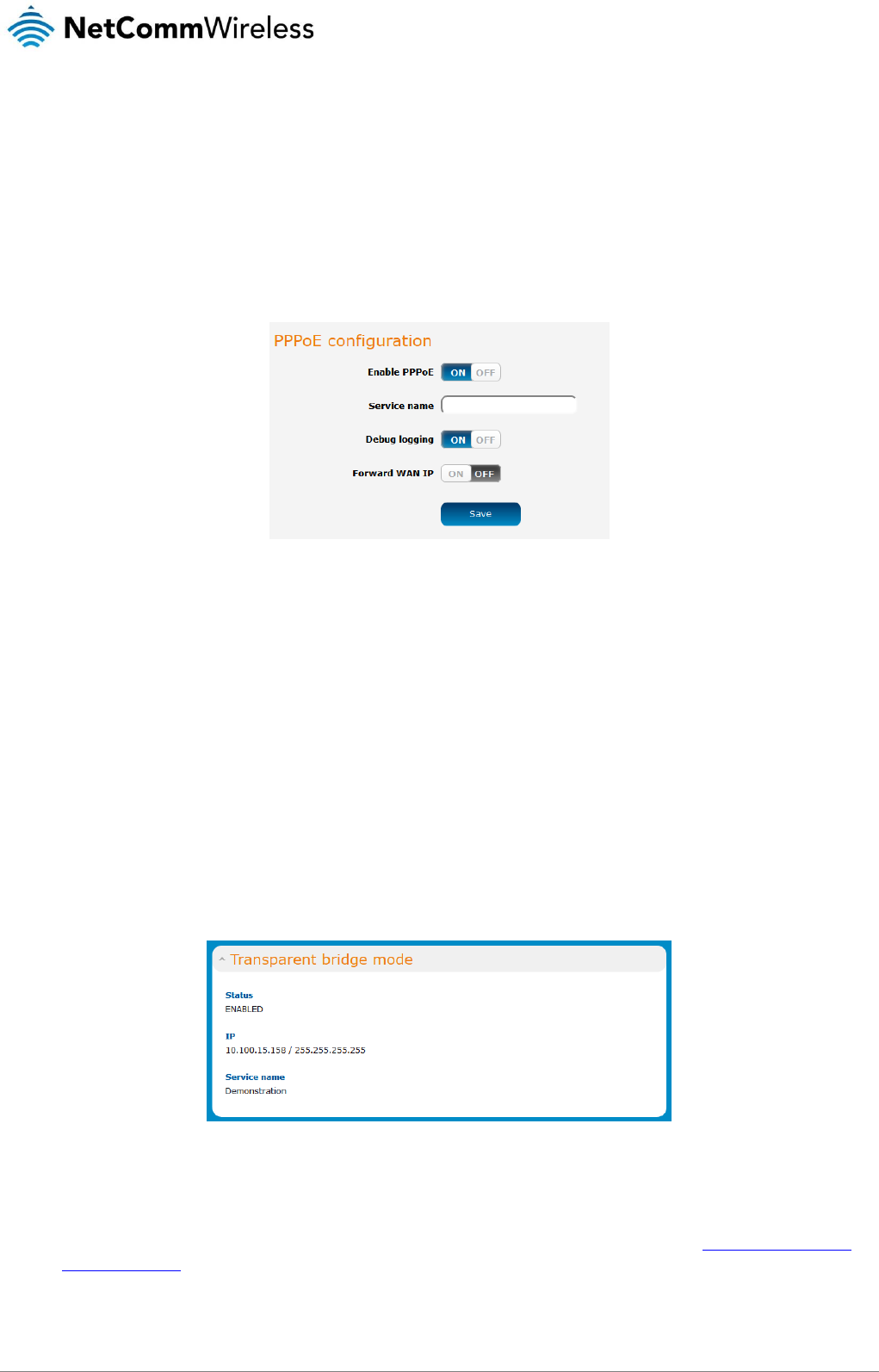
42
NetComm Wireless 4G M2M Router
www.netcommwireless.com
v1.0
PPPoE
If desired, you can have a client device connected to the Ethernet port initiate the mobile broadband connection using a PPPoE
session. This is particularly useful in situations where you wish to provide Wireless WAN data access to an existing router which you
want to have full public WAN IP access and have control over routing functionality. The PPPoE connection is established over the
highest priority interface.
To configure PPPoE:
1. Select the Networking menu item from the top menu bar, then select the PPPoE menu on the left side of the screen. The
PPPoE configuration screen is displayed.
Figure 43 - PPPoE configuration
2. Click the Enable PPPoE toggle key so that it is ON.
3. (Optional) In the Service name field, enter a name to use for the connection. This name is displayed on the Status page to
identify the PPPoE connection. Any name you enter here must also be entered in the PPPoE connection profile in order for
it to work.
4. If you require additional logging to be made available, click the Debug logging toggle key so that it is in the ON position.
This displays PPPoE negotiation details in the System log.
5. The Forward WAN IP option determines whether the router passes the WAN IP address on to the PPPoE client. When this
option is set to ON the first PPPoE client to connect will receive the WAN IP address and no further clients will be able to
make a connection. In this mode, the router transparently bridges the connection and many of the router’s features are
disabled. When this option is set to OFF, the router retains the WAN IP address and performs Network Address
Translation (NAT) for connected clients. In this mode, you are able to connect multiple PPPoE clients and all of the router’s
features are available.
6. Click the Save button to confirm the settings.
7. Click the Status menu item from the top menu bar. When Forward WAN IP is enabled, the status page shows a
Transparent bridge mode section and displays the WAN IP.
Figure 44 - Transparent bridge mode status
8. Configure the properties of the interface that the PPPoE connection will use (determined by WAN priority) in order to
provide authentication credentials. Each interface uses the authentication credentials configured on the router for that
particular interface, not those entered in the PPPoE client. For example, when using WWAN as the PPPoE interface, enter
the username and password on the Data connection profile settings before connecting. See the Manually configuring a
connection profile section for more detail.
9. Use your downstream device to initiate a network connection using a PPPoE client.
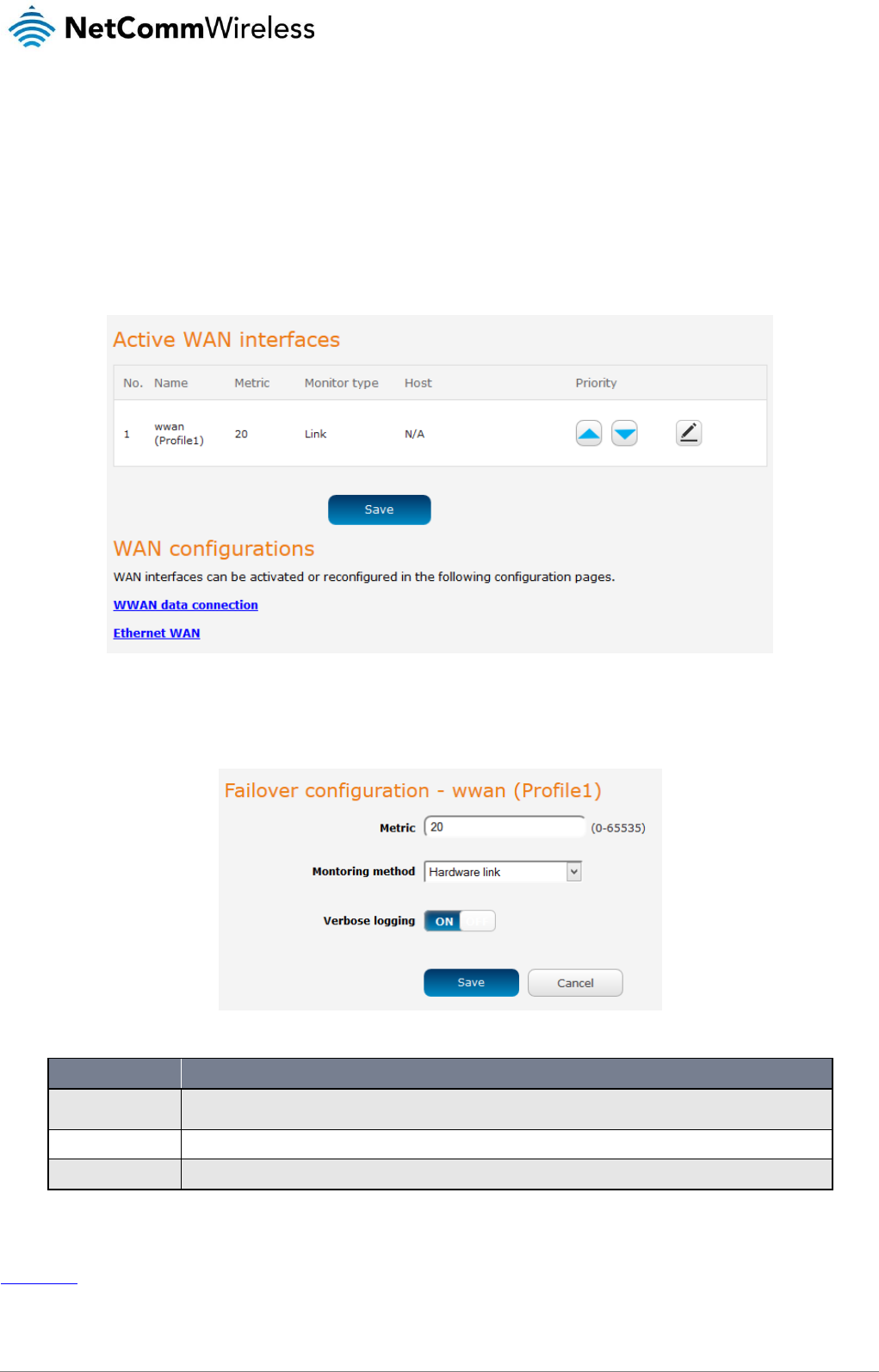
www.netcommwireless.com
NetComm Wireless 4G M2M Router
43
v1.0
WAN failover
The WAN failover page displays a summary of the configured WAN interfaces and their priorities (Metric). Lower metric values
determine higher priority. The priority of the interfaces can be adjusted using the up and down arrows in the Priority column. When
the interface with the highest priority goes down, the router fails over to the next highest priority interface. The method used to
determine whether an interface is “up” or “down” is defined by the Monitor setting. By default, an interface is monitored by its link
status.
To access the WAN failover page, click on the Networking menu at the top of the screen then click on the WAN failover menu item
on the left.
Figure 45 - WAN summary
To edit an interface, select the edit icon for the interface you wish to edit. The Failover configuration page is displayed. When
Monitoring method is set to Hardware link the failover is controlled by the physical detection of the link.
Figure 46 – Failover configuration – hardware link
OPTION
DESCRIPTION
Priority
The priority (metric) is a numeric value which determines which interface has priority. Lower priority values mean higher
priority.
Monitoring method
Specifies the means used to determine whether the link is up or down.
Verbose logging
When enabled, this logs verbose comments in the system log related to the failover monitoring.
Table 15 - Failover configuration - Hardware link monitoring
When Monitoring method is set to Ping, the router sends periodic ping requests to the specified addresses to verify the connection
is working. This works in a similar manner to the Watchdogs feature but with different ranges on the timers. Please refer to the
Watchdogs section of this user guide for a more detailed description of this function.
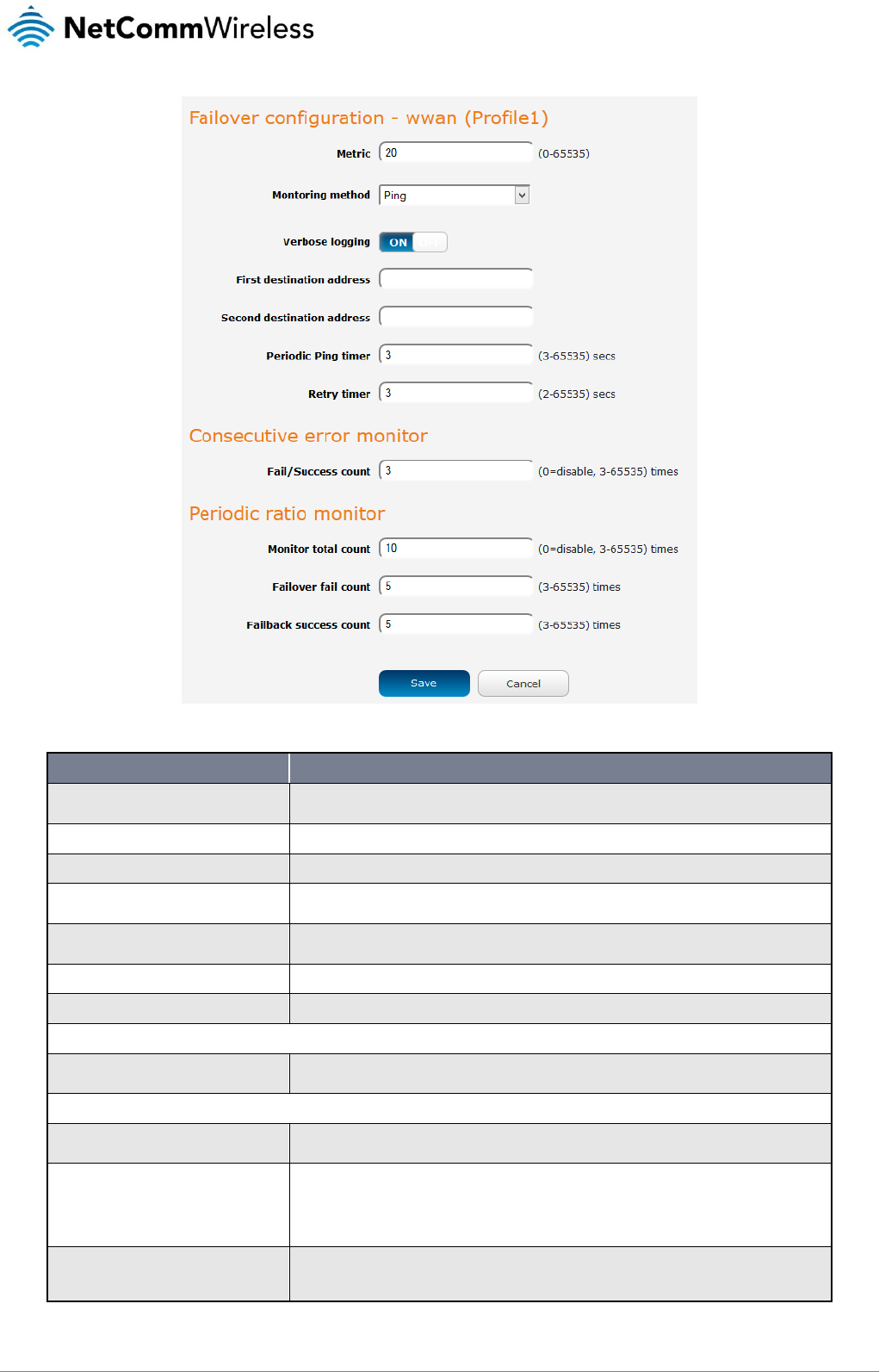
44
NetComm Wireless 4G M2M Router
www.netcommwireless.com
v1.0
Figure 47 - Failover configuration - ping
OPTION
DESCRIPTION
Priority
The priority (metric) is a numeric value which determines which interface has priority. Lower priority
values mean higher priority.
Monitoring method
Specifies the means used to determine whether the link is up or down.
Verbose logging
When enabled, this logs verbose comments in the system log related to the failover monitoring.
First destination address
The first address the router that the router should ping in order to confirm the connection is up. This
may be an IP address or a domain name.
Second destination address
The second address the router that the router should ping in order to confirm the connection is up.
This may be an IP address or a domain name.
Periodic Ping timer
The time in seconds between ping attempts.
Retry timer
The time in seconds between attempts when a ping failure occurs.
Consecutive error monitor
Fail count
The number of failed pings that must occur before the monitor moves to the second destination
address or fails the connection over to the next interface.
Periodic ratio monitor
Monitor total count
This field specifies the number of previous pings to consider when calculating whether to fail over or
fail back.
Failover total count
This field specifies the number of failed ping attempts with respect to the Monitor total count before
the router fails over to the next highest priority interface. For example, at the default setting of 5, the
router fails over to the next interface when 5 out of the last 10 ping attempts have failed. The failures
need not be consecutive to meet the fail over criteria. If any 5 of the last 10 pings have failed, the
router deems the interface connection to be of poor quality and fails over.
Failback success count
Like the Failover fail count field, this field specifies the number of ping successes that must be
registered on a higher priority interface with respect to the Monitor total count before the router fails
back to that interface.
Table 16 - Failover configuration - Ping monitoring
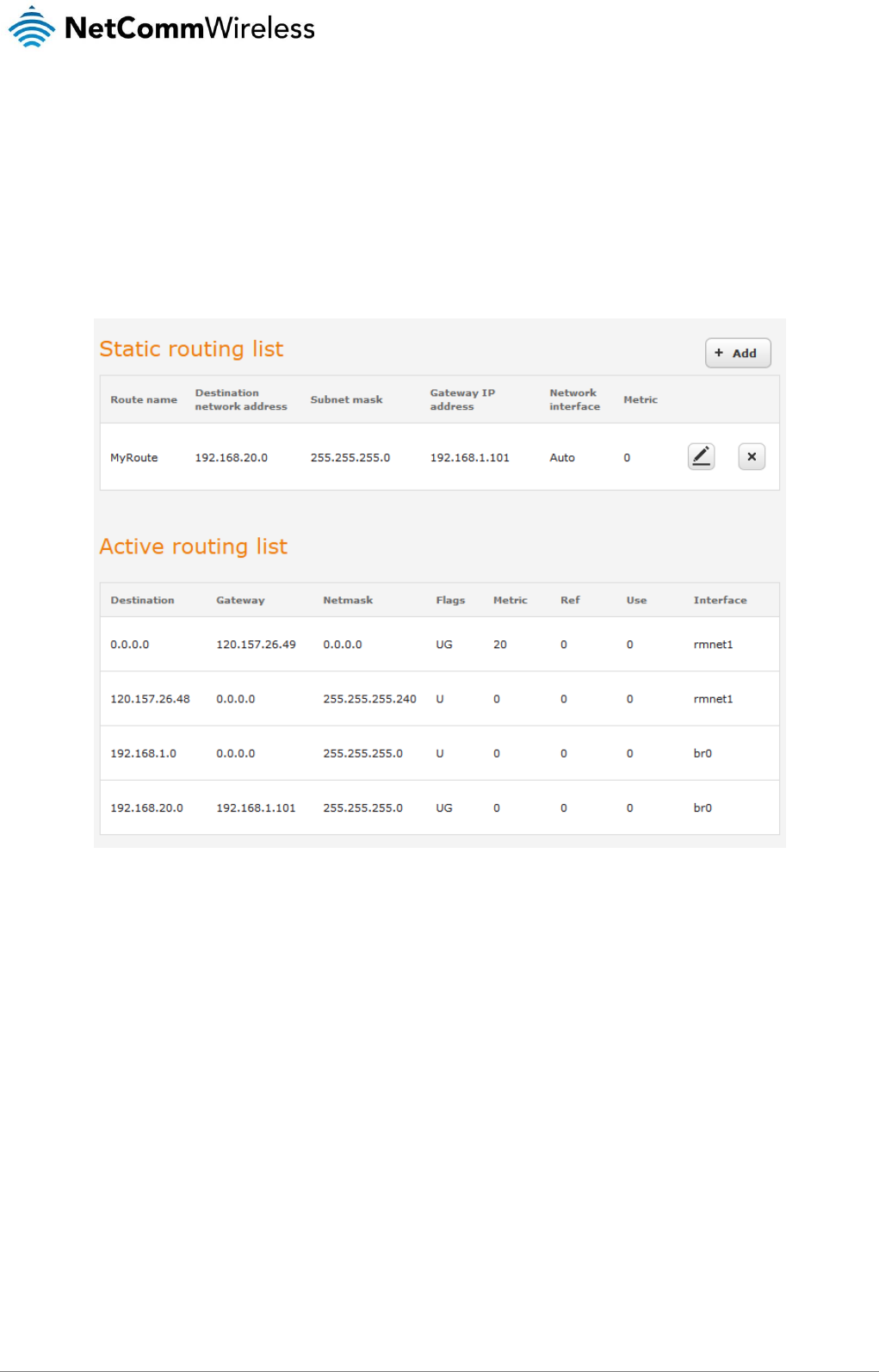
www.netcommwireless.com
NetComm Wireless 4G M2M Router
45
v1.0
Routing
Static
Static routing is the alternative to dynamic routing used in more complex network scenarios and is used to facilitate communication
between devices on different networks. Static routing involves configuring the routers in your network with all the information
necessary to allow the packets to be forwarded to the correct destination. If you change the IP address of one of the devices in the
static route, the route will be broken.
To access the Static routing page, click on the Networking menu at the top of the screen, click on the Routing menu on the left,
then click on the Static menu item.
Figure 48 - Static routing list
Some routes are added by default by the router on initialization such as the Ethernet subnet route for routing to a device on the
Ethernet subnet.
Adding Static Routes
To add a new route to the static routing list, click the +Add button. The Static routes page appears.
1. In the Route name field, type a name for the route so that it can be identified in the static routing list.
2. From the Network interface drop down list, select the interface for which you would like to create a static route.
3. In the Destination IP address field, enter the IP address of the destination of the route.
4. In the IP subnet mask field, enter the subnet mask of the route.
5. In the Gateway IP address field, enter the IP address of the gateway that will facilitate the route.
6. In the Metric field enter the metric for the route. The metric value is used by the router to prioritise routes. The lower the
value, the higher the priority. To give the route the highest priority, set it to 0.
7. Click the Save button to save your settings.
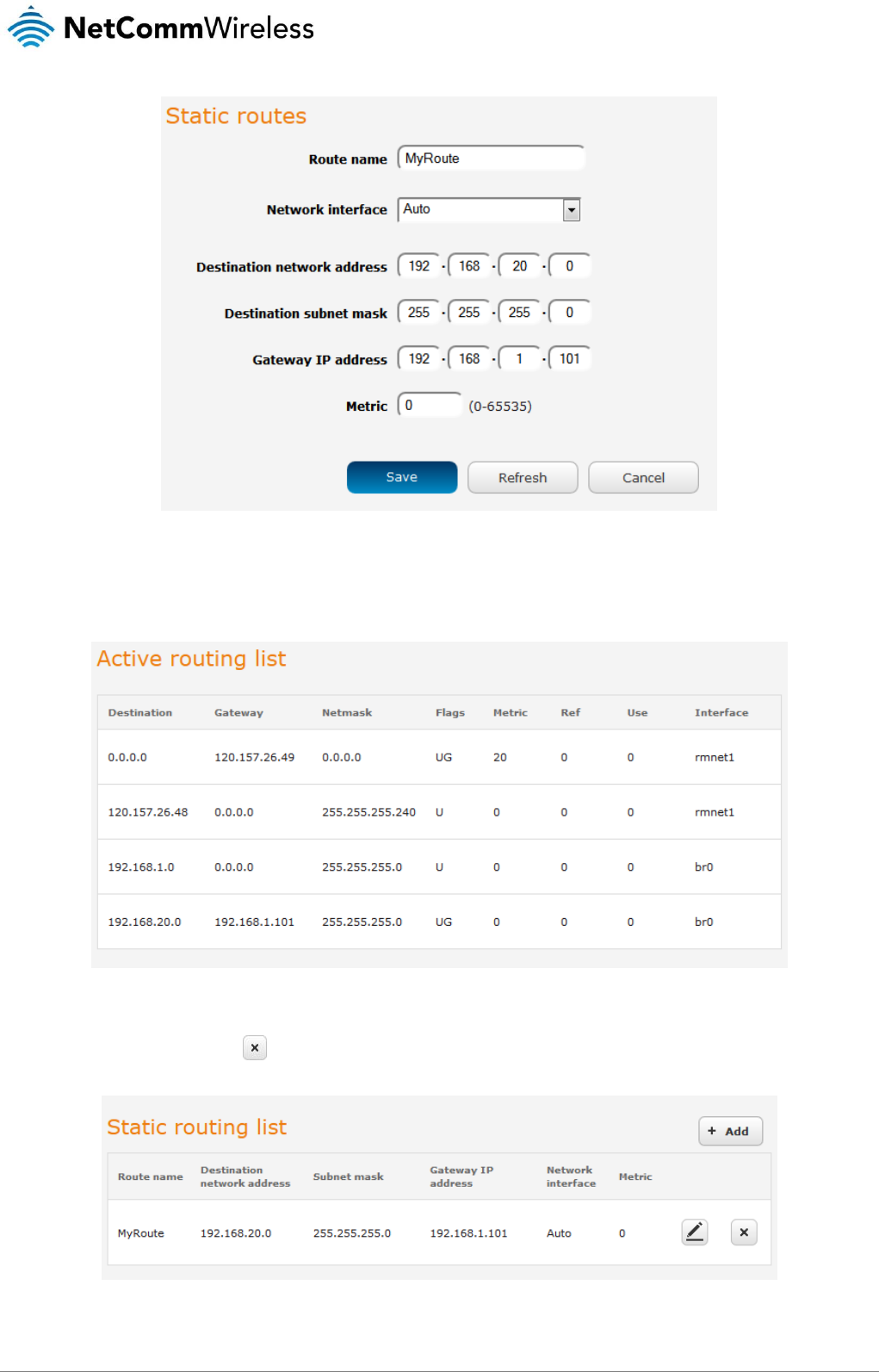
46
NetComm Wireless 4G M2M Router
www.netcommwireless.com
v1.0
Figure 49 - Adding a static route
Active routing list
Static routes are displayed in the Active routing list.
Figure 50 - Active routing list
Deleting static routes
From the static routing list, click the icon to the right of the entry you wish to delete.
Figure 51 - Deleting a static route
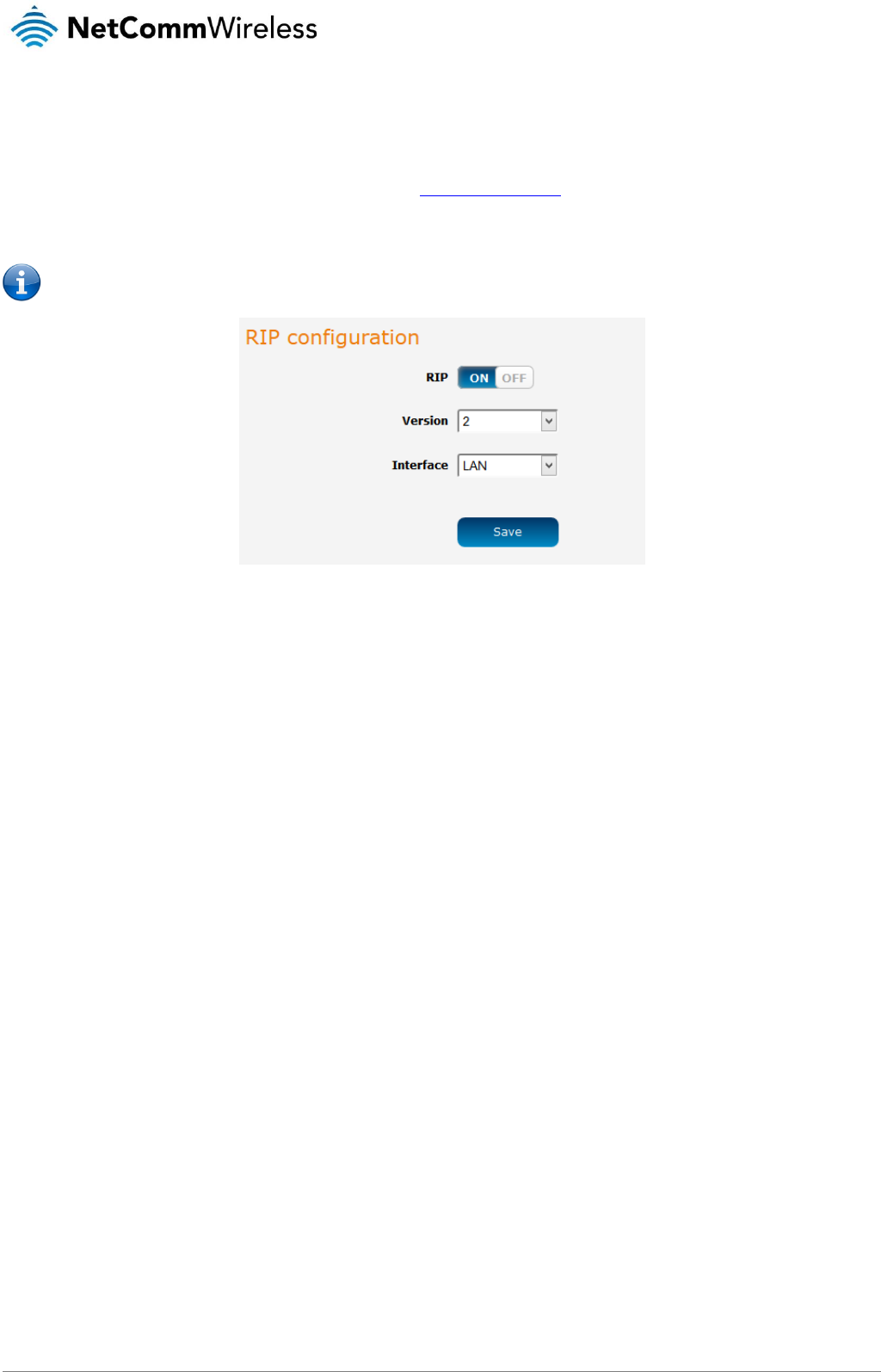
www.netcommwireless.com
NetComm Wireless 4G M2M Router
47
v1.0
RIP
RIP (Routing Information Protocol) is used for advertising routes to other routers. Thus all the routes in the router’s routing table will
be advertised to other nearby routers. For example, the route for the router’s Ethernet subnet could be advertised to a router on the
PPP interface side so that a router on this network will know how to route to a device on the router’s Ethernet subnet. Static routes
must be added manually according to your requirements. See Adding Static Routes.
To access the RIP configuration page, click on the Networking menu at the top of the screen, click on the Routing failover menu on
the left, then click on the RIP menu item.
Note: Some routers will ignore RIP.
Figure 52 - RIP configuration
To enable Routing Information Protocol (RIP)
1. Click the RIP toggle key to switch it to the ON position.
2. Using the Version drop down list, select the version of RIP that you would like to use.
3. Select the interface for which you want RIP to apply. You can choose the LAN interface, the WWAN interface or BOTH.
4. Click the Save button to confirm your settings.
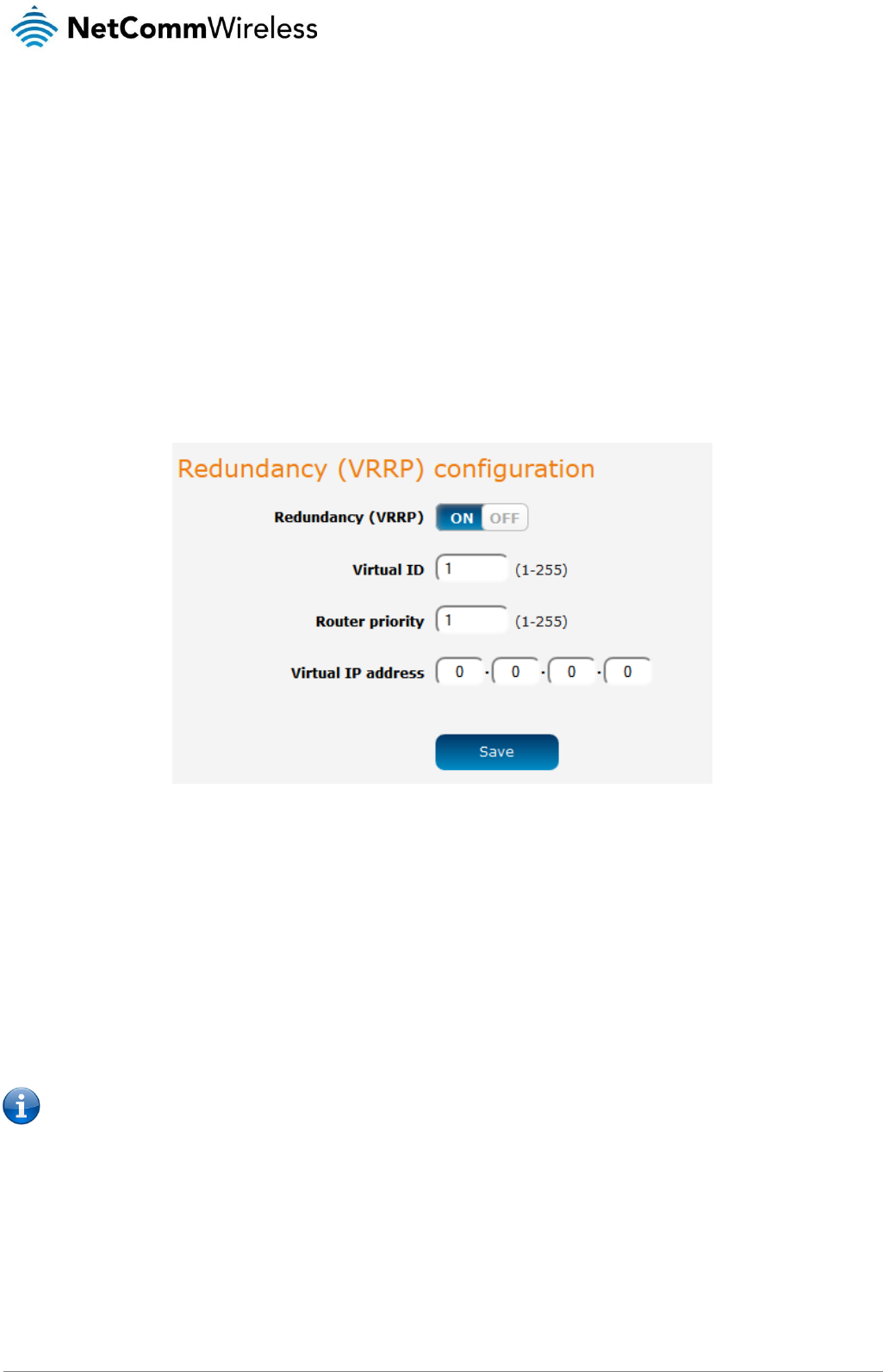
48
NetComm Wireless 4G M2M Router
www.netcommwireless.com
v1.0
Redundancy (VRRP) configuration
Virtual Router Redundancy Protocol (VRRP) is a non-proprietary redundancy protocol designed to increase the availability of the
default gateway servicing hosts on the same subnet. This increased reliability is achieved by advertising a “virtual router” (an
abstract representation of master and backup routers acting as a group) as a default gateway to the host(s) instead of one physical
router. Two or more physical routers are then configured to stand for the virtual router, with only one doing the actual routing at any
given time. If the current physical router that is routing the data on behalf of the virtual router fails, an arrangement is made for
another physical router to automatically replace it. The physical router that is currently forwarding data on behalf of the virtual router
is called the master router. Master routers have a priority of 255 and backup router(s) can have a priority between 1 and 254.
A virtual router must use 00-00-5E-00-01-XX as its (MAC) address. The last byte of the address (XX) is the Virtual Router Identifier
(VRID), which is different for each virtual router in the network. This address is used by only one physical router at a time, and is the
only way that other physical routers can identify the master router within a virtual router.
To access the Redundancy (VRRP) page, click on the Networking menu at the top of the screen, click on the Routing failover menu
on the left, then click on the Redundancy (VRRP) menu item.
Figure 53 - VRRP configuration
To configure VRRP, configure multiple devices as follows and connect them all via an Ethernet network switch to downstream
devices.
1. Click the Redundancy (VRRP) toggle key to activate VRRP.
2. In the Virtual ID field, enter an ID between 1 and 255. This is the VRRP ID which is different for each virtual router on the
network.
3. In the Router priority field, enter a value for the priority – a higher value is a higher priority.
4. The Virtual IP address field is used to specify the VRRP IP address – this is the virtual IP address that both virtual routers
share.
5. Click the Save button to save the new settings.
Note: Configuring VRRP changes the MAC address of the Ethernet port and therefore if you want to resume with the web
configuration you must use the new IP address (VRRP IP) or on a command prompt type:
arp –d <ip address> (i.e. arp –d 192.168.1.1) to clear the arp cache.(old MAC address).
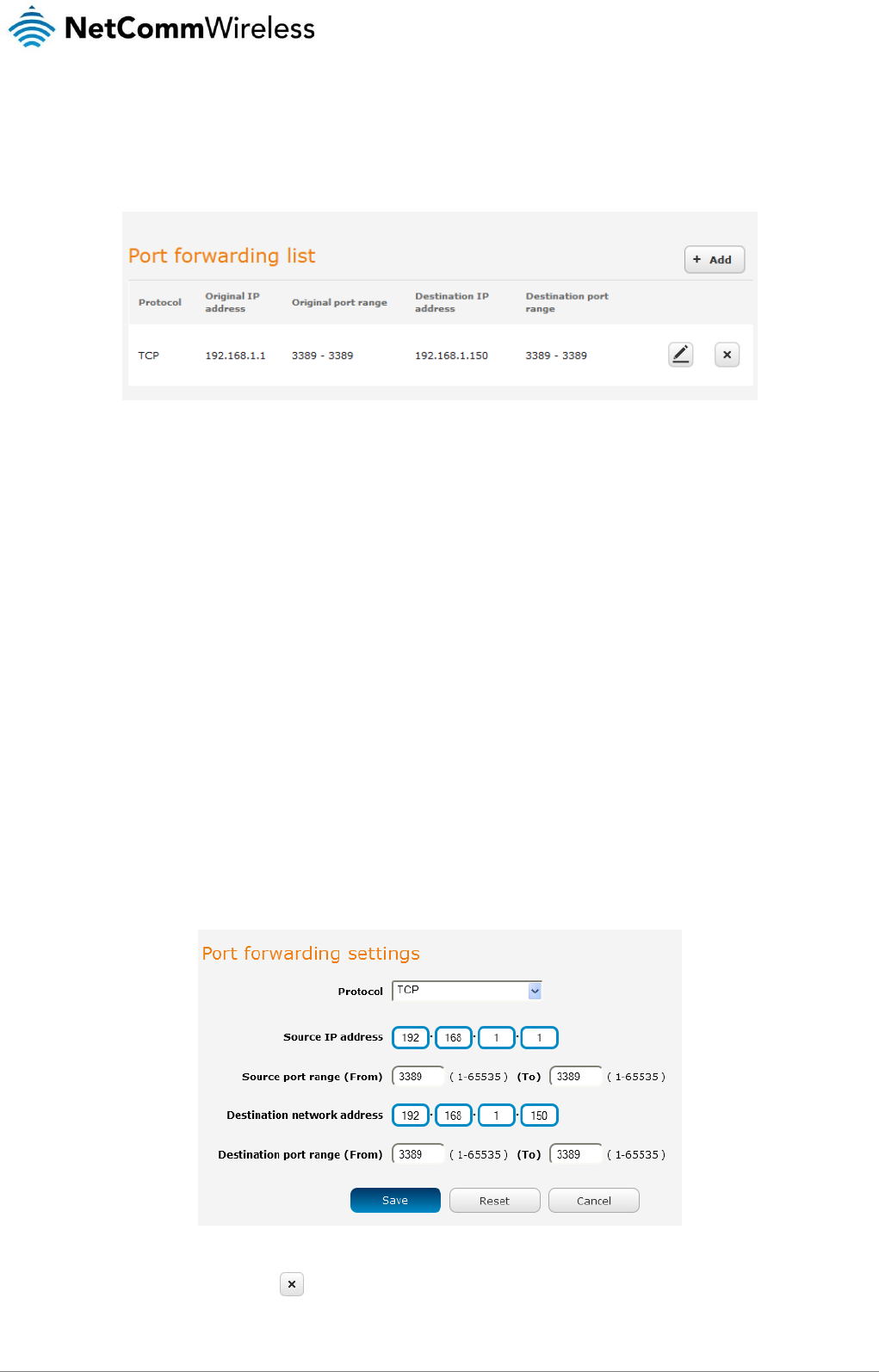
www.netcommwireless.com
NetComm Wireless 4G M2M Router
49
v1.0
Port forwarding
The Port forwarding list is used to configure the Network Address Translation (NAT) rules currently in effect on the router. To access
the Port forwarding page, click on the Networking menu at the top of the screen, click on the Routing failover menu on the left, then
click on the Port forwarding menu item.
Figure 54 – Port forwarding list
The purpose of the port forwarding feature is to allow mapping of inbound requests to a specific port on the WAN IP address to a
device connected on the Ethernet interface.
Adding a port forwarding rule
To create a new port forwarding rule:
1. Click the +Add button. The port forwarding settings screen is displayed.
2. Use the Protocol drop down list to select the type of protocol you want to use for the rule. The protocols selections
available are TCP, UDP and All.
3. In the Source IP Address field, enter a “friendly” address that is allowed to access the router or a wildcard IP address
(0.0.0.0) that allows all IP addresses to access the router.
4. The Source Port Range (From) and (To) fields are used to specify the port(s) on the source side that are to be forwarded.
This allows you to send a range of consecutive port numbers by entering the first in the range in the (From) field and the
last in the range in the (To) field. To forward a single port, enter the port in the (From) field and repeat it in the (To) field.
5. In the Destination network address field, enter the IP address of the client to which the traffic should be forwarded.
6. The Destination Port Range (From) and (To) fields are used to specify the port(s) on the destination side that are to be
forwarded. If the Source port range specifies a single port then the destination port may be configured to any port. If the
Source port range specifies a range of port numbers then the Destination port range must be the same as the Source port
range.
7. Click the Save button to confirm your settings.
Figure 55 - Port forwarding settings
To delete a port forwarding rule, click the button on the Port forwarding list for the corresponding rule that you would like to
delete.

50
NetComm Wireless 4G M2M Router
www.netcommwireless.com
v1.0
DMZ
The Demilitarized Zone (DMZ) allows you to configure all incoming traffic on all protocols to be forwarded to a selected device
behind the router. This feature can be used to avoid complex port forwarding rules, but it exposes the device to untrusted networks
as there is no filtering of what traffic is allowed and what is denied. The DMZ configuration page is used to specify the IP Address of
the device to use as the DMZ host.
To access the DMZ page, click on the Networking menu at the top of the screen, click on the Routing failover menu on the left, then
click on the DMZ menu item.
Figure 56 - DMZ configuration
1. Click the DMZ toggle key to turn the DMZ function ON.
2. Enter the IP Address of the device to be the DMZ host into the DMZ IP Address field.
3. Click the Save button to save your settings.

www.netcommwireless.com
NetComm Wireless 4G M2M Router
51
v1.0
Router firewall
The Router firewall page is used to enable or disable the in-built firewall on the router. When enabled, the firewall performs stateful
packet inspection on inbound traffic from the wireless WAN and blocks all unknown services, that is, all services not listed on the
Services configuration page of the router.
With respect to the other Routing options on the Networking page, the firewall takes a low priority. The priority of the firewall can be
described as:
DMZ > MAC/IP/Port filtering rules > MAC/IP/Port filtering default rule > Router firewall rules
In other words, the firewall is of the lowest priority when compared to other manual routing configurations. Therefore, a MAC/IP/Port
filtering rule takes priority in the event that there is a conflict of rules. When DMZ is enabled, MAC/IP/Port filtering rules and the
router firewall are ignored but the router will still honour the configuration of the Remote router access control settings listed under
Administration Settings.
To access the DMZ page, click on the Networking menu at the top of the screen, click on the Routing failover menu on the left, then
click on the Router firewall menu item.
Figure 57 - Router firewall toggle key
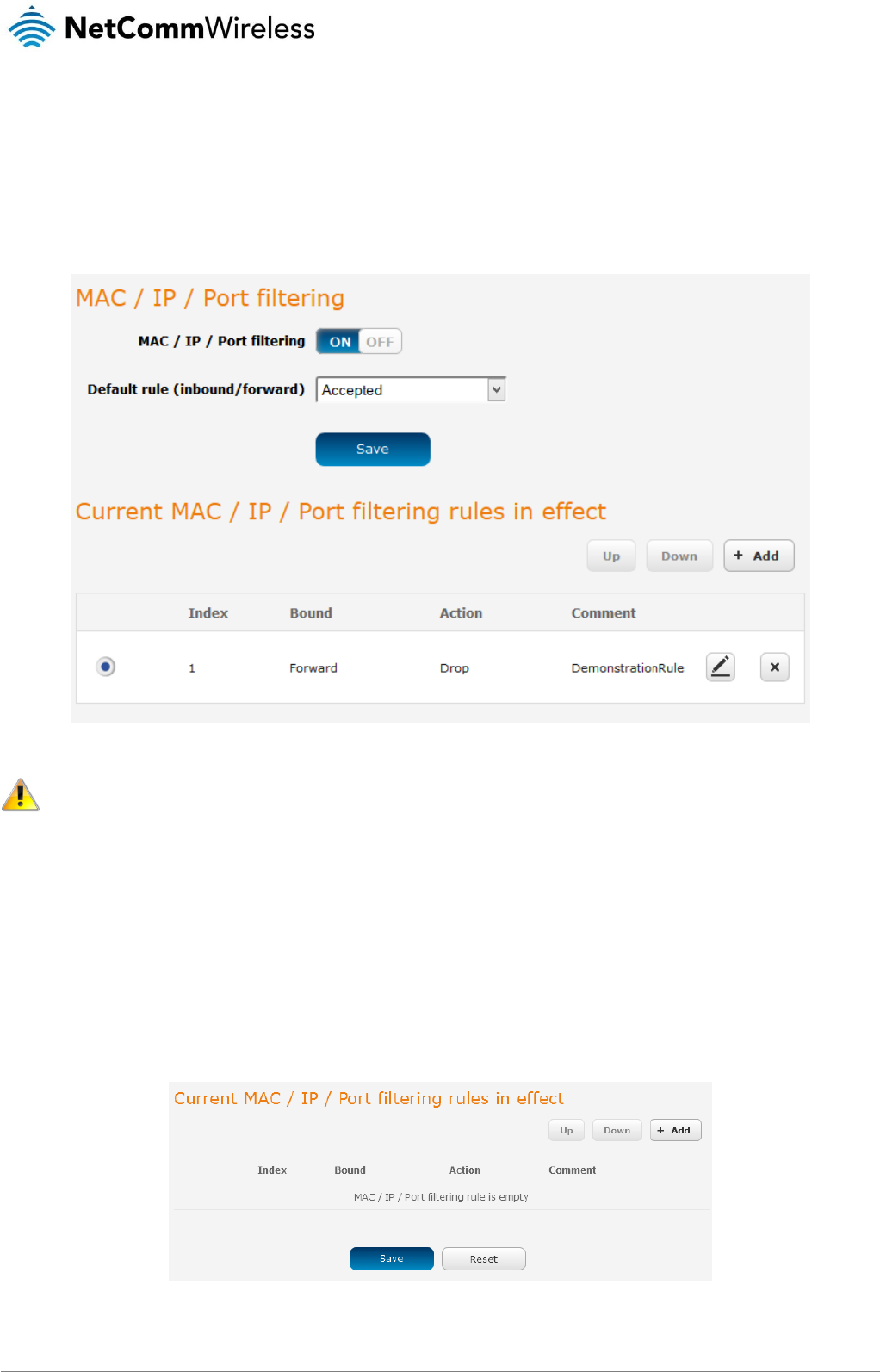
52
NetComm Wireless 4G M2M Router
www.netcommwireless.com
v1.0
MAC / IP / Port filtering
The MAC/IP/Port filter feature allows you apply a policy to the traffic that passes through the router, both inbound and outbound, so
that network access can be controlled. When the filter is enabled with a default rule of “Accepted”, all connections will be allowed
except those listed in the “Current MAC / IP / Port filtering rules in effect” list. Conversely, when the default rule is set to “Dropped”,
all connections are denied except for those listed in the filtering rules list.
To access the MAC / IP / Port filtering page, click on the Networking menu at the top of the screen, click on the Routing failover
menu on the left, then click on the MAC / IP / Port filtering menu item.
Figure 58 - MAC / IP / Port filtering
Note: When enabling MAC / IP / Port filtering and setting the default rule to “Dropped”, you should ensure that you have
first added a filtering rule which allows at least one known MAC/IP to access the router, otherwise you will not be able to
access the user interface of the router without resetting the router to factory default settings.
Creating a MAC / IP / Port filtering rule
To create a filtering rule:
1. Click the MAC / IP / Port filtering toggle key to switch it to the ON position.
2. Using the Default rule (inbound/forward) drop down list, select the default action for the router to take when traffic reaches
it. By default, this is configured to Accepted. If you change this to Dropped, you should first configure a filter rule that
allows at least one device access to the router, otherwise you will effectively be locked out of the router.
3. Click the Save button to confirm the default rule.
4. In the Current MAC / IP / Port filtering rules in system section, click the +Add button.
Figure 59 - Current MAC / IP/ Port filtering rules in effect
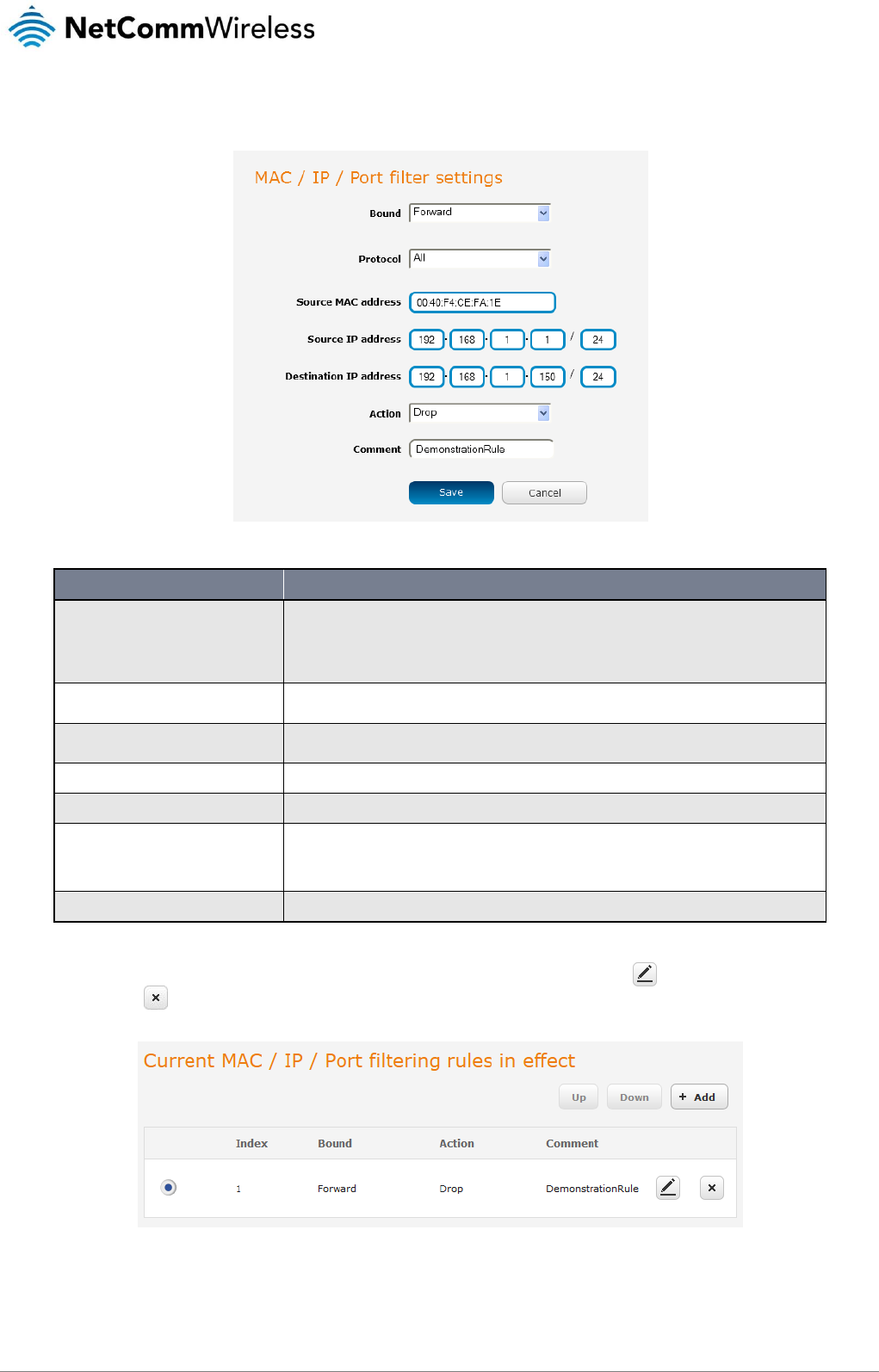
www.netcommwireless.com
NetComm Wireless 4G M2M Router
53
v1.0
5. Enter the details of the rule in the section that is displayed and click the Save button.
Figure 60 - MAC / IP / Port filtering settings
OPTION
DESCRIPTION
Bound
Use the drop down list to select the direction of the traffic for which you want to apply to the rule.
Inbound refers to all traffic that is entering the router including data entering from the WAN and the
LAN. Outbound refers to all traffic exiting the router including traffic leaving in the direction of the
WAN and traffic leaving in the direction of the LAN. Forward specifies traffic that enters on the LAN or
WAN side and is forwarded to the opposite end.
Protocol
Use the drop down list to select the protocol for the rule. You can have the rule apply to All
protocols, TCP, UDP, UDP/TCP or ICMP.
Source MAC Address
Enter the MAC address in six groups of two hexadecimal digits separated by colons (:). e.g.
00:40:F4:CE:FA:1E
Source IP Address
Enter the IPv4 address that the traffic originates from and the subnet mask using CIDR notation.
Destination IP Address
Enter the IPv4 address that the traffic is destined for and the subnet mask using CIDR notation.
Action
Select the action to take for traffic which meets the above criteria. You can choose to Accept or Drop
packets. When the default rule is set to Accept, you cannot create a rule with an Accept action since
the rule is redundant. Likewise, if the default rule is set to Dropped you cannot create a rule with a
Drop action.
Comment
[Optional] Use this field to enter a comment as a meaningful description of the rule.
Table 17 - Current MAC / IP / Port filtering rules in effect
6. The new rule is displayed in the filtering rules list. You can edit the rule by clicking the Edit button or delete the rule by
clicking the button.
Figure 61 - Completed filtering rule
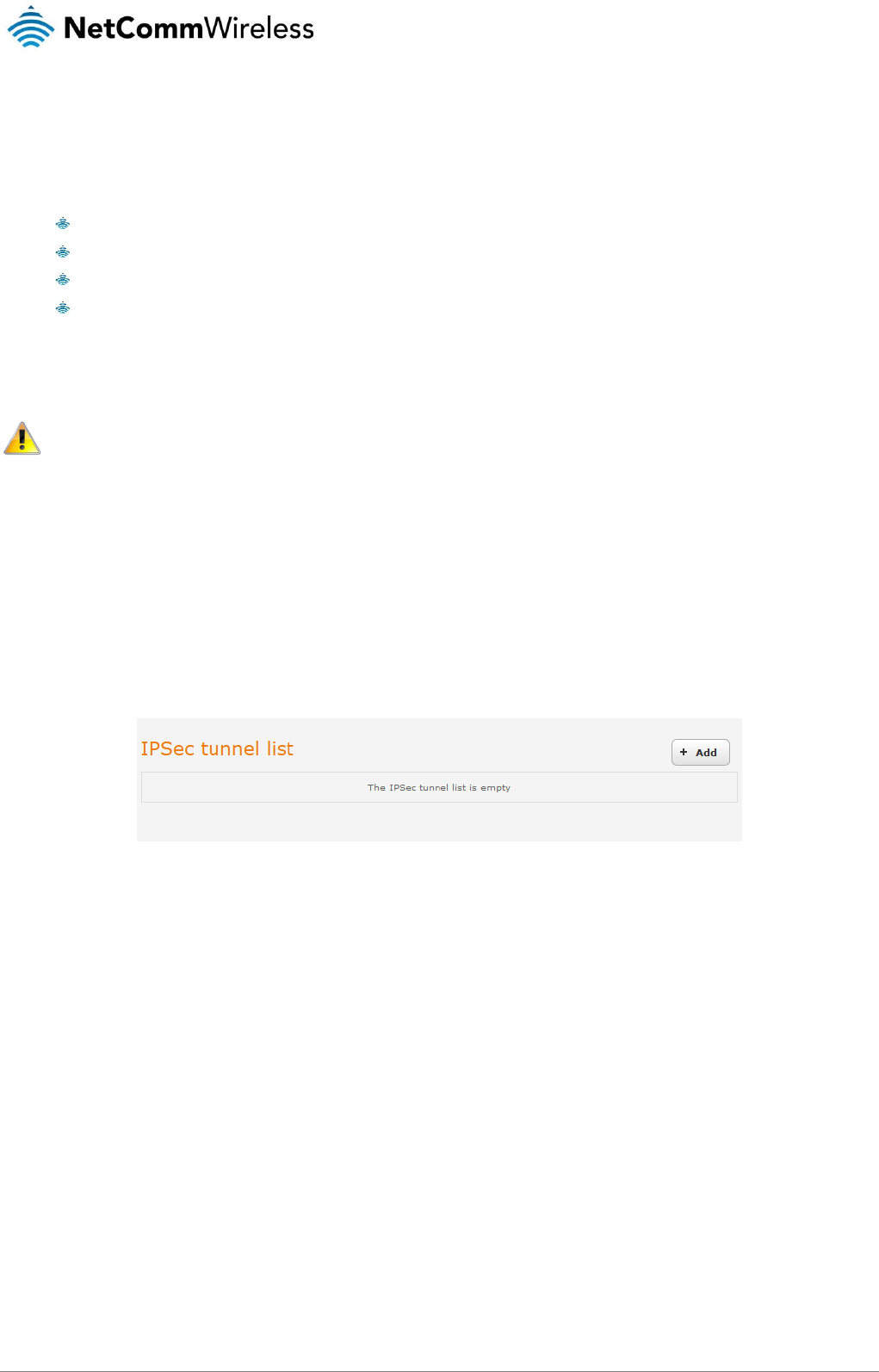
54
NetComm Wireless 4G M2M Router
www.netcommwireless.com
v1.0
VPN
A Virtual Private Network (VPN) is a tunnel providing a private link between two networks or devices over a public network. Data to
be sent via a VPN needs to be encapsulated and as such is generally not visible to the public network.
The advantages of a VPN connection include:
Data Protection
Access Control
Data Origin Authentication
Data Integrity
Each VPN connection has different configuration requirements. The following pages detail the configuration options available for the
different VPN connection types.
Note: The following descriptions are an overview of the various VPN options available. More detailed instructions are
available in separate whitepapers on the NetComm Wireless website.
IPSec
IPSec operates on Layer 3 of the OSI model and as such can protect higher layered protocols. IPSec is used for both site to site
VPN and Remote Access VPN. The NTC-140-01 router supports IPsec end points and can be configured with Site to Site VPN
tunnels with third party VPN routers.
Configuring an IPSec VPN
From the menu at the top of the screen, click Networking and under the VPN section, click IPSec. A list of configured IPSec VPN
connections is displayed.
Figure 62 - IPSec VPN List
Click the +Add button to begin configuring an IPSec VPN connection.
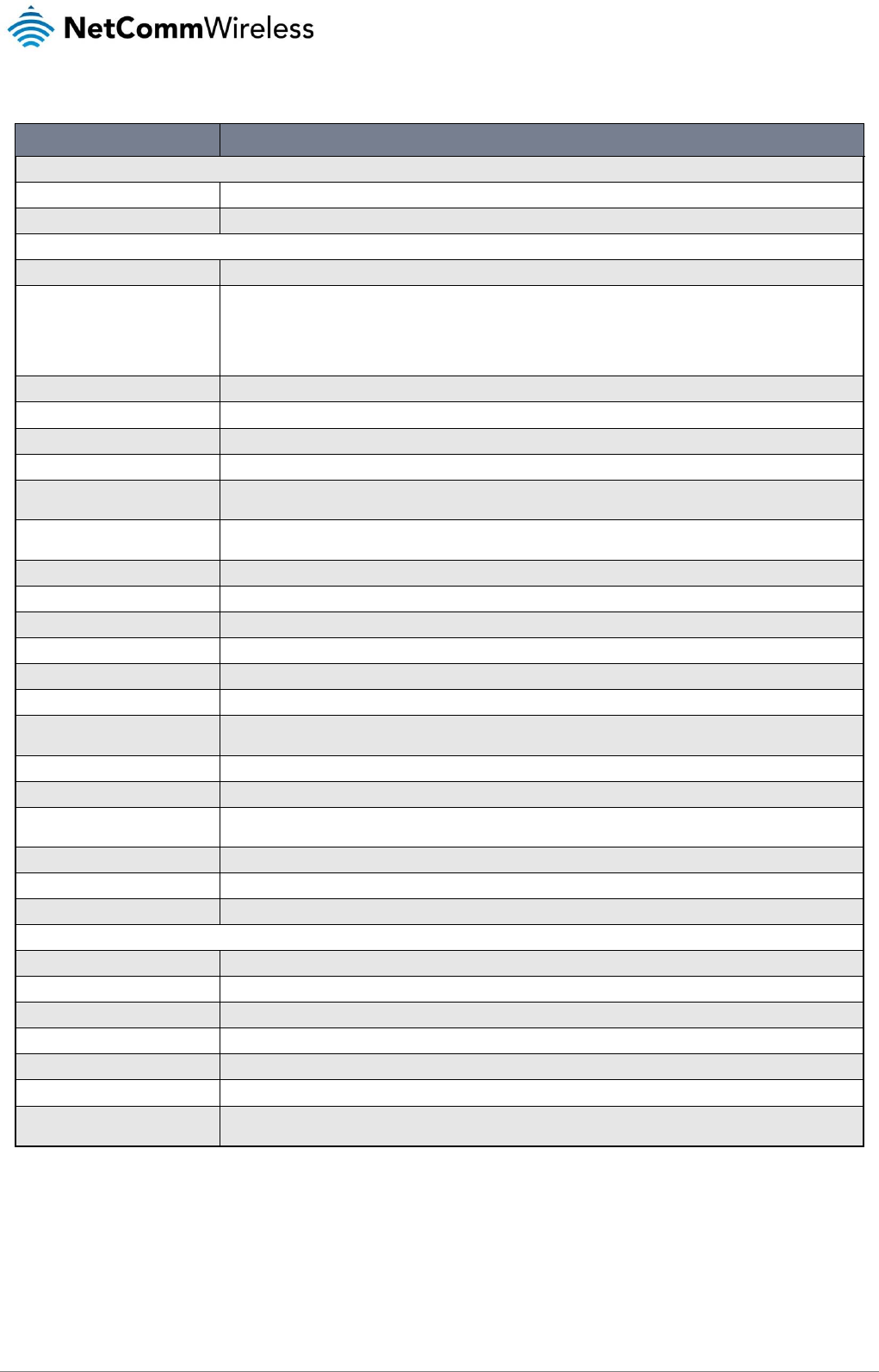
56
NetComm Wireless 4G M2M Router
www.netcommwireless.com
v1.0
The following table describes each of the fields of the IPSec VPN Connection Settings page.
ITEM
DEFINITION
IPSec Profile Edit
IPSec profile
Enables or disables the VPN profile.
Profile name
A name used to identify the VPN connection profile.
Phase 1 parameters
Remote IPSec address
The IP address or domain name of the IPSec server.
Key mode
Select the type of key mode in use for the VPN connection. You can select from:
Pre Shared Key
RSA keys
Certificates
Pre-shared key
The pre-shared key is the key that peers used to authenticate each other for Internet Key Exchange.
Update Time
Displays the last time the key was updated.
Local RSA Key Upload
Select the RSA key file for the local router here by clicking the Browse button.
Remote RSA Key Upload
Select the RSA key file for the remote router here by clicking the Browse button.
Private key Passphrase
The Private key passphrase of the router is the passphrase used when generating the router’s private key using
OpenSSL CA.
Key / Certificate
Select the type of key or certificate to use for authentication. You can select Local private key, Local public certificate,
Remote public certificate, CA certificate, CRL certificate.
IPSec Certificate Upload
Select the IPSec certificate to upload by clicking the Browse button.
Remote ID
Specifies the domain name of the remote network.
Local ID
Specifies the domain name of the local network.
IKE mode
Select the IKE mode to use with the VPN connection. You can choose Main, Aggressive or Any.
PFS
Choose whether Perfect Forward Secrecy is ON or OFF for the VPN connection.
IKE encryption
Select the cipher type to use for the Internet Key Exchange.
IKE hash
Select the IKE Hash type to use for the VPN connection. The hash is used for authentication of packets for the key
exchange.
DH group
Select the desired Diffie-Hellman group to use. Higher groups are more secure but also require longer to generate a key.
IKE re-key time
Enter the time in seconds between changes of the encryption key. To disable changing the key, set this to 0.
DPD action
Select the desired Dead Peer Detection action. This is the action to take when a dead Internet Key Exchange Peer is
detected.
DPD keep alive time
Enter the time in seconds for the interval between Dead Peer Detection keep alive messages.
DPD timeout
Enter the time in seconds of no response from a peer before Dead Peer Detection times out.
SA life time
Enter the time in seconds for the security association lifetime.
Phase 2 parameters
Remote LAN address
Enter the IP address of the remote network for use on the VPN connection.
Remote LAN subnet mask
Enter the subnet mask in use on the remote network.
Local LAN address
Enter the IP address of the local network for use on the VPN connection.
Local LAN subnet mask
Enter the subnet mask in use on the local network.
Encapsulation type
Select the encapsulation protocol to use with the VPN connection. You can choose ESP, AH or Any.
IPSec encryption
Select the IPSec encryption type to use with the VPN connection.
IPSec hash
Select the IPSec hash type to use for the VPN connection. The hash is used for authentication of packets for the VPN
connection.
Table 18 - IPSec Configuration Items
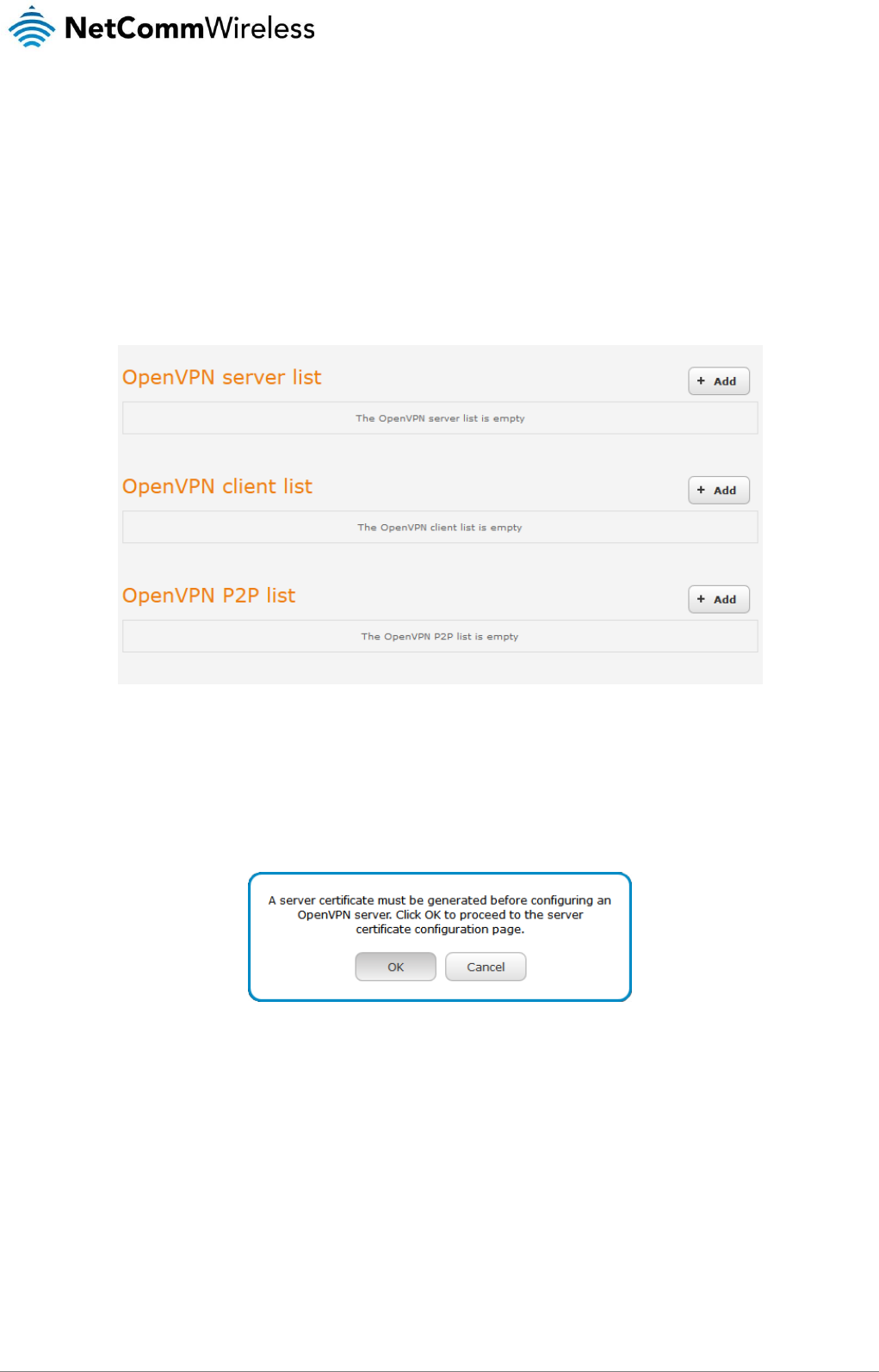
www.netcommwireless.com
NetComm Wireless 4G M2M Router
57
v1.0
OpenVPN
OpenVPN is an open source virtual private network (VPN) program for creating point-to-point or server-to-multi-client encrypted
tunnels between host computers. It can traverse network address translation (NAT) and firewalls and allows authentication by
certificate, pre-shared key or username and password. OpenVPN works well through proxy servers and can run over TCP and UDP
transports. Support for OpenVPN is available on several operating systems, including Windows, Linux, Mac OS, Solaris, OpenBSD,
FreeBSD, NetBSD and QNX.
Configuring an Open VPN server
From the menu at the top of the screen, click Networking and from the VPN section on the left, click OpenVPN. A list of configured
OpenVPN VPN connections is displayed.
Figure 64 - OpenVPN VPN List
Click the +Add button for the type of OpenVPN server/client you would like to configure.
OpenVPN Server
When you select the +Add button to add an OpenVPN server, the router checks whether there are existing server certificates. If no
server certificate is found, you are informed that you must generate a certificate before configuring the OpenVPN server.
Click on the OK button to be taken to the Server certificate page. For more information on generating server certificates, refer to the
Server certificate section of this guide. When you have created the certificate, return to the OpenVPN server configuration page and
continue with the steps below.
To configure an OpenVPN Server:
1. Click the OpenVPN profile toggle key to switch it to the ON position.
2. Type a name for the OpenVPN server profile you are creating.
3. In the Type drop down list, select the OpenVPN connection type (TUN/TAP). Default is TUN.
4. Use the Server port field to select a port number and then use the drop down list to select a packet type to use for your
OpenVPN Server. The default OpenVPN port is 1194 and default packet type is UDP.
5. In the VPN network address and VPN network subnet mask fields, enter the IP address and network subnet mask to
assign to your VPN. This is ideally an internal IP address which differs from your existing address scheme.
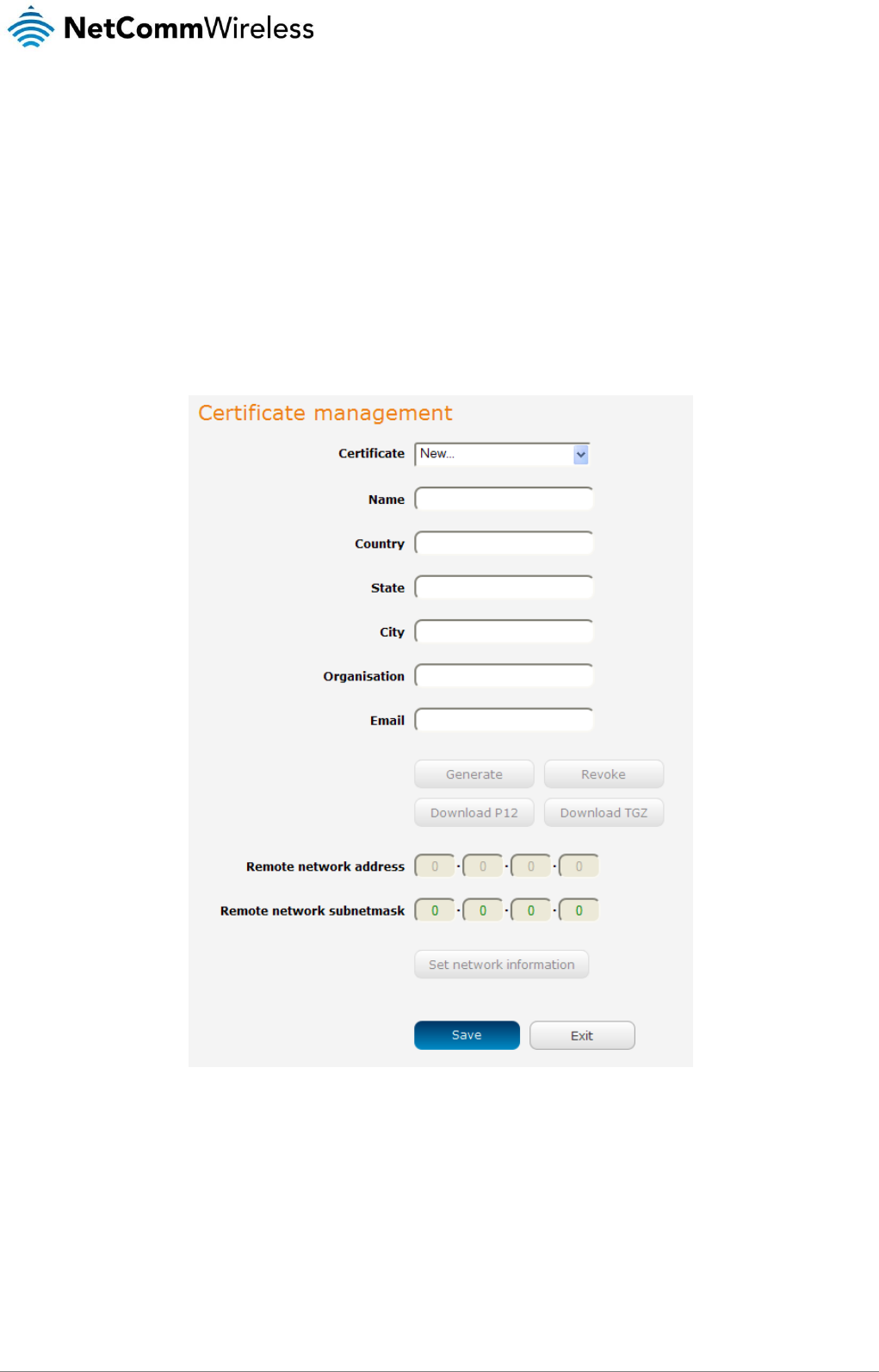
58
NetComm Wireless 4G M2M Router
www.netcommwireless.com
v1.0
6. The Server certificates section displays the details of the certificate. If you wish to change the certificate, click the Change
button.
7. HMAC or Hash-based Message Authentication Code is a means of calculating a message authentication code through the
use of a cryptographic hash function and a cryptographic key. If you wish to use the HMAC signature as an additional key
and level of security, under the SSL/TLS handshake section, click the Use HMAC Signature toggle key so that it is in the
ON position, then click the Generate button so that the router can randomly generate the key. The Server key timestamp
field is updated with the time that the key was generated. Click the Download button to download the key file so that it can
be uploaded on the client.
8. Select an Authentication type. Authentication may be done using a Certificate or Username / Password.
Certificate Authentication
In the Certificate Management section, enter the required details to create a client certificate. All fields are required. When
you have finished entering the details, click the Generate button.
Figure 65 - OpenVPN server configuration – Certificate management
When it is done, you can click the Download P12 button or the Download TGZ button to save the certificate file depending
on which format you would like. If for some reason the integrity of your network has been compromised, you can return to
this screen and use the Certificate drop down list to select the certificate and then press the Revoke button to disable it.
Optional: To inform the OpenVPN server of the network address scheme of the currently selected certificate, enter the
network address and network subnet mask in the respective fields and click the Set network information button. If you do
not enter the remote subnet here, any packet requests from the server to the client will not be received by the client
network because it is not aware of the remote client’s subnet.
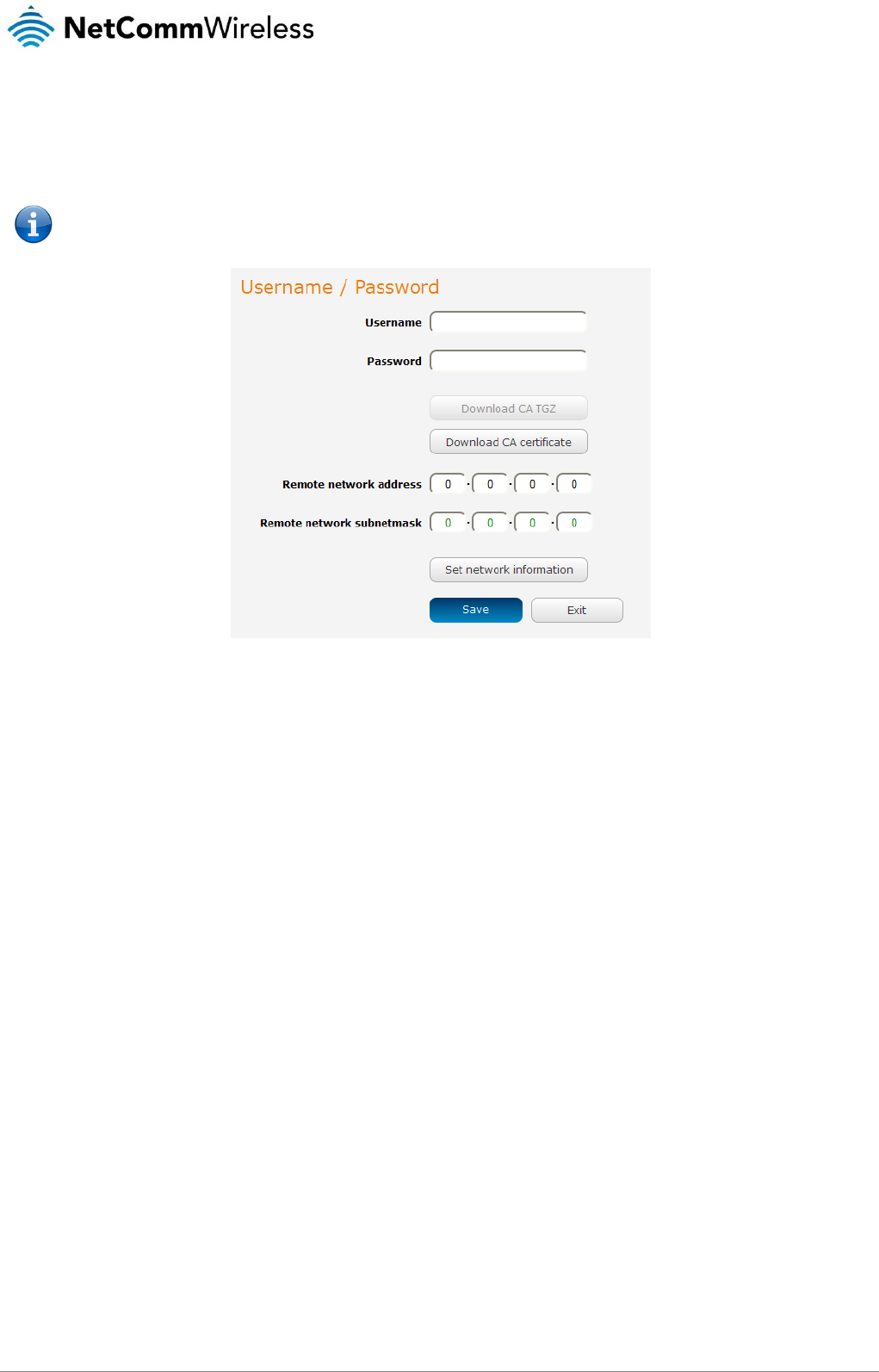
60
NetComm Wireless 4G M2M Router
www.netcommwireless.com
v1.0
Username / Password Authentication
In the Username/Password section, enter the username and password you would like to use for authentication on the
OpenVPN Server. Click the Download CA certificate or Download CA TGZ depending on file format button to save the
ca.crt file. This file will need to be provided to the client.
Note: If you wish to have more than one client connect to this OpenVPN server, you must use Certificate authentication
mode as Username/Password only allows for a single client connection.
Figure 67 - OpenVPN Server – Username / Password section
Optional: To inform the OpenVPN server of the network address scheme of the currently selected certificate, enter the
network address and network subnet mask in the respective fields and click the Set Network Information button. If you do
not enter the remote subnet here, any packet requests from the server to the client will not be received by the client
network because it is not aware of the remote client’s subnet.
When you have finished entering all the required information, click Save to finish configuring the OpenVPN server.
Configuring an OpenVPN Client
1. Click the OpenVPN profile toggle key to switch it to the ON position.
2. In the Profile name field, type a name for the OpenVPN client profile you are creating.
3. In the Server IP address field, type the WAN IP address /host domain name of the OpenVPN server.
4. Select OpenVPN connection type (TUN/TAP). Default is TUN.
5. Use the Server port field to select a port number and then use the drop down list to select a packet type to use for the
OpenVPN server. The default OpenVPN port is 1194 and default packet type is UDP.
6. If the Default gateway option is applied on the OpenVPN client page, the OpenVPN server will enable connections to be
made to other client networks connected to it. If it is not selected, the OpenVPN connection allows for secure
communication links between this router and the remote OpenVPN server only.
7. Use the Authentication type options to select the Authentication type that you would like to use for the OpenVPN client.
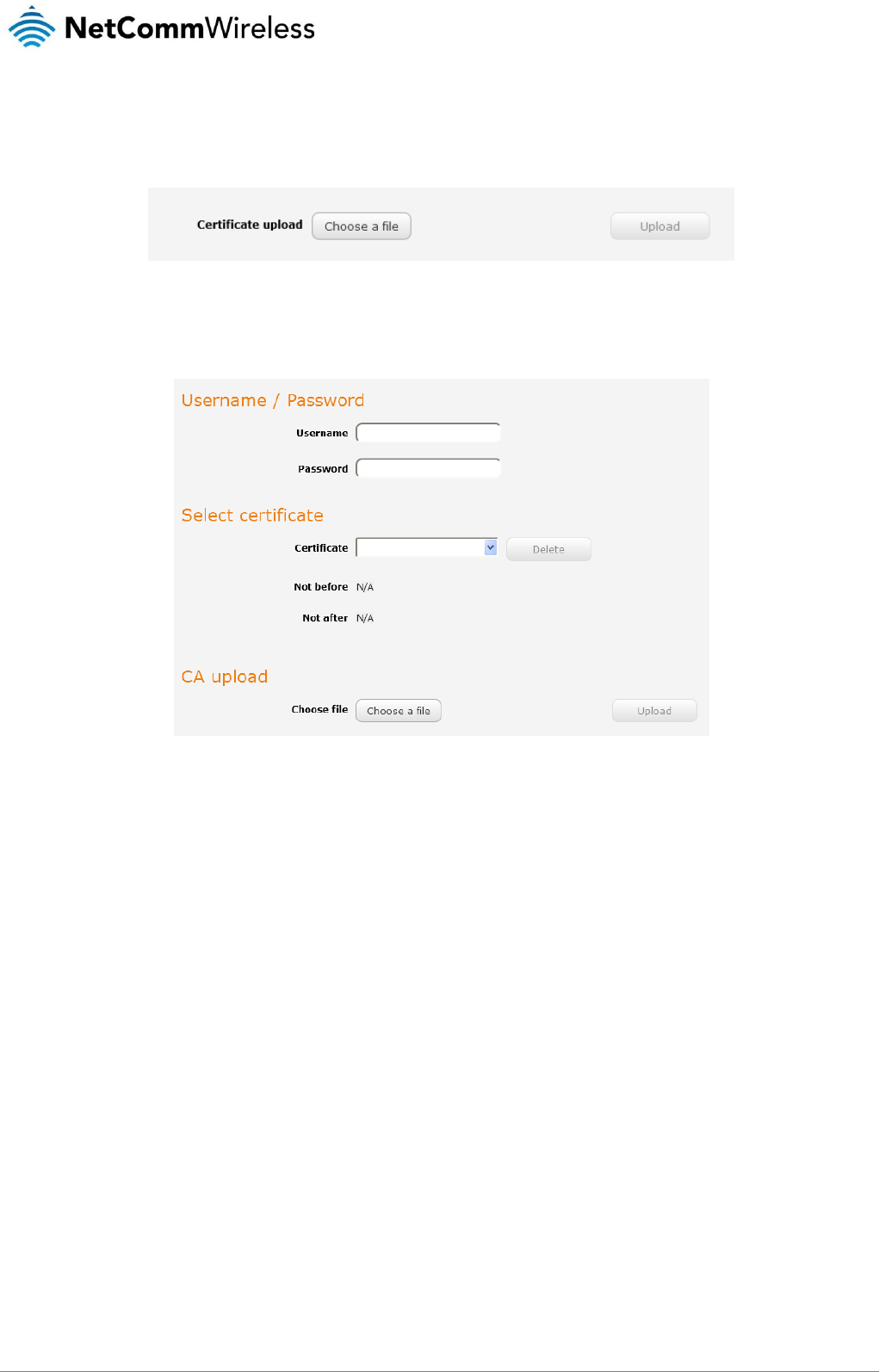
www.netcommwireless.com
NetComm Wireless 4G M2M Router
61
v1.0
Certificate Authentication
In the Certificate upload section at the bottom of the screen, click the Browse button and locate the certificate file you downloaded
when you configured the OpenVPN server. When it has been selected, click the Upload button to send it to the router.
Figure 68 - OpenVPN client - Certificate upload
Username / Password Authentication
Enter the username and password to authenticate with the OpenVPN server.
Figure 69 - OpenVPN Client - Username/Password section
Use the Browse button to locate the CA certificate file you saved from the OpenVPN Server and then press the Upload button to
send it to the router.
Click the Save button to complete the OpenVPN Client configuration.
Configuring an OpenVPN P2P Connection
To configure an OpenVPN peer-to-peer connection:
1. Set the OpenVPN profile toggle key to switch it to the ON position.
2. In the Profile name field, type a name for the OpenVPN P2P profile you are creating.
3. On the router designated as the server, leave the Server IP address field empty. On the router designated as the client,
enter the WAN IP address/host domain name of the server.
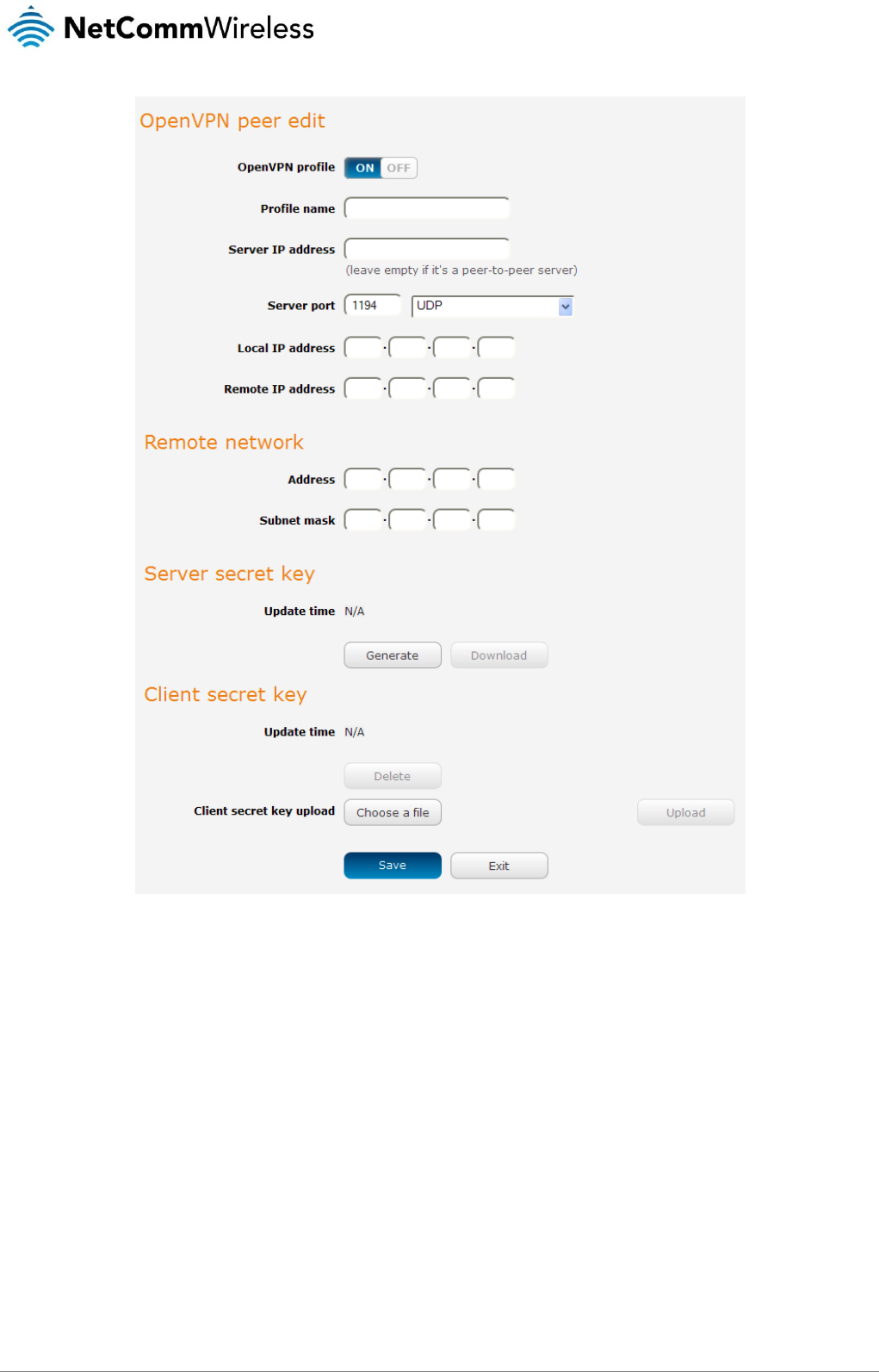
62
NetComm Wireless 4G M2M Router
www.netcommwireless.com
v1.0
Figure 70 - OpenVPN P2P mode settings
4. Use the Server port field to select a port number and then use the drop down list to select a packet type to use for the
OpenVPN server. The default OpenVPN port is 1194 and default packet type is UDP.
5. In the Local IP Address and Remote IP Address fields, enter the respective local and remote IP addresses to use for the
OpenVPN tunnel. The slave should have the reverse settings of the master.
6. Under the Remote network section, enter the network Address and network Subnet mask. The Network Address and
Network Mask fields inform the Master node of the LAN address scheme of the slave.
7. Press the Generate button to create a secret key to be shared with the slave. When the timestamp appears, you can click
the Download button to save the file to exchange with the other router.
8. When you have saved the secret key file on each router, use the Browse button to locate the secret key file for the master
and then press the Upload button to send it to the slave. Perform the same for the other router, uploading the slave’s
secret key file to master.
9. When they are uploaded click the Save button to complete the peer-to-peer OpenVPN configuration.
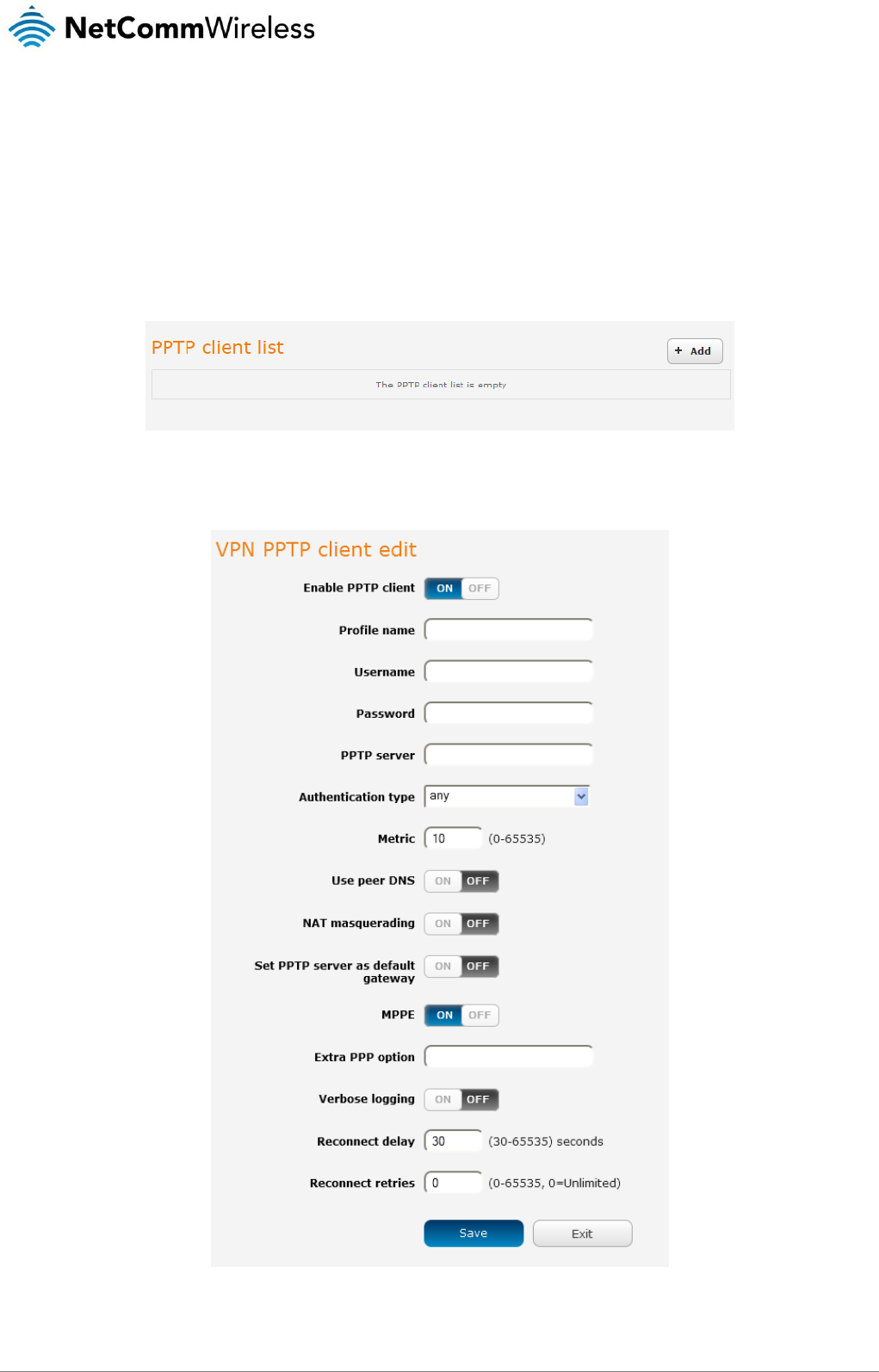
www.netcommwireless.com
NetComm Wireless 4G M2M Router
63
v1.0
PPTP client
The Point-to-Point Tunnelling Protocol (PPTP) is a method for implementing virtual private networks using a TCP and GRE tunnel to
encapsulate PPP packets. PPTP operates on Layer 2 of the OSI model and is included on Windows computers.
Configuring the PPTP client
To configure the PPTP client:
1. From the menu bar at the top of the screen, click Networking and then from the VPN section on the left side of the screen,
click PPTP client. The PPTP client list is displayed.
Figure 71 - PPTP client list
2. Click the +Add button to begin configuring a new PPTP client profile. The PPTP client edit screen is displayed.
Figure 72 - VPN PPTP client edit

64
NetComm Wireless 4G M2M Router
www.netcommwireless.com
v1.0
3. Click the Enable PPTP client toggle key to switch it to the ON position.
4. In the Profile name list, enter a profile name for the tunnel. This may be anything you like and is used to identify the tunnel
on the router.
5. Use the Username and Password fields to enter the username and password for the PPTP account.
6. In the PPTP server address field, enter the IP address /host domain name of the PPTP server.
7. From the Authentication type drop down list, select the Authentication type used on the server. If you do not know the
authentication method used, select any and the router will attempt to determine the correct authentication type for you.
There are 5 authentication types you can choose from:
CHAP – uses a three way handshake to authenticate the identity of a client.
MS-CHAP v1 – This is the Microsoft implementation of the Challenge Handshake Authentication Protocol for which
support was dropped in Windows® Vista.
MS-CHAP v2 - This is the Microsoft implementation of the Challenge Handshake Authentication Protocol which was
introduced in Windows® NT 4.0 and is still supported today.
PAP – The Password Authentication Protocol uses a password as a means of authentication and as such, is
commonly supported. PAP is not recommended because it transmits passwords unencrypted and is not secure.
EAP – Extensible Authentication Protocol. An Authentication protocol commonly used in wireless networks.
8. The metric value helps the router to prioritise routes and must be a number between 0 and 65535. The default value is 30
and should not be modified unless you are aware of the effect your changes will have.
9. The Use peer DNS option allows you to select whether the remote clients will use the Domain Name Server of the PPTP
server. Click the toggle key to set this to ON or OFF as required.
10. NAT masquerading allows the router to modify the packets sent and received to inform remote computers on the internet
that packets originating from a machine behind the router actually originated from the WAN IP address of the router’s
internal NAT IP address. Click the toggle key to switch this to the ON position if you want to use this feature.
11. Set default route to PPTP sets all outbound data packets to go out through the PPTP tunnel. Click the toggle key to
switch this to the ON position if you want to use this feature.
12. The Verbose logging option sets the router to output detailed logs regarding the PPTP connection in the System Log
section of the router interface.
13. The Reconnect delay is the time in seconds that the router will wait before attempting to connect to the PPTP server in the
event that the connection is broken. The minimum time to wait is 30 seconds so as to not flood the PPTP server with
connection requests, while the maximum time to wait is 65335 seconds.
14. The Reconnect retries is the number of connection attempts that the router will make in the event that the PPTP
connection goes down. If set to 0, the router will retry the connection indefinitely, otherwise the maximum number of times
to retry cannot be greater than 65335.
15. Click the Save button to save the changes. The VPN will attempt to connect after your click Save. Click the Status button
at the top left of the interface to return to the status window and monitor the VPN’s connection state.
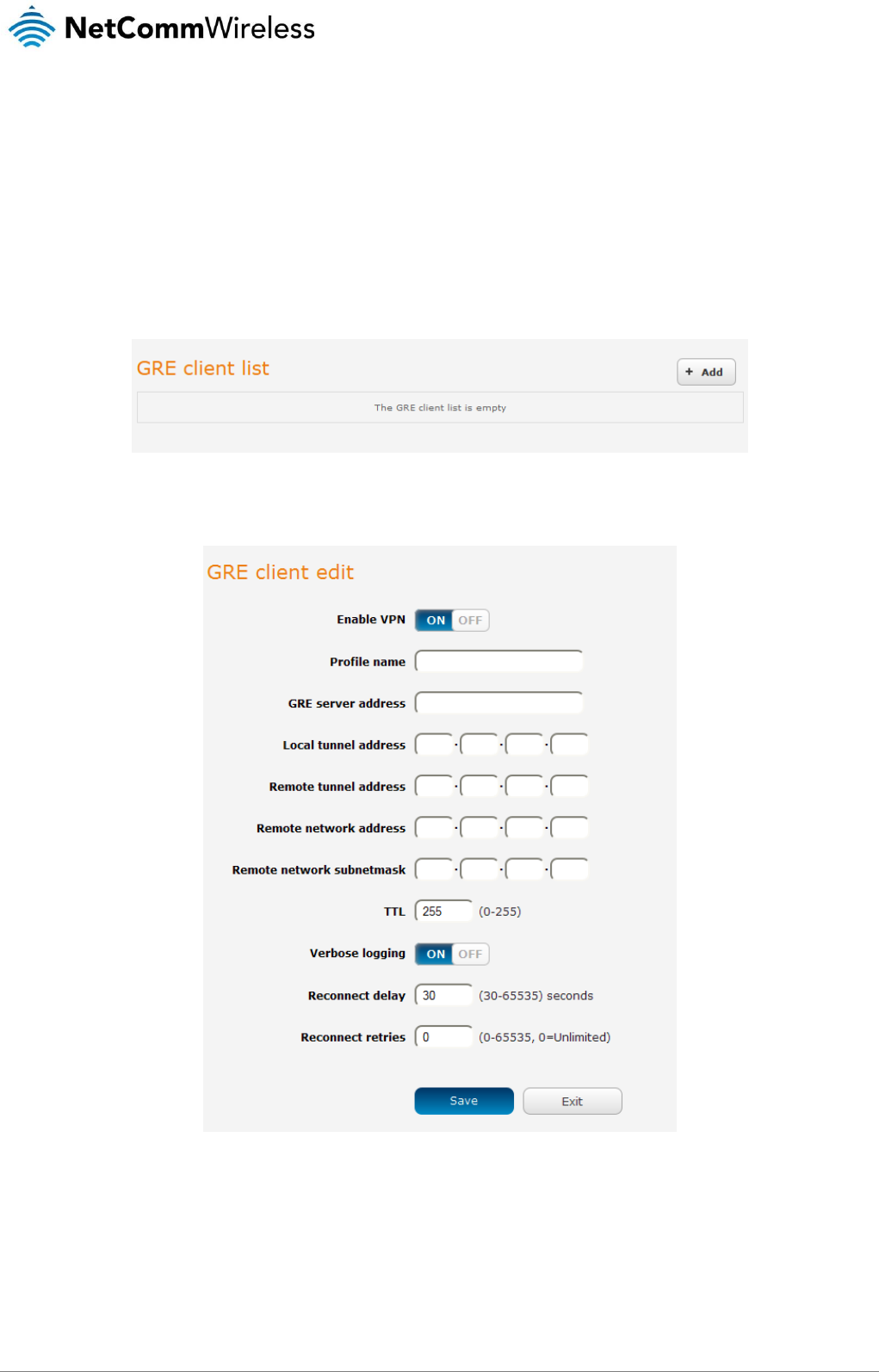
www.netcommwireless.com
NetComm Wireless 4G M2M Router
65
v1.0
GRE tunnelling
The Generic Route Encapsulation (GRE) protocol is used in addition to Point-to-Point Tunnelling Protocol (PPTP) to create VPNs
(virtual private networks) between clients and servers or between clients only. Once a PPTP control session establishes the VPN
tunnel GRE is used to securely encapsulate the data or payload.
Configuring GRE tunnelling
To configure GRE tunnelling:
1. From the menu bar at the top of the screen, click Networking and then from the VPN section on the left side of the screen,
click GRE. The GRE client list is displayed.
Figure 73 - GRE client list
2. Click the +Add button to begin configuring a new GRE tunnelling client profile. The GRE Client Edit screen is displayed.
Figure 74 – GRE client edit

66
NetComm Wireless 4G M2M Router
www.netcommwireless.com
v1.0
3. Click the Enable GRE Tunnel toggle key to switch it to the ON position.
4. In the Profile name, enter a profile name for the tunnel. This may be anything you like and is used to identify the tunnel on
the router.
5. In the GRE server address field, enter the IP address or domain name of the GRE server.
6. In the Local tunnel address field, enter the IP address you want to assign the tunnel locally.
7. In the Remote tunnel address field, enter the IP address you want to assign to the remote tunnel.
8. In the Remote network address field, enter the IP address scheme of the remote network.
9. In the Remote network subnetmask field, enter the subnet mask of the remote network.
10. The TTL (Time To Live) field is an 8-bit field used to remove an undeliverable data packet from a network to avoid
unnecessary network traffic across the internet. The default value of 255 is the upper limit on the time that an IP datagram
can exist. The value is reduced by at least one for each hop the data packet takes to the next router on the route to the
datagram’s destination. If the TTL field reaches zero before the datagram arrives at its destination the data packet is
discarded and an error message is sent back to the sender.
11. The Verbose logging option sets the router to output detailed logs regarding the GRE tunnel in the System Log section of
the router interface.
12. The Reconnect delay is the time in seconds that the router will wait before attempting to connect to the GRE server in the
event that the connection is broken. The minimum time to wait is 30 seconds so as to not flood the GRE server with
connection requests, while the maximum time to wait is 65335 seconds.
13. The Reconnect retries is the number of connection attempts that the router will make in the event that the GRE connection
goes down. If set to 0, the router will retry the connection indefinitely, otherwise the maximum number of times to retry
cannot be greater than 65335.
14. Click the Save button to save the changes. The VPN will attempt to connect after your click Save. Click the Status button
at the top left of the interface to return to the status window and monitor the VPN’s connection state.
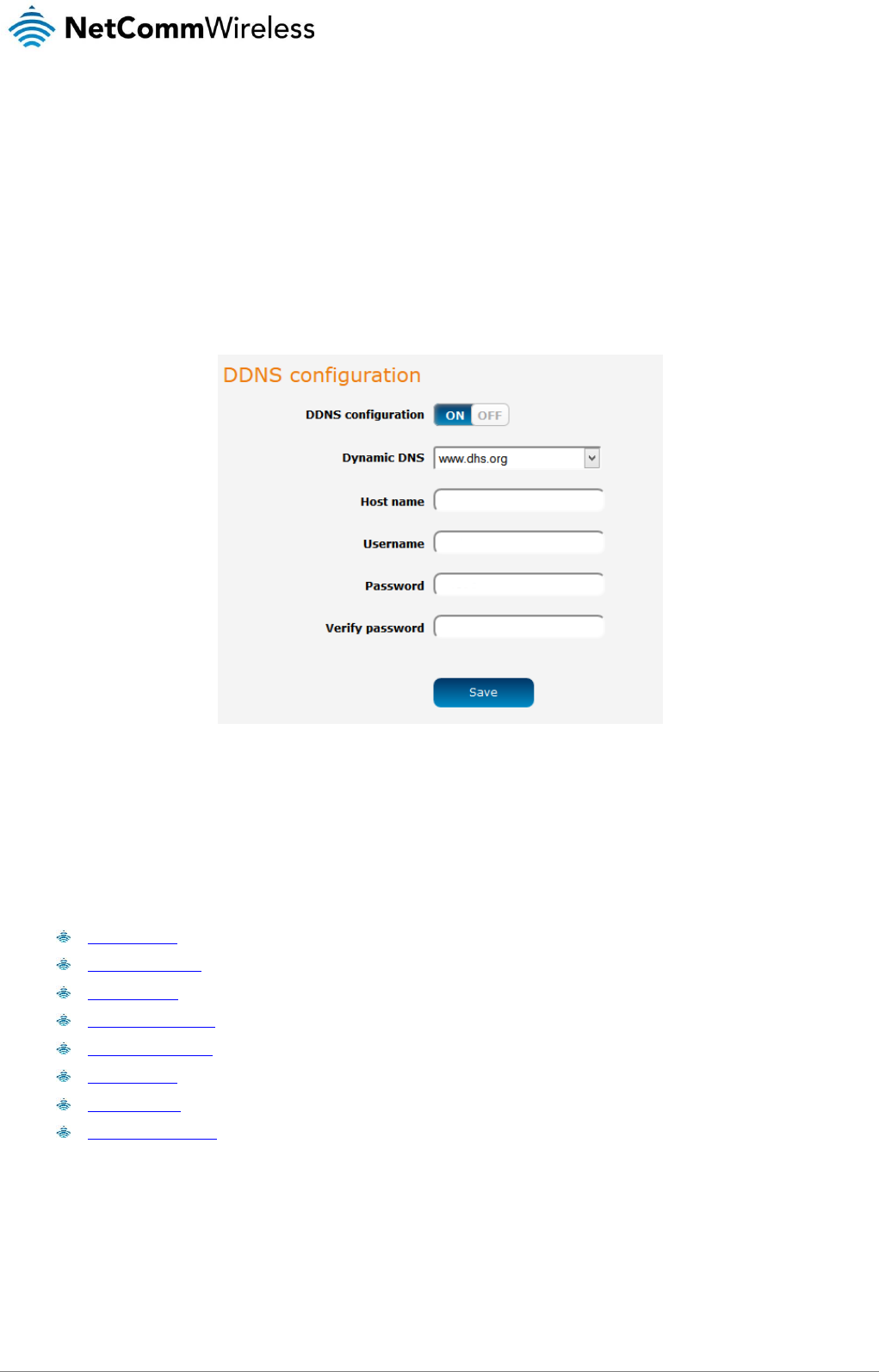
www.netcommwireless.com
NetComm Wireless 4G M2M Router
67
v1.0
Services
Dynamic DNS
The DDNS page is used to configure the Dynamic DNS feature of the router. A number of Dynamic DNS hosts are available from
which to select. To access the Dynamic DNS page, click on the Services menu at the top of the screen then click on the Dynamic
DNS menu item on the left.
Figure 75 – Dynamic DNS settings
Dynamic DNS provides a method for the router to update an external name server with the current WAN IP address.
To configure dynamic DNS:
1. Click the DDNS configuration toggle key to switch it to the ON position.
2. From the Dynamic DNS drop down list, select the Dynamic DNS service that you wish to use. The available DDNS services
available are:
www.dhs.org
www.dyndns.org
www.dyns.cx
www.easydns.com
www.justlinux.com
www.ods.org
www.tzo.com
www.zoneedit.com
3. Enter your hostname in ‘Host name’ field.
4. In the Username and Password fields, enter the logon credentials for your DDNS account. Enter the password for the
account again in the Verify password field.
5. Click the Save button to save the DDNS configuration settings.
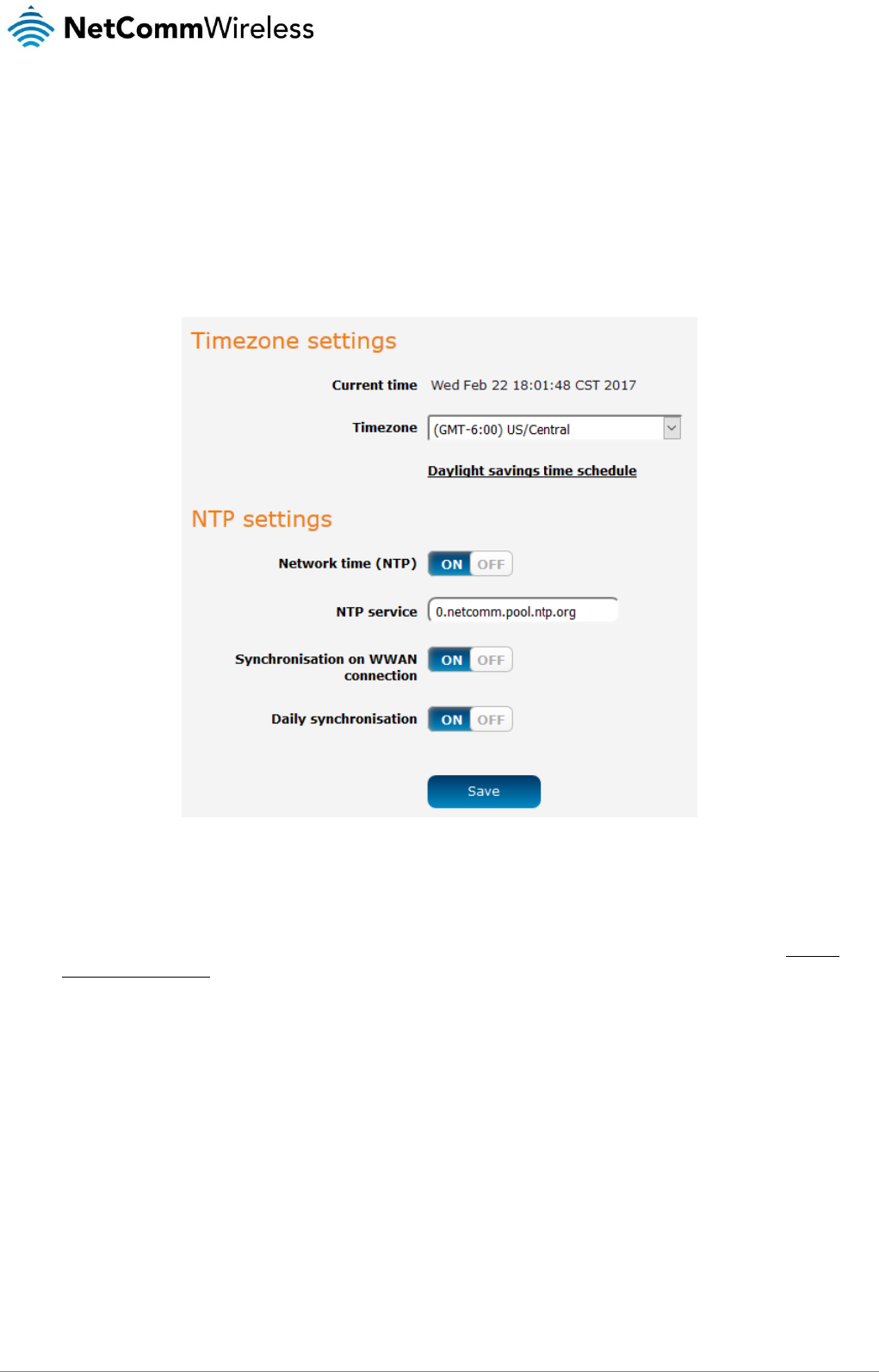
68
NetComm Wireless 4G M2M Router
www.netcommwireless.com
v1.0
Network time (NTP)
The NTP (Network Time Protocol) settings page allows you to configure the NTC-140-01 router to synchronize its internal clock with
a global Internet Time server and specify the time zone for the location of the router. This provides an accurate timekeeping function
for features such as System Log entries and Firewall settings where the current system time is displayed and recorded. Any NTP
server available publicly on the internet may be used. The default NTP server is 0.netcomm.pool.ntp.org.
To access the Network time (NTP) page, click on the Services menu at the top of the screen then click on the Network time (NTP)
menu item on the left.
Figure 76 - NTP settings
Configuring Timezone settings
To configure time zone settings:
1. The Current time field shows the time and date configured on the router. If this is not accurate, use the Time zone drop
down list to select the correct time zone for the router. If the selected zone observes daylight savings time, a Daylight
savings time schedule link appears below the drop down list. Click the link to see the start and end times for daylight
savings.
2. When you have selected the correct time zone, click the Save button to save the settings.
Configuring NTP settings
To configure NTP settings:
1. Click the Network time (NTP) toggle key to switch it to the ON position.
2. In the NTP service field, enter the address of the NTP server you wish to use.
3. The Synchronization on WWAN connection toggle key enables or disables the router from performing a synchronization of
the time each time a mobile broadband connection is established.
4. The Daily synchronisation toggle key enables or disables the router from performing a synchronization of the time each
day.
5. When you have finished configuring NTP settings, click the Save button to save the settings.
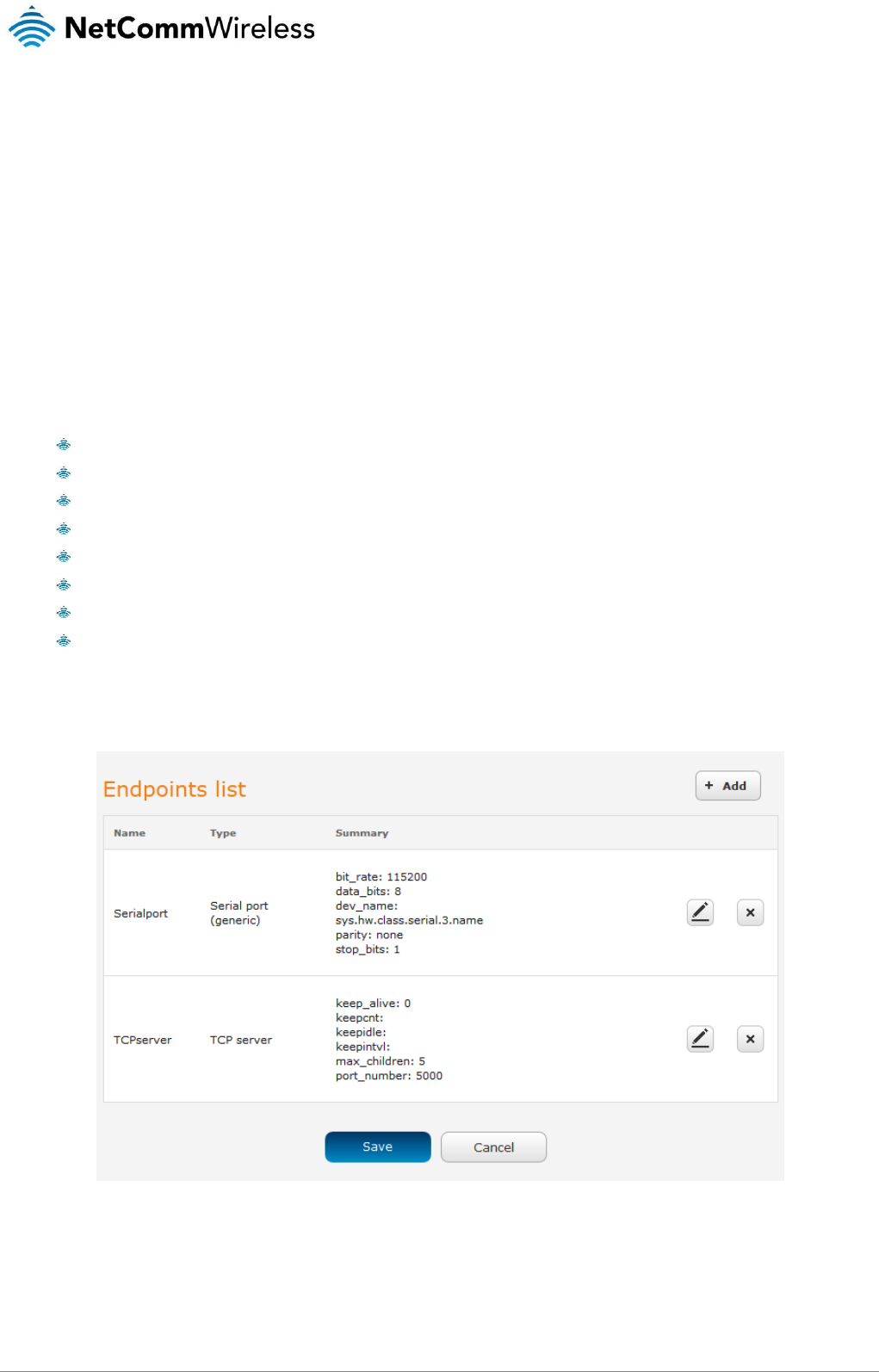
www.netcommwireless.com
NetComm Wireless 4G M2M Router
69
v1.0
Data stream manager
The data stream manager provides you with the ability to create mappings between two endpoints on the router. These endpoints
may be physical or virtual, for example, a serial port connected to the router’s USB port could be configured as an endpoint or you
could configure a TCP Server as an endpoint. You can then configure a virtual data tunnel or “stream” between the endpoints.
The data stream manager provides a wide range of possibilities and expands upon simple PAD functionality to include the
forwarding and translation of data between any of the endpoints. In each case, the logical flow of the stream is from Endpoint A to
Endpoint B.
Customers interested in developing their own applications to create custom endpoints and streams can contact NetComm Wireless
about our Software Development Kit.
Endpoints
The first thing to be done in order to create a data stream is to define the endpoints. There are 6 types of endpoint that may be
configured:
Serial port (generic)
TCP Server
TCP Client
UDP Server
UDP Client
User defined executable
Circuit switched data (CSD)
TCP connect-on-demand
To access the Endpoints page, click on the Services menu at the top of the screen, click on the Data stream manager menu then
click on the Endpoint menu item on the left.
Figure 77 - Endpoints list
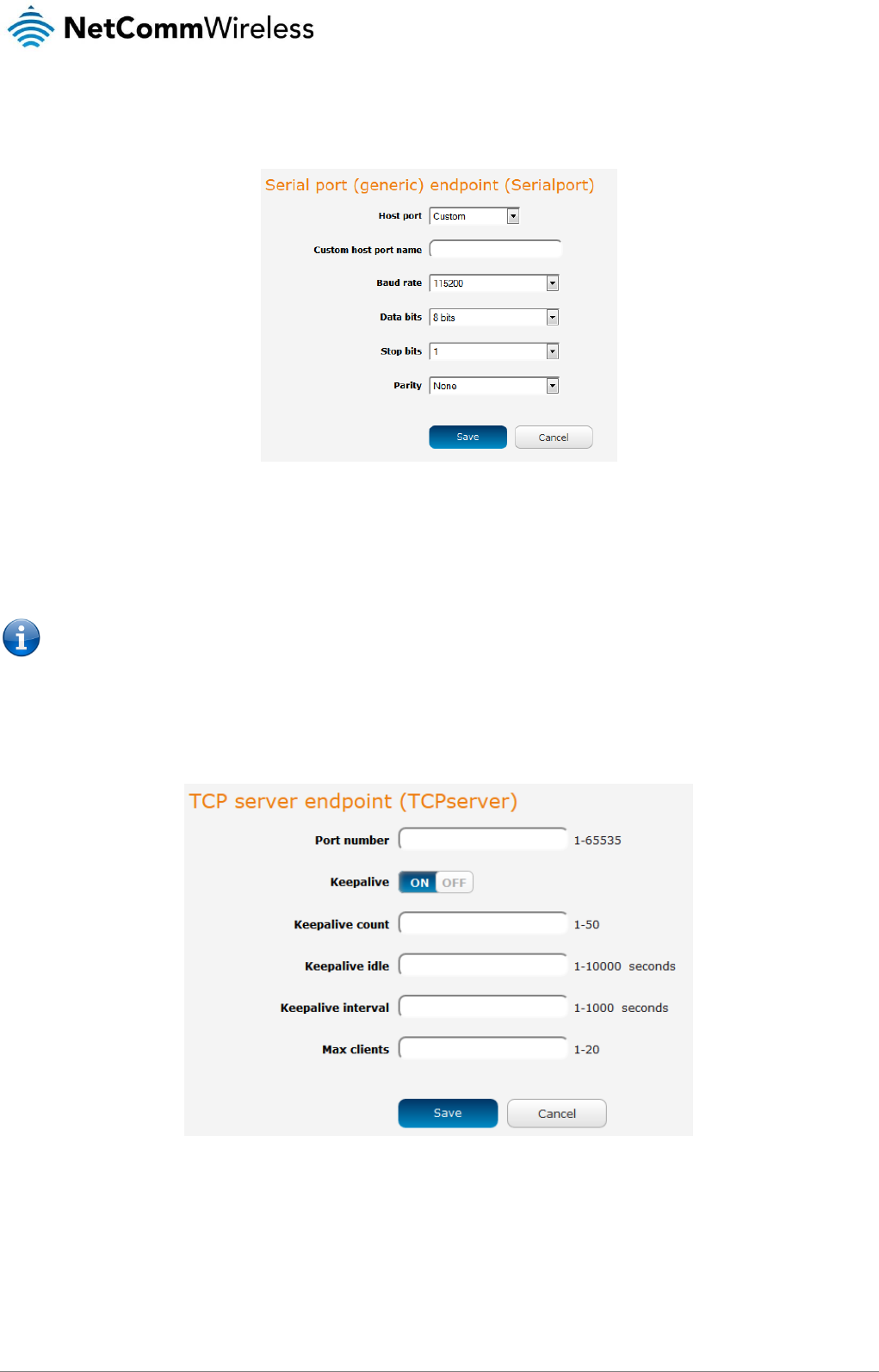
70
NetComm Wireless 4G M2M Router
www.netcommwireless.com
v1.0
Serial port (generic)
This creates a generic serial port as an endpoint defaulting to the commonly used settings as shown below.
Figure 78 - Serial port (generic) endpoint configuration (Custom)
When the Host port is set to Custom, you can use the Custom host port name field to manually specify a device path to use, for
example, if using a USB-to-Serial adapter you could telnet to the router and issue the command ls /dev/ttyUSB* to list the paths
of the connected USB devices. To determine the path of the desired USB adapter, issue the command when the adapter is not
connected then run the command again when the adapter is connected and compare the output.
Note: Using a custom host port name is not recommended for normal use as the device path can change between power
cycles of the router.
TCP server
This creates a TCP server endpoint with the following options available.
Figure 79 - TCP server endpoint configuration
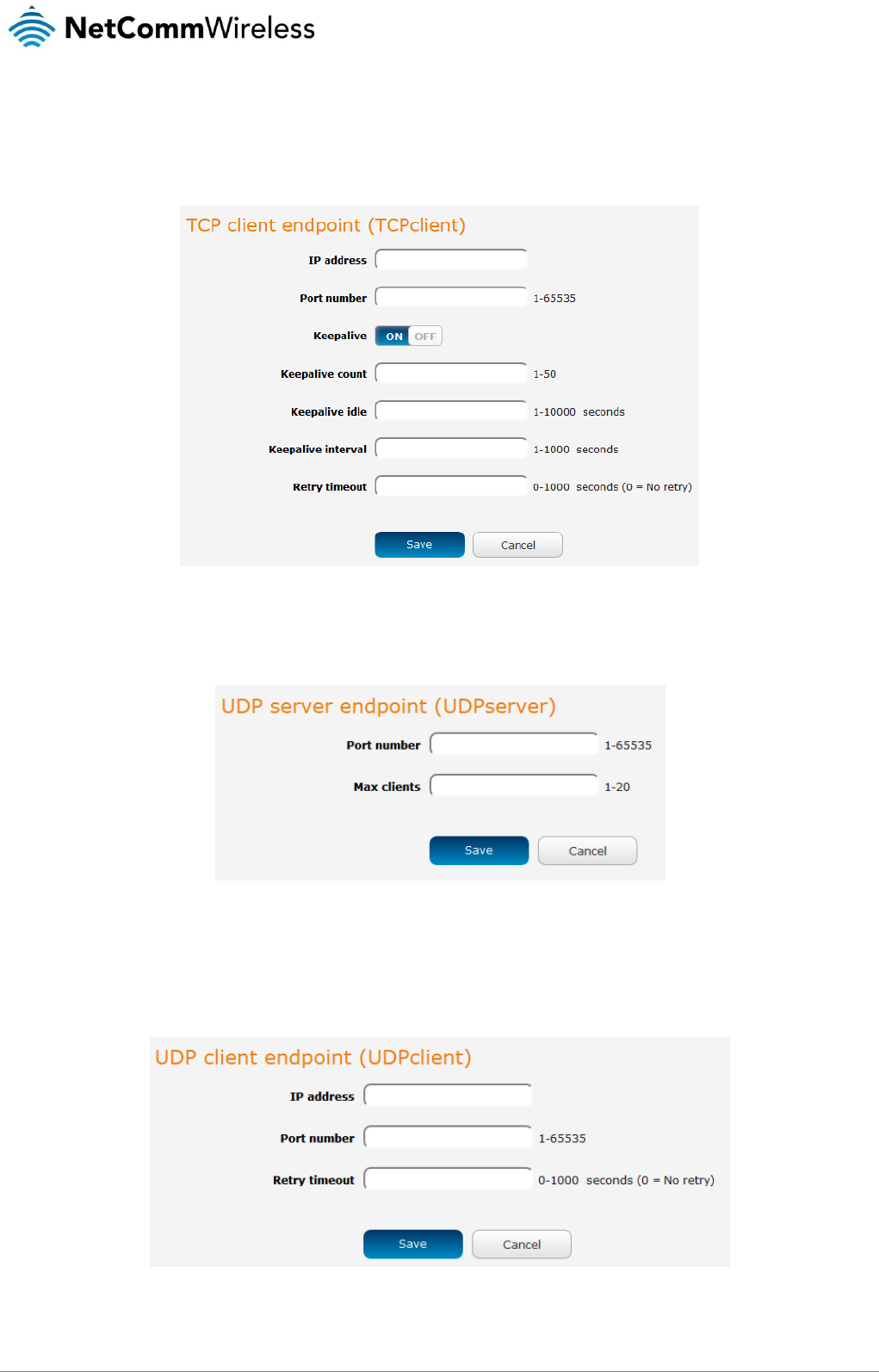
www.netcommwireless.com
NetComm Wireless 4G M2M Router
71
v1.0
TCP client
This creates a TCP client endpoint with the following options available. The retry timeout period specifies the number of seconds to
wait between attempts to re-establish a connection in the event that it is lost. The client will attempt re-connection indefinitely every
Retry timeout interval.
Figure 80 - TCP client endpoint configuration
UDP server
This creates a UDP server endpoint with the following options available.
Figure 81 - UDP server endpoint configuration
UDP client
This creates a UDP client endpoint with the following options available. The retry timeout period specifies the number of seconds to
wait between attempts to re-establish a connection in the event that it is lost. The client will attempt re-connection indefinitely every
Retry timeout interval.
Figure 82 - UDP client endpoint configuration

72
NetComm Wireless 4G M2M Router
www.netcommwireless.com
v1.0
User defined executable
Allows you to specify an executable and parameters to be used as an endpoint. For example, the following executable reads the
phone module temperature every second.
while true; do rdb_get wwan.0.radio.temperature; sleep 1; done
The temperature can then be sent to another endpoint.
Figure 83 – User defined executable endpoint configuration
ITEM
DESCRIPTION
Host port
Use the drop down list to select the serial port to use. If no USB-to-Ethernet adapter is connected, the only
available selection is the Built-in serial port.
Baud rate
The serial (V.24) port baud rate. By default the serial line format is 8 data bits, No parity, 1 Stop bit.
Refer to the AT (V.250) AT Command Manual if you need to change the serial line format.
Data bits
The default serial line data bits setting used is 8. Options include 5 – 8 bits.
Stop bits
The default stop bit setting is set to 1. However the stop bit setting can be set to 2 bits if required.
Parity
Parity is the means to detect transmission errors. An extra data bit is transmitted with each data character, and is
arranged in a fashion such that the number of 1 bits in each character, including the parity bit, is always odd or
always even. If a byte is received with the wrong number of 1s, then this shows the data must be corrupt. Options
include none, odd or even. The default setting is none for no parity checks.
Hardware flow control
• Off - Serial port flow control off
• Hardware - Serial port uses RTS/CTS flow control
Software flow control
Enables or disables software flow control.
DSR action
Sets the Data Set Ready action. This is an output from the modem and this configuration determines the pin’s
behavior.
• Always: DSR is always on.
• Registered: When connected to a CSD endpoint, sets pin to “on” when modem is in data mode.
• Session established: When connected to PPP endpoint, sets pin on when PDP is connected, when connected
to IP modem endpoint, sets pin to on when modem is in online state (e.g. data connection is established).
• Never: DSR is always off.
• Mimic DTR: mimics the DTR pin.
DCD action
Determines how the router controls the state of the serial port Data Carrier Detect (DCD) line.
• Always On: DCD is always on.
• Connect: DCD is on when a connection is established in response to an ATD command or DTR dial.
• Session established: Pin is on when PPP session is in progress or modem is in an online state (e.g. data
connection is established).
• Always Off: DCD is always off.
DTR action
Determines how the router responds to change of state of the serial port DTR line
• Ignore - Take no action
• Enter Command State – when connected to PPP endpoint, this is equivalent to disconnect. When connected to
IP modem or CSD endpoint, this enters online command state (e.g. process AT commands without dropping the
connection).
• Disconnect – terminates connection.
RI action
Determines how the router controls the state of the serial port RI (Ring Indicator) line.
• Always On: RI is always on.
• Incoming Ring: RI is on when an incoming connection request is received.
• Always Off: RI is always off
Enable auto answer
When enabled, the router accepts incoming connections.
Circuit auto answer rings
Sets the number of incoming rings after which the router will answer incoming circuit switched data calls. The
default value is Off. The other available options are from 1 to 12.
Advanced status
Echo enable
Enables echo on the serial side. All commands are echoes. This can be turned on/off via ATE1 and ATE0
commands. Recommended setting for this option is ON.
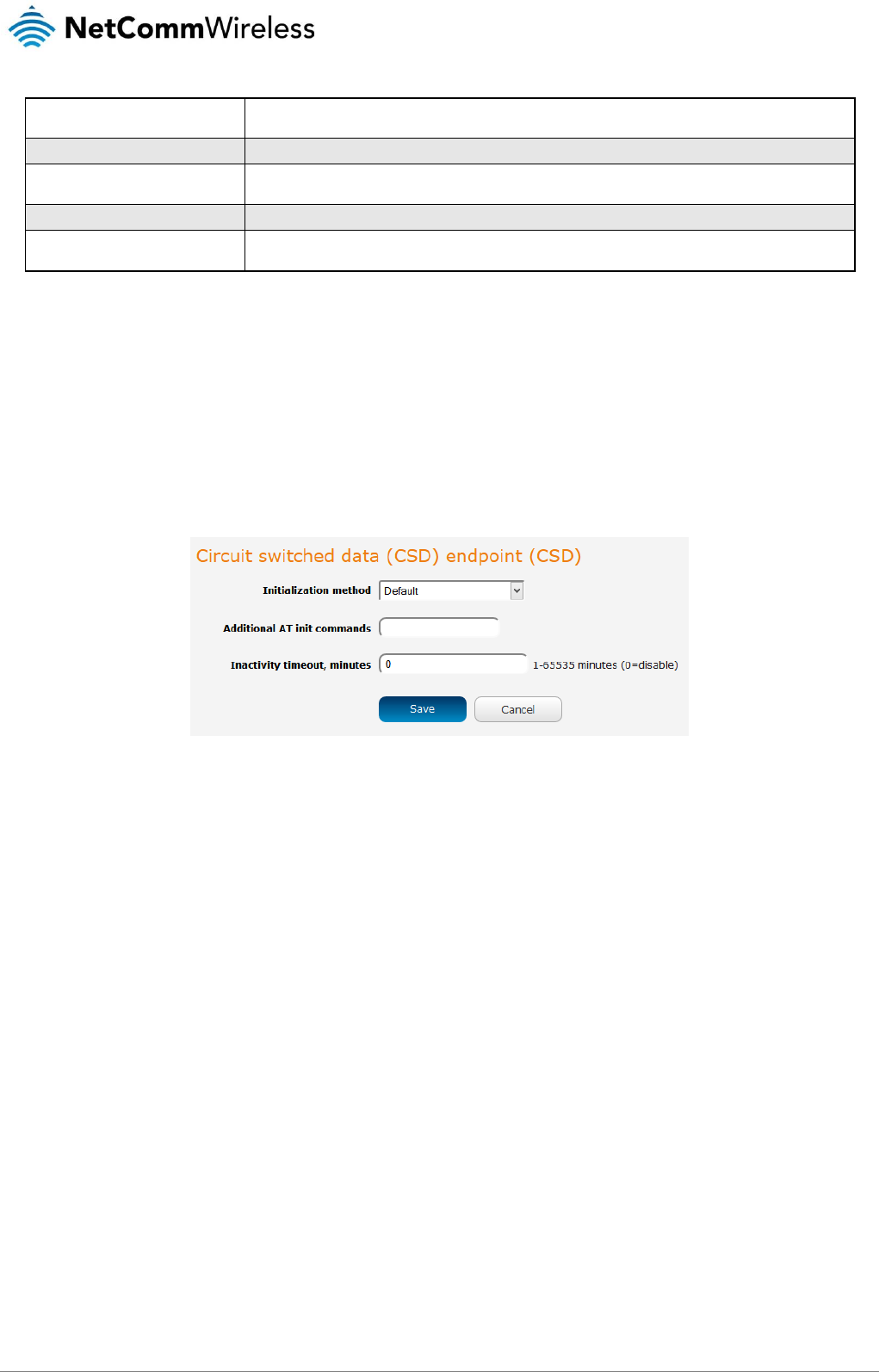
www.netcommwireless.com
NetComm Wireless 4G M2M Router
73
v1.0
Quiet mode
When on, there is no output from the modem on the serial side, i.e. you do not see OK, Connect etc.
Recommended setting for this option is OFF.
Send OK on carriage return
If enabled, will print OK every time CR is received on the serial side. Recommended setting for this option is ON.
Suppress line feeds
If enabled, line termination is using CR (13). If disabled, line termination is CR LF (13 10). Recommended setting
for this option is OFF.
Send OK on unknown command
Will send OK when an unknown/invalid AT command is received. Recommended setting for this option is ON.
Verbose mode
The modem returns messages to the computer to indicate the return status of commands and interrupts such as
incoming call and call progress. Recommended setting for this option is ON.
Table 19 - Modem emulator endpoint options
Circuit switched data (CSD)
The CSD (Circuit Switched Data) endpoint is designed for use when CSD connectivity is required between equipment connected
through NetComm Wireless routers. A typical application of CSD is a dial-up connection to an ISDN service. CSD calls use the
functionality of the GSM networking and switching subsystem to carry data via GSM or later cellular networks.
In many ways, this is similar to making a voice call. When a CSD connection is established, the communication end points are
connected via a virtual circuit, similar to connections on traditional phone network. Unlike other end points connected to a Modem
emulator end point, CSD relies mainly on the functionality of 3G/4G/LTE module. In CSD mode, the data stream of the router
transparently passes through the data and signals from the serial port to the module and vice-versa. The available data rates will
vary according to the network of the service provider. It is not necessary to have PDP profiles enabled for this functionality, however,
you may need a special SIM card with data functionality for CSD calls to be made. Check with your service provider.
Figure 84 – Circuit switched data endpoint configuration
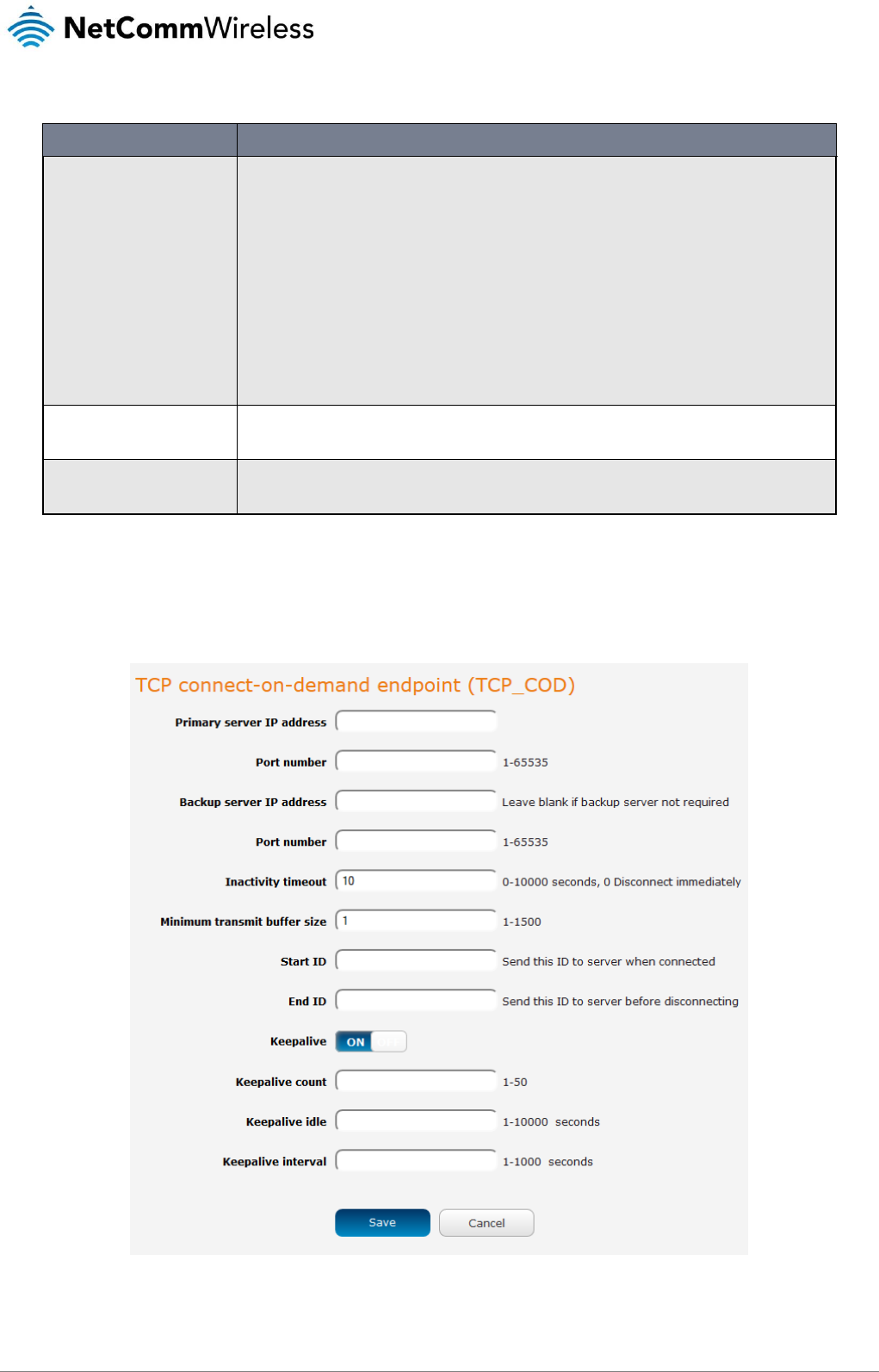
74
NetComm Wireless 4G M2M Router
www.netcommwireless.com
v1.0
ITEM
DESCRIPTION
Initialization method
Default - when data stream is established, the module will be initialized to a well-known, safe configuration
appropriate for CSD connection. These include the following AT commands:
ATE1 - enable echo
ATQ0 - disable quiet mode
ATV1 - enable verbose mode
AT&D2 - DTR line inactive disconnects the calls
AT&S1 - DSR becomes active in data mode, and off in command mode
AT&C1 - CD becomes active when call is connected
Hardware flow control is enabled on the module
User: no pre-defined commands are sent to the module. Custom initialization can be done using "Additional AT
init commands"
Additional AT initialization
commands
These commands are sent after default commands (if default method is used). For example, to change DTR
operation to enter online command mode instead of default disconnect, use the following command: AT&D1
with "Default" initialization method.
Inactivity timeout
If a non-zero value is entered and the router detects an inactivity period in an established CSD call in excess of
the number of minutes entered, the CSD call will be automatically terminated. Note: data sent in any direction
will prevent the call from being disconnected. The specified value should be in minutes.
Table 20 – CSD endpoint options
TCP connect-on-demand endpoint
The TCP connect-on-demand endpoint allows data to be buffered and then sent to a TCP server when the buffer has been filled. It
is primarily useful in situations where you do not want ‘keep alive’ packets to keep the socket open and create an overhead when
the TCP data connection is not in use.
Figure 85 – TCP connect-on-demand endpoint configuration
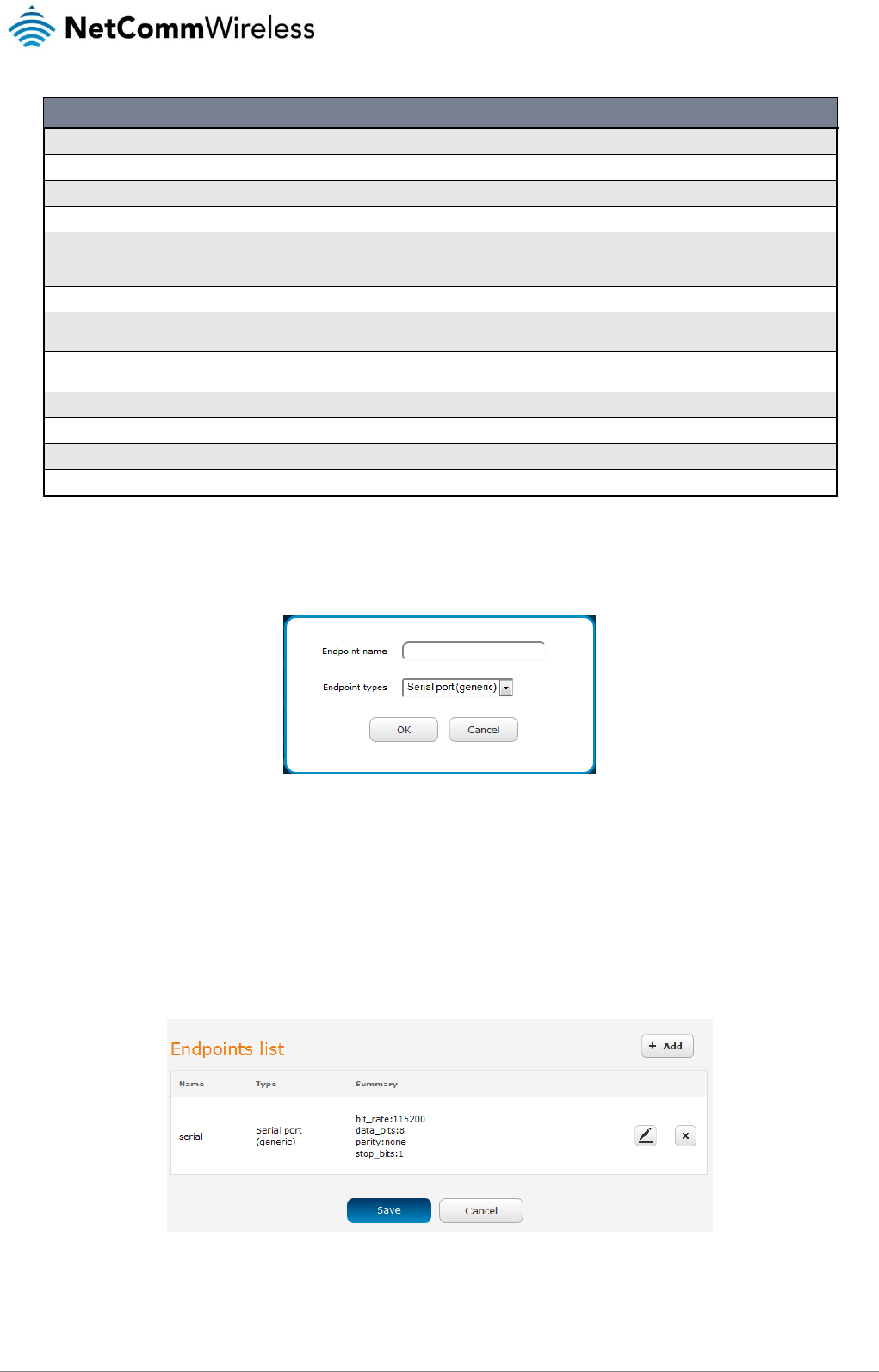
www.netcommwireless.com
NetComm Wireless 4G M2M Router
75
v1.0
ITEM
DESCRIPTION
Primary server IP address
The IP address of the TCP server to which the router should attempt the initial connection.
Port number
The port number that the TCP server operates on.
Backup server IP address
If connection to the primary server fails, the router will attempt to connect to this address.
Port number
The port number that the backup TCP server operates on.
Inactivity timeout
The period, in seconds, that the socket is considered idle/inactive if no packets are sent. The timer begins at the
end of the last sent packet. The valid range is 0-10000 seconds. If this field is set to 0, the client disconnects
immediately after sending a packet.
Minimum transmit buffer size
The number of bytes that must be reached before the client decides to transmit.
Start ID
This is a string which, if configured, is sent before any serial data is sent, every time the client connects <START
ID><SERIAL DATA>
End ID
This is a string which, if configured, is sent after all serial data, just before the client disconnects <START
ID><SERIAL DATA><END ID>
Keepalive
Keepalive sends a message to check that the link is still active or to keep it active.
Keepalive count
The number of keepalive messages to send.
Keepalive idle
The duration between two keepalive transmissions when in idle condition.
Keepalive interval
The duration between two successive keepalive retransmissions.
Table 21 – TCP connect-on-demand endpoint options
To create an endpoint:
1. Click the +Add button on the right side of the page. A pop-up window appears.
Figure 86 - Creating an endpoint
2. In the Endpoint name field, type a name for this endpoint. The name can contain alphanumeric characters only i.e. A-Z, a-
z, 0-9.
3. Use the Endpoint types drop down list to select the type of endpoint to configure.
4. Click the OK button. The router displays a screen with configuration options for your chosen endpoint type. Enter the
options for your endpoint as required.
5. Click the Save button. The Endpoints list is displayed with the newly created endpoint listed and a summary of the settings
your configured.
Figure 87 - Endpoints list
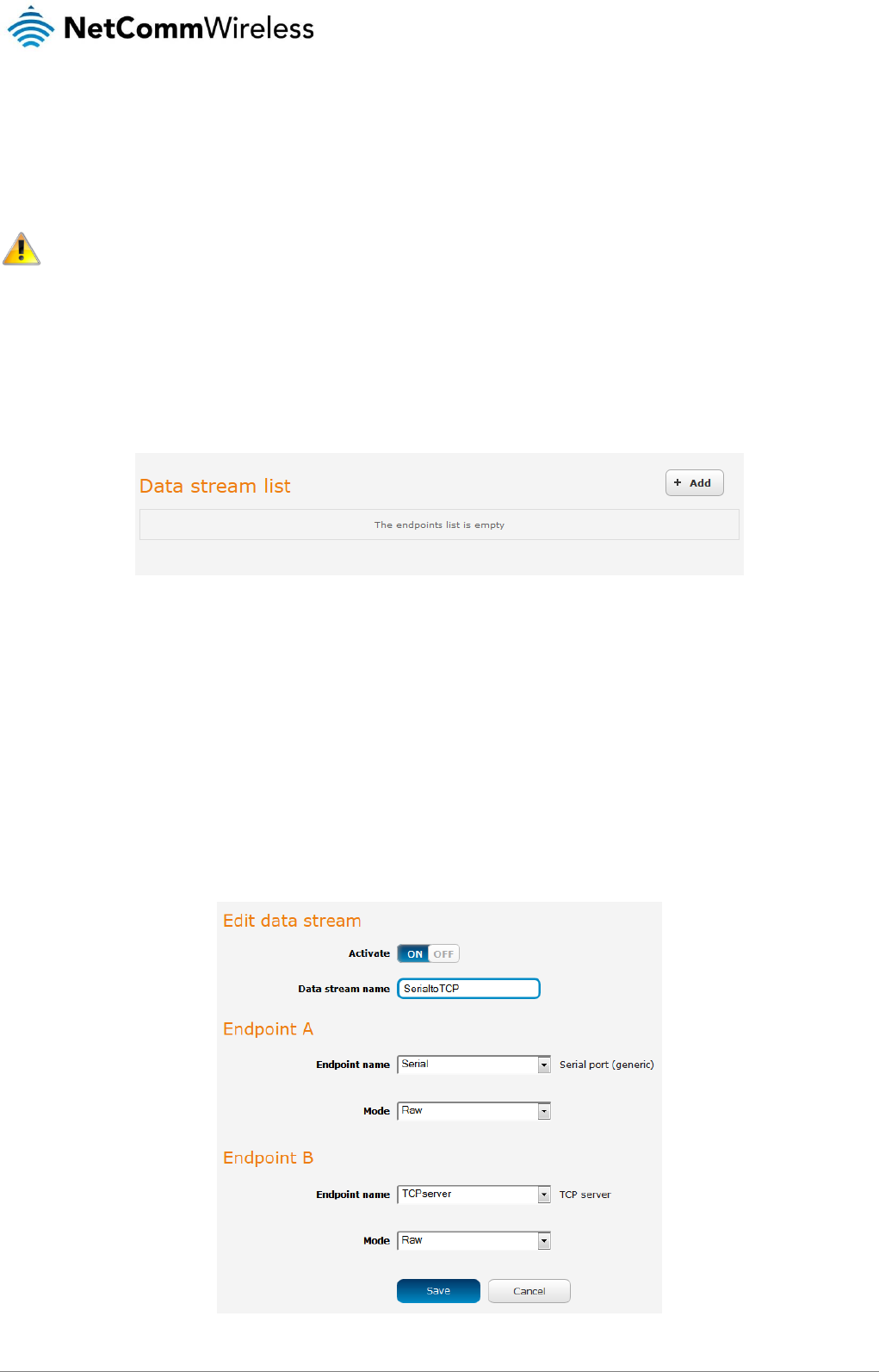
76
NetComm Wireless 4G M2M Router
www.netcommwireless.com
v1.0
Streams
When you have created the required endpoints, you can then proceed to set up a data stream. A data stream sends data from one
endpoint to another, performing any transformation of the data as required. When a stream is added, an underlying process on the
router checks the validity of the stream, checking for conflicts and illogical configurations. To access the Streams page, click on the
Services menu at the top of the screen, click on the Data stream manager menu then click on the Streams menu item on the left.
Every stream requires two endpoints, Endpoint A and Endpoint B. In all cases, the flow of data is from Endpoint A to Endpoint B.
To create a new stream:
1. Click the +Add button on the right side of the page.
Figure 88 - Data stream list
The Edit data stream page is displayed.
2. In the Data stream name field, enter a name for the Data stream.
3. Under Endpoint A, use the Endpoint name drop down list to select one of the endpoints you created previously. This
endpoint should be the starting point of the stream. Use the Mode drop down list to select the mode of operation of the
endpoint. The mode can be thought of as a transformation of the data as it leaves this endpoint. For example, if Endpoint
A type is Serial port (generic), the Mode can be set to various Modbus server and client types. This means that upon arrival
at Endpoint A, the data will be transformed into the chosen Modbus format, ready to be sent to Endpoint B.
4. Under Endpoint B, use the Endpoint name drop down list to select one of the endpoints you created previously. This
endpoint should be the destination of the stream. The screenshot below shows a configuration sending data received on
an attached serial port to a TCP server running on the router. Use the Mode drop down list to select the mode of operation
of the endpoint. The mode can be thought of as a transformation of the data as it arrives at this endpoint.
Figure 89 - Edit data stream
Notes on data stream operation:
• When any changes to the Data stream manager configuration are detected, all data streams are stopped and
restarted as per the new configuration.
• Multiple Modbus clients cannot connect simultaneously to Modbus serial slaves connected to the router.
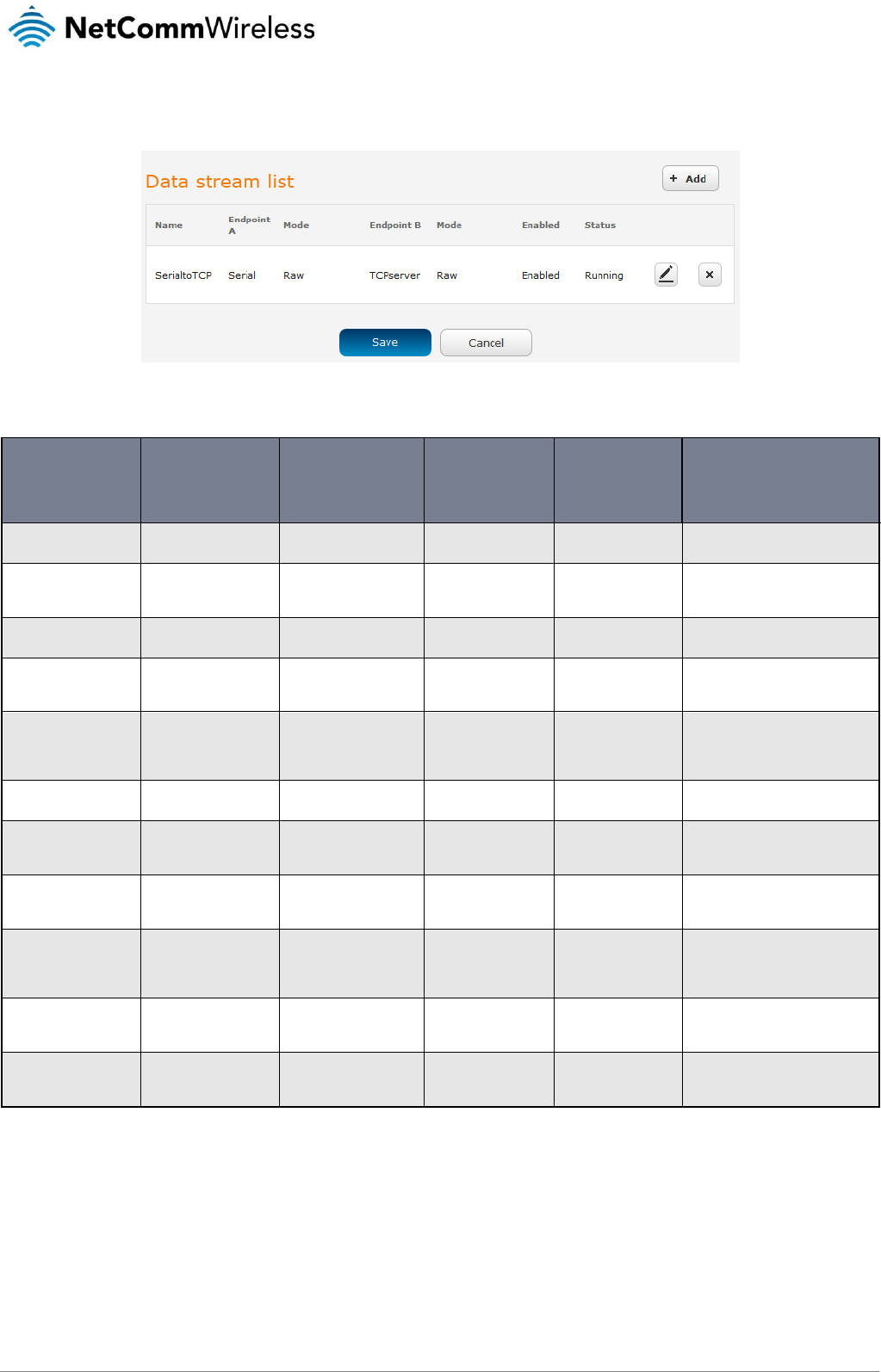
www.netcommwireless.com
NetComm Wireless 4G M2M Router
77
v1.0
5. Click the Save button. The new stream appears in the Data stream list.
Figure 90 - Data stream list.
Data stream applications
ENDPOINT A
ENDPOINT B
ENDPOINT A
MODE /
ENDPOINT B
MODE
ENDPOINTS
CAN BE
REVERSED
UNDERLYING
PROCESS
APPLICATION
1 (Serial), 8 (RS232), 9
(RS485), 10 (RS422)
1 (Serial), 8 (RS232), 9
(RS485), 10 (RS422)
Raw/Raw
N/A
socat
Serial to serial raw data stream
1 (Serial), 8 (RS232), 9
(RS485), 10 (RS422)
2 (TCP Server), 3 (TCP
Client), 4 (UDP Server),
5 (UDP Client)
Raw/Raw
Yes
socat
Serial to IP data stream
2 (TCP Server), 4 (UDP
Server)
3 (TCP Client), 5 (UDP
Client)
Raw/Raw
Yes
socat
Client to server data stream
1 (Serial), 8 (RS232), 9
(RS485), 10 (RS422)
3 (TCP Client)
Modbus Client Agent
ASCII, Modbus Client
Agent RTU/raw
No
dsm_data_mover
Modbus Client Agent functionality
1 (Serial), 8 (RS232), 9
(RS485), 10 (RS422)
2 (TCP Server)
Modbus Server
Gateway ASCII,
Modbus Server
Gateway RTU/raw
No
dsm_data_mover
Modbus Server Gateway
functionality
1 (Serial), 8 (RS232), 9
(RS485), 10 (RS422)
7 (User Executable)
Raw/Raw
Yes
socat
Send standard output of user-
executable program to serial port
2 (TCP Server), 3 (TCP
Client), 4 (UDP Server),
5 (UDP Client)
7 (User Executable)
Raw/Raw
Yes
socat
Send standard output of user-
executable program to TCP or
UDP client or server
11 (Modem Emulator)
12 (PPP Server)
Raw/Raw
Yes
modem_emul_ep
Router terminated PPP Server
functionality for dial-up PPP
clients
11 (Modem Emulator)
13 (IP Modem)
Raw/Raw
Yes
modem_emul_ep
Modem emulation and tunneling
via TCP/UDP (replacement for
PAD Mode of the old Modem
Emulator)
11 (Modem Emulator)
14 (CSD)
Raw/Raw
Yes
modem_emul_ep
Circuit Switched Data calls via
3G/4G module and mobile
networks
1 (Serial), 8 (RS232), 9
(RS485), 10 (RS422)
15 (TCP Client
Connect on Demand)
Raw/Raw
Yes
dsm_data_mover
Serial to TCP server connection,
which is initiated ONLY when data
is seen on serial port
Table 22 - Data stream applications
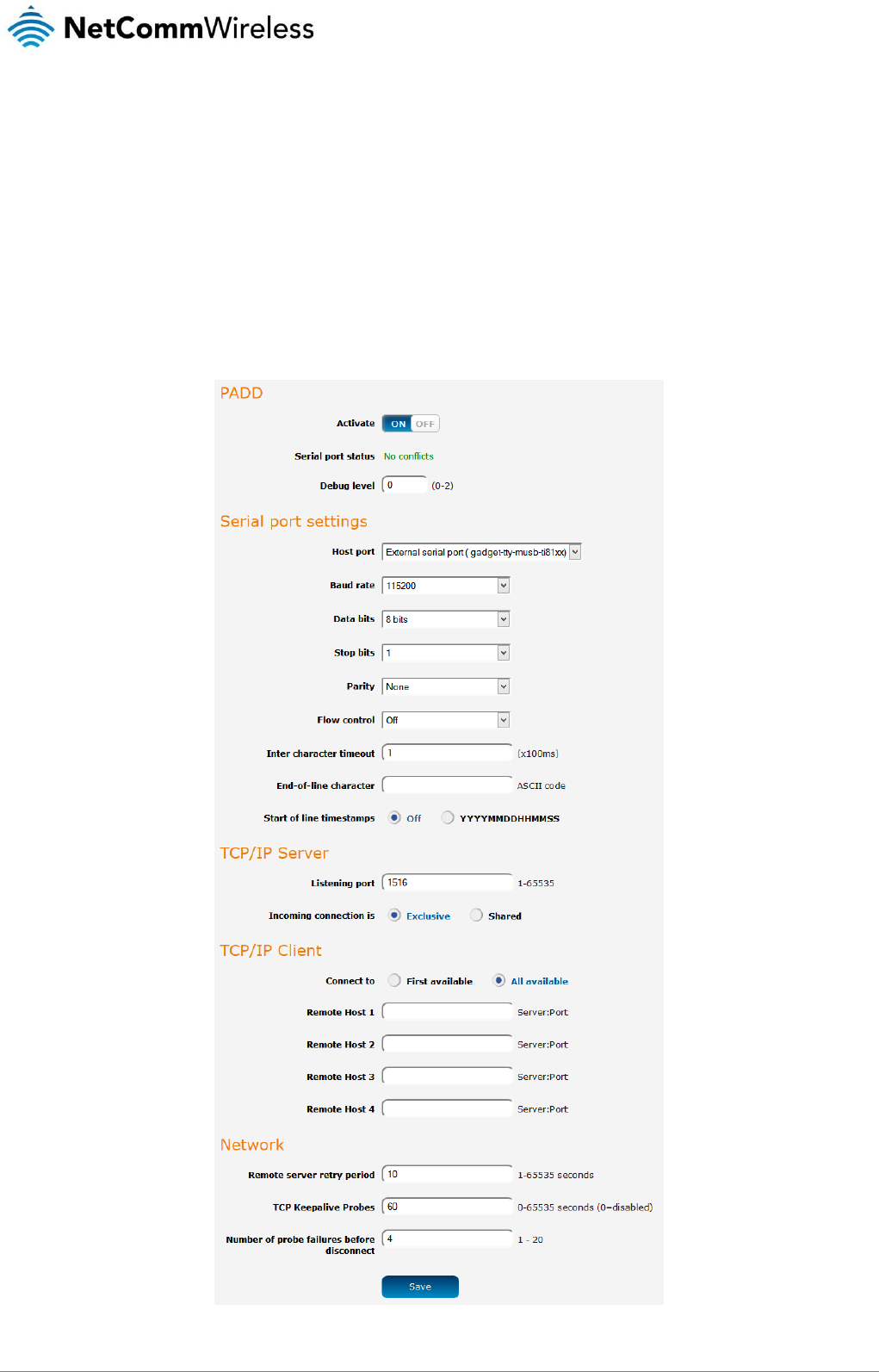
78
NetComm Wireless 4G M2M Router
www.netcommwireless.com
v1.0
PADD
PAD Daemon is a tool used to encapsulate raw serial data into a TCP packet to be transported over IP to another end point. The
server receiving the TCP packets unpacks the data and the original raw serial data is passed out of its serial port to the attached
device, thereby creating an invisible IP network to the two serial devices.
The PAD Daemon runs as a background process which can be accessed via the web configuration interface. The PADD
configuration page is located under “Services > PADD”. The PADD is used usually with multiple connections or when redundant
connections are needed. The PADD has two modes: the PADD TCP/IP Server mode and PADD TCP/IP Client Mode. When PADD
is enabled, both the PADD server mode and PADD client mode can be run at the same time.
To access the PADD configuration page, click on the Services menu at the top of the screen then click on the PADD menu item on
the left.
Figure 91 - PADD
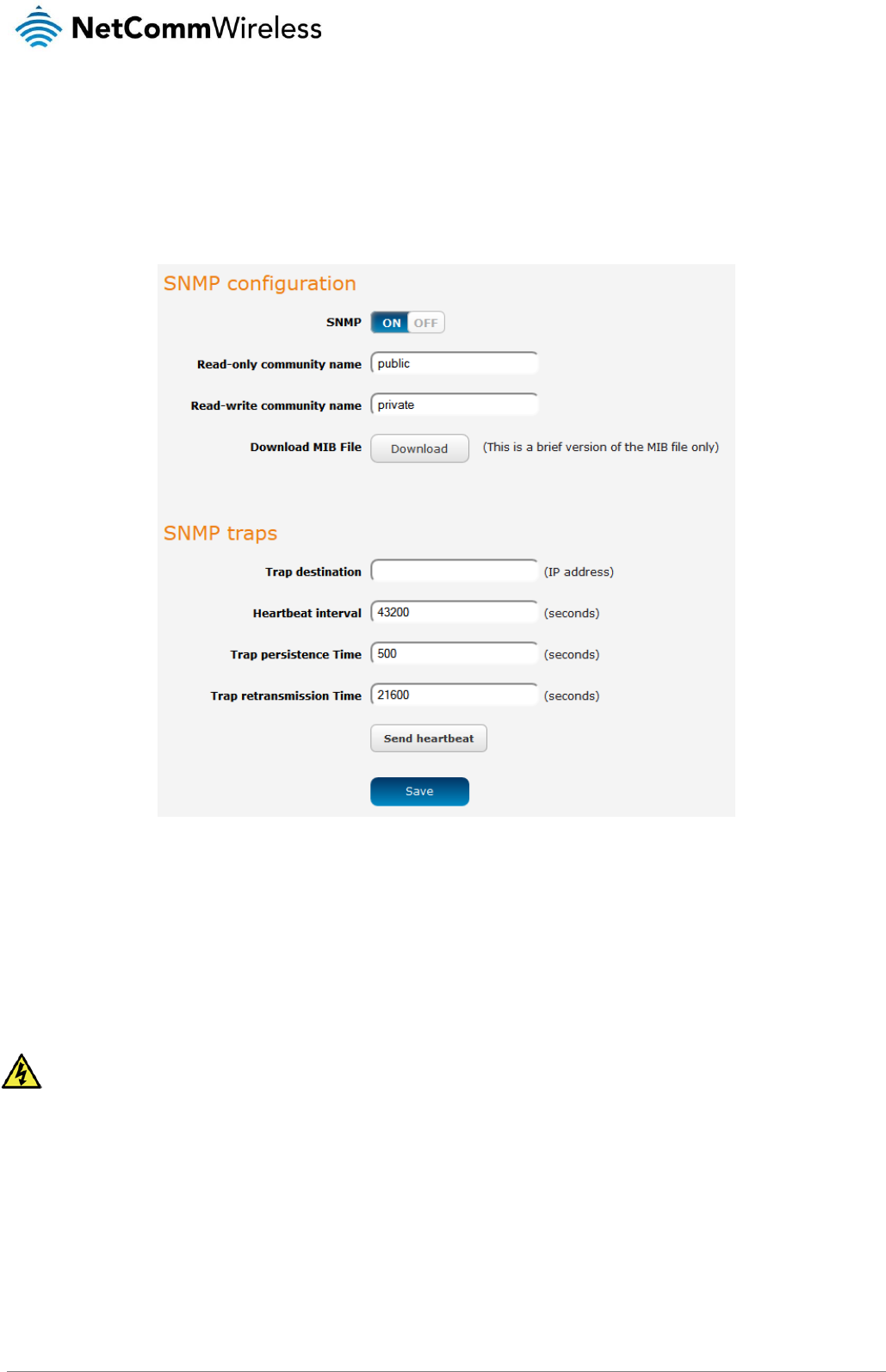
www.netcommwireless.com
NetComm Wireless 4G M2M Router
79
v1.0
Remote management
SNMP
SNMP configuration
The SNMP page is used to configure the SNMP features of the router. To access the SNMP configuration page, click on the
Services menu at the top of the screen then click on the SNMP menu item on the left.
Figure 92 - SNMP configuration
SNMP (Simple Network Management Protocol) is used to remotely monitor the router for conditions that may warrant administrative
attention. It can be used to retrieve information from the router such as the signal strength, the system time and the interface status.
To configure SNMP:
1. Click the SNMP toggle key to switch it to the ON position.
2. Enter Read-only community name and Read-write community name which are used for client authentication.
Community names are used as a type of security to prevent access to reading and/or writing to the routers configuration. It
is recommended that you change the Community names to something other than the default settings when using this
feature.
3. Click the Save button to save any changes to the settings.
The Download button displays the Management Information Base (MIB) of the router. The MIB displays all the objects of the router
that can have their values set or report their status. The MIB is formatted in the SNMP-related standard RFC1155.
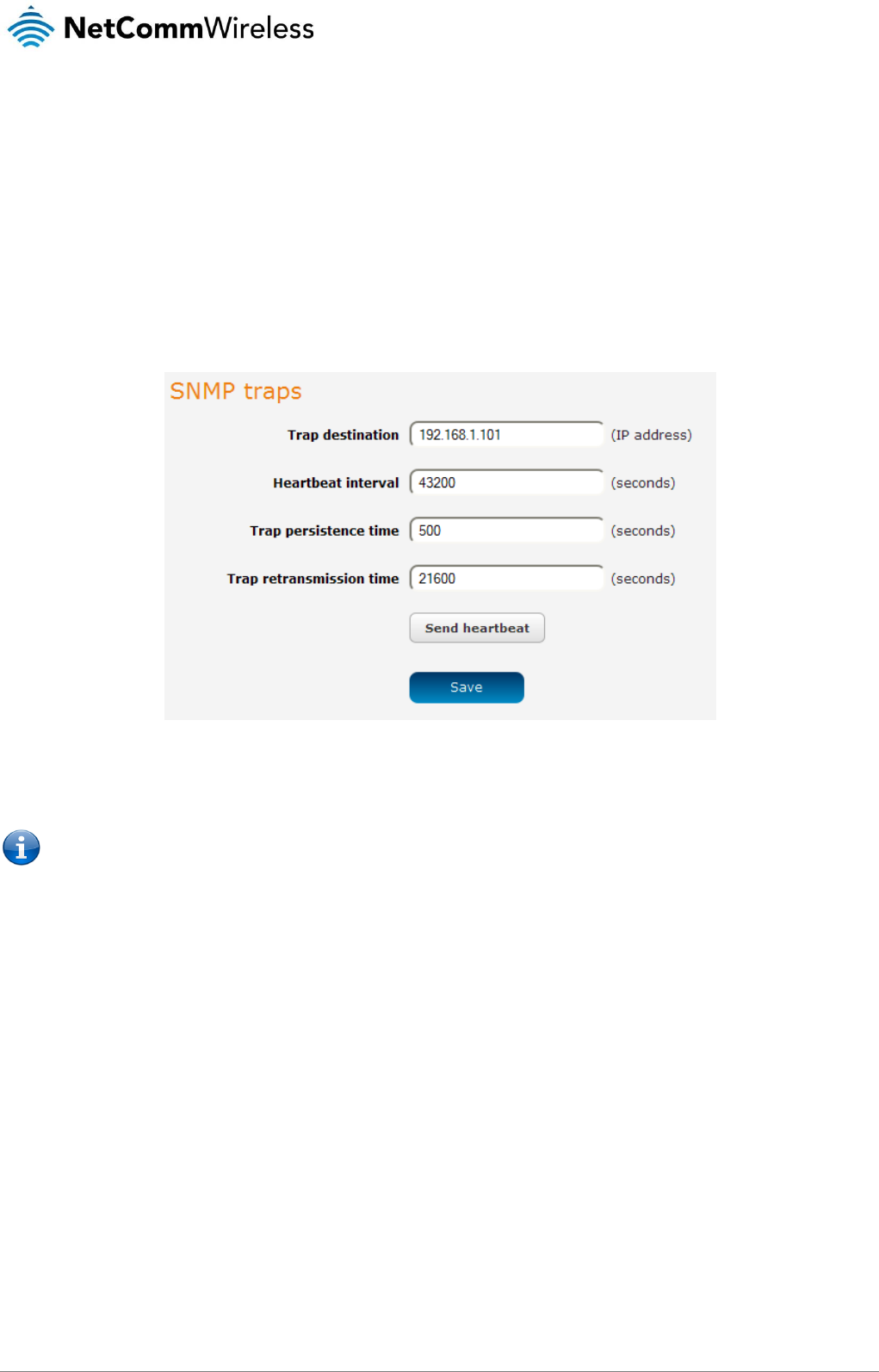
80
NetComm Wireless 4G M2M Router
www.netcommwireless.com
v1.0
SNMP traps
SNMP traps are messages from the router to the Network Management System sent as UDP packets. They are often used to notify
the management system of any significant events such as whether the link is up or down.
Configuring SNMP traps
To configure SNMP traps:
1. In the Trap destination field, enter the IP address to which SNMP data is to be sent.
2. In the Heartbeat interval field, enter the number of seconds between SNMP heartbeats.
3. Use the Trap persistence field to specify the time in seconds that an SNMP trap persists.
4. Use the Trap retransmission time to specify the length of time in seconds between SNMP trap retransmissions.
Figure 93 - SNMP traps
To send a manual SNMP Heartbeat, click the Send heartbeat button. When you have finished configuring the SNMP traps, click the
Save button to save the settings.
Note: When a factory reset is performed via SNMP, the SNMP settings are preserved.
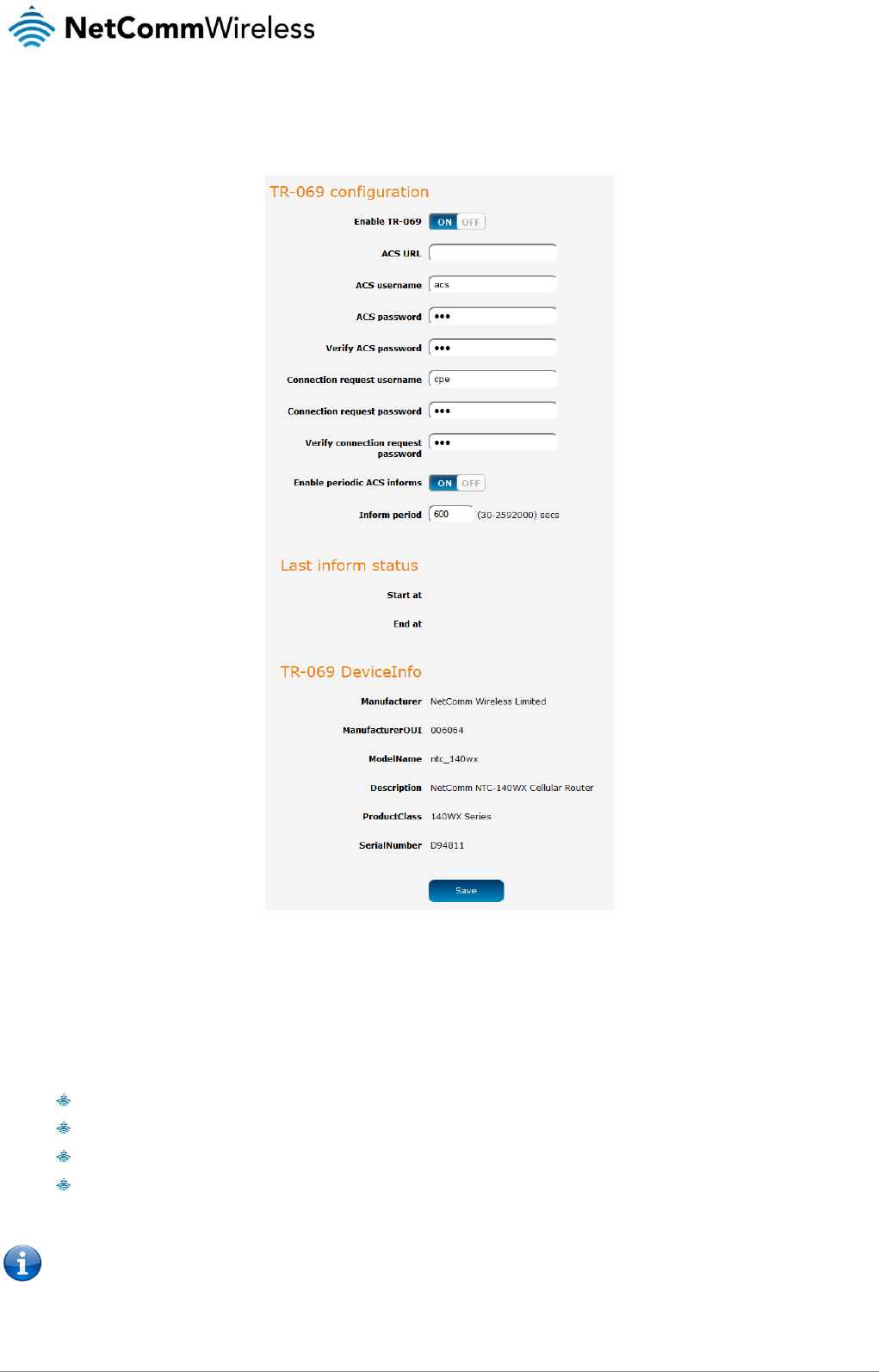
www.netcommwireless.com
NetComm Wireless 4G M2M Router
81
v1.0
TR-069
To access the TR-069 configuration page, click the Services menu item, then select the TR-069 menu item on the left.
Figure 94 - TR-069 configuration
The TR-069 (Technical Report 069) protocol is a technical specification also known as CPE WAN Management Protocol (CWMP). It
is a framework for remote management and auto-configuration of end-user devices such as customer-premises equipment (CPE)
and Auto Configuration Servers (ACS). It is particularly efficient in applying configuration updates across networks to multiple CPEs.
TR-069 uses a bi-directional SOAP/HTTP-based protocol based on the application layer protocol and provides several benefits for
the maintenance of a field of CPEs:
Simplifies the initial configuration of a device during installation
Enables easy restoration of service after a factory reset or replacement of a faulty device
Firmware and software version management
Diagnostics and monitoring
Note:
• You must have your own compatible ACS infrastructure to use TR-069. In order to access and configure the TR-
069 settings you must be logged into the router as the root user.
• When a factory reset of the router is performed via TR-069, the TR-069 settings are preserved.

82
NetComm Wireless 4G M2M Router
www.netcommwireless.com
v1.0
The NetComm Wireless router sends “inform” messages periodically to alert the ACS server that it is ready. These inform messages
can also be configured to accept a connection request from the ACS server. When a connection is established, any tasks queued
on the ACS server are executed. These tasks may be value retrieval or changes and firmware upgrades.
TR-069 configuration
To configure TR-069:
1. Click the Enable TR-069 toggle key to switch it to the ON position.
2. In the ACS URL field, enter the Auto Configuration Server’s full domain name or IP address.
3. Use the ACS username field to specify the username used by the server to authenticate the CPE when it sends an
“inform” message.
4. In the ACS password and Verify ACS password fields, enter the password used by the server to authenticate the CPE
when it sends an “inform” message.
5. In the Connection Request Username field, enter the username that the CPE uses to authenticate the Auto Configuration
Server during a connection request to the CPE.
6. In the Connection Request Password and Verify password fields, enter the password that the CPE uses to authenticate
the Auto Configuration Server during a connection request to the CPE.
7. The inform message acts as a beacon to inform the ACS of the existence of the router. Click the Enable periodic ACS
informs toggle key to turn on the periodic ACS inform messages.
8. In the Inform Period field, enter the number of seconds between the inform messages.
9. Click the Save button to save the settings.
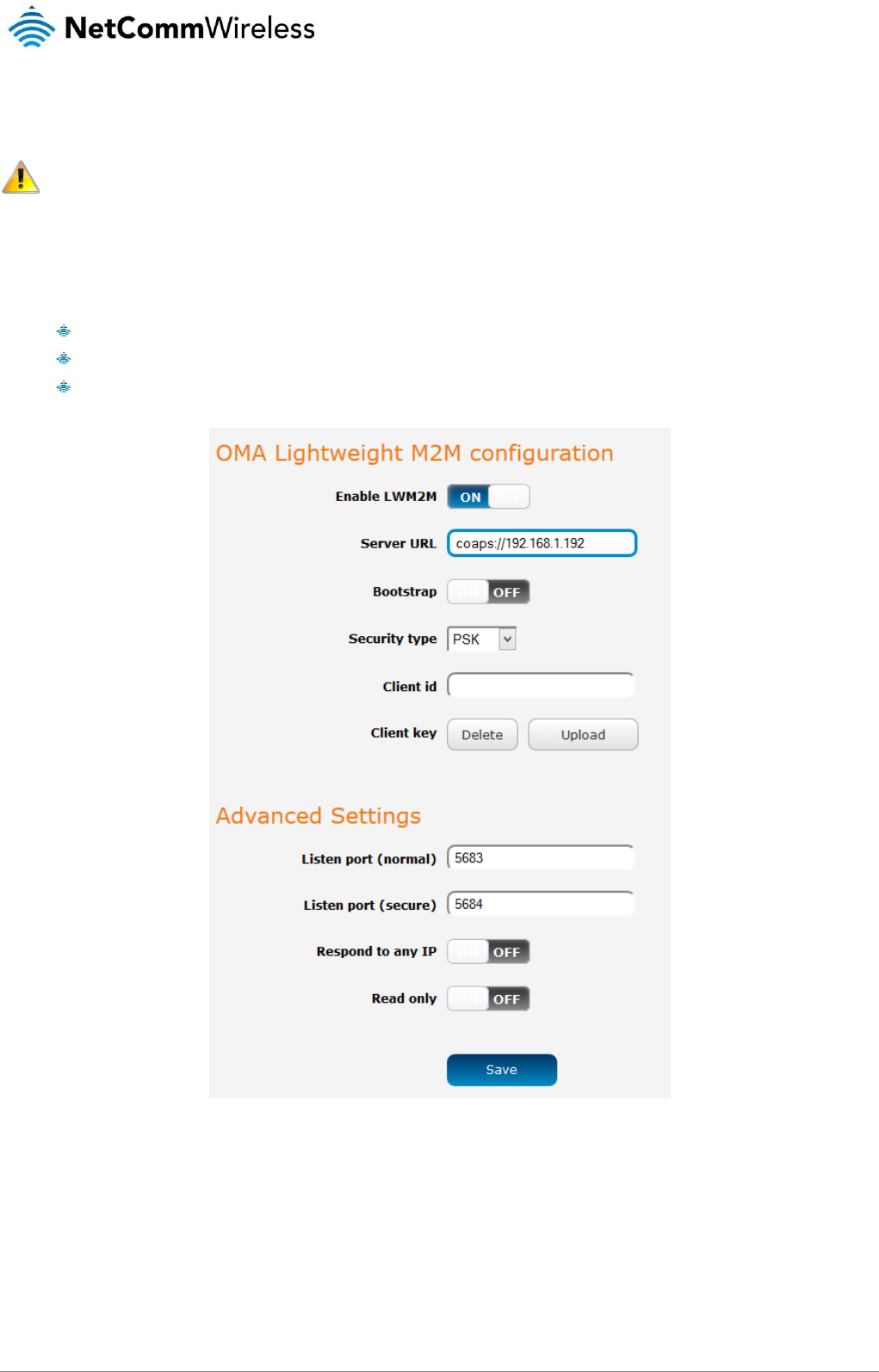
www.netcommwireless.com
NetComm Wireless 4G M2M Router
83
v1.0
OMA Lightweight M2M configuration
Note: The OMA Lightweight M2M specification has not yet been finalised. As such, the current implementation of OMA-
LWM2M is experimental and should not be deployed for regular use. We also do not recommend using OMA-LWM2M
while the router is connected to an APN providing a publicly routable IP address.
The OMA Lightweight M2M (OMA-LWM2M) protocol was designed by the Open Mobile Alliance to provide remote device
management specifically for M2M devices. It is less taxing on the system and network than OMA-DM and TR-069. OMA-LWM2M
runs over UDP and supports asynchronous notifications when a resource changes.
It provides:
Firmware upgrades
Device monitoring and configuration
Server provisioning
Figure 95 - OMA Lightweight M2M configuration
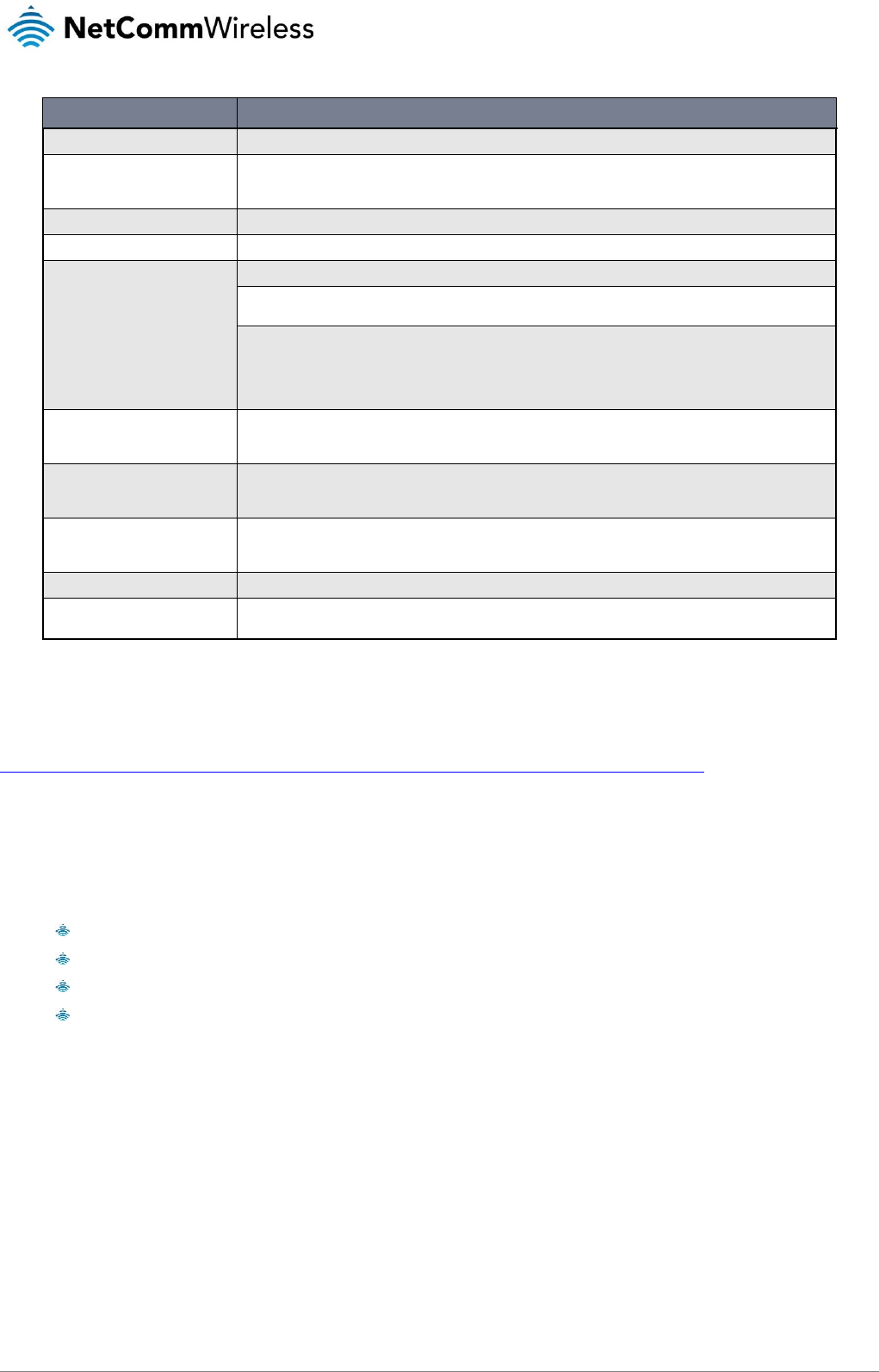
84
NetComm Wireless 4G M2M Router
www.netcommwireless.com
v1.0
ITEM
DESCRIPTION
Enable LWM2M
Toggles the OMA-LWM2M function on and off.
Server URL
The URL of the LWM2M server. This must begin with coap:// or coaps:// and include the server port number.
The correct syntax for this field is coap://
<server IP or domain name>
:
<port number>.
The Server URL field
performs validation on the entered address so the field must contain an address in the correct format.
Listen port (normal)
The port that the router listens on for LWM2M.
Listen port (secure)
When using DTLS (coaps), enter the port that the router listens on for secure connections.
Security type (only used when
Server URL starts with coaps://)
NoSec – When selected, this uses DTLS with the NULL cipher, therefore, it provides no security.
PSK – Pre-shared key mode. Keys are typically a string of text saved into a text file. We recommend creating a
key at least 32 bytes in size to enhance your security.
RPK – Raw Public Key. The key is an EC key in DER format. It must contain both public and private keys. When
RPK is selected, the Client ID field is not used. You can generate a raw public key using commands such as:
openssl ecparam -out 256.key -name secp256r1 –genkey
openssl ec -in 256.key -outform der -out 256.der
Client id (only used when Server
URL starts with coaps:// and
Security type is PSK)
When server is a coaps:// address and security type is set to PSK, the Client id acts as a means of identifying
the client, similar to a username.
Client key (only used when Server
URL starts with coaps:// and
Security type is PSK or RPK)
This field is used to upload the key file used when security type is set to PSK, delete the uploaded key file or
show the currently stored key.
Respond to any IP
When turned on, this feature adds a firewall rule that allows the router to respond to any IP address on the
designated port. This eases the restrictions that requests must come from servers the client is currently
registered with. We recommend that this feature is turned off for normal use.
Bootstrap
When set to the ON position, this specifies that the Server URL field points to a bootstrap server.
Read only
When set to the ON position, this allows read only access to all LWM2M settings. Writing new values and
executing commands are not permitted. When set to OFF, values may be read, written and executed.
Table 23 – OMA Lightweight M2M configuration options
Supported objects
The objects and instances used by NetComm Wireless routers are all part of the Open Mobile Alliance and IPSO Alliance approved
list. At this time, there are no NetComm-specific objects or instances. For more information on the Lightweight M2M specifications,
please visit the Open Mobile Alliance Specifications for Public Comment website:
http://technical.openmobilealliance.org/Technical/technical-information/specifications-for-public-comment
Timeouts
Most mobile networks use stateful firewalls or NAT where the timeout for UDP is approximately 1-2 minutes. If this applies to you,
configure your server to change the 'lifetime' (resource 1/0/1) to be shorter than the default 86400. We suggest setting it to 60.
Supported ciphers
TLS_PSK_WITH_AES_128_CBC_SHA256
TLS_ECDHE_ECDSA_WITH_AES_128_CBC_SHA256
NULL (only if "NoSec" explicitly selected)
Others may be negotiated by OpenSSL during connection
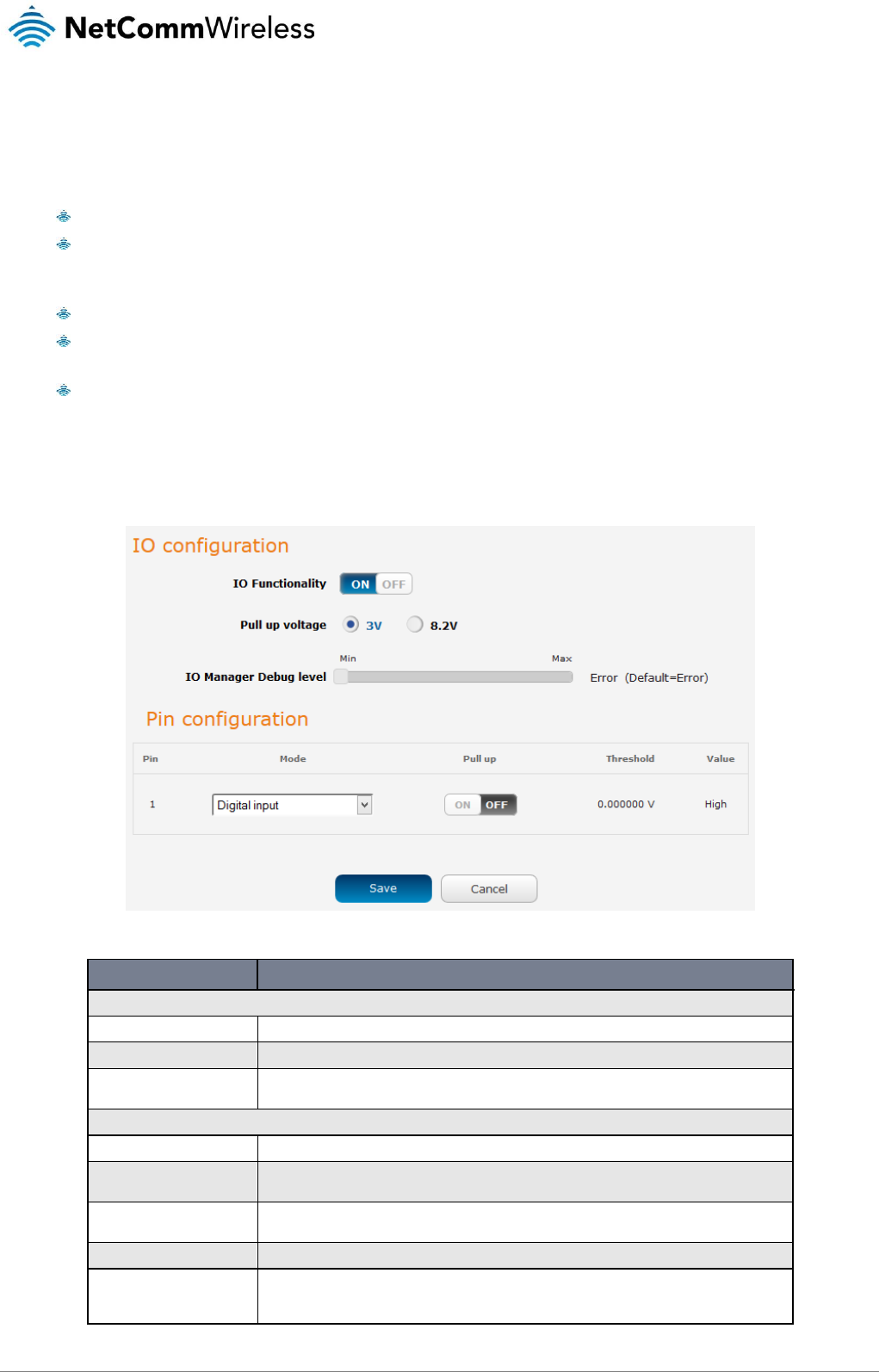
www.netcommwireless.com
NetComm Wireless 4G M2M Router
85
v1.0
IO configuration
The NTC-140-01 Router is equipped with a 2 x 2 Molex connector providing Power (+), Ground (−), a multipurpose input and
output pin and an ignition detection input. The multipurpose input/output pin may be independently configured for various functions,
including:
NAMUR (EN 60947-5-6 / IEC 60947-5-6) compatible proximity sensor input
Proximity sensor input for use with contact closure (open/closed) type of sensors (PIR sensors, door/window sensors
for security applications) with the input tamper detection possible (four states detected: open, closed, short and break)
by the use of external resistors
Analogue 0V to 30V input
Digital input (the I/O voltage measured by the Analogue input and the software making decision about the input state)
with the threshold levels configurable in software
Open collector output.
Use the pull up voltage options to select the desired output voltage of the I/O pins. The pull up voltage you select will be the same
for each pin when pull up is enabled for that pin. Each pin is capable of outputting either 3.3V or 8.2V.
To access the IO configuration page, click the Services menu item, then select the IO configuration menu item on the left.
Figure 96 – IO configuration options
ITEM
DESCRIPTION
IO configuration
IO Functionality
Enables the configuration of the input and output pins on the 2x2 Molex connector.
Pull up voltage
Specifies the output voltage of the I/O pins.
IO Manager Debug level
Use the slide bar to adjust the level of detail you would like to see in the log for IO messages. A
higher debug level displays more detailed messages in the log file.
Per pin configuration
Pin
The I/O pin number corresponding to the pin on the Molex connector that you wish to configure.
Mode
The mode of operation for the corresponding pin. Available options are Digital input, Digital output,
Analogue input, Namur input, Contact closure input.
Pull up
Use the pull up toggle keys to turn the pull up on or off for the corresponding pin. When turned on,
the pull up voltage output is the value specified in the “Pull up voltage” option.
Threshold
Displays the current voltage threshold configured for the I/O pin.
Value
The value column displays whether the voltage detected on the line is low or high or allows you to
configure the output value in the case that the pin is set to digital output. This can be useful for
applications where monitoring of the transition between low and high is used to trigger an action.
Table 24 - IO configuration options
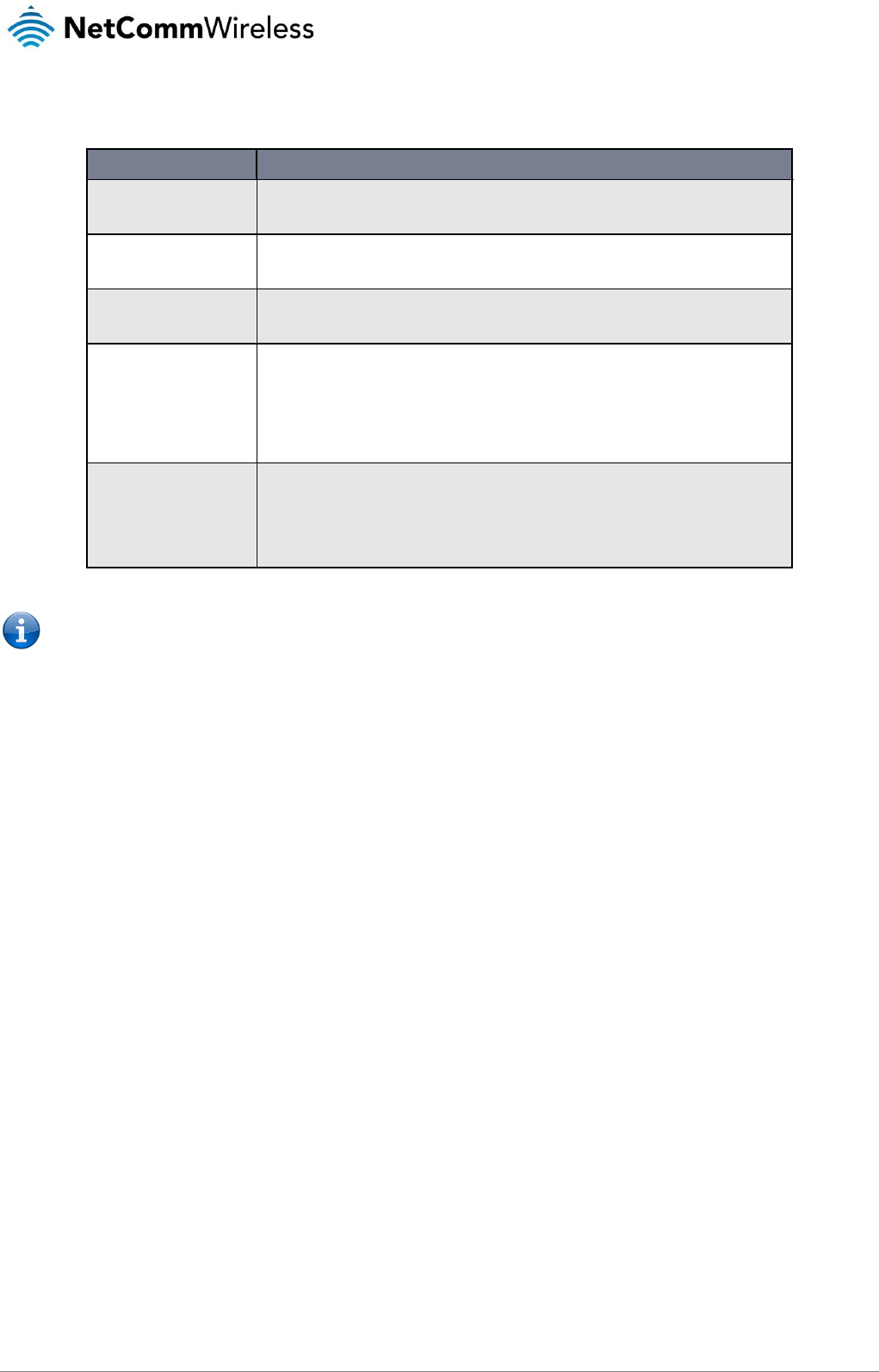
86
NetComm Wireless 4G M2M Router
www.netcommwireless.com
v1.0
The table below describes the different modes available on the physical I/O pins of the router.
MODE
DESCRIPTION
Digital input
The corresponding pin accepts digital input. Pull up may be on or off and both 3.3V and 8.2V are
available as pull up voltages. The value column displays whether the signal received on the pin is
High or Low.
Digital output
The corresponding pin outputs a digital signal. Pull up may be on or off and both 3.3V and 8.2V are
available as pull up voltages. The value column contains a toggle key allowing you to set whether
the output signal is High or Low.
Analogue input
The corresponding pin accepts an analogue signal. Pull up may be on or off and both 3.3V and
8.2V are available as pull up voltages. The value column displays the current voltage detected on
the pin.
Namur input
NAMUR is a sensor standard using low-level current signals. It can supply two different signal levels
depending on the state of the switch and is commonly used in hazardous or explosive locations
where compact sensors are required.
When a pin is set to NAMUR mode, Pull up is turned on and the global Pull up voltage is set to
8.2V. These settings may not be changed for as long as a pin is set to NAMUR mode as they are
required settings according to the NAMUR IEC 60947-5-6 standard. The value column displays
whether the signal received on the pin is High or Low.
Contact closure input
A common type of digital input where a sensor or switch opens or closes a set of contacts as a
result of a process change. An electrical signal is then used to determine whether the circuit is open
or closed.
When a pin is set to Contact closure input, Pull up is enabled for that pin and may not be turned off
as long as the pin remains configured as a Contact closure input. Global pull up voltage may be
either 3.3V or 8.2V.
Table 25 - IO pin modes
Note: Please refer to the SDK Developer Guide for hardware information about the Input/Output pins, wiring examples and
configuration of the pins via the command line interface. There are also wiring examples in Appendix G of this User Guide.
Contact NetComm Wireless Technical Support for access to the Software Development Kit.
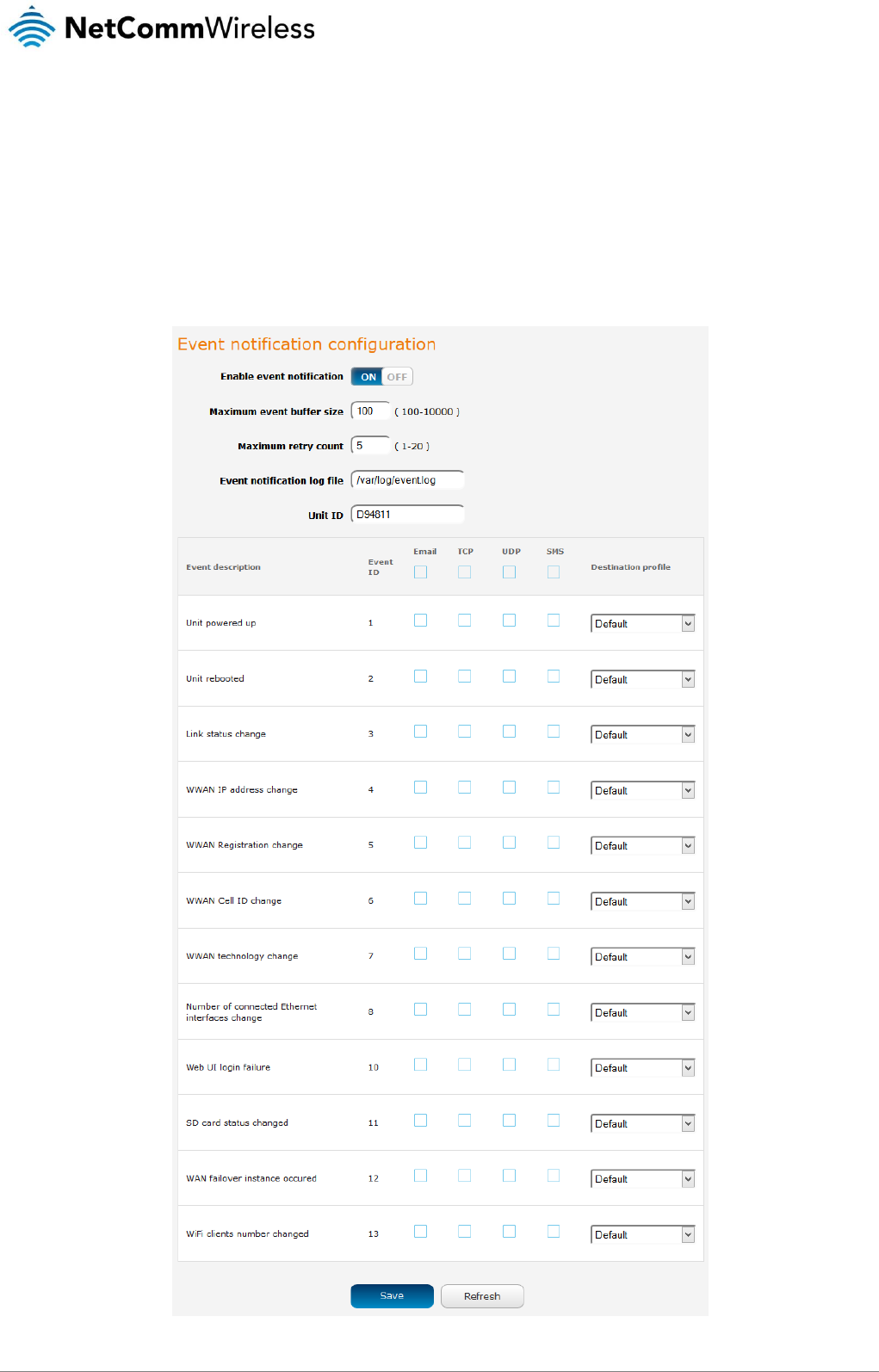
www.netcommwireless.com
NetComm Wireless 4G M2M Router
87
v1.0
Event notification
The event notification feature is an advanced remote monitoring tool providing you with the ability to send alerts via SMS, e-mail,
TCP or UDP when pre-defined system events occur.
Notification configuration
The Notification configuration screen is used to select the event types, methods of notification and the destinations for the
notifications. Up to four types of alerts for a particular event may be sent to a single destination profile containing the contact details.
To access the Event notification configuration page, click the Services menu item, select the Event configuration menu item on the
left, then select the Notification configuration menu item.
Figure
97
- Event notification configuration
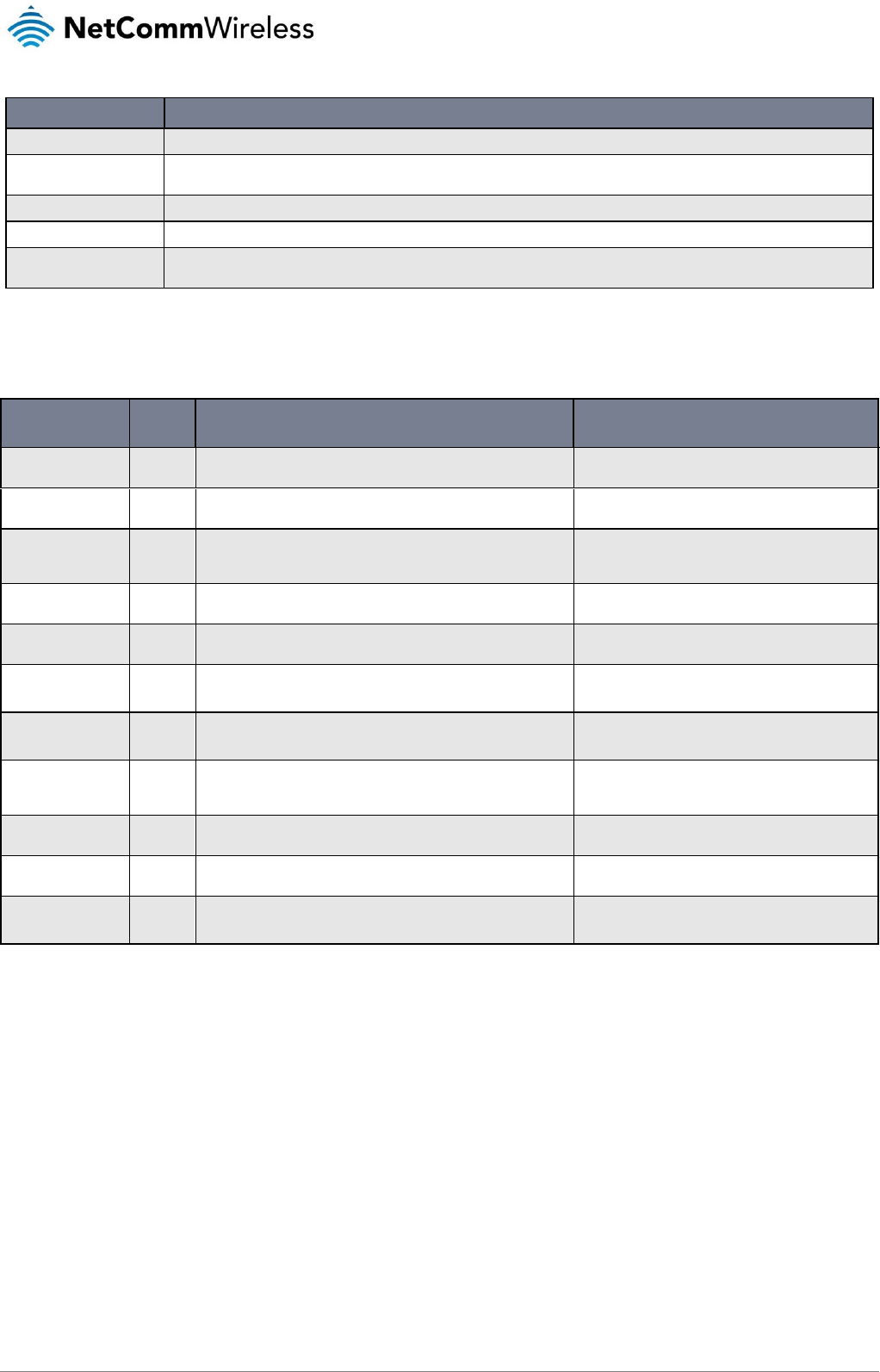
88
NetComm Wireless 4G M2M Router
www.netcommwireless.com
v1.0
ITEM
DESCRIPTION
Enable event notification
Toggles the event notification feature on and off.
Maximum event buffer size
Specifies the buffer size for event notifications which failed to be delivered or are yet to be sent. The minimum size is 100 and the
maximum is 10000.
Maximum retry count
Specifies the maximum number of attempts that the router will make to deliver an event notification. The range is between 1 and 20.
Event notification log file
Specifies to the location and name of the file used to log the event notification activity.
Event notification prefix
The Unit ID field is used to specify an identifier for the router which are sent in the event notifications so that you know which router
has an event.
Table 26 - Event notification configuration options
Event types
There are ten events for which you can configure alerts. Hovering the mouse over the event description provides more details of
event notification type.
EVENT
EVENT
ID
DESCRIPTION
EXAMPLE MESSAGE
Unit powered up
1
Notification is sent when the unit is powered up through connection
of a power source or after a soft-reset.
Power is up
Unit rebooted
2
Notification is sent when the unit is rebooted via Web UI, SMS
diagnostics or via command line/telnet session.
Rebooting triggerred by internal application
Link status change
3
Notification is sent if the status of the data connection profile or any
IPSec/OpenVPN/PPTP/GRE tunnel endpoint changes i.e. the link
goes up or down.
Profile 1 WWAN status changed : down --> up
WWAN IP address
change
4
Notification is sent if an active data connection profile’s WWAN IP
address changes.
WWAN IP address changed : N/A --> 10.103.4.149
WWAN Registration
change
5
Notification is sent if the network registration status changed
between “registered”, “unregistered” or “roaming”.
WWAN registration status changed : Not registered -->
Registered to home network
WWAN Cell ID
change
6
Notification is sent if the router connects to a different cell, marked by
a changed in the Cell ID.
Cell ID changed : --> 15224145
Cell ID changed : 15224148 --> 15224145
WWAN technology
change
7
Notification is sent if the router connects to a different network
technology, e.g. 3G/2G.
WWAN network changed : N/A() --> 3G(UMTS)
WWAN network changed : 3G(UMTS) --> 2G(GSM)
Number of
connected Ethernet
interfaces change
8
Notification is sent if there is a change to the number of directly
connected Ethernet interfaces.
Ethernet device number changed : 0 --> 1
Web UI login failure
10
Notification is sent if there was a failure to log in to the router via the
Web UI.
WEBUI login failed, username root, password
SD card status
changed
11
Notification is sent if the status of the SD card changes, i.e. a card is
removed or inserted.
SD card status changed: removed --> inserted
WAN failover
instance occurred
12
Notification is sent if a failover between WAN interfaces occurs.
Failover instance occured: N/A --> wwan.0
Failover instance occured: eth.0 --> wwan.0
Table 27 - Event notification – event types
Destinations
A “destination” is a profile on the router containing the contact details of a recipient of event notification alerts i.e. the e-mail
address, SMS number, TCP or UDP server addresses of the recipient. The destination profile must contain the details of at least
one destination type in order to be used.
Configuring Event notification
To configure the event notification feature:
1. Click the Services menu item at the top of the screen. From the Event notification menu on the left of the screen, select the
Destination configuration menu item.
2. Click the +Add button at the top right corner of the window. The Event destination edit screen is displayed.
3. In the Destination name field enter a name for the destination profile then enter the contact details for the each type of
destination i.e. Email address, TCP address and port, UDP address and port and/or SMS number.
4. Click the Save button when you have entered the required details.
5. From the Event notification menu on the left of the screen, select the Notification configuration menu item.
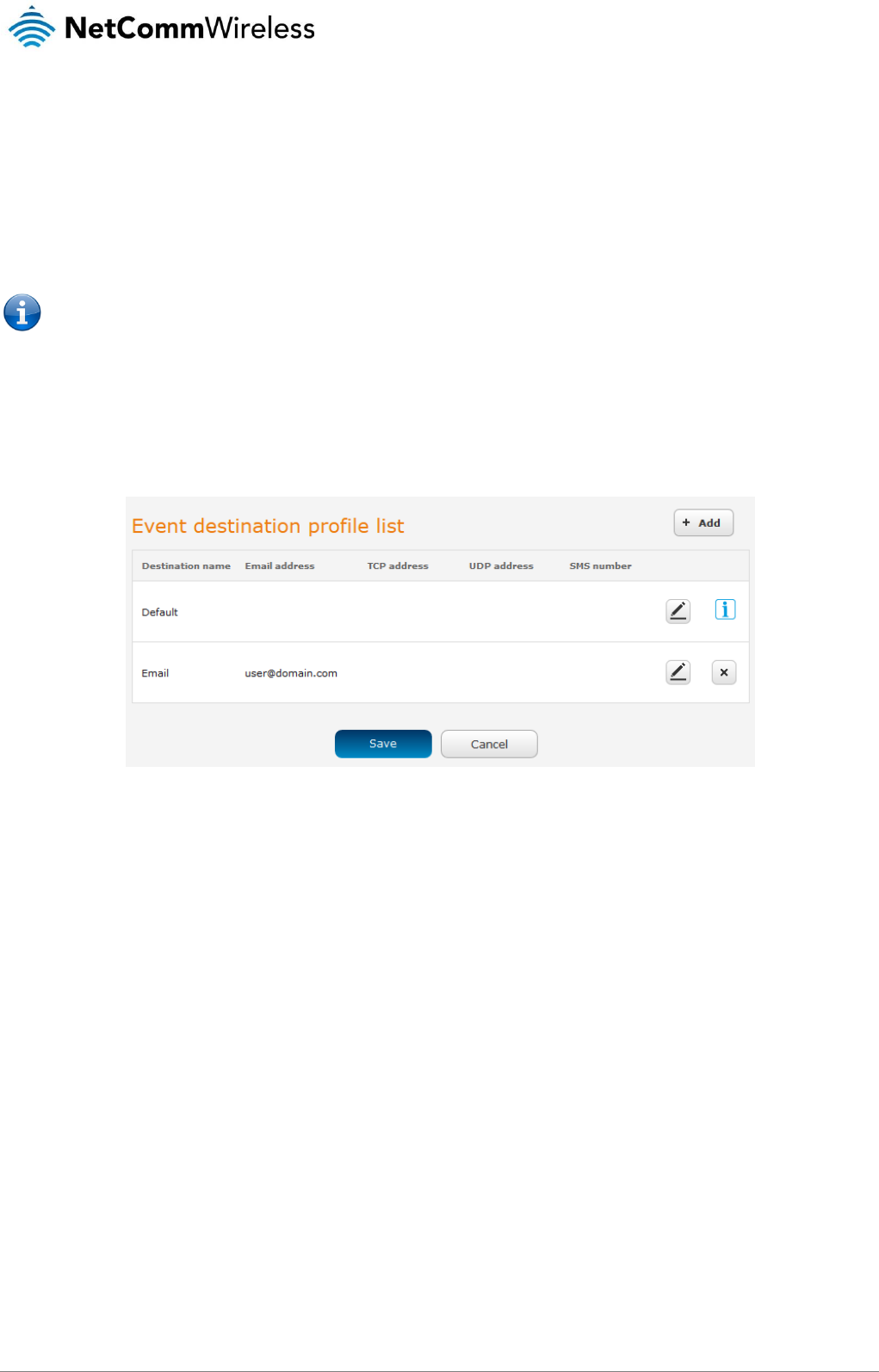
www.netcommwireless.com
NetComm Wireless 4G M2M Router
89
v1.0
6. Select the Enable event notification toggle key to turn it to the ON position.
7. If desired, set the Maximum event buffer size, Maximum retry count, Event notification log file and Event notification prefix
fields. See table 23 for descriptions of these options.
8. From the Destination column, use the drop down menus to select the desired destination profiles to use for the
corresponding events, then select the checkboxes for the types of notifications to send to the chosen destination profile. If
the Destination profile does not contain the required contact details, a pop-up warns you to enter the required details in
the Destination profile.
9. Click the Save button.
Note: If you have selected the Email notification type for any of the events, you must also configure Email client settings to
allow the router to send e-mail messages.
Destination configuration
The Destination configuration screen displays a list of the destination “profiles” that have been configured on the device as well as
providing the option to add new profiles.
Figure 98 - Event destination list
To add a new destination profile:
1. Click the +Add button at the top right corner of the window. The Event destination edit screen is displayed.
2. In the Destination name field enter a name for the destination profile then enter the contact details for the each type of
destination i.e. Email address, TCP address and port, UDP address and port and/or SMS number.
3. Click the Save button when you have entered the required details.
To edit a destination profile:
1. From the Event destination list, click the edit button for the corresponding destination profile. The Event destination edit
page is displayed. Make the required changes.
2. Click the Save button.
To delete a destination profile:
1. From the Event destination list, select the delete button for the corresponding destination profile that you would like to
delete. If the destination profile is linked to an event notification type, the i button is displayed instead of the delete button.
In this case, you must go to the Notification configuration screen and remove the check marks from all the notification
types for each event for which the destination profile is configured. When you have done that, return to the Event
destination list and select the delete button.
2. Click the Save button.
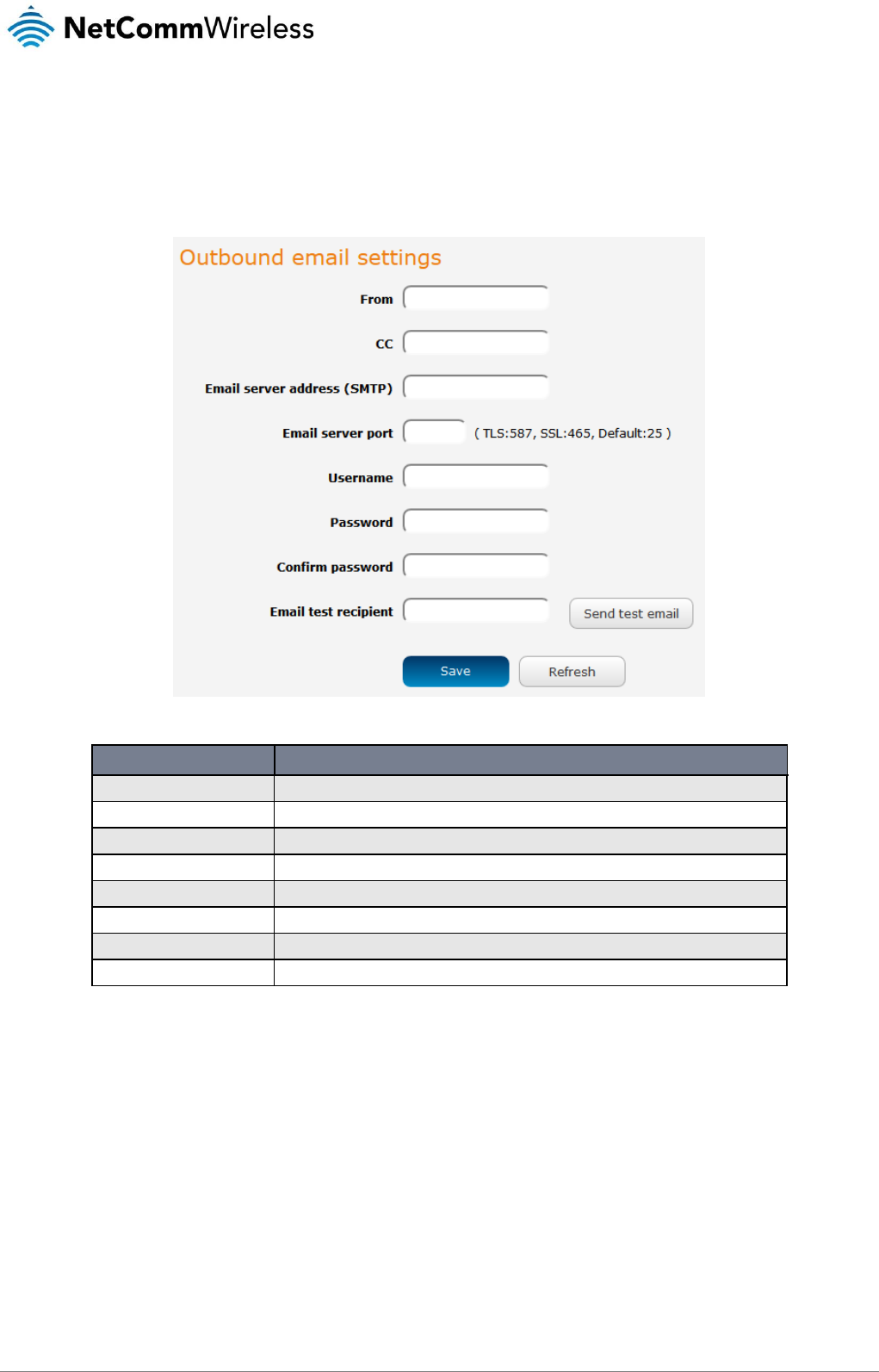
90
NetComm Wireless 4G M2M Router
www.netcommwireless.com
v1.0
Email settings
The Email settings screen allows the configuration of the email account that is used to send emails in features such as Event
notification.
To access the Email settings page, click the Services menu item then select the Email settings menu item on the left.
Figure 99 - Email client settings
ITEM
DESCRIPTION
From
Enter the email address of the account you will be using to send emails.
CC
(Optional) Enter an email address which will be copied on all messages sent.
Email server address (SMTP)
Enter the SMTP server address of the email server. This may be an IP address or a hostname.
Email server port
Enter the Email server’s SMTP port.
Username
Enter the username of the account to be used for sending emails.
Password
Enter the password of the account to be used for sending emails.
Confirm password
Enter the password of the account to be used for sending emails once more for confirmation.
Email test recipient
Enter an email address to send a test message to, then click the Send test email button.
Table 28 - Email client settings
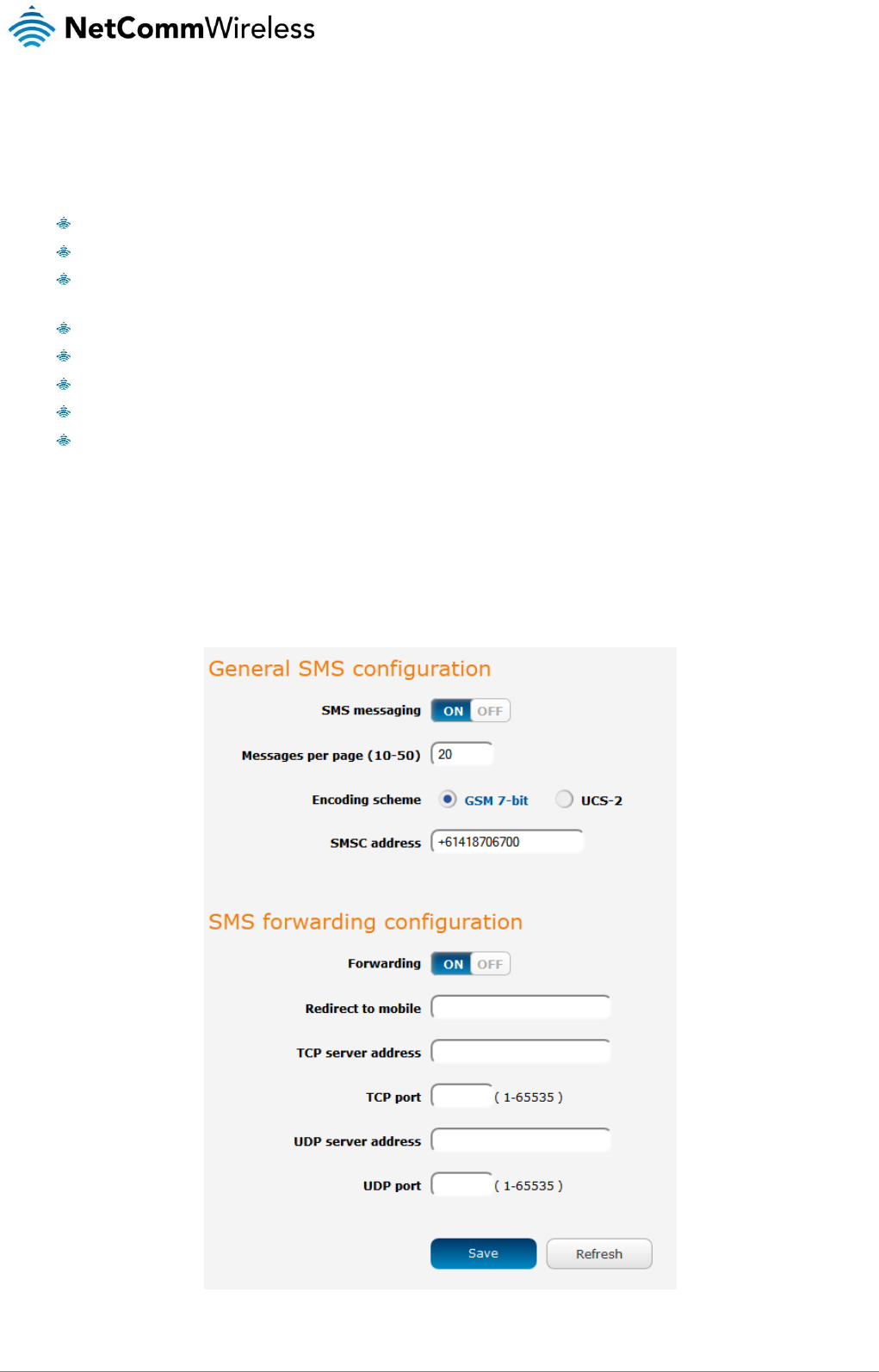
www.netcommwireless.com
NetComm Wireless 4G M2M Router
91
v1.0
SMS messaging
The NTC-140-01 router offers an advanced SMS feature set, including sending messages, receiving messages, redirecting
incoming messages to another destination, as well as supporting remote commands and diagnostics messages.
Some of the functions supported include:
Ability to send a text message via a cellular network and store it in permanent storage.
Ability to receive a text message via a cellular network and store it in permanent storage.
Ability to forward incoming text messages via a cellular network to another remote destination which may be a
TCP/UDP server or other mobile devices.
Ability to receive run-time variables from the device (e.g. uptime) on request via SMS
Ability to change live configuration on the device (e.g. network username) via SMS.
Ability to execute supported commands (e.g. reboot) via SMS
Ability to trigger the NTC-140-01 router to download and install a firmware upgrade
Ability to trigger the NTC-140-01 router to download and apply a configuration file
To access the SMS messaging functions of the NTC-140-01 router, click on the Services menu item from the top menu bar, and
then select one of the options under the SMS messaging section on the left hand menu.
Setup
The Setup page provides the options to enable or disable the SMS messaging functionality and SMS forwarding functionalities of
the router. SMS messaging is enabled by default.
Figure 100 - General SMS Configuration

92
NetComm Wireless 4G M2M Router
www.netcommwireless.com
v1.0
OPTION
DEFINITION
General SMS configuration
SMS messaging
Toggles the SMS functionality of the router on and off.
Messages per page (10-50)
The number of SMS messages to display per page. Must be a value between 10 and 50.
Encoding scheme
The encoding method used for outbound SMS messages. GSM 7-bit mode permits up to 160
characters per message but drops to 50 characters if the message includes special characters.
UCS-2 mode allows the sending of Unicode characters and permits a message to be up to 50
characters in length.
SMS forwarding configuration
Forwarding
Toggles the SMS forwarding function of the router on and off.
Redirect to mobile
Enter a mobile number as the destination for forwarded SMS messages.
TCP server address
Enter an IP address or domain name as the destination for forwarded SMS messages using
TCP.
TCP port
The TCP port on which to connect to the remote destination.
UDP server address
Enter an IP address or domain name as the destination for forwarded SMS messages using
UDP.
UDP port
The UDP port on which to connect to the remote destination.
Table 29 - SMS Setup Settings
SMS forwarding configuration
Incoming text messages can be redirected to another mobile device and/or a TCP/UDP message server.
Redirect to mobile
You can forward incoming text messages to a different destination number. This destination number can be another mobile phone
or a router phone number.
For Example:
If someone sends a text message and Redirect to mobile is set to “+61412345678”, the text message is stored on the router and
forwarded to “+61412345678” at the same time.
To disable redirection to a mobile, clear the Redirect to mobile field and click the Save button.
Redirect to TCP / UDP server address
You can also forward incoming text messages to a TCP/UDP based destination. The TCP or UDP server can be any kind of public
or private server if the server accepts incoming text-based messages.
The TCP/UDP address can be an IP address or domain name. The port number range is from 1 to 65535. Please refer to your
TCP/UDP based SMS server configuration for which port to use.
For Example:
If someone sends a text message and TCP server address is set to “192.168.20.3” and TCP port is set to “2002”, this text
message is stored in the router and forwarded to “192.168.20.3” on port “2002” at the same time.
To disable redirection to a TCP or UDP address, clear the TCP server address and UDP server address fields and click the Save
button.
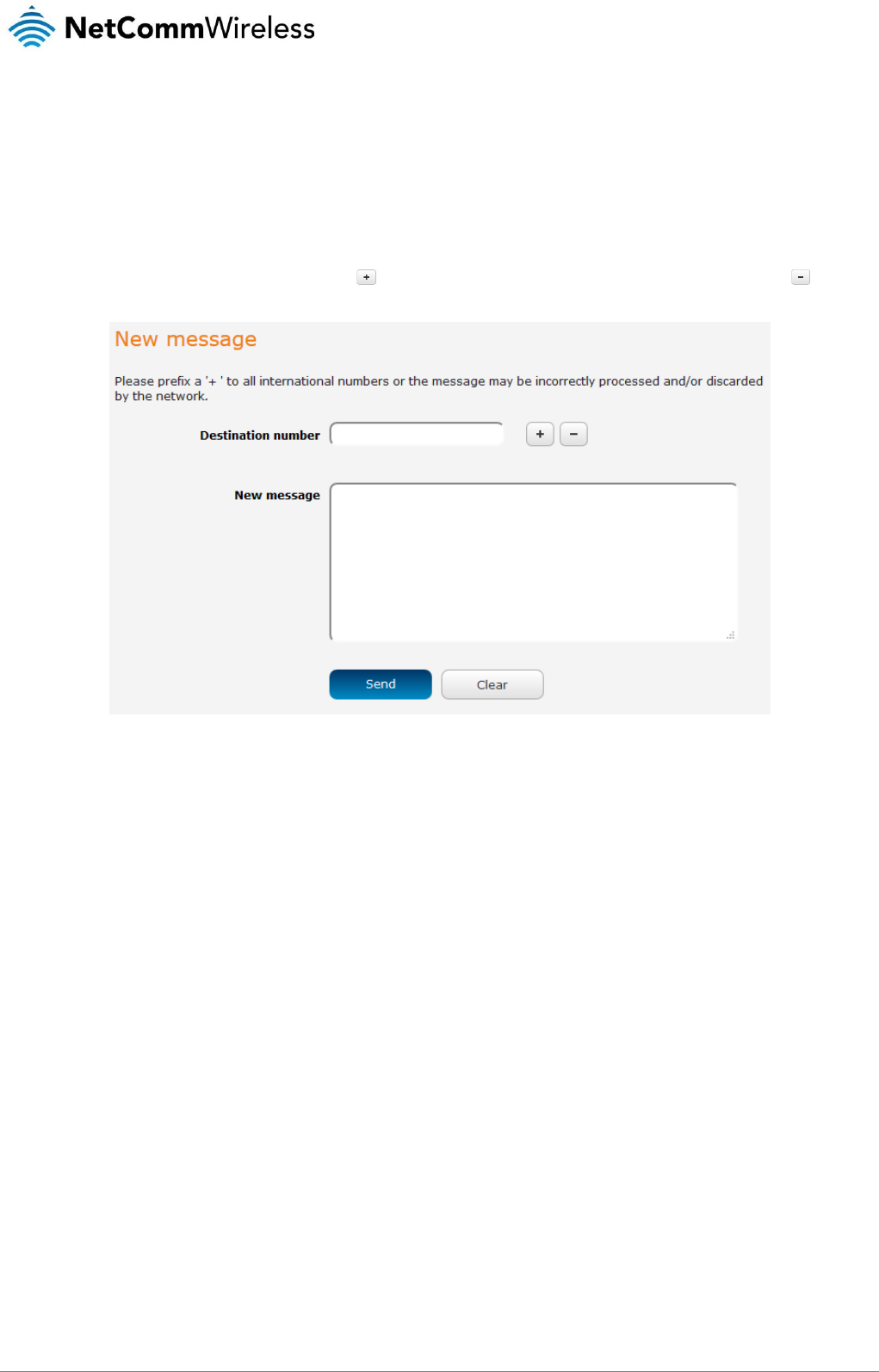
www.netcommwireless.com
NetComm Wireless 4G M2M Router
93
v1.0
New message
The New message page can be used to send SMS text messages to a single or multiple recipients. To access the New message
page, click on the Services menu item from the top menu bar, select the SMS messaging menu on the left then select the New
message menu item.
A new SMS message can be sent to a maximum of 9 recipients at the same time. After sending the message, the result is displayed
next to the destination number as “Success” or “Failure” if the message failed to send. By default, only one destination number field
is displayed. Additional destination numbers may be added one at a time after entering a valid number for the current destination
number field. To add a destination number, click the button and to remove the last destination in the list, click the button.
Figure 101 - SMS - New Message
Destination numbers should begin with the “+” symbol followed by the country calling code. To send a message to a destination
number, enter the “+” symbol followed by the country calling code and then the destination number.
For example:
To send a message to the mobile destination number 0412345678 in Australia (country calling code 61), enter
“+61412345678”.
After entering the required recipient numbers, type your SMS message in the New message field. As you type your message, a
counter shows how many characters you have entered out of the total number available for your chosen encoding scheme. When
you have finished typing your message and you are ready to send it, click the Send button.
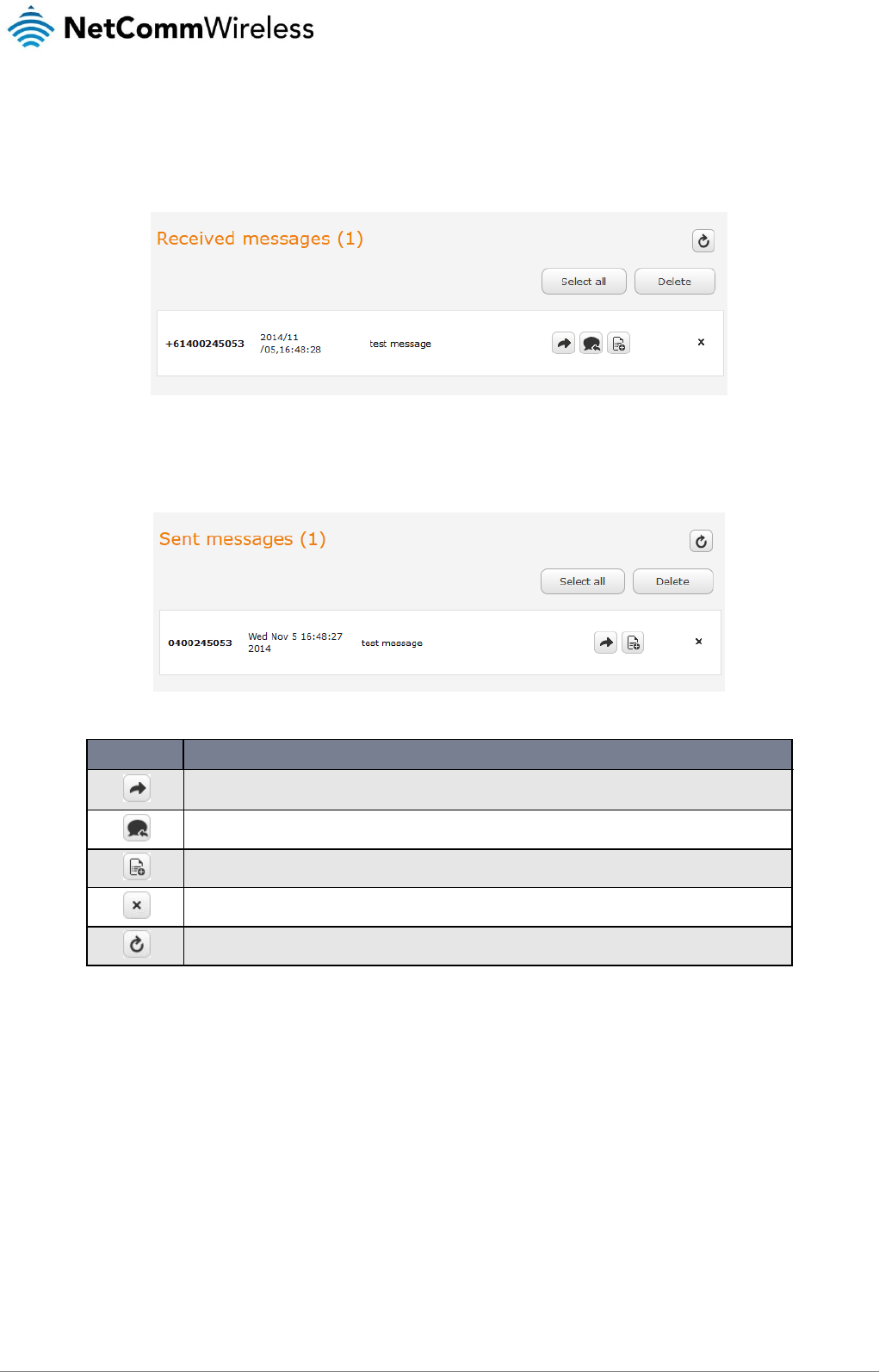
94
NetComm Wireless 4G M2M Router
www.netcommwireless.com
v1.0
Inbox / Sent Items
The Inbox displays all received messages that are stored on the router while Sent Items displays all sent messages. To access the
Inbox page, click on the Services menu item from the top menu bar, select the SMS messaging menu on the left then select the
Inbox menu item.
Figure 102 - SMS Inbox
To access the Sent items page, click on the Services menu item from the top menu bar, select the SMS messaging menu on the
left then select the Sent items menu item.
Figure 103 - SMS Outbox
ICON
DESCRIPTION
Forward button. Click this button to open a new message window where you can forward the corresponding
message to another recipient.
Reply button. Click this button to open a new message window where you can reply to the sender.
Add to White list. Click this button to add the sender’s mobile number to the white list on the router.
Delete button. Click this button to delete the corresponding message.
Refresh button. Click this button to refresh the inbox or outbox to see new messages.
Table 30 - Inbox/Outbox icons
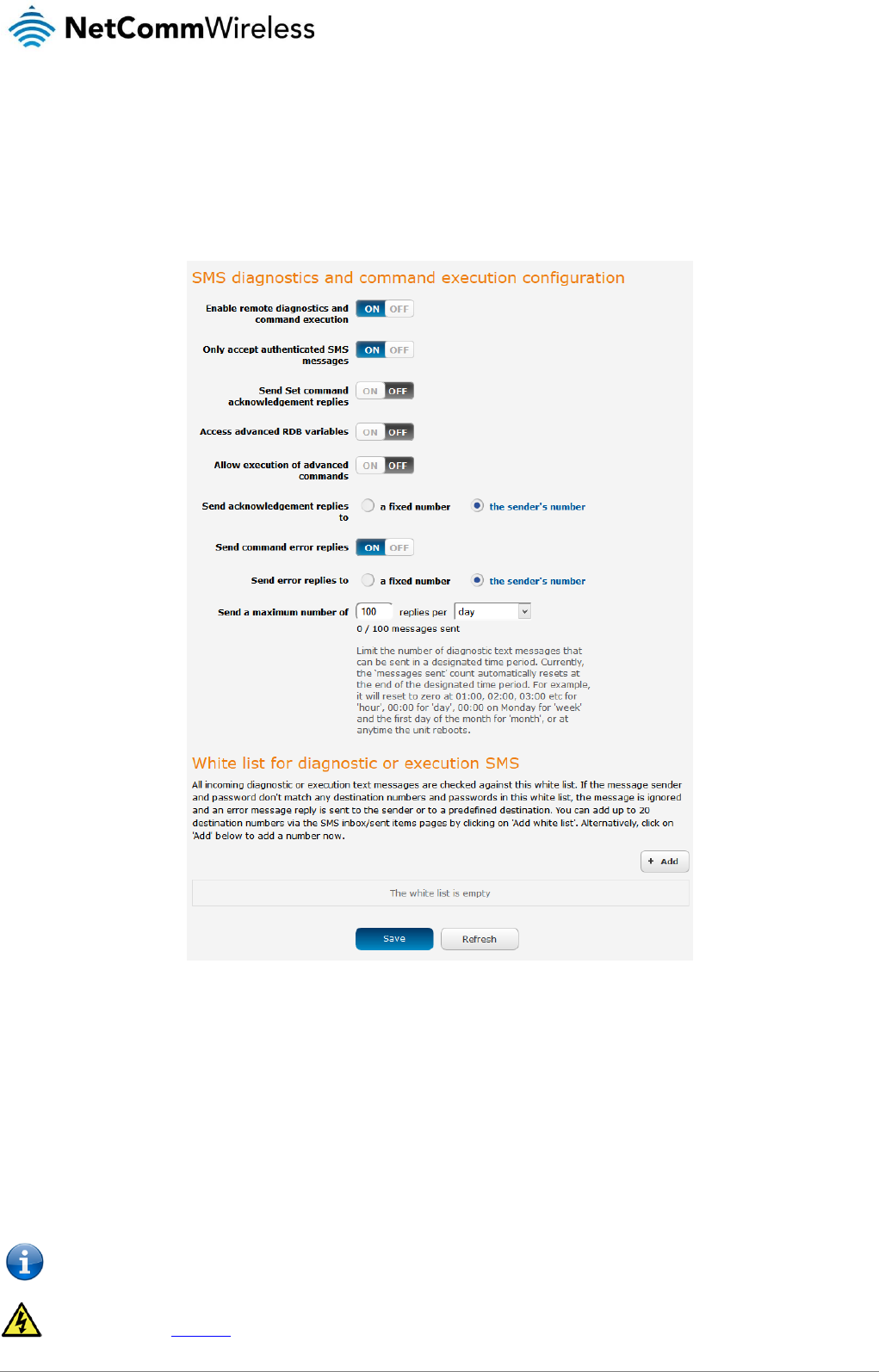
www.netcommwireless.com
NetComm Wireless 4G M2M Router
95
v1.0
Diagnostics
The Diagnostics page is used to configure the SMS diagnostics and command execution configuration. This allows you to change
the configuration, perform functions remotely and check on the status of the router via SMS commands.
To access the Diagnostics page, click on the Services menu item then select the SMS menu on the left and finally select
Diagnostics beneath it.
Figure 104 - SMS diagnostics and command execution configuration
SMS diagnostics and command execution configuration
The options on this page are described below.
Enable remote diagnostics and command execution
Enables or disables the remote diagnostics feature. If this setting is enabled all incoming text messages are parsed and tested for
remote diagnostics commands.
If remote diagnostics commands are found, the router executes those commands. This feature is enabled by default. All remote
diagnostic commands that are received are stored in the Inbox.
Note: It is possible to adjust settings and prevent your router from functioning correctly using remote diagnostics. If this
occurs, you will need to perform a factory reset in order to restore normal operation.
We highly recommended that you use the white list and a password when utilising this feature to prevent unauthorised
access. See the White list description for more information.

96
NetComm Wireless 4G M2M Router
www.netcommwireless.com
v1.0
Only accept authenticated SMS messages
Enables or disables checking the sender’s phone number against the allowed sender white list for incoming diagnostics and
command execution SMS messages.
If authentication is enabled, the router will check if the sender’s number exists in the white list. If it exists, the router then checks the
password (if configured) in the incoming message against the password in the white list for the corresponding sending number. If
they match, the diagnostic or command is executed.
If the number does not exist in the white list or the password does not match, the router does not execute the incoming diagnostic
or command in the SMS message.
This is enabled by default and it is strongly advised that you leave this feature enabled to maintain security.
Send Set command acknowledgement replies
The NTC-140-01 router will automatically reply to certain types of commands received, such as
get
commands, or
execute
commands. However acknowledgement replies from the NTC-140-01 router are optional with
set
commands and the
Wakeup
command. This option Enables or disables sending an acknowledgment message after execution of a
set
command or SMS
Wakeup command. If disabled, the router does not send any acknowledgement after execution of a
set
command or SMS Wakeup
command. All acknowledgment replies are stored in the Outbox after they have been sent. This can be useful to determine if a
command was received and executed by the router. This option is disabled by default.
Access advanced RDB variables
By default, this option is turned off and only allows access to the basic RDB variables listed later in this guide. If this option is
enabled, you are able to access the full list of RDB variables via SMS.
Allow execution of advanced commands
By default, this option is turned off and only allows execution of the basic commands listed later in this guide. If this option is
enabled, you are able to execute advanced commands such as those which are common to the Linux command line. For example:
“execute ls /usr/bin/sms*” to list the contents of the /etc folder on the router.
Send acknowledgement replies to
This option allows you to specify where to send acknowledgment messages after the execution of a
set, get,
or
exec
command.
If a fixed number is selected, the acknowledgement message will be sent to the number defined in the Fixed number to send replies
to field. If the sender’s number is selected, the acknowledgement message will be sent to the number that the SMS diagnostic or
command message originated from. The default setting is to use the sender’s number.
Fixed number to send replies to
This field defines the destination number to which error messages are sent after the execution of a
get
,
set,
or
exec
command. This
field is only displayed when Send Error SMS to is set to Fixed Number.
Send command error replies
Enables or disables the sending of an error message resulting from the execution of a
get
,
set
, or
exec
command. All error replies
are stored in the Outbox after they have been sent.
Send error replies to
When Send Error SMS for Get/Set/Exec Command is set to ON, this option is used to specify where the error SMS is sent. Use the
radio buttons to select either Fixed Number or SMS Sender Number. When set to SMS Sender Number the router will reply to the
originating number of the SMS diagnostic or command. When set to Fixed Number the router will send the error messages to the
number specified in the following field.
Send a maximum number of
You can set the maximum number of acknowledgement and error messages sent when an SMS diagnostic or command is
executed. The maximum limit can be set per hour, day, week or month. The router will send a maximum of 100 replies by default.
The number of messages sent is shown below the options. The total transmitted message count resets after a reboot or at the
beginning of the time frame specified.
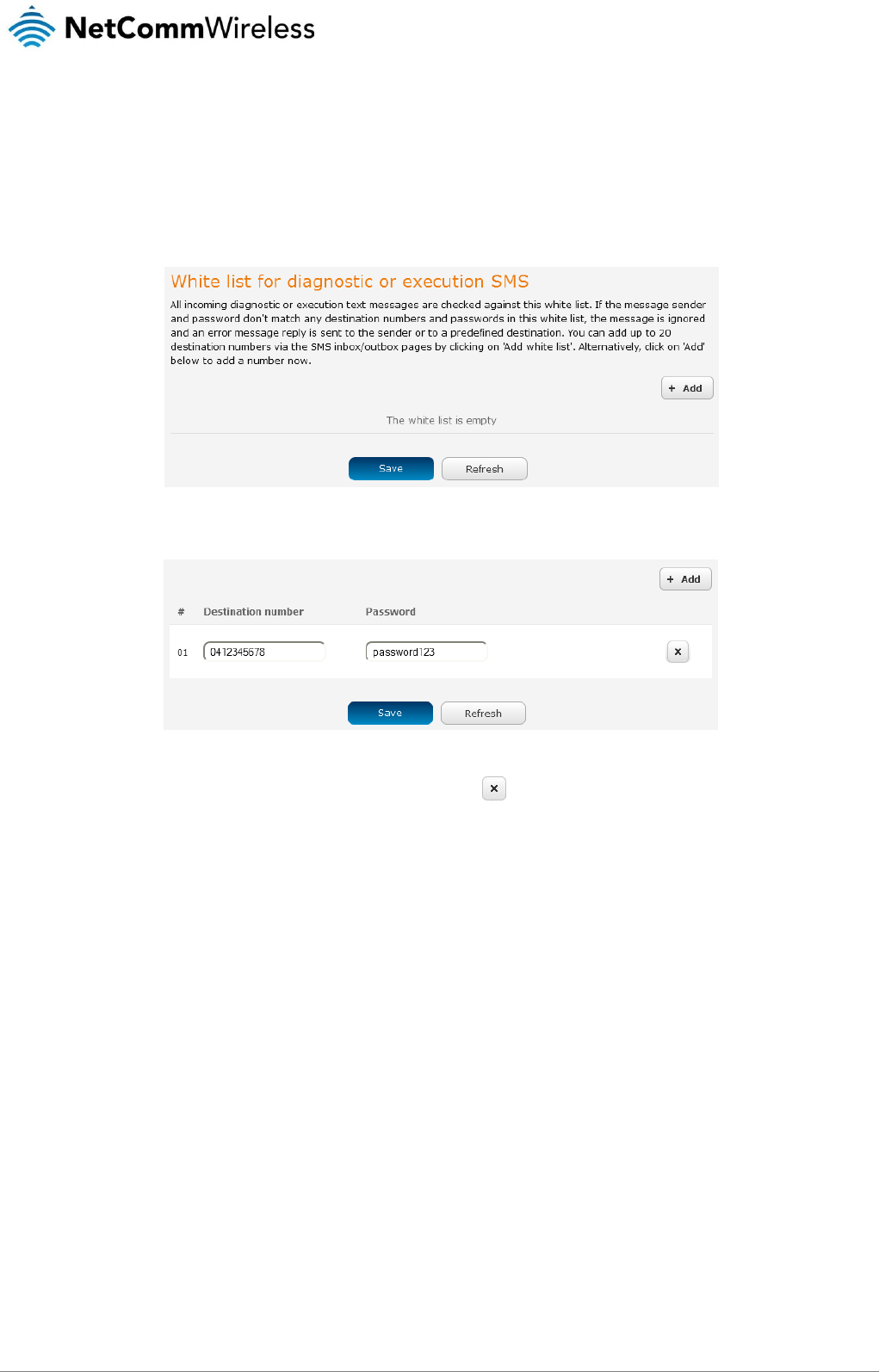
www.netcommwireless.com
NetComm Wireless 4G M2M Router
97
v1.0
White List for diagnostic or execution SMS
The white list is a list of mobile numbers that you can create which are considered “friendly” to the router. If Only accept
authenticated SMS messages is enabled in the diagnostics section, the router will compare the mobile number of all incoming
diagnostic and command messages against this white list to determine whether the diagnostic or command should be executed.
You may optionally configure a password for each number to give an additional level of security. When a password is specified for a
number, the SMS diagnostic or command message is parsed for the password and will only be executed if the number and
password match.
Figure 105 - White list for diagnostic or execution SMS
A maximum of 20 numbers can be stored on the router in the white list. To add a number to the white list, click the “+Add” button.
Figure 106 – Adding a number to the SMS white list
The White List numbers and passwords can be cleared by pressing the button to the right of each entry. To add a number to
the white list, enter it in the Destination number field and optionally define a password in the Password field. When you have finished
adding numbers click the Save button to save the entries.

98
NetComm Wireless 4G M2M Router
www.netcommwireless.com
v1.0
Sending an SMS Diagnostic Command
Follow the steps below to configure the router to optionally accept SMS diagnostic commands only from authenticated senders and
learn how to send SMS diagnostic commands to the router.
1. Navigate to the Services > SMS messaging > Diagnostics page
2. Confirm that the Enable remote diagnostics and command execution toggle key is set to the ON position. If it is set to OFF
click the toggle key to switch it to the ON position.
3. If you wish to have the router only accept commands from authenticated senders, ensure that Only accept authenticated
SMS messages is set to the ON position. In the White list for diagnostic or execution SMS messages section, click the
+Add button and enter the sender’s number in international format into the Destination number field that appears. If you
wish to also configure a password, enter the password in the Password field corresponding to the destination number.
4. If you would prefer to accept SMS diagnostic commands from any sender, set the Only accept authenticated SMS
messages toggle key to the OFF position.
Note: An alternative method of adding a number to the white list is to send an SMS message to the router, navigate to
Services > SMS messaging > Inbox and then click the button next to the message which corresponds to the sender’s
number.
5. Click the Save button.
Types of SMS diagnostic commands
There are three types of commands that can be sent; execute, get and set. The basic syntax is as follows:
execute COMMAND
get VARIABLE
set VARIABLE=VALUE
If authentication is enabled, each command must be preceded by the password:
PASSWORD execute COMMAND
PASSWORD get VARIABLE
PASSWORD set VARIABLE=VALUE
The following are some examples of SMS diagnostic commands:
password6657 execute reboot
get rssi
set apn1=testAPNvalue
SMS acknowledgment replies
The router automatically replies to get commands with a value and execute commands with either a success or error response. Set
commands will only be responded to if the Send Set command acknowledgement replies toggle key is set to ON. If the Send
command error replies toggle key is set to ON, the router will send a reply if the command is correct but a variable or value is
incorrect, for example, due to misspelling.
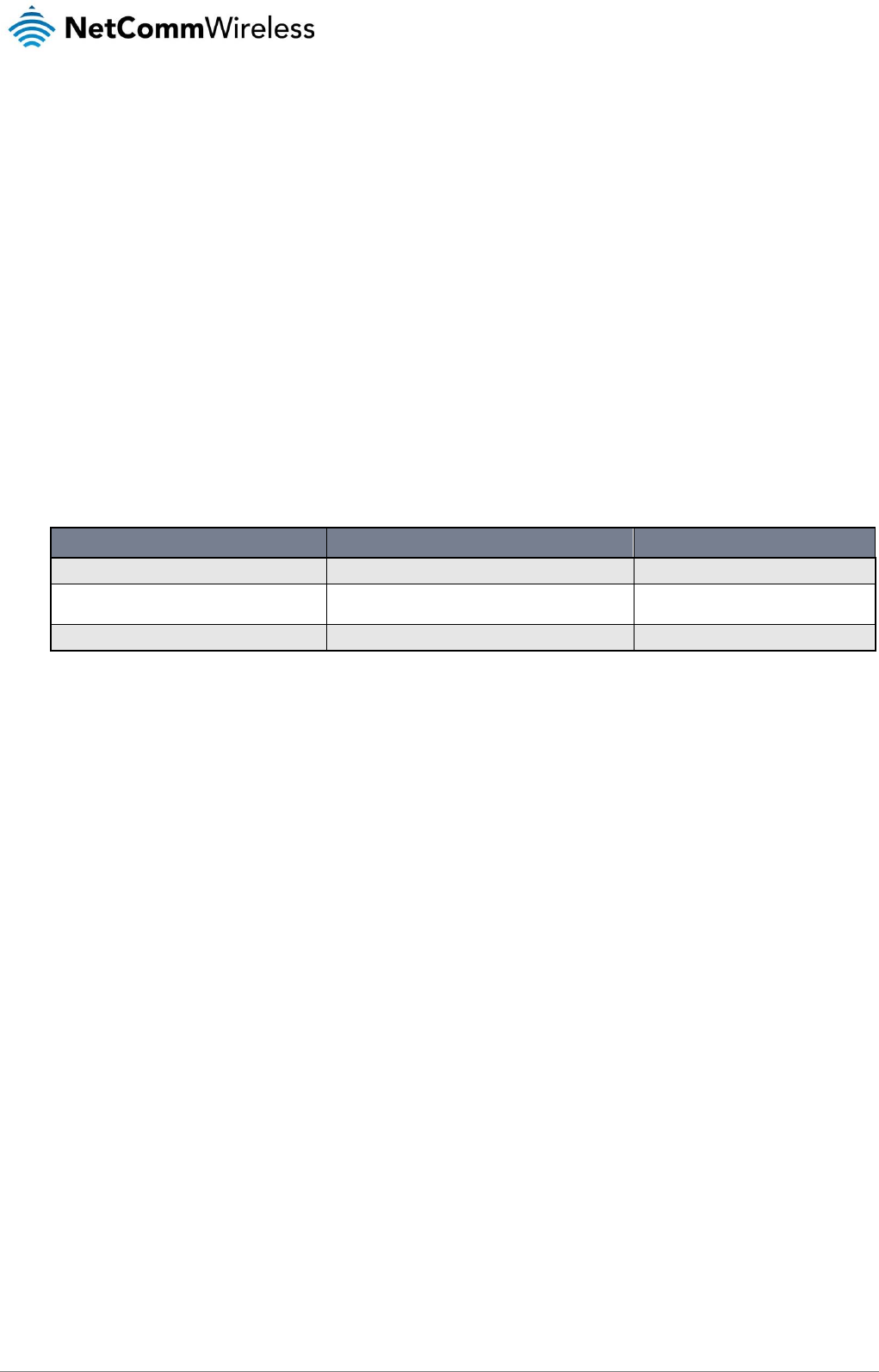
www.netcommwireless.com
NetComm Wireless 4G M2M Router
99
v1.0
SMS command format
Generic Format for reading variables:
get VARIABLE
PASSWORD get VARIABLE
Generic Format for writing to variables:
set VARIABLE=VALUE
PASSWORD set VARIABLE=VALUE
Generic Format for executing a command:
Execute COMMAND
PASSWORD execute COMMAND
Replies
Upon receipt of a successfully formatted, authenticated (if required) command, the gateway will reply to the SMS in the following
format:
TYPE
SMS CONTENTS
NOTES
get command
“VARIABLE=VALUE”
set command
“Successfully set VARIABLE to VALUE”
Only sent if the acknowledgment message
function is enabled
execute command
“Successfully executed command COMMAND”
Table 31 - SMS Diagnostic Command Syntax
Where “VARIABLE” is the name of the value to be read
Where “VARIABLE (x)” is the name of another value to be read
Where “VALUE” is the content to be written to the “VARIABLE”
Where “COMMAND” is a supported command to be executed by the device (e.g. reboot)
Where “PASSWORD” is the password (if configured) for the corresponding sender number specified in the White List
Multiple commands can be sent in the same message, if separated by a semicolon.
For Example:
get VARIABLE1; get VARIABLE2; get VARIABLE3
PASSWORD get VARIABLE1; get VARIABLE2
set VARIABLE=VALUE1 ; set VARIABLE2=VALUE2
PASSWORD set VARIABLE1=VALUE1; set VARIABLE2=VALUE2; set VARIABLE3=VALUE3
If required, values can also be bound by an apostrophe, double apostrophe or back tick.
For Example:
“set VARIABLE=’VALUE’”
“set VARIABLE=”VALUE””
“set VARIABLE=`VALUE`”
“get VARIABLE”

100
NetComm Wireless 4G M2M Router
www.netcommwireless.com
v1.0
A password (if required), only needs to be specified once per SMS, but can be prefixed to each command if desired.
“PASSWORD get Variable1”; “get VARIABLE2”
“PASSWORD set VARIABLE1=VALUE1”; “set VARIABLE2=VALUE2”
If the command sent includes the “reboot” command and has already passed the white list password check, the device keeps this
password and executes the remaining command line after the reboot with this same password.
For Example:
“PASSWORD execute reboot; getVariable1”; “get VARABLE2”
“PASSWORD execute reboot; PASSWORD get Variable1”; “get VARABLE2”
Note: Commands, variables and values are case sensitive.
List of basic commands
A list of basic commands which can be used in conjunction with the execute command are listed below:
“pdpcycle”, “pdpdown” and “pdpup” commands can have a profile number suffix ‘x’ added. Without the suffix specified, the
command operates against the default profile configured on the profile list page of the Web-UI.
#
COMMAND NAME
DESCRIPTION
1
reboot
Immediately performs a soft reboot.
2
pdpcycle
Disconnects (if connected) and reconnects the data connection. If a profile number is selected in the
command, try to disconnect/reconnect the specified profile in case the profile is active. If no profile
number is selected, try to disconnect/reconnect the current active profile. Reports an error if no profile
number is selected and there is no currently activated profile.
3
pdpdown
Disconnects the PDP. If a profile number is selected in the command, the router tries to disconnect the
specified profile in case the profile is active. If no profile number is selected, try to disconnect the current
active profile. Reports an error if no profile number is selected and there is no currently activated profile.
4
pdpup
Reconnects the PDP. If a profile number is selected in the command, the router tries to connect with
the specified profile. If no profile number is selected, the router tries to connect to the last active profile.
The gateway will check the currently activated profile and disconnect this profile before executing the
command. The router reports an error if no profile number is selected and there is no stored last active
profile number.
5
factorydefaults
Performs a factory reset on the router. Be aware that this command also clears the SMS white list on
the router.
6
download
Performs a download and install of a Firmware Upgrade (.cdi), Config File (.tar.gz) or a help document
(.pdf) file.
If the file is a firmware image as in the case of a .cdi file, the router will apply the recovery image first and
then the main firmware image. The download location is specified immediately after the command and
may be from an HTTP or FTP source URL.
If the file is a .cdi file, the router will apply the file as a configuration file update for the device and reboot
afterwards.
If the file is a .pdf, the router will assume this is a user guide document and save it to the router and
make the file available for viewing via the help menu on the Web-UI.
Note: If your download URL includes any space characters, please encode these prior to transmission
according to RFC1738, for example:
ftp://username:password@serveraddress/directory%20with%20spaces/filename.cdi
Note: Authenticated FTP addresses may be used following the format as defined in RFC1738, for
example:
ftp://username:password@serveraddress/directory/filename.cdi
7
codconnect
Causes the router to activate the PDP context when the Connect on demand feature is enabled.
8
coddisconnect
Causes the router to de-activate the PDP context when the Connect on demand feature is enabled.
9
wakeup
This forces the default Data connection profile to connect if it is in a disconnected or waiting state.
There are two circumstances in which this command may be useful; where the default profile is enabled
but has been manually disconnected and if Connect on demand is enabled and the router is awaiting
packet of interest. In both of these situations, the wakeup command will cause the default PDP context
to activate.
10
ssh.genkeys
Instructs the router to generate new public SSH keys.
11
ssh.clearkeys
Instructs the router to clear the client public SSH key files.
Table 32 - List of basic SMS diagnostic commands

www.netcommwireless.com
NetComm Wireless 4G M2M Router
101
v1.0
List of get/set commands
The following table is a partial list of get and set commands which may be performed via SMS.
COMMAND
NAME
EXAMPLE
DESCRIPTION
get status
get status
Returns the Module firmware version, LAN IP Address, Network State, Network operator and
RSSI.
get sessionhistory
get sessionhistory
Returns the time and date of recent sessions along with the total amount of data sent and
received for each session.
set syslogserver
set
syslogserver=123.45.67.89:514
Sets a remote syslog server IP or hostname and port.
set cod
set cod=1
Enables or disables Connect on demand.
get cod
get cod
Returns the enable/disable status of the Connect on demand feature.
get codstatus
get codstatus
Returns the connection status of the Connect on demand feature.
set coddialport
set coddialport=on,53
Sets the Connect on demand feature to connect only when traffic is received on the specified
port.
get coddialport
get coddialport
Returns the Connect on demand port filter status and list or filtered ports.
set codonline
set codonline=20
Sets the router to stay online for at least X minutes when data activity is detected.
get codonline
get codonline
Returns the number of minutes the router is configured to stay online when data activity is
detected.
set codminonline
set codminonline=10
Sets the router to stay online for a minimum of X minutes after connecting.
get codminonline
get codminonline
Returns the minimum number of minutes the router should stay online after connecting.
set codredial
set codredial=5
Sets the number of minutes that the router should not attempt to redial after hanging up.
get codredial
get codredial
Returns the number of minutes that the router is configured to not attempt to redial after
hanging up.
set coddisconnect
set coddisconnect=0
Sets the number of minutes after which the router should disconnect regardless of traffic.
get coddisconnect
get coddisconnect
Returns the number of minutes the router is configured to disconnect regardless of traffic.
set codconnectreg
set codconnectreg=30
Sets the number of minutes that the router should regularly attempt to connect.
get codconnectreg
get codconnectreg
Returns the number of minutes that the router is configured to regularly attempt to connect.
set codrandomtime
set codrandomtime=3
Sets the number of minutes that the router should randomise the dial time by.
get codrandomtime
get codrandomtime
Returns the number of minutes that the router is configured to randomise the dial time by.
set codverbose
set codverbose=1
Sets verbose logging on or off.
get codverbose
get codverbose
Returns the status of verbose logging.
set codignore.icmp
set codignore.icmp=1
Sets the router to ignore ICMP packets triggering data activity detection.
get codignore.icmp
get codignore.icmp
Returns the status of the Ignore ICMP option.
set codignore.tcp
set codignore.tcp=1
Sets the router to ignore TCP packets triggering data activity detection.
get codignore.tcp
get codignore.tcp
Returns the status of the Ignore TCP option.
set codignore.udp
set codignore.udp=1
Sets the router to ignore UDP packets triggering data activity detection.
get codignore.udp
get codignore.udp
Returns the status of the Ignore UDP option.
set codignore.dns
set codignore.dns=1
Sets the router to ignore DNS traffic triggering data activity detection.
get codignore.dns
get codignore.dns
Returns the status of the Ignore DNS option.
set codignore.ntp
set codignore.ntp=1
Sets the router to ignore NTP traffic triggering data activity detection.
get codignore.ntp
get codignore.ntp
Returns the status of the Ignore NTP option.
set codignore.ncsi
set codignore.ncsi=1
Sets the router to ignore NCSI traffic triggering data activity detection.
get codignore.ncsi
get codignore.ncsi
Returns the status of the Ignore NCSI option.
get plmnscan
get plmnscan
Instructs the router to perform a network scan and returns the results by SMS.
set forceplmn
set forceplmn=505,3
Sets the operator to a manual selection made by the user where “505” is the Mobile Country
Code for Australia and “3” is the Mobile Network Code for Vodafone. As no network type (e.g..
LTE/3G/2G) is specified, it is selected automatically.
get forceplmn
get forceplmn
Returns the operator and network type selection mode (Automatic/Manual), in addition to the
MCC and MNC values
get pppoe
get pppoe
Returns the PPPoE status, currently configured dial string and service name
set pppoe
set pppoe=1, telstra.internet, test
Sets the PPPoE status on, APN to telstra.internet, and service name to test.

102
NetComm Wireless 4G M2M Router
www.netcommwireless.com
v1.0
get ledmode
get ledmode
Returns the status of the LED operation mode.
set ledmode
set ledmode=10
Sets the LED operation mode to be always on or to turn off after the specified number of
minutes.
get ssh.proto
get ssh.proto
Returns the SSH protocol in use.
set ssh.proto
set ssh.proto=1,2
Sets the SSH Protocol to protocol 1, 2 or both (1,2).
get ssh.passauth
get ssh.passauth
Returns the status of the SSH Enable password authentication option.
set ssh.passauth
set ssh.passauth=1
Sets the SSH Enable password authentication option on or off.
get.ssh.keyauth
get.ssh.keyauth
Returns the status of the SSH Enable key authentication option.
set.ssh.keyauth
set.ssh.keyauth=1
Sets the SSH Enable key authentication option on or off.
get download.timeout
get download.timeout
Returns the time in minutes that the router waits before a download times out.
set download.timeout
set download.timeout=20
Sets the time in minutes that the router waits before a download times out. This is set to 10
minutes by default. Supported range is 10 – 1440 minutes.
get install.timeout
get install.timeout
Returns the time in minutes that the router waits before a file that is being installed times out.
set install.timeout
set install.timeout=5
Sets the time in minutes that the router waits before a file that is being installed times out. This
is set to 3 minutes by default. Supported range is 3 – 300 minutes.
Table 33 - List of get/set commands
List of basic RDB variables
The following table lists valid variables where “x” is a profile number (1-6). If no profile is specified, variables are read from or written
to for the current active profile. If a profile is specified, variables are read from or written to for the specified profile number (‘x’).
#
RDB VARIABLE NAME
SMS
VARIABLE
NAME
READ/
WRITE
DESCRIPTION
EXAMPLE VALUE
0
link.profile.1.enable
link.profile.1.apn
link.profile.1.user
link.profile.1.pass
link.profile.1.auth_type
link.profile.1.iplocal
link.profile.1.status
profile
RW
Profile
Read:
(profile no,apn,user,pass,auth,iplocal,status)
1,apn,username,password,
chap,202.44.185.111,up
Write:
(apn, user, pass,auth)
apn,username,password
2
link.profile.1.user
username
RW
Cellular broadband
username
Guest, could also return “null”
3
link.profile.1.pass
password
RW
Cellular broadband
password
Guest, could also return “null”
4
link.profile.1.auth_type
authtype
RW
Cellular broadband
Authentication type
”pap” or”chap”
5
link.profile.1.iplocal
wanip
R
WAN IP address
202.44.185.111
6
wwan.0.radio.information.signal_strength
rssi
R
Cellular signal
strength
-65 dBm
7
wwan.0.imei
imei
R
IMEI number
357347050000177
8
statistics.usage_current
usage
R
Cellular broadband
data usage of current
session
“Rx 500 bytes, Tx 1024 bytes, Total 1524
bytes” or “Rx 0 byte, Tx 0 byte, Total 0 byte”
when wwan down
9
statistics.usage_current
wanuptime
R
Up time of current
cellular broadband
session
1 days 02:30:12 or 0 days 00:00:00 when
wwan down
10
/proc/uptime
deviceuptime
R
Device up time
1 days 02:30:12
11
wwan.0.system_network_status.current_band
band
R
Current band
WCDMA850
Table 34 - List of basic SMS diagnostics RDB variables
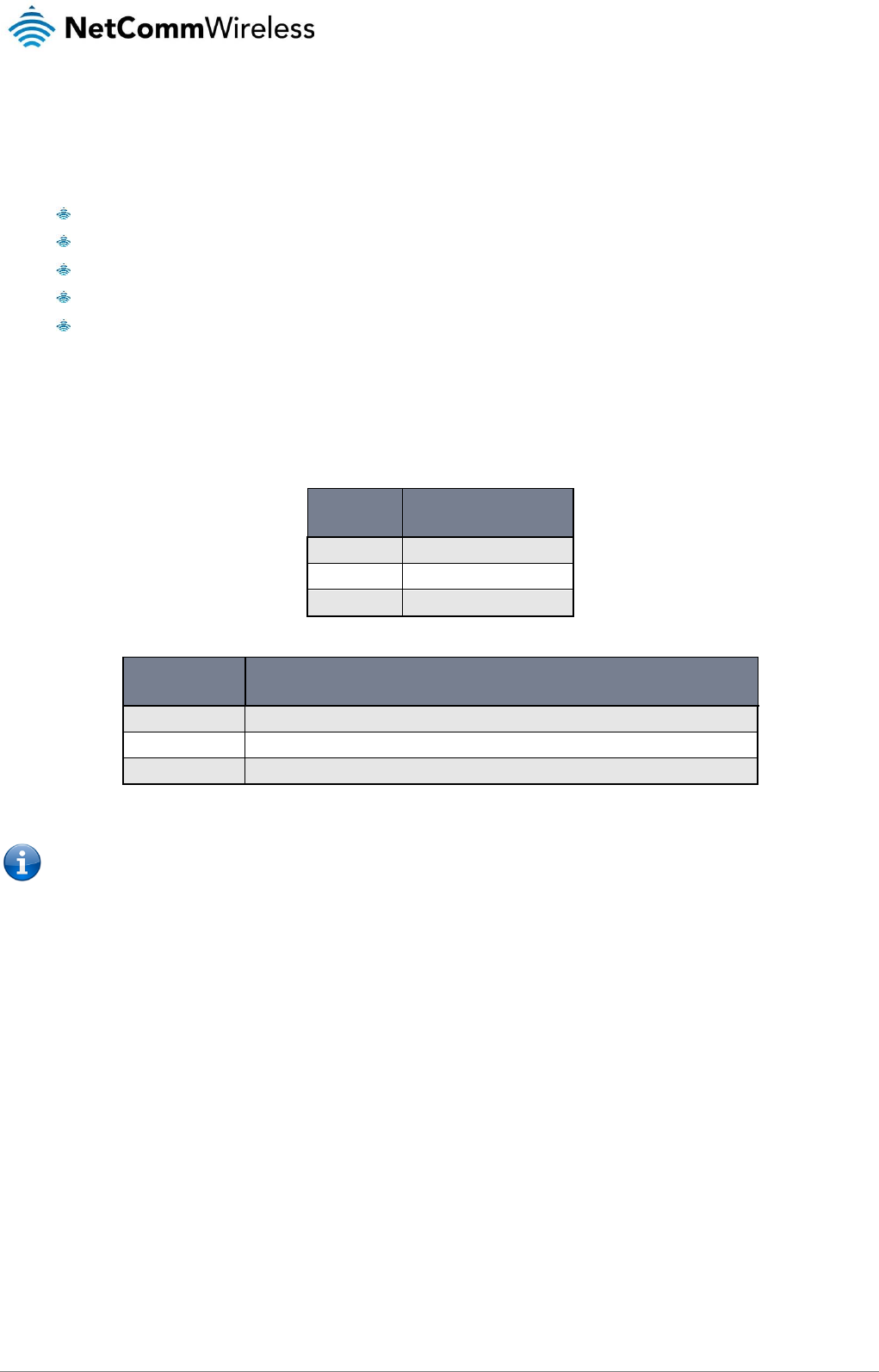
www.netcommwireless.com
NetComm Wireless 4G M2M Router
103
v1.0
Network scan and manual network selection by SMS
Performing a network scan
The get plmnscan SMS command enables you to perform a scan of the cellular networks available at the time of the scan.
It returns the following semi-colon separated information for each network in range:
MCC
MNC
Network Type (LTE, 3G, 2G)
Provider's Name
Operator Status (available, forbidden, current)
The following is an example of a response from the get plmnscan SMS command:
plmnscan:505,3,7,vodafone AU,4;505,3,1,vodafone AU,1;505,2,7,YES OPTUS,1;505,2,1,YES OPTUS,1;505,1,1,Telstra
Mobile,1;505,1,7,Telstra Mobile,1
NETWORK
TYPE
DESCRIPTION
9
Indicates an LTE network.
7
Indicates a 3G network
1
Indicates a 2G network
Table 35 - Network types returned by get plmnscan SMS command
OPERATOR
STATUS
DESCRIPTION
1
Indicates an available operator which may be selected.
2
Indicates a forbidden operator which may not be selected (applies only to generic SIM cards).
4
Indicates the currently selected operator.
Table 36 - Operator status codes returned by get plmnscan SMS command
Notes about the network connection status when using the get plmnscan command:
• If the connection status is Up and connection mode is Always on, the get plmnscan SMS will cause the connection to
disconnect, perform the scan, send the result through SMS and then bring the connection back up again. If the
connection status is Down, the router will perform the PLMN scan, send the result and keep the connection status down.
• If the connection status is Waiting and connection mode is Connect on demand, the get plmnscan SMS will change the
connection status to Down, perform the scan, send the result through SMS and then restore the connection status to the
Waiting state.
• If the connection status is Up and connection mode is Connect on demand, the get plmnscan SMS will cause the
connection to disconnect, perform the scan, send the result through SMS, and then restore the connection status to the
Waiting state unless there is a traffic which triggers a connection in which case the connection status will be set to Up.
Setting the router to connect to a network
The router can be instructed by SMS to connect to one of the networks returned by the get plmnscan command. The set forceplmn
command forces the router to connect to a specified operator network (if available) while the get forceplmn command retrieves the
currently configured network on the router.
Command format:
set forceplmn=0|MCC,MNC| MCC,MNC,Network Type
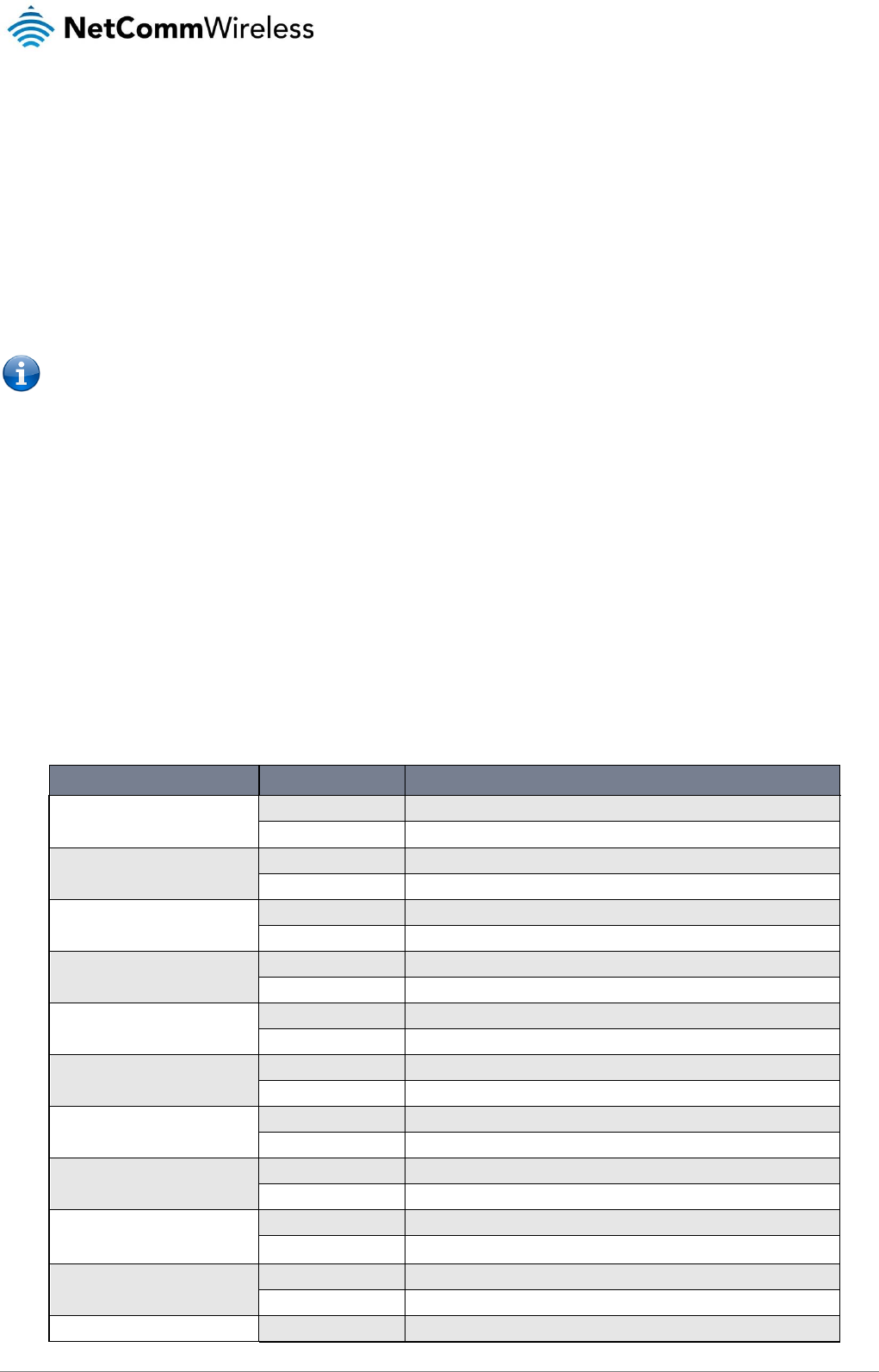
104
NetComm Wireless 4G M2M Router
www.netcommwireless.com
v1.0
For example:
set forceplmn=0
Sets the selection of operator and network type to automatic mode.
set forceplmn=505,3
Sets the operator to a manual selection made by the user where “505” is the Mobile Country Code for Australia and “3” is
the Mobile Network Code for Vodafone. As no network type (e.g. LTE/3G/2G) is specified, it is selected automatically.
set forceplmn=505,3,7
Sets the operator and network type to a manual selection made by the user where “505” is the Mobile Country Code for
Australia, “3” is the Mobile Network Code for Vodafone and “7” is the 3G network type.
Notes about the set forceplmn command:
1. If the manual selection fails, the device will fall back to the previous ‘good’ network.
2. When enabled, the SMS acknowledgement reply reflects the success or failure of the manual selection with respect to
the
set
command and includes the final MNC/MCC that was configured.
Confirming the currently configured operator and network type
You can retrieve the currently configured operator and network type using the get forceplmn command.
The get forceplmn command returns the operator and network type selection mode (Automatic/Manual), in addition to the MCC
and MNC values, for example:
Automatic,505,3
This response indicates that the operator/network selection mode is Automatic, and the network used is Vodafone AU.
SMS diagnostics examples
The examples below demonstrate various combinations of supported commands. This is not an exhaustive list and serves as an
example of possibilities only.
DESCRIPTION
AUTHENTICATION
INPUT EXAMPLE
Send SMS to change the data
connection username
Not required
set username=’NetComm’
Required
PASSWORD set username= ”NetComm”
Send SMS to change the data
connection password
Not required
set password= `NetComm`
Required
PASSWORD set password= `NetComm`
Send SMS to change the data
connection authentication
Not required
set authtype= ‘pap’
Required
PASSWORD set authtype = pap
Send SMS to reboot
Not required
execute reboot
Required
PASSWORD execute reboot
Send SMS to check the WAN IP
address
Not required
get wanip
Required
PASSWORD get wanip
Send SMS to check the mobile
signal strength
Not required
get rssi
Required
PASSWORD get rssi
Send SMS to check the IMEI
number
Not required
get imei
Required
PASSWORD get imei
Send SMS to check the current
band
Not required
get band
Required
PASSWORD get band
Send SMS to Disconnect (if
connected) and reconnect the data
connection
Not required
execute pdpcycle
Required
PASSWORD execute pdpcycle
Send SMS to disconnect the data
connection
Not required
execute pdpdown
Required
PASSWORD execute pdpdown
Not required
execute pdpup
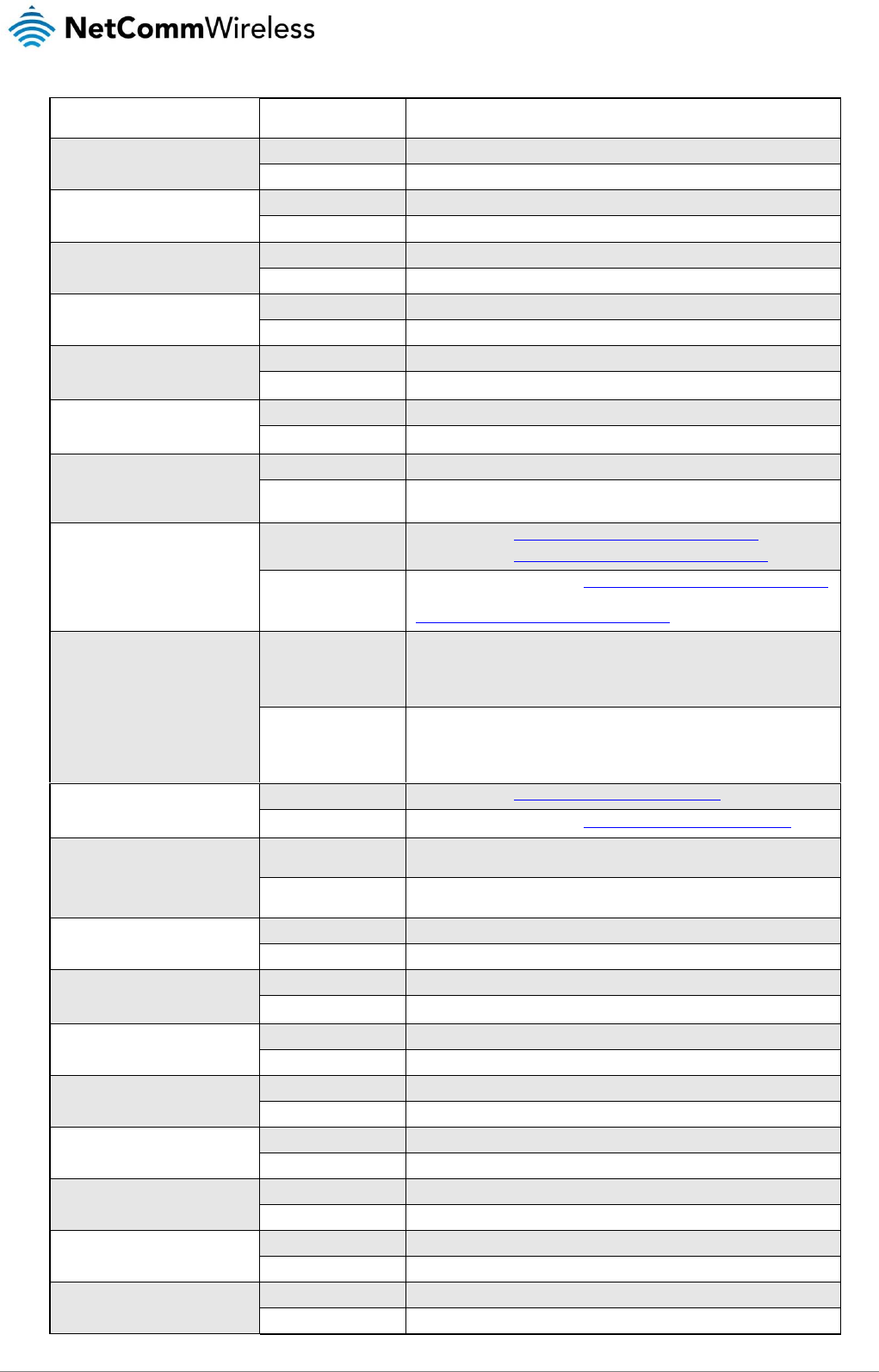
www.netcommwireless.com
NetComm Wireless 4G M2M Router
105
v1.0
Send SMS to connect the data
connection
Required
PASSWORD execute pdpup
Send multiple get command
Not required
get wanip; get rssi
Required
PASSWORD get wanip; get rssi
Send multiple set command
Not required
set ssh.genkeys=1; set username=test; set auth=pap
Required
PASSWORD set ssh.genkeys=1; set username=test; set auth=pap
Send SMS to reset to factory default
settings
Not required
execute factorydefaults
Required
PASSWORD execute factorydefaults
Send SMS to retrieve status of
router
Not required
get status
Required
PASSWORD get status
Send SMS to retrieve the history of
the session, including start time, end
time and total data usage
Not required
get sessionhistory
Required
PASSWORD get sessionhistory
Send SMS to configure the router to
send syslog to a remote syslog
server
Not required
set syslogserver=123.209.56.78
Required
PASSWORD set syslogserver=123.209.56.78
Send SMS to wake up the router,
turn on the default gateway and
trigger the ‘connect on demand’
profile if in waiting state.
Not required
execute wakeup
Required
PASSWORD execute wakeup
Send SMS to perform firmware
upgrade when firmware is located
on HTTP server
Not required
execute download http://download.com:8080/firmware_image.cdi
execute download http://download.com:8080/firmware_image_r.cdi
Required
PASSWORD execute download http://download.com:8080/firmware_image.cdi
PASSWORD execute download
http://download.com:8080/firmware_image_r.cdi
Send SMS to perform firmware
upgrade when firmware is located
on FTP server
Not required
execute download
ftp://username:password@download.com/firmware_image.cdi
execute download ftp://username:password@
download.com/firmware_image_r.cdi
Required
PASSWORD execute download ftp://username:password@
download.com/firmware_image.cdi
PASSWORD execute download ftp://username:password@
download.com/firmware_image_r.cdi
Send SMS to download and install
IPK package located on HTTP
server
Not required
execute download http://download.com:8080/package.ipk
Required
PASSWORD execute download http://download.com:8080/package.ipk
Send SMS to download and install
IPK package located on FTP server
Not required
execute download ftp://username:password@
download.com:8080/package.ipk
Required
PASSWORD execute download ftp://username:password@
download.com:8080/package.ipk
Send SMS to turn off PPPoE
Not required
set pppoe=0
Required
PASSWORD set pppoe=0
Send SMS to retrieve the PPPoE
status, currently configured dial
string and service name
Not required
get pppoe
Required
PASSWORD get pppoe
Send SMS to set the LED mode
timeout to 10 minutes
Not required
set ledmode=10
Required
PASSWORD set ledmode=10
Send SMS to retrieve the current
LED mode
Not required
get ledmode
Required
PASSWORD get ledmode
Retrieve current SSH protocol
Not required
get ssh.proto
Required
PASSWORD get ssh.proto
Select SSH protocol
Not required
set ssh.proto=1
Required
PASSWORD set ssh.proto=1
Retrieve password authentication
status
Not required
get ssh.passauth
Required
PASSWORD get.ssh.passauth
Enable/disable password
authentication on host
Not required
set ssh.passauth=1 or set ssh.passauth=0
Required
PASSWORD set ssh.passauth=1 or PASSWORD set ssh.passauth=0

106
NetComm Wireless 4G M2M Router
www.netcommwireless.com
v1.0
Table 37 - SMS diagnostics example commands
Generate set of public/private keys
on the host
Not required
execute ssh.genkeys
Required
PASSWORD execute ssh.genkeys
Clear client public keys stored on
host
Not required
execute ssh.clearkeys
Required
PASSWORD execute ssh.clearkeys
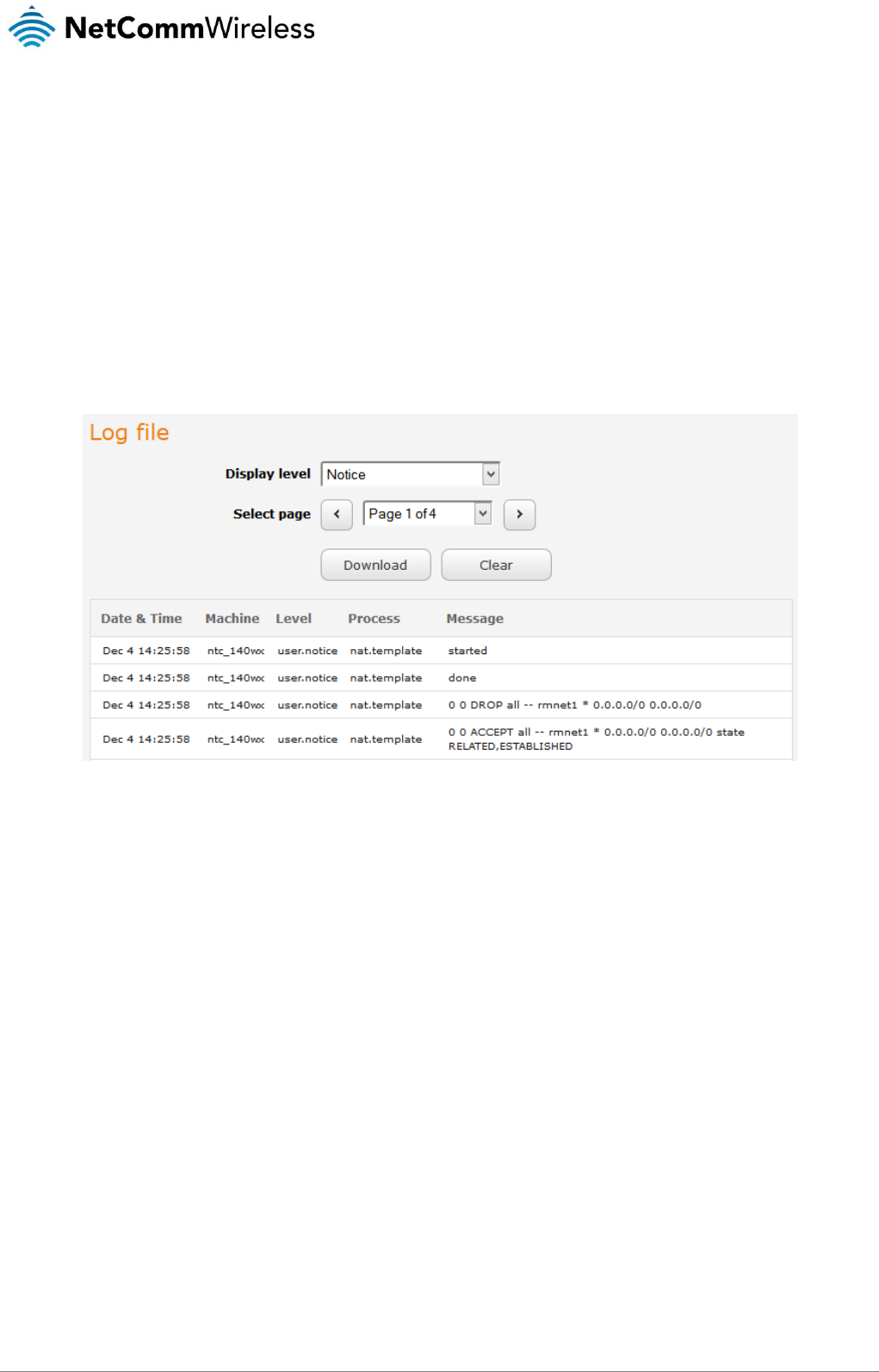
www.netcommwireless.com
NetComm Wireless 4G M2M Router
107
v1.0
System
Log
The Log pages are used to display or download the System log and IPSec logs on the router.
System log
The System Log enables you to troubleshoot any issues you may be experiencing with your NTC-140-01 router. To access the
System Log page, click on the System menu. The System Log is displayed.
Figure 107 - System log file
Log file
Use the Display level drop-down list to select a message level to be displayed. The message levels are described in the table below.
To download the System log for offline viewing, right-click the Download button and choose Save as.. to save the file. To clear the
System log, click the Clear button. The downloaded log file is in Linux text format with carriage return (CR) only at the end of a line,
therefore in order to be displayed correctly with new lines shown, it is recommended to use a text file viewer which displays this
format correctly (e.g. Notepad++).

108
NetComm Wireless 4G M2M Router
www.netcommwireless.com
v1.0
IPSec log
The IPSec log section provides the ability for you to download the log for the IPSec VPN function. This can assist in troubleshooting
any problems you may have with the IPSec VPN. To access the IPSec log page, click on the System menu item then select the Log
menu on the left and finally select IPSec log beneath it.
Figure 108 - IPSec log
Use the Log level drop down list to specify the type of detail you want to capture in the log and then click the Save button. When
you change the logging level, any active IPSec VPN tunnels will be disconnected as a change in logging level requires the IPSec
service to be restarted.
To download the IPSec log, click the Download IPSec log button and you will be prompted to save the file.
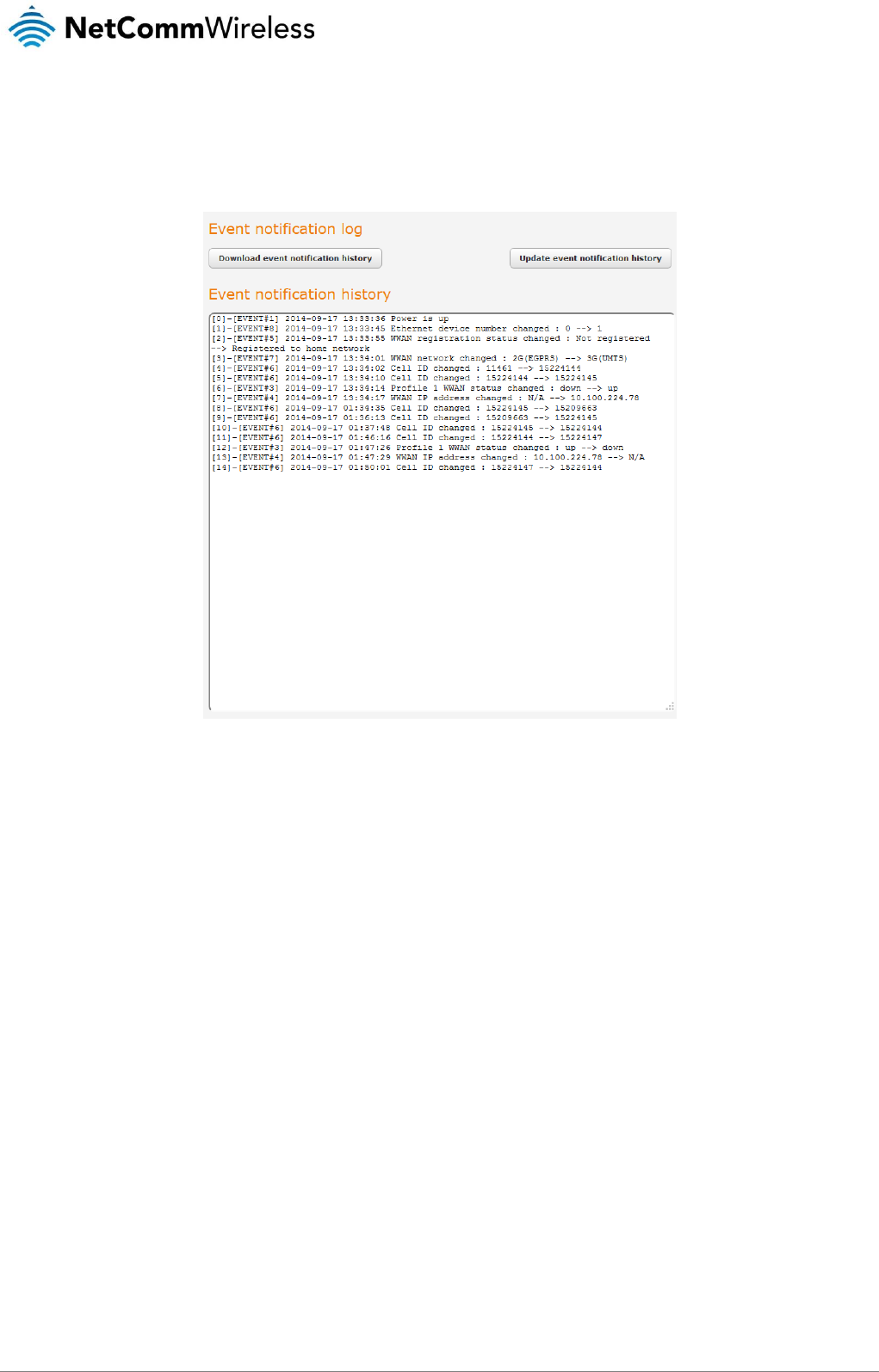
www.netcommwireless.com
NetComm Wireless 4G M2M Router
109
v1.0
Event notification log
The Event notification log section provides the ability for you to download the log for the Event notification function. This can assist
in troubleshooting any problems you may have with the Event notification feature. To access the Event notification log page, click on
the System menu item then select the Log menu on the left and finally select Event notification log beneath it.
Figure 109 - Event notification log
Use the Download event notification history button to download the log file. The Update event notification history button forces a
refresh of the log display.
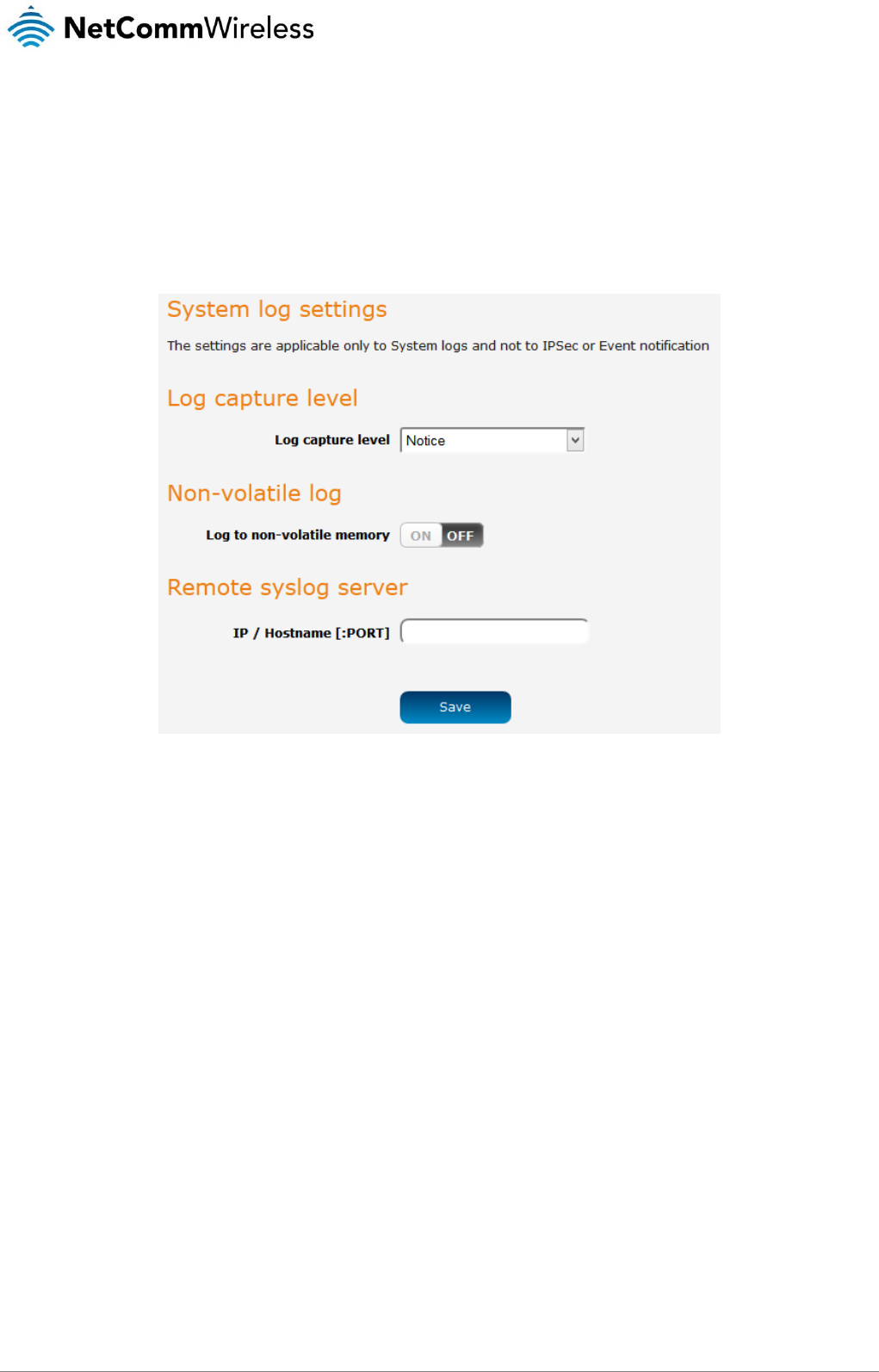
110
NetComm Wireless 4G M2M Router
www.netcommwireless.com
v1.0
System log settings
To access the System log settings page, click on the System menu item then select the Log menu on the left and finally select
System log settings beneath it.
Log data is stored in RAM and therefore, when the unit loses power or is rebooted, it will lose any log information stored in RAM. To
ensure that log information is accessible between reboots of the router there are two options:
1. Enable the Log to non-volatile memory option
2. Use a remote syslog server
Figure 110 - System log settings
Non-volatile log
When the router is configured to log to non-volatile memory, the log data is stored in flash memory, making it accessible after a
reboot of the router. Up to 512kb of log data will be stored before it is overwritten by new log data. Flash memory has a finite
number of program-erase operations that it may perform to the blocks of memory. While this number of program-erase operations
is quite large, we recommend that you do not enable this option for anything other than debugging to avoid excessive wear on the
memory.
Log capture level
The log capture level defines the amount of detail that the system log stores. This setting also affects the Display level setting on the
System log page, for example, if this is set to a low level, such as “Error”, the System log will not be able to display higher log levels.
Remote syslog server
The router can be configured to output log data to a remote syslog server. This is an application running on a remote computer
which accepts and displays the log data. Most syslog servers can also save the log data to a file on the computer on which it is
running allowing you to ensure that no log data is lost between reboots.
To configure the NTC-140-01 router to output log data to a remote syslog server:
1. Click on the System menu from the top menu bar. The System log item is displayed.
2. Under the Remote syslog server section, enter the IP address or hostname of the syslog server in the IP / Hostname
[PORT] field. You can also specify the port number after the IP or hostname by entering a semi-colon and then the port
number e.g. 192.168.1.102:514. If you do not specify a port number, the router will use the default UDP port 514.
3. Click the Save button to save the configuration.

www.netcommwireless.com
NetComm Wireless 4G M2M Router
111
v1.0
Figure 111 – Remote syslog server configuration
ITEM
DEFINITION
Debug
Show extended system log messages with full debugging level details.
Info
Show informational messages only.
Notice
Show normal system logging information.
Error
Show error condition messages only.
Table 38 - System log detail levels
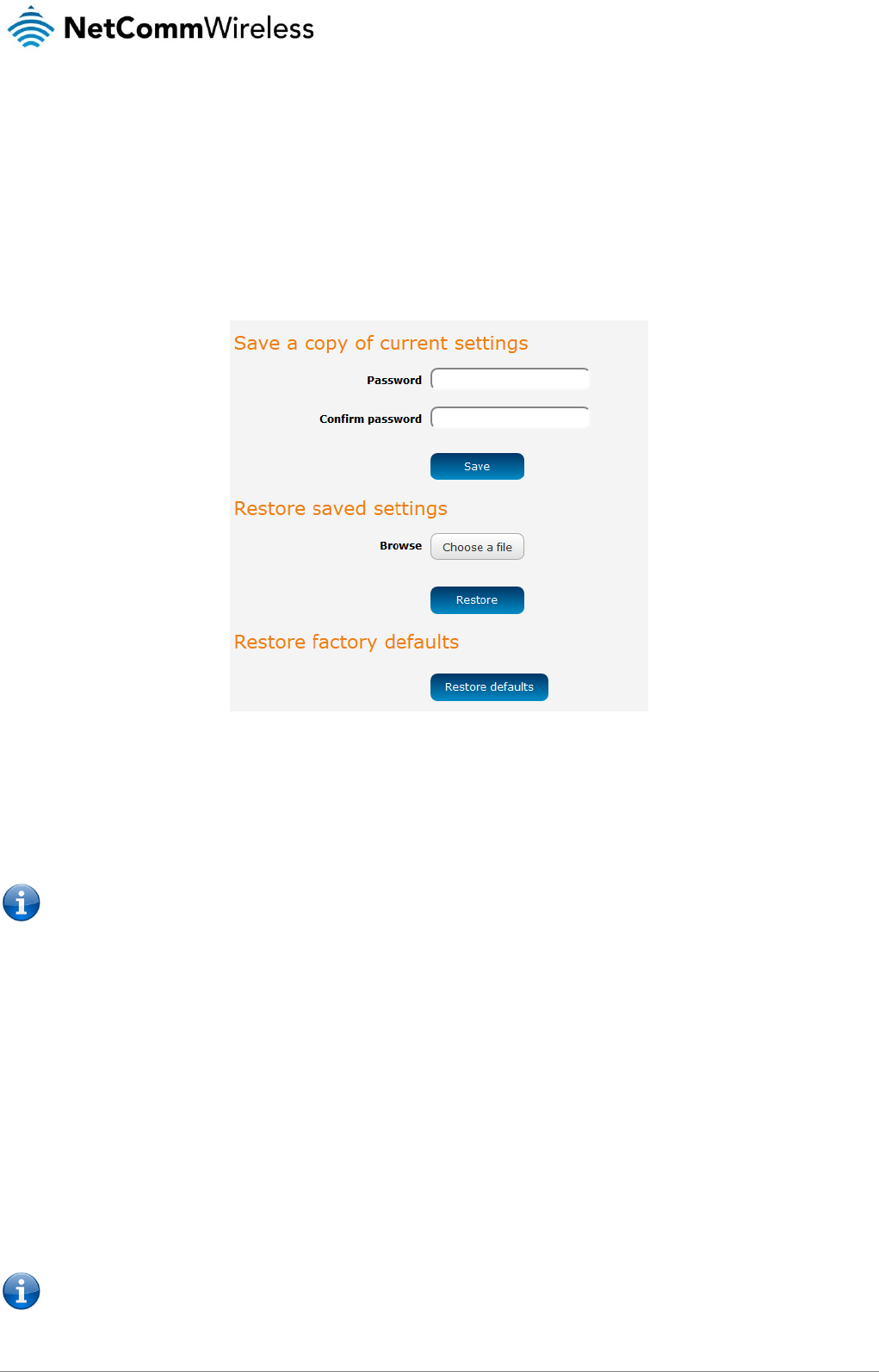
112
NetComm Wireless 4G M2M Router
www.netcommwireless.com
v1.0
System configuration
Settings backup and restore
The settings backup and restore page is used to backup or restore the router’s configuration or to reset it to factory defaults. In
order to view the settings page you must be logged into the web user interface as root using the password admin. The backup /
restore functions can be used to easily configure a large number of NTC-140-01 router by configuring one router with your desired
settings, backing them up to a file and then restoring that file to multiple NTC-140-01 routers.
To access the Settings backup and restore page, click on the System menu item then select the System confguration menu on the
left and finally select Settings backup and restore beneath it.
Figure 112 – Settings backup and restore
Back up your router’s configuration
Log in to the web configuration interface, click on the System menu and select Settings backup and restore.
If you want to password protect your backup configuration files, enter your password in the fields under Save a copy of current
settings and click on Save. If you don’t want to password protect your files, just click on Save. The router will then prompt you to
select a location to save the settings file.
Note: The following conditions apply:-
• It is NOT possible to edit the contents of the file downloaded; if you modify the contents of the configuration file in any way
you will not be able to restore it later.
• You may change the name of the file if you wish but the filename extension must remain as “.cfg”
Restore your backup configuration
1. In the web configuration interface click on the System menu and select Settings backup and restore.
2. From the Restore saved settings section, click on Browse or Choose a file and select the backup configuration file on your
computer.
3. Click Restore to copy the settings to the new NTC-140-01 router. The router will apply these settings and inform you it will
reboot - click on OK.
Restoring the router’s factory default configuration
Click the Restore defaults button to restore the factory default configuration. The router asks you to confirm that you wish to restore
factory default settings. If you wish to continue with the restoring of factory defaults, click OK.
Note: All current settings on the router will be lost when performing a restore of factory default settings. The device IP
address will change to 192.168.1.1 and the default username root and default password admin will be configured.
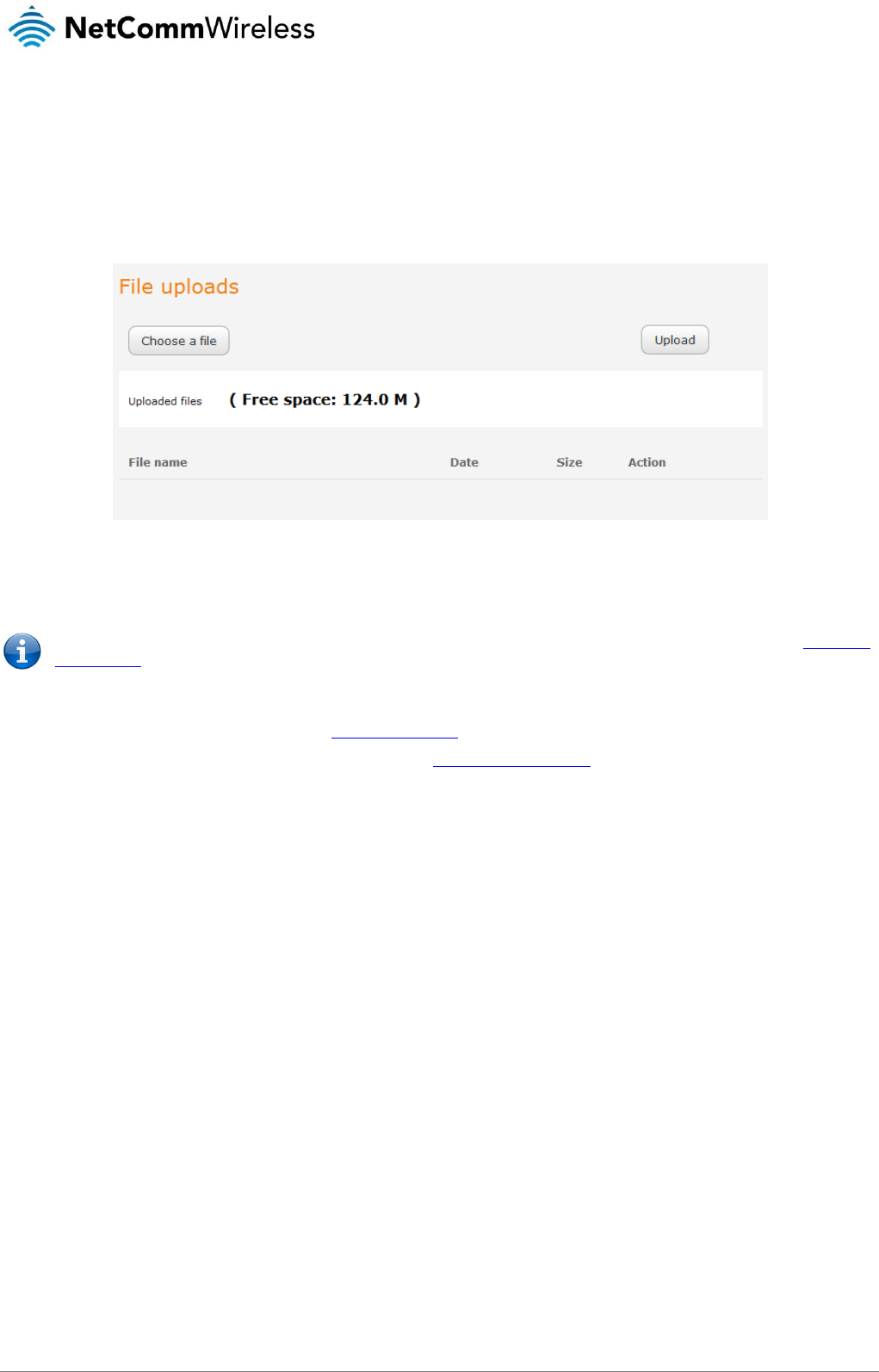
www.netcommwireless.com
NetComm Wireless 4G M2M Router
113
v1.0
Upload
To access the Upload page, click on the System menu, then System Configuration and then Upload.
The Upload page allows you to upload firmware files, HTTPS certificates or user created application packages to the NTC-140-01
router. When firmware files have been uploaded, they can also be installed from this page. PDF files, such as this user guide may
also be uploaded for access on the router’s help page.
For more information on application development, contact NetComm Wireless about our Software Development Kit.
Figure 113 - Upload page
Updating the Firmware
The firmware update process involves first updating the recovery image firmware and then updating the main firmware image.
Note: In order to perform an update, you must be logged into the router with the root manager account (see the Advanced
configuration section for more details).
To update the NTC-140-01 router’s firmware:
1. Power on the router as described in the Installing the router section.
2. Log in to the router with the root user account (See the Advanced configuration section for details)
3. Select the System item from the top menu bar, select the System configuration item from the menu on the left and then
select the Upload menu item.
4. Under the File uploads section, click the Choose a file button. Locate the recovery firmware image file on your computer
and click Open. The recovery image is named ntc_140wx_x.xx.xx.x_r.cdi while the main system firmware image is named
ntc_140wx_x.xx.xx.x.cdi.
5. Click the Upload button. The firmware image is uploaded to the storage on the router.
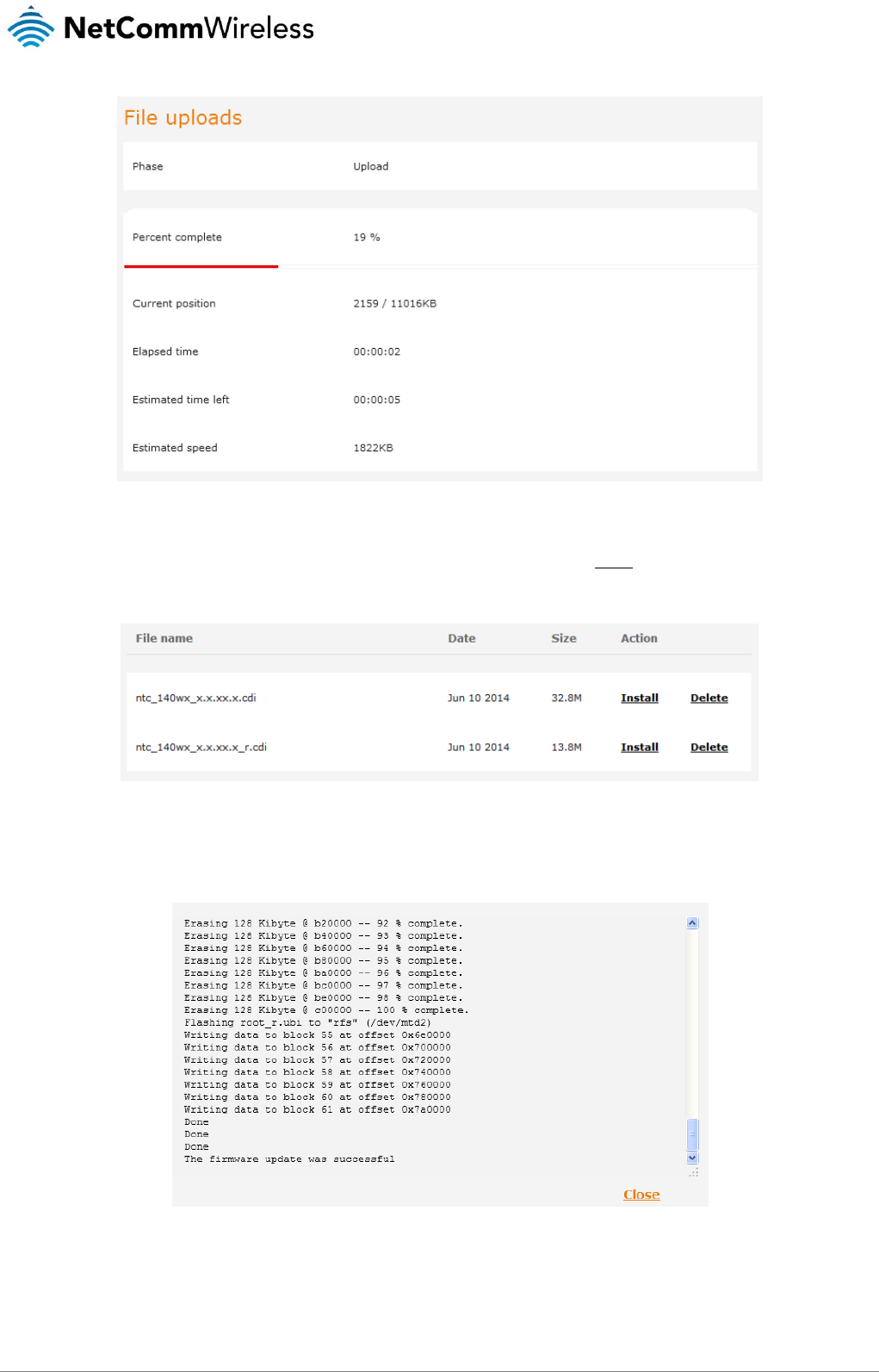
114
NetComm Wireless 4G M2M Router
www.netcommwireless.com
v1.0
Figure 114 - File upload
6. Repeat steps 4 and 5 for the main system firmware image.
7. The uploaded firmware images are listed in the Uploaded files section. Click the Install link next to the recovery image to
begin installing the recovery firmware image and then click OK on the confirmation window that appears.
Figure 115 - Uploaded files
8. The recovery firmware image is flashed and when it is complete, the router displays “The firmware update was successful”
and returns to the main Upload screen.
Figure 116 - Recovery firmware flash process
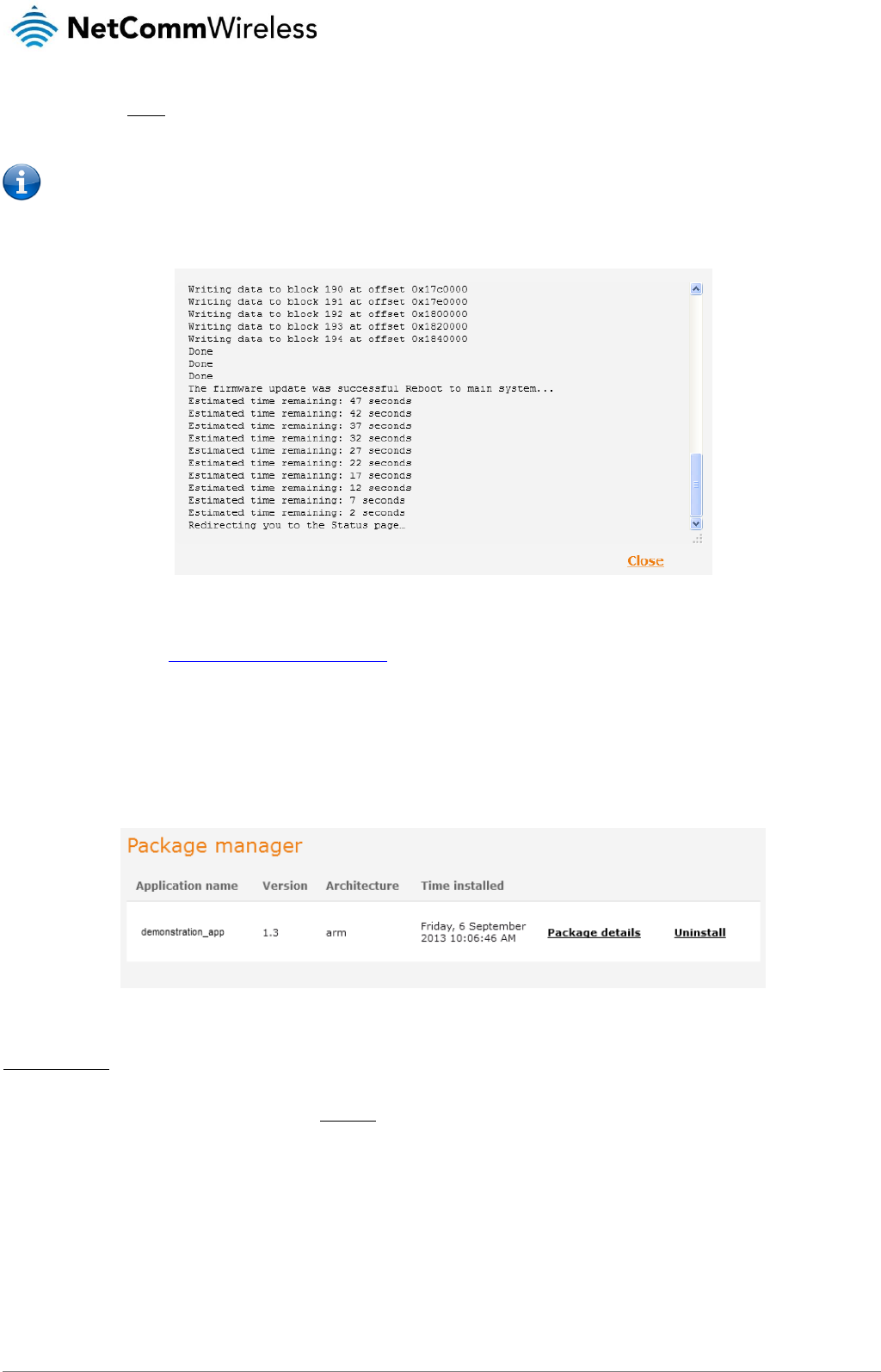
www.netcommwireless.com
NetComm Wireless 4G M2M Router
115
v1.0
9. Click the Install link to the right of the main firmware image you uploaded and then click OK to confirm that you want to
continue with the installation.
Note: Do not remove the power when the router’s LEDs are flashing as this is when the firmware update is in process.
10. The installation is complete when the countdown reaches zero. The router attempts to redirect you to the Status page.
Figure 117 -– Installing main firmware image
11. Hold down the reset button on the router for 15-20 seconds to reboot and restore the factory default settings of the
router. See the Restoring factory default settings section for more information.
Package manager
The Package Manager page is used to provide details of any user installed packages on the router and allow them to be uninstalled.
For more information on application development, contact NetComm Wireless about our Software Development Kit.
To access the Package manager page, click on the System menu, System Configuration and then Package manager.
Figure 118 – Software applications manager
The Application name, Version number of the application, the architecture type and time of installation are all displayed. Clicking the
Package details link will display a pop-up window with further details of the package.
To uninstall any software applications, click the Uninstall link.
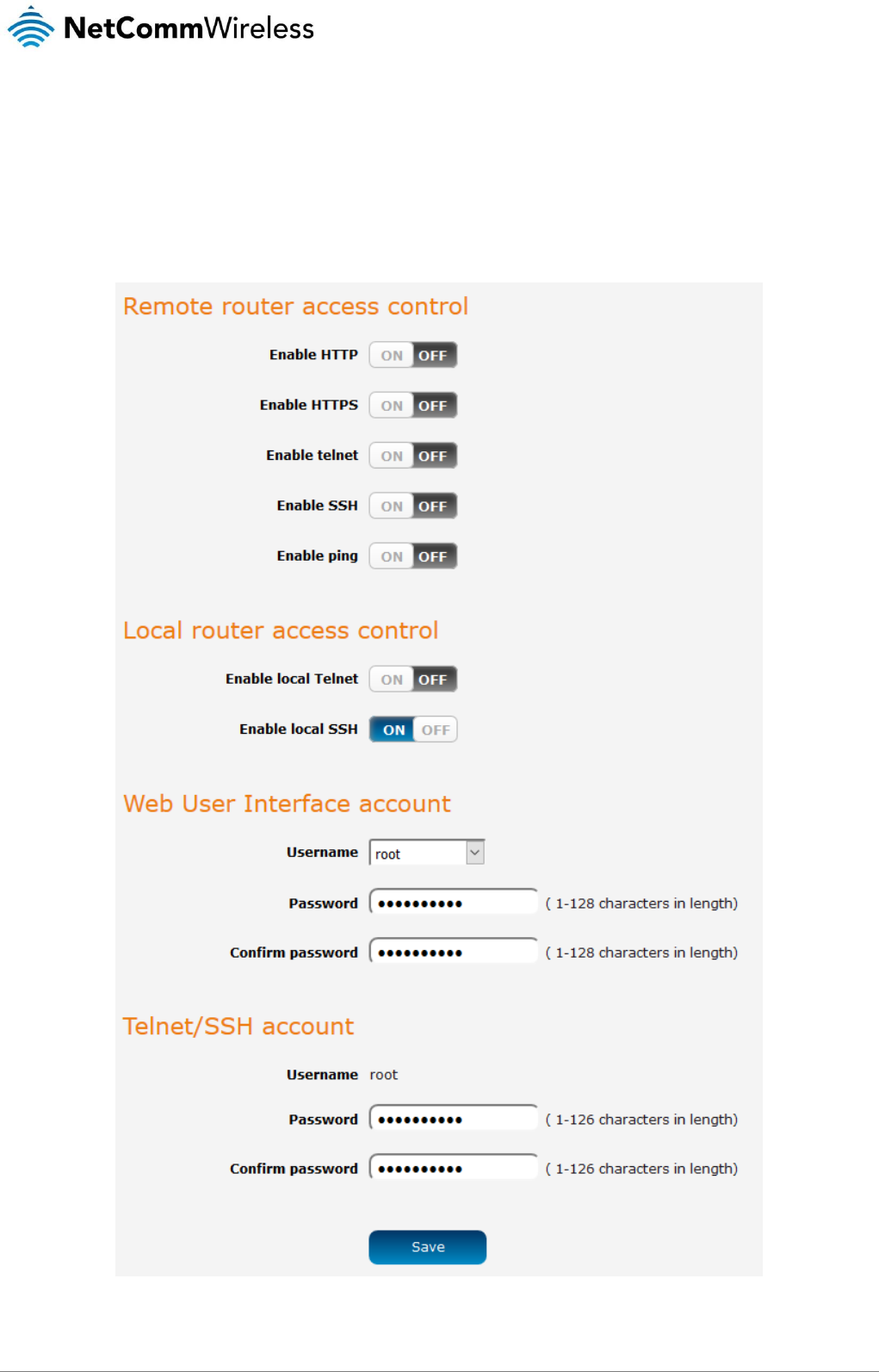
116
NetComm Wireless 4G M2M Router
www.netcommwireless.com
v1.0
Administration
Administration settings
To access the Administration Settings page, click on the System menu then the Administration menu on the left and then click on
Administration Settings.
The Administration settings page is used to enable or disable protocols used for remote access and configure the passwords for
the user accounts used to log in to the router.
Figure 119 - Administration page
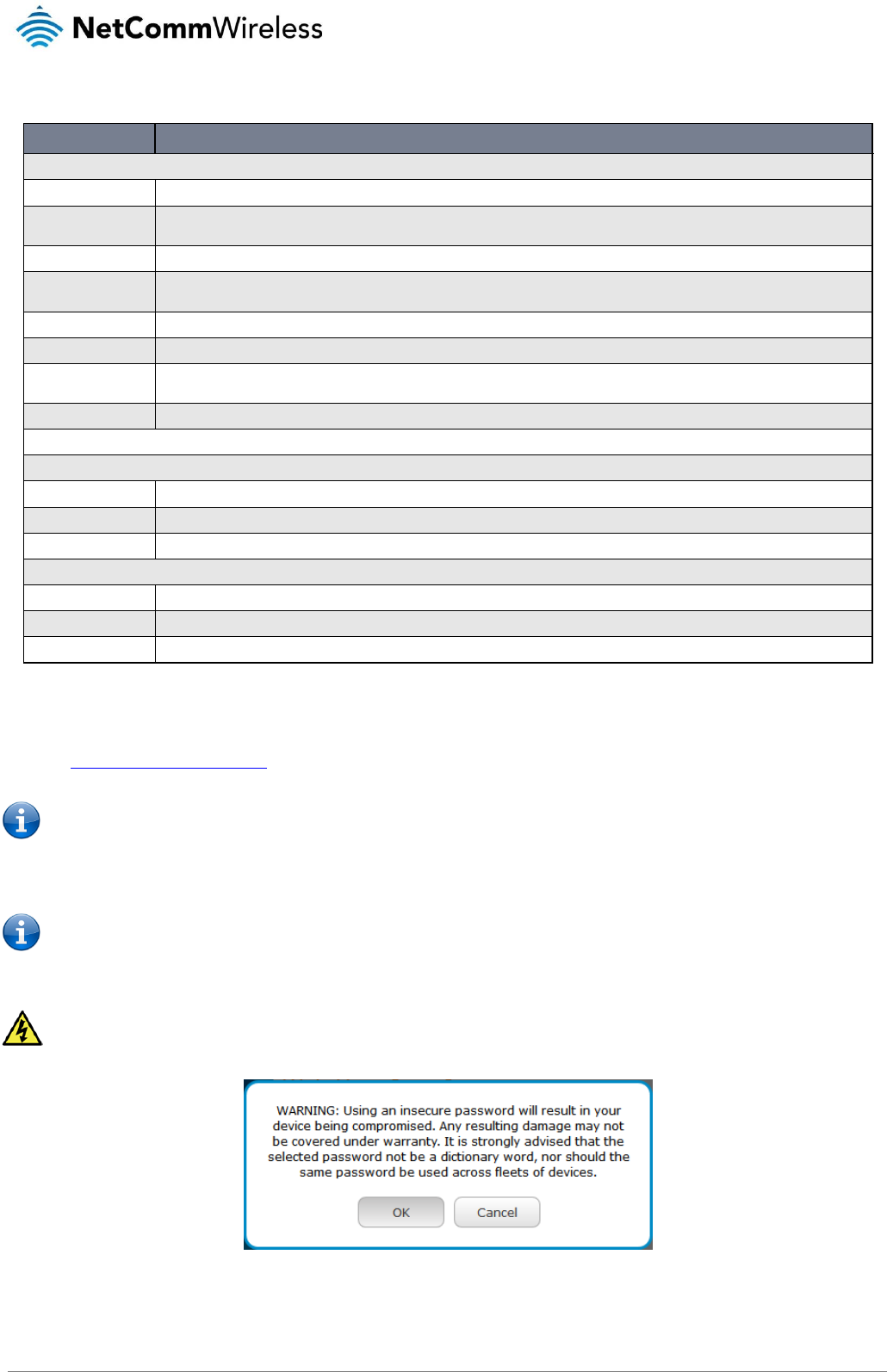
www.netcommwireless.com
NetComm Wireless 4G M2M Router
117
v1.0
Table 39 - Administration configuration options
To access the router’s configuration pages remotely:
1. Open a new browser window and navigate to the WAN IP address and assigned port number of the router, for example
http://123.209.130.249:8080
Note: You can find the router’s WAN IP address by clicking on the “Status” menu. The WWAN IP field in the WWAN
Connection Status section shows the router’s WAN IP address.
2. Enter the username and password to login to the router and click Log in.
Note: To perform functions like Firmware upgrade, device configuration backup and to restore and reset the router to factory
defaults, you must be logged in with the root manager account.
WARNING: Using an insecure password will result in your device being compromised. Any resulting damage may not be
covered under warranty. It is strongly advised that the password not be a dictionary word, nor should the same password
be used across fleets of devices.
OPTION
DEFINITION
Remote router access control
Enable HTTP
Enable or disable remote HTTP access to the router. You can also set the port you would like remote HTTP access to be available on.
HTTP management
port
Enter a port number between 1 and 65534 to use when accessing the router remotely.
Enable HTTPS
Enable or disable remote HTTPS access to the router using a secure connection.
Remote HTTPS
access port
Enter a port number between 1 and 65534 to use when accessing the router remotely over a secure HTTPS connection.
Enable Telnet
Enable or disable remote telnet (command line) access to the router.
Enable SSH
Enable or disable Secure Shell on the router.
Remote SSH Access
Port
Enter the port number for remote SSH access. Must be a port number between 1 and 65534.
Enable Ping
Enable or disable remote ping responses on the WWAN connection.
Local router access control (Telnet/SSH)
Web User Interface account
Username
Use the drop down list to select the root or admin account to change its web user interface password.
Password
Enter the desired web user interface password.
Confirm password
Re-enter the desired web user interface password.
Telnet/SSH account
Username
Displays the Telnet/SSH.username. This may not be changed.
Password
Enter the desired Telnet/SSH password.
Confirm password
Re-enter the desired Telnet/SSH password.
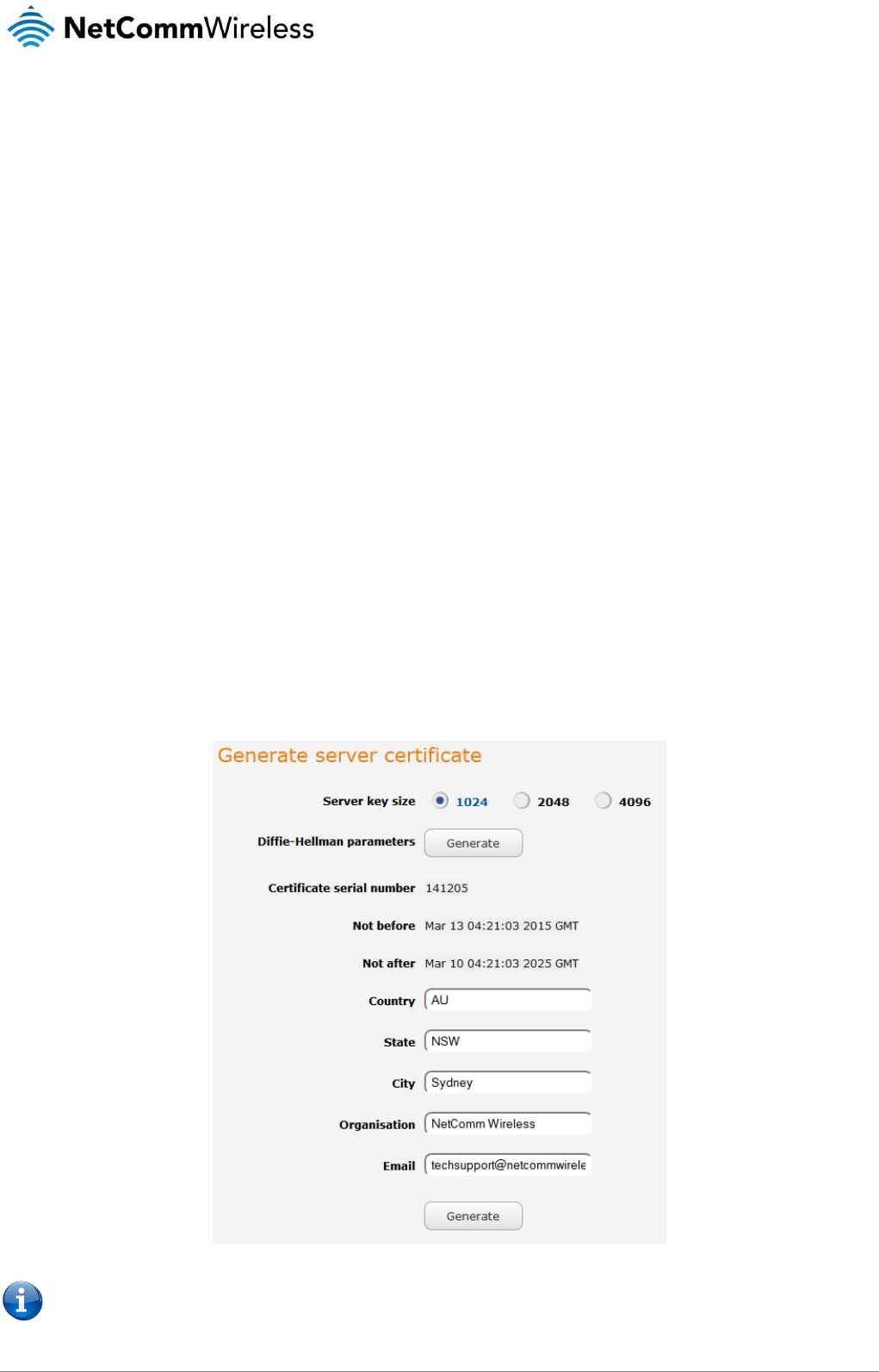
118
NetComm Wireless 4G M2M Router
www.netcommwireless.com
v1.0
Server certificate
What is HTTP Secure?
HTTP Secure or HTTPS is the use of the HTTP protocol over an SSL/TLS protocol. It is used primarily to protect against
eavesdropping of communication between a web browser and the web site to which it is connected. This is especially important
when you wish to have a secure connection over a public network such as the internet. HTTPS connections are secured through
the use of certificates issued by trusted certificate authorities such as VeriSign. When a web browser makes a connection attempt
to a secured web site, a digital certificate is sent to the browser so that it can verify the authenticity of the site using a built-in list of
trusted certificate authorities.
There are two main differences between how HTTPS and HTTP connections work:
1. HTTPS uses port 443 while HTTP uses port 80 by default.
2. Over an HTTPS connection, all data sent and received is encrypted with SSL while over an HTTP connection, all data is
sent unencrypted.
The encryption is achieved through the use of a pair of public and private keys on both sides of the connection. In cryptography, a
key refers to a numerical value used by an algorithm to alter information (encrypt it), making the information secure and visible only
to those who have the corresponding key to recover (decrypt) the information. The public key is used to encrypt information and
can be distributed freely. The private key is used to decrypt information and must be secret by its owner.
Each NTC-140-01 router contains a self-signed digital certificate which is identical on all NTC-140-01 routers. For a greater level of
security, the router also supports generating your own unique key. Additionally, you may use third party software to generate your
own self-signed digital certificate or purchase a signed certificate from a trusted certificate authority and then upload those
certificates to the router.
Generating your own self-signed certificate
To generate your own self-signed certificate:
1. Click the System item from the top menu bar, then Administration from the side menu bar and then Server certificate.
2. Select a Server key size. A larger key size takes longer to generate but provides better security.
3. Click the Generate button to begin generating Diffie-Hellman parameters.
4. Enter the certificate details using the appropriate fields. Each field must be completed in order to generate a certificate.
Figure 120 - Generate server certificate
Note: The Country field must contain a code for the desired country from the list below.

www.netcommwireless.com
NetComm Wireless 4G M2M Router
119
v1.0
CODE
COUNTRY
CODE
COUNTRY
CODE
COUNTRY
CODE
COUNTRY
AX
Åland Islands
ER
Eritrea
LS
Lesotho
SA
Saudi Arabia
AD
Andorra
ES
Spain
LT
Lithuania
SB
Solomon Islands
AE
United Arab Emirates
ET
Ethiopia
LU
Luxembourg
SC
Seychelles
AF
Afghanistan
FI
Finland
LV
Latvia
SE
Sweden
AG
Antigua and Barbuda
FJ
Fiji
LY
Libya
SG
Singapore
AI
Anguilla
FK
Falkland Islands (Malvinas)
MA
Morocco
SH
St. Helena
AL
Albania
FM
Micronesia
MC
Monaco
SI
Slovenia
AM
Armenia
FO
Faroe Islands
MD
Moldova
SJ
Svalbard and Jan Mayen
Islands
AN
Netherlands Antilles
FR
France
ME
Montenegro
SK
Slovak Republic
AO
Angola
FX
France, Metropolitan
MG
Madagascar
SL
Sierra Leone
AQ
Antarctica
GA
Gabon
MH
Marshall Islands
SM
San Marino
AR
Argentina
GB
Great Britain (UK)
MK
Macedonia
SN
Senegal
AS
American Samoa
GD
Grenada
ML
Mali
SR
Suriname
AT
Austria
GE
Georgia
MM
Myanmar
ST
Sao Tome and Principe
AU
Australia
GF
French Guiana
MN
Mongolia
SU
USSR (former)
AW
Aruba
GG
Guernsey
MO
Macau
SV
El Salvador
AZ
Azerbaijan
GH
Ghana
MP
Northern Mariana
Islands
SZ
Swaziland
BA
Bosnia and Herzegovina
GI
Gibraltar
MQ
Martinique
TC
Turks and Caicos Islands
BB
Barbados
GL
Greenland
MR
Mauritania
TD
Chad
BD
Bangladesh
GM
Gambia
MS
Montserrat
TF
French Southern Territories
BE
Belgium
GN
Guinea
MT
Malta
TG
Togo
BF
Burkina Faso
GP
Guadeloupe
MU
Mauritius
TH
Thailand
BG
Bulgaria
GQ
Equatorial Guinea
MV
Maldives
TJ
Tajikistan
BH
Bahrain
GR
Greece
MW
Malawi
TK
Tokelau
BI
Burundi
GS
S. Georgia and S. Sandwich
Isls.
MX
Mexico
TM
Turkmenistan
BJ
Benin
GT
Guatemala
MY
Malaysia
TN
Tunisia
BM
Bermuda
GU
Guam
MZ
Mozambique
TO
Tonga
BN
Brunei Darussalam
GW
Guinea-Bissau
NA
Namibia
TP
East Timor
BO
Bolivia
GY
Guyana
NC
New Caledonia
TR
Turkey
BR
Brazil
HK
Hong Kong
NE
Niger
TT
Trinidad and Tobago
BS
Bahamas
HM
Heard and McDonald Islands
NF
Norfolk Island
TV
Tuvalu
BT
Bhutan
HN
Honduras
NG
Nigeria
TW
Taiwan
BV
Bouvet Island
HR
Croatia (Hrvatska)
NI
Nicaragua
TZ
Tanzania
BW
Botswana
HT
Haiti
NL
Netherlands
UA
Ukraine
BZ
Belize
HU
Hungary
NO
Norway
UG
Uganda
CA
Canada
ID
Indonesia
NP
Nepal
UM
US Minor Outlying Islands
CC
Cocos (Keeling) Islands
IE
Ireland
NR
Nauru
US
United States
CF
Central African Republic
IL
Israel
NT
Neutral Zone
UY
Uruguay
CH
Switzerland
IM
Isle of Man
NU
Niue
UZ
Uzbekistan
CI
Cote D'Ivoire (Ivory
Coast)
IN
India
NZ
New Zealand
(Aotearoa)
VA
Vatican City State (Holy See)
CK
Cook Islands
IO
British Indian Ocean Territory
OM
Oman
VC
Saint Vincent and the
Grenadines
CL
Chile
IS
Iceland
PA
Panama
VE
Venezuela
CM
Cameroon
IT
Italy
PE
Peru
VG
Virgin Islands (British)
CN
China
JE
Jersey
PF
French Polynesia
VI
Virgin Islands (U.S.)
CO
Colombia
JM
Jamaica
PG
Papua New Guinea
VN
Viet Nam
CR
Costa Rica
JO
Jordan
PH
Philippines
VU
Vanuatu
CS
Czechoslovakia (former)
JP
Japan
PK
Pakistan
WF
Wallis and Futuna Islands
CV
Cape Verde
KE
Kenya
PL
Poland
WS
Samoa
CX
Christmas Island
KG
Kyrgyzstan
PM
St. Pierre and
Miquelon
YE
Yemen
CY
Cyprus
KH
Cambodia
PN
Pitcairn
YT
Mayotte
CZ
Czech Republic
KI
Kiribati
PR
Puerto Rico
ZA
South Africa
DE
Germany
KM
Comoros
PS
Palestinian Territory
ZM
Zambia
DJ
Djibouti
KN
Saint Kitts and Nevis
PT
Portugal
COM
US Commercial
DK
Denmark
KR
Korea (South)
PW
Palau
EDU
US Educational
DM
Dominica
KW
Kuwait
PY
Paraguay
GOV
US Government
DO
Dominican Republic
KY
Cayman Islands
QA
Qatar
INT
International
DZ
Algeria
KZ
Kazakhstan
RE
Reunion
MIL
US Military
EC
Ecuador
LA
Laos
RO
Romania
NET
Network
EE
Estonia
LC
Saint Lucia
RS
Serbia
ORG
Non-Profit Organization
EG
Egypt
LI
Liechtenstein
RU
Russian Federation
ARPA
Old style Arpanet
EH
Western Sahara
LK
Sri Lanka
RW
Rwanda

120
NetComm Wireless 4G M2M Router
www.netcommwireless.com
v1.0
5. When you have entered all the required details, press the Generate button. The certificate takes several minutes to
generate. When the certificate has been generated, you are informed that it has been successfully generated and installed.
The web server on the router restarts and you are logged out of the router. Click OK to be taken back to the login screen.
Figure 121 - New certificate successfully generated message
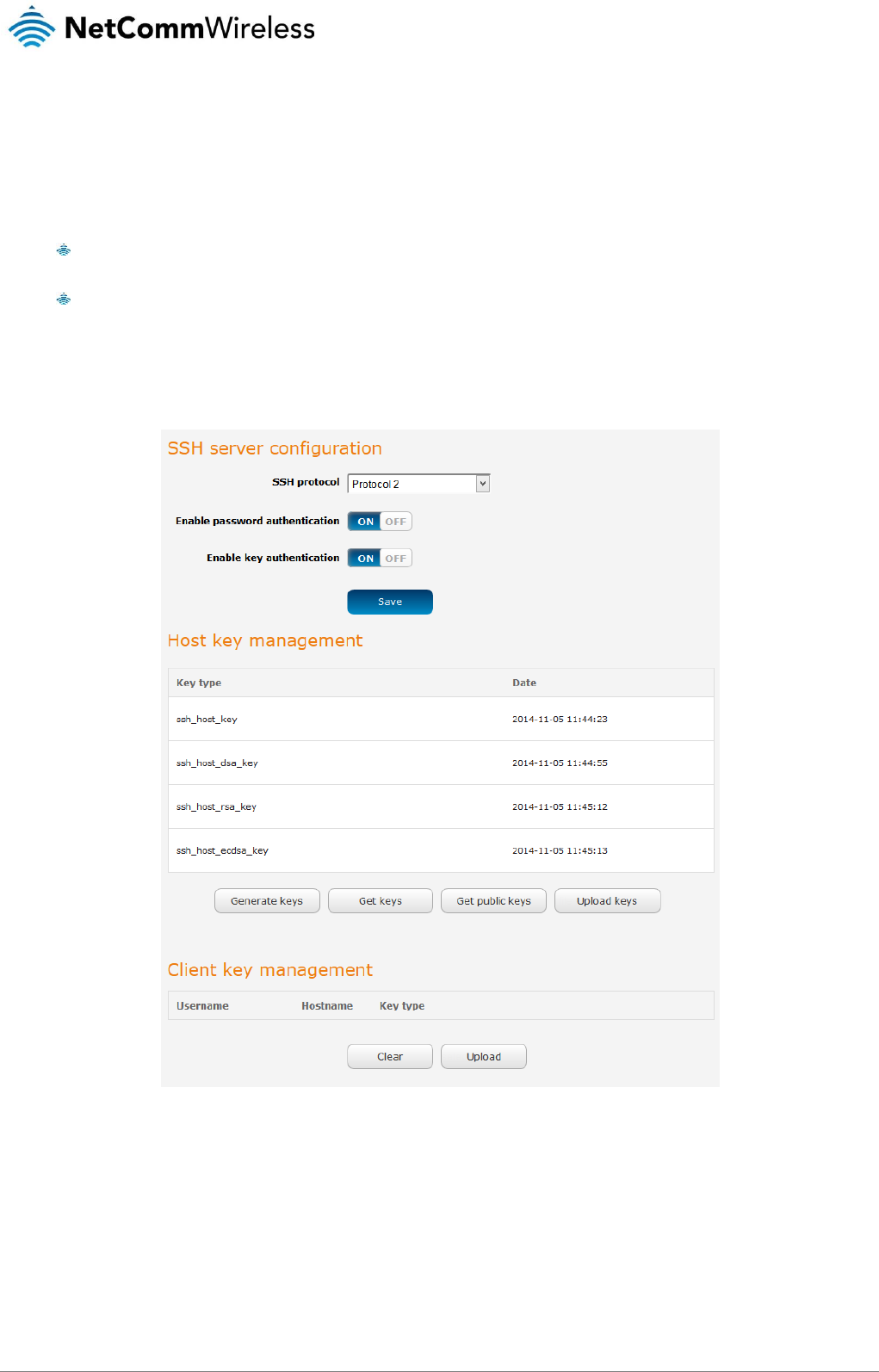
www.netcommwireless.com
NetComm Wireless 4G M2M Router
121
v1.0
SSH key management
Secure Shell (SSH) is UNIX-based command interface and network protocol used to gain secure access to a remote computer,
execute commands on a remote machine or to transfer files between machines. It was designed as a replacement for Telnet and
other insecure remote shell protocols which send information, including passwords, as plain text.
SSH uses RSA public key cryptography for both connection and authentication. Two common ways of using SSH are:
Use automatically generated public-private key pairs to encrypt the network connection and then use password
authentication to log on.
Use a manually generated public-private key pair to perform the authentication and allow users or programs to log in
without using a password.
To access the SSH key management page, click on the System menu then the Administration menu on the left and then click on
SSH key management.
Figure 122 - SSH Server Configuration
SSH Server Configuration
To configure the SSH server settings:
1. Use the SSH Protocol drop down list to select the protocol that you want to use. Protocol 2 is more recent and is
considered more secure.
2. Select the types of authentication you want to use by clicking the Enable password authentication and Enable key
authentication toggle keys on or off. Note that you may have both authentication methods on but you may not turn them
both off.
3. Click the Save button to confirm your settings.
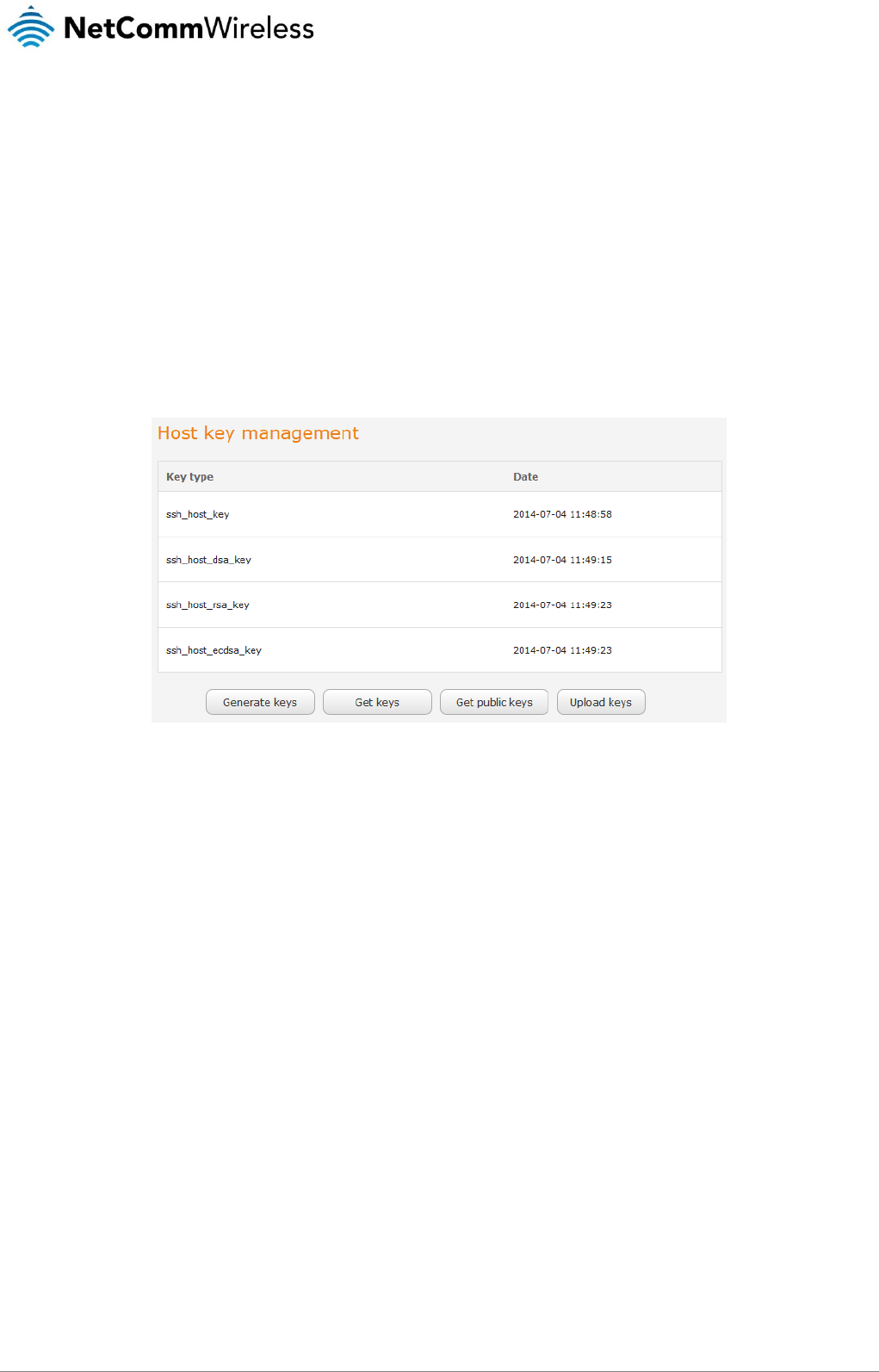
122
NetComm Wireless 4G M2M Router
www.netcommwireless.com
v1.0
Host key management
SSH keys provide a means of identification using public key cryptography and challenge response authentication. This means that a
secure connection can be established without transmitting a password, thereby greatly reducing the threat of someone
eavesdropping and guessing the correct credentials.
SSH Keys always come in pairs with one being a public key and the other a private key. The public key may be shared with any
server to which you want to connect. When a connection request is made, the server uses the public key to encrypt a challenge (a
coded message) to which the correct response must be given. Only the private key can decrypt this challenge and produce the
correct response. For this reason, the private key should not be shared with those who you do not wish to give authorization.
The Host key management section displays the current public keys on the router and their date and timestamp. These public keys
are provided in different formats, including DSA, RSA and ECDSA. Each format has advantages and disadvantages in terms of
signature generation speed, validation speed and encryption/decryption speed. There are also compatibility concerns to consider
with older clients when using ECDSA, for example.
Generating new keys
The complete set of keys can be re-generated by selecting the Generate keys button. This key generation process takes
approximately 30 seconds to complete.
Downloading keys
The Get keys button allows you to download the complete set of public and private keys while the Get public keys button will
download only the set of public keys.
Uploading your own key files
You can generate your own SSH keys and upload them to the router. To generate keys on a Linux-based machine, use the
following commands:
mkdir keys
cd keys
ssh-keygen -t rsa1 -f ssh_host_key -N ""
ssh-keygen -t dsa -f ssh_host_dsa_key -N ""
ssh-keygen -t rsa -f ssh_host_rsa_key -N ""
ssh-keygen -t ecdsa -f ssh_host_ecdsa_key -N ""
zip -e -P "PASSWORDHERE" -j keys.zip *
Click the Upload keys button then locate the generated keys to upload them to the router.
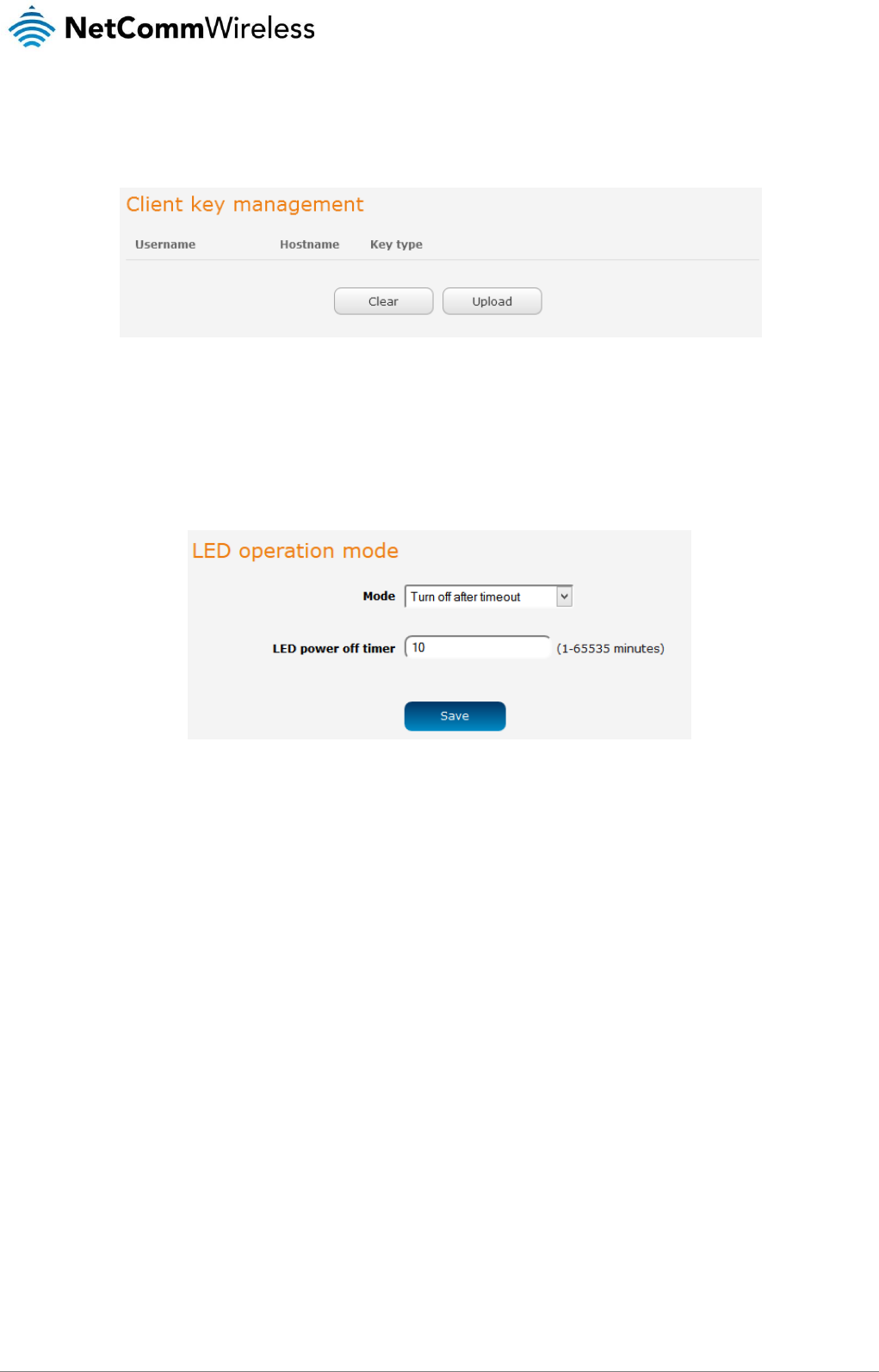
www.netcommwireless.com
NetComm Wireless 4G M2M Router
123
v1.0
Client key management
The Client Key Management section is used for uploading the public key file of clients. To upload a client public key, click the
Upload button, browse to the file and click Open.
When the file is uploaded, it is examined for validity. If the key file is not a valid public key, it will not be uploaded.
LED operation mode
The 8 front LED indicators may be turned off after a timeout period for aesthetic or power saving reasons. To access the LED
Operation Mode page, click the System menu, then Administration on the left and finally select LED Operation Mode.
Figure 123 - LED Operation Mode
The Mode drop down list sets the operation mode of the LEDs on the front panel of the router. To set the lights to operate at all
times, set this to Always on. To set the lights to turn off after a specified period, select Turn off after timeout. When configured to
turn off after timeout, use the LED power off timer field to specify the time in minutes to wait before turning off the LED indicators.
The LED Power Off Timer must be an integer between 1 and 65535.
The wait period begins from the time the Save button is clicked. When the wait period expires, the LEDs will turn off. If the router is
rebooted, the LED power off timer is reset. The router will boot up and wait for the configured time before turning off again.
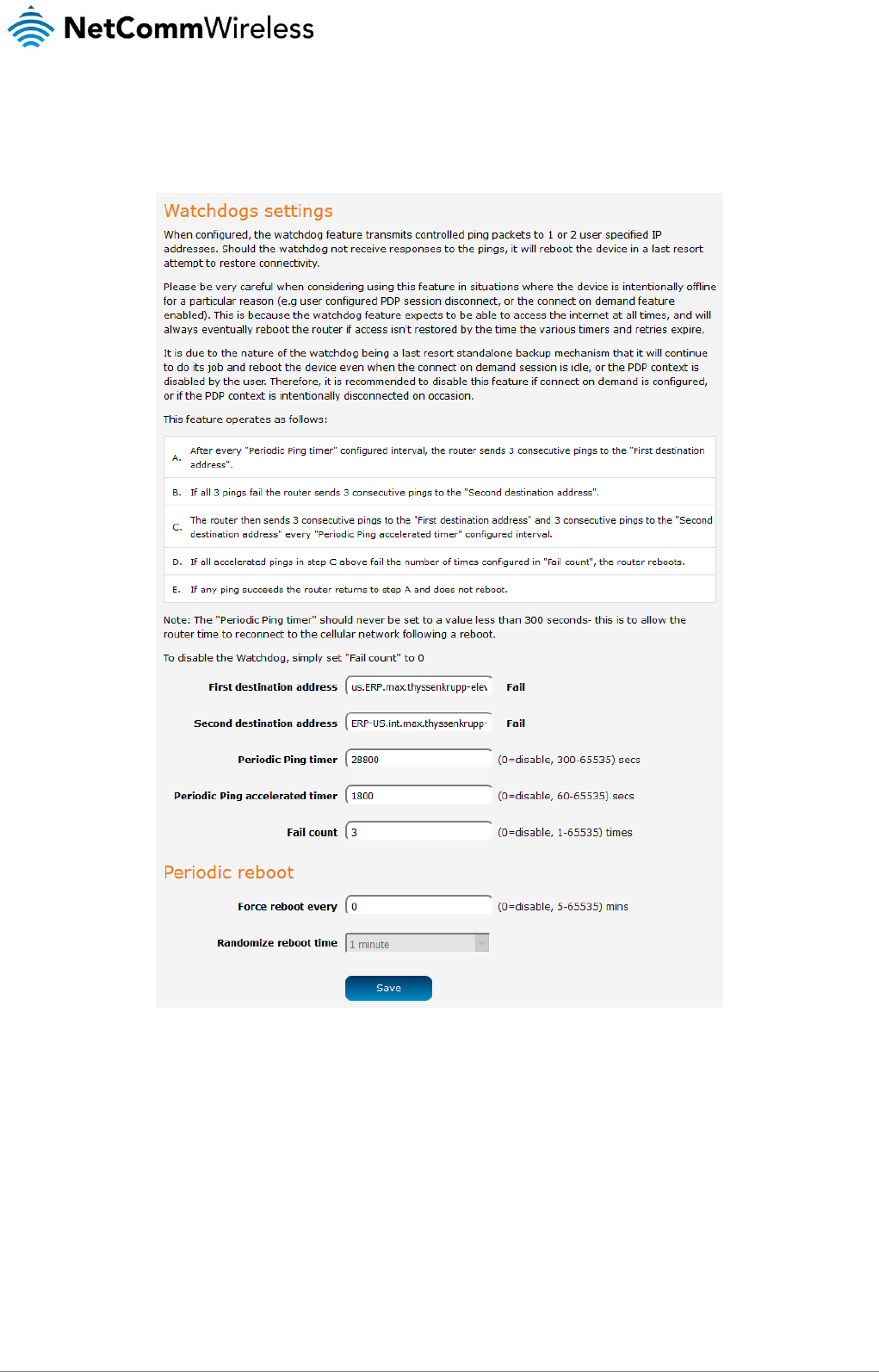
124
NetComm Wireless 4G M2M Router
www.netcommwireless.com
v1.0
Watchdogs
To access the Watchdogs page, click the System menu item, then select the Watchdogs menu item on the left.
Figure 124 - Watchdogs Settings
Watchdogs are features which monitor the router for anomalies and restart the router if an anomaly occurs preventing its normal
operation. When configured, the watchdogs feature transmits controlled ping packets to 1 or 2 user specified IP addresses to
confirm an active connection. If the watchdog does not receive responses to the pings after a specified number of failures, it will
reboot the device in a last resort attempt to restore connectivity.
We recommend using caution when implementing this feature in situations where the device is intentionally offline for a particular
reason, for example, when Connect-on-demand has been enabled. This is because the watchdog expects to be able to access the
internet at all times, and will always eventually reboot the router if access isn't restored by the time the various timers expire and the
fail count is reached.
It is due to the nature of the watchdog being a last resort standalone backup mechanism that it will continue to do its job and
reboot the device even when the Connect-on-demand session is idle, or the PDP context is disabled by the user. Therefore, we
recommended that you disable this feature if Connect-on-demand is configured or if the PDP context is intentionally disconnected
on occasion.
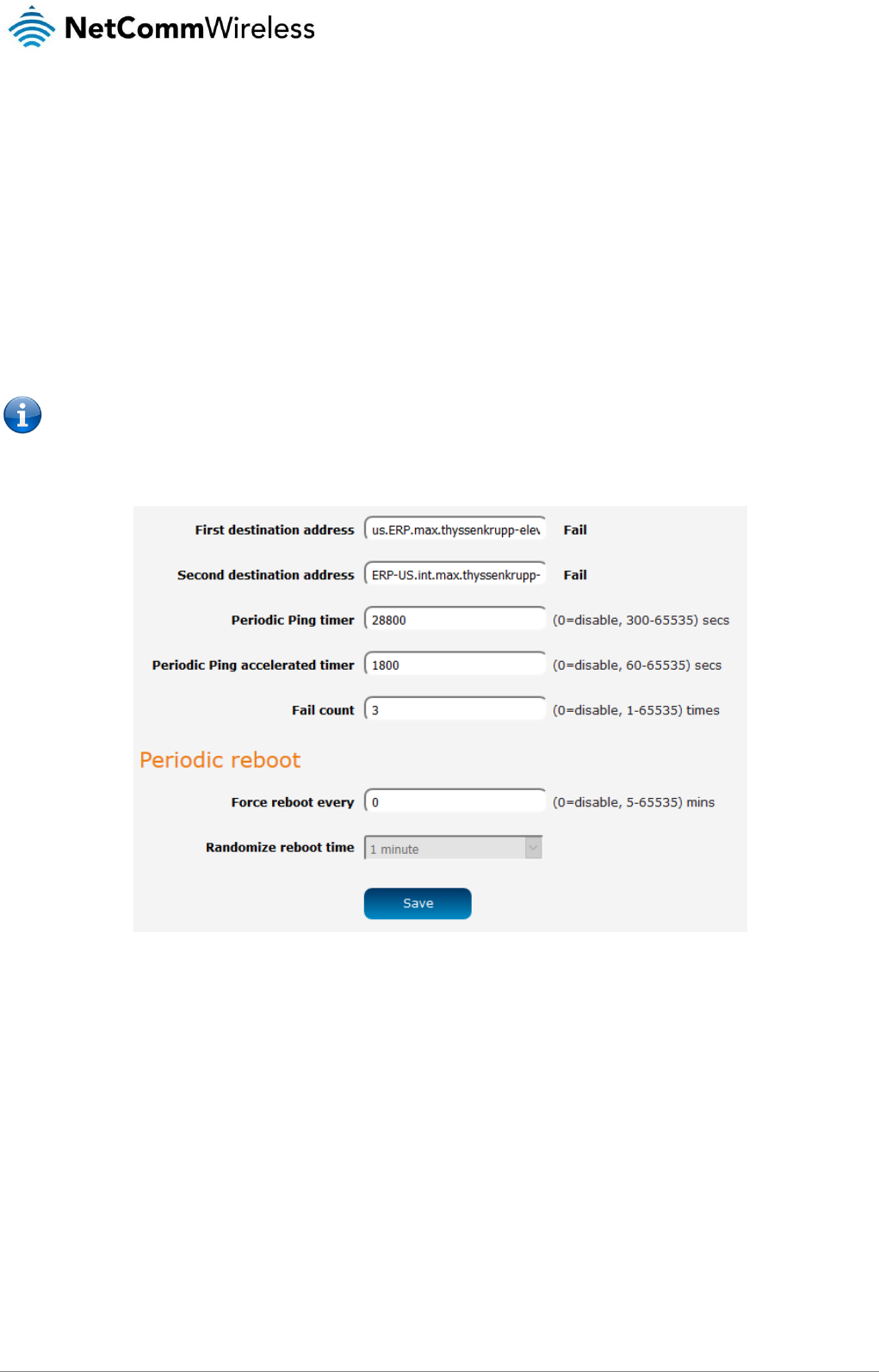
www.netcommwireless.com
NetComm Wireless 4G M2M Router
125
v1.0
The watchdog works as follows:
a) The router sends 3 consecutive pings to the first destination address at the interval specified in the Periodic Ping timer
field.
b) If all 3 pings to the first destination address fail, the router sends 3 consecutive pings to the second destination address at
the Periodic Ping timer interval.
c) If all 3 pings to the second destination address fail, the router sends 3 pings to the first destination address using the
Periodic Ping accelerated timer interval.
d) If all 3 accelerated pings to the first destination address fail, the router sends 3 pings to the second destination address at
the Periodic Ping accelerated timer interval.
e) If all 3 accelerated pings to the second destination address fail, the router registers this as a fail and returns to step C.
f) When the number of failures reaches the number configured in the Fail count field, the router reboots. If any ping
succeeds, the router returns to step A and does not reboot.
Note: The Periodic Ping timer should not be set to a value of less than 300 seconds to allow the router time to reconnect to
the cellular network following a reboot.
To disable the periodic ping reset monitor, set Fail count to 0.
Figure 125 – Ping watchdog settings

126
NetComm Wireless 4G M2M Router
www.netcommwireless.com
v1.0
Configuring Periodic Ping settings
The Periodic Ping settings configure the router to transmit controlled ping packets to 2 specified IP addresses. If the router does not
receive responses to the pings, the router will reboot.
To configure the ping watchdog:
1. In the First destination address field, enter a website address or IP address to which the router should send the first round
of ping requests.
2. In the Second destination address field, enter a website address or IP address to which the router should send the second
round of ping requests.
3. In the Periodic Ping timer field, enter an integer between 300 and 65535 for the number of seconds the router should wait
between ping attempts. Setting this to 0 disables the ping watchdog function.
4. In the Periodic Ping accelerated timer field, enter an integer between 60 and 65535 for the number of seconds the router
should wait between accelerated ping attempts, i.e. pings to the second destination address. Setting this to 0 disables the
ping watchdog function
5. In the Fail count field, enter an integer between 1 and 65535 for the number of times an accelerated ping should fail before
the router reboots. Setting this to 0 disables the ping watchdog function.
Disabling the Periodic Ping reset function
To disable the Periodic Ping reset function, set Fail count to 0.
Note: The traffic generated by the periodic ping feature is usually counted as chargeable data usage. Please keep this in
mind when selecting how often to ping.
Configuring a Periodic reboot
The router can be configured to automatically reboot after a period of time specified in minutes. While this is not necessary, it does
ensure that in the case of remote installations, the router will reboot if some anomaly occurs.
1. In the Force reboot every field, enter the time in minutes between forced reboots. The default value is 0 which disables the
Periodic reboot function. The minimum period between reboots is 5 minutes while the maximum value is 65535 minutes.
2. If you have configured a forced reboot time, you can use the Randomise reboot time drop down list to select a random
reboot timer. Randomising the reboot time is useful for preventing a large number of devices from rebooting
simultaneously and flooding the network with connection attempts. When configured, the router waits for the configured
Force reboot every time and then reboots after waiting for a random period that is less than or equal to the Randomise
reboot time setting.
3. Click the Save button to save the settings.
Note: The randomise reboot time is not persistent across reboots; each time the router is due to reboot, it randomly selects
a time less than or equal to the Randomise reboot time.
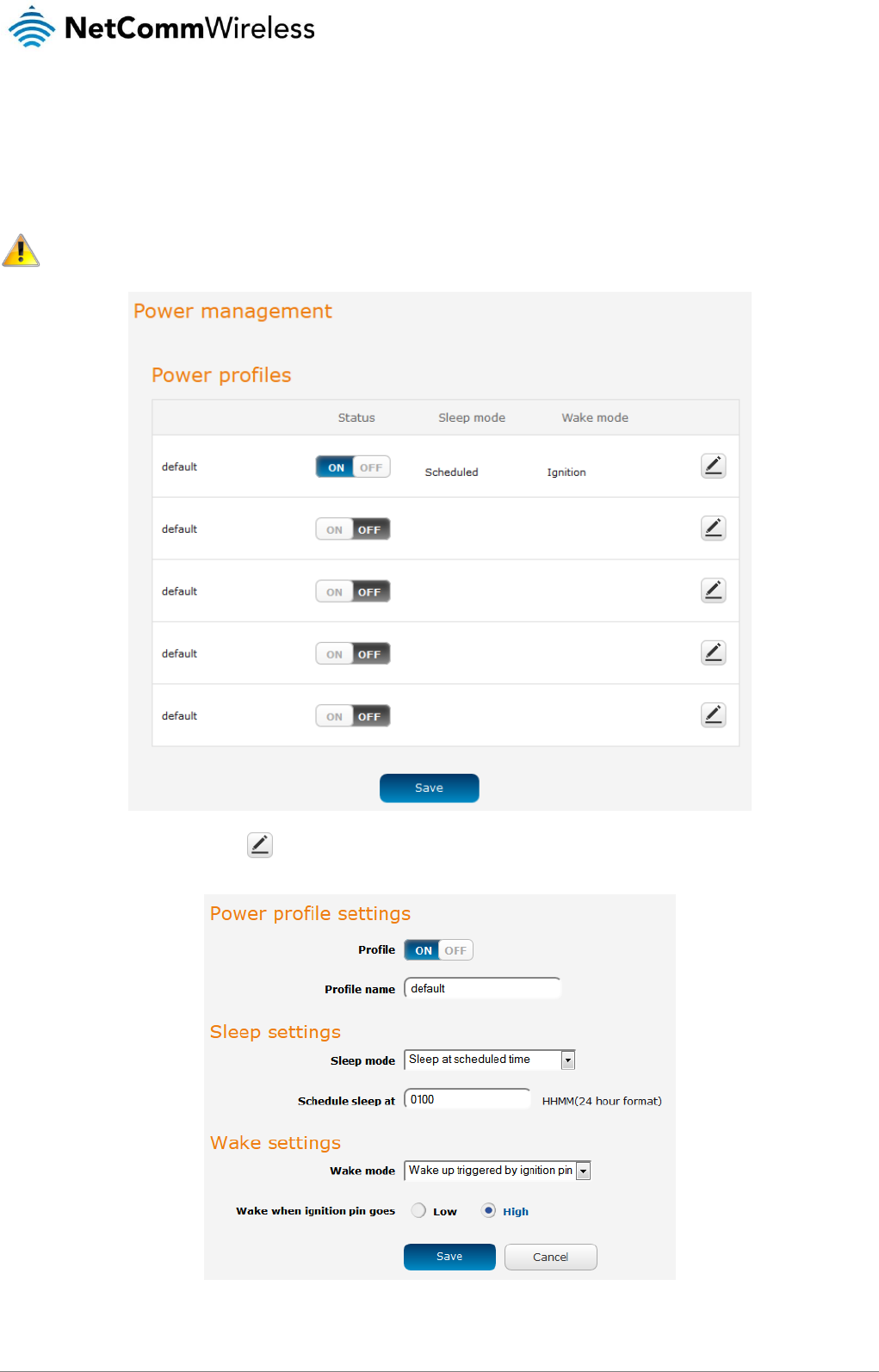
www.netcommwireless.com
NetComm Wireless 4G M2M Router
127
v1.0
Power management
The Power management page provides you with an overview of the power profiles and the ability to configure them. Up to five
power profiles may be configured and all of them may be active simultaneously. The Status column indicates whether the profile is
active, while the Sleep mode and Wake mode columns summarise the method used to sleep or wake the modem.
To access the Power management page, click the System menu item, then select the Power management menu item on the left.
Note: When configuring multiple power profiles, be careful so that they do not overlap or conflict with one another, for
example, configuring a schedule which wakes up the unit when another profile has it scheduled to be in low power mode.
Figure 126 - Power management
To edit a power profile, click the Edit icon of the appropriate profile.
Figure 127 - Power management - Power profile settings
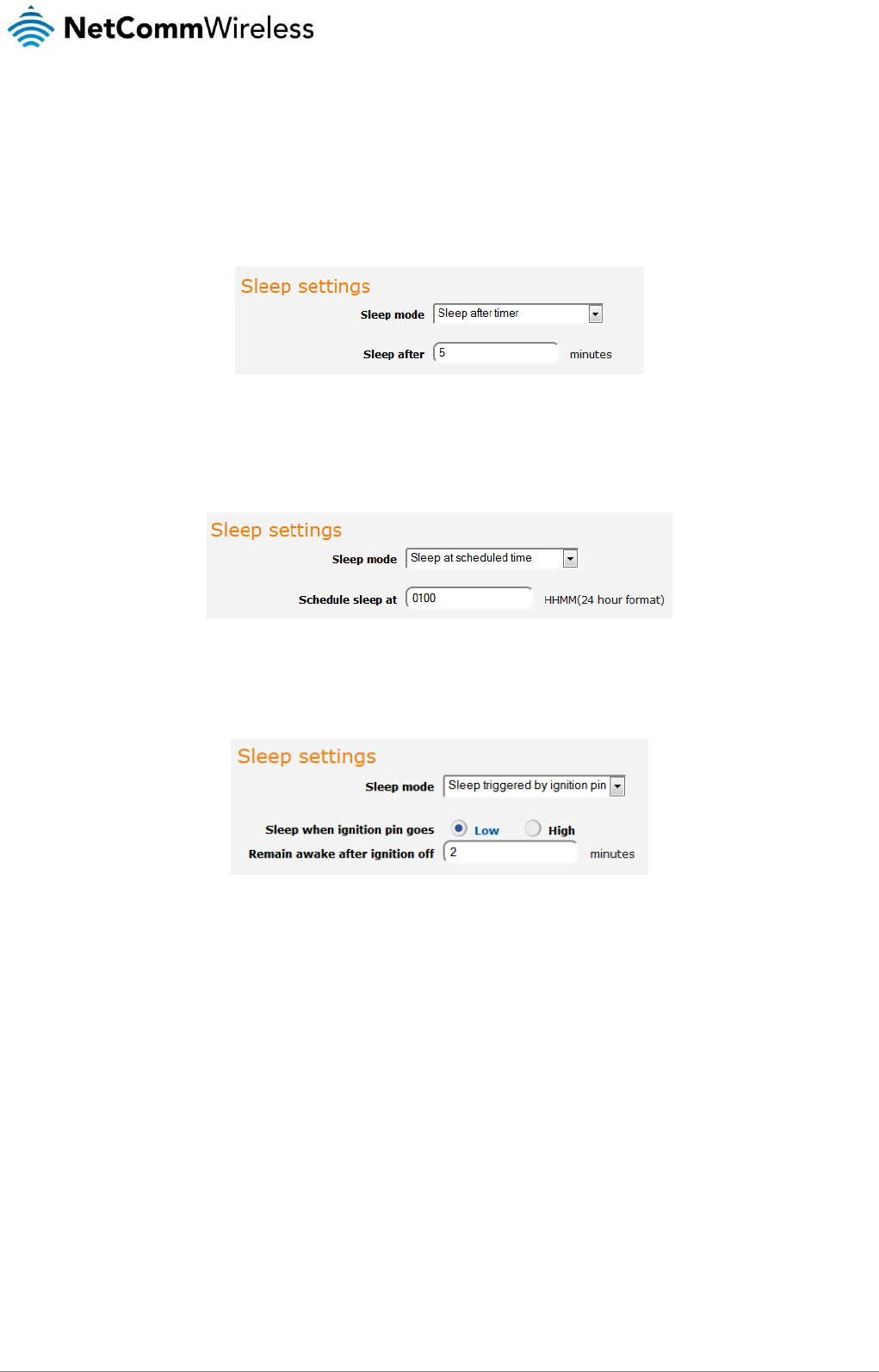
128
NetComm Wireless 4G M2M Router
www.netcommwireless.com
v1.0
Sleep settings
Use the Sleep mode drop down list to select a condition under which the router should enter the sleep state.
Sleep after timer
When this mode is selected, the router will enter the sleep state after the number of minutes specified in the Sleep after field,
regardless of the state of the ignition pin.
Figure 128 - Sleep after timer
Sleep at scheduled time
When this mode is selected, the router goes to sleep at the time specified in the Schedule sleep at field, regardless of the state of
the ignition pin. Enter the time in 24 hour format without the semi-colon.
Figure 129 - Sleep at scheduled time
Sleep triggered by ignition pin
This mode sets the router to enter sleep state when the signal on the ignition pin reaches the specified value.
Figure 130 - Sleep triggered by ignition pin
Use the Sleep when ignition pin goes setting to select Low or High. By default, this is set to Low. Additionally, the router will stay on
for the number of minutes specified in the Remain awake after ignition off field. The minimum value for this field is 2 minutes with the
maximum being 255 minutes.
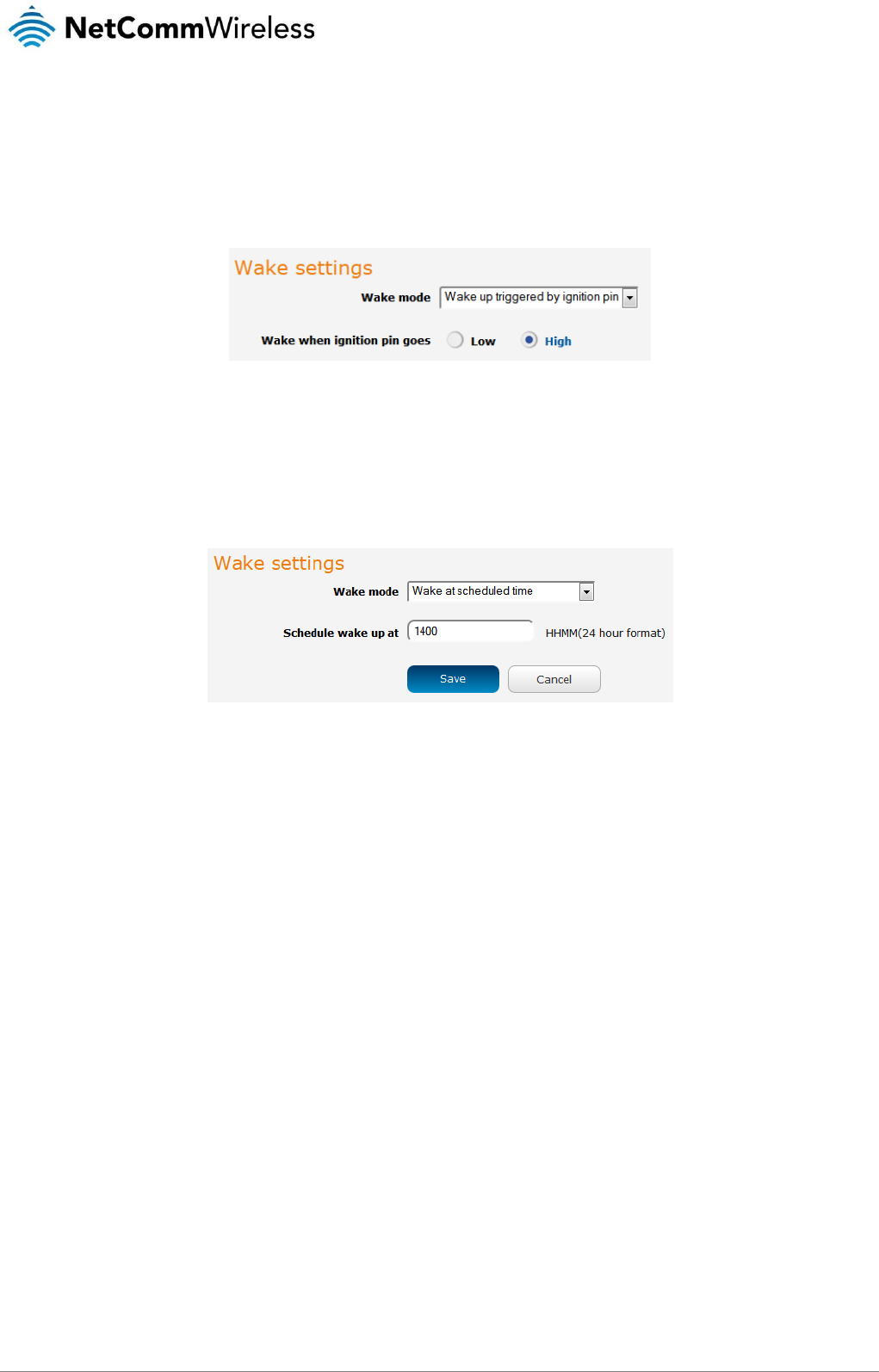
www.netcommwireless.com
NetComm Wireless 4G M2M Router
129
v1.0
Wake settings
Use the Wake mode drop down list to select a condition under which the router should return from the sleep state.
Wake triggered by ignition pin
This mode sets the router to wake up when the signal on the ignition pin reaches the specified value.
Figure 131 - Wake up triggered by ignition pin
Use the Wake up when ignition pin goes setting to select Low or High. By default, this is set to High.
Wake up at scheduled time
When this mode is selected, the router wakes up at the time specified in the Schedule wake up at field, regardless of the state of
the ignition pin. Enter the time in 24 hour format without the semi-colon.
Figure 132 - Wake up at scheduled time
Enter the time in seconds to wait before returning from sleep state in the Always wake up after field. A setting of 0 means that the
router will automatically wake from sleep state immediately.

130
NetComm Wireless 4G M2M Router
www.netcommwireless.com
v1.0
USB-OTG
The USB-OTG page displays the current status of the USB port, i.e. whether it is in Device mode or Host mode. By default,
Automatic mode is set to ON, allowing the router to intelligently choose the correct mode. If you wish to manually override this
selection, you can turn off Automatic mode and set Host or Device mode yourself.
To access the USB OTG page, click the System menu item, then select the USB OTG menu item on the left.
Figure 133 - USB-OTG configuration
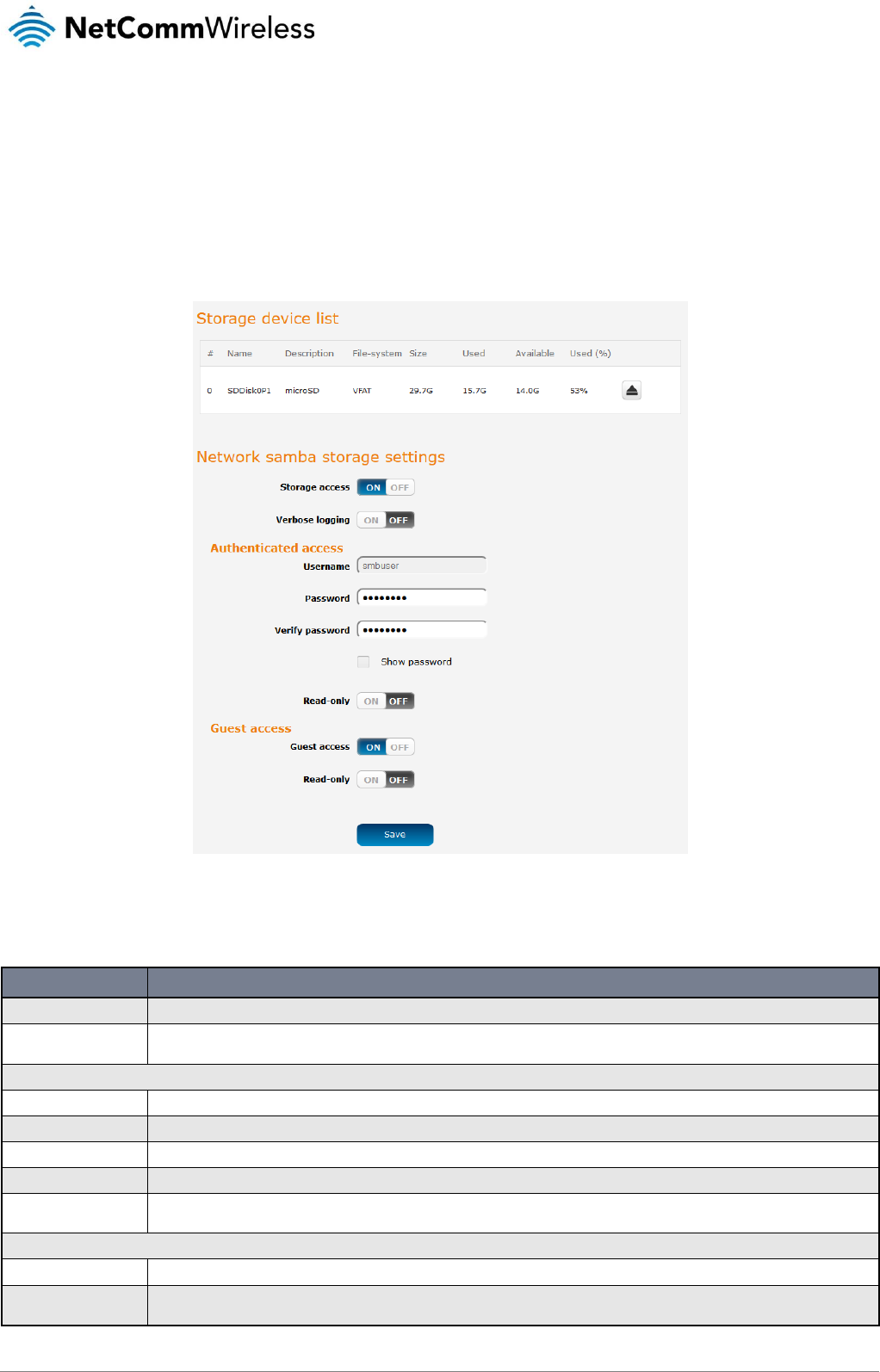
www.netcommwireless.com
NetComm Wireless 4G M2M Router
131
v1.0
Storage
The Storage page provides configuration options with relation to USB and SD storage devices. To access the Storage page, click
the System menu item, then select the Storage menu item on the left.
Storage device list
The Storage devices list displays any connected storage devices and summarises the type, file system, size, used and available
space on each device. Additionally, an eject button is provided to unmount the storage device so you can safely remove it.
Figure 134 - Storage
Network Samba storage settings
Storage devices connected to the router can be shared using the Samba protocol. The table below describes the configuration
options for the Network Samba storage settings.
ITEM
DEFINITION
Storage access
Turns the Samba sharing function on or off.
Verbose logging
When turned on, this provides additional logging data in the system log. This should generally only be used when debugging to avoid
generating excessively long logs.
Authenticated access
Username
The username to be used for authenticated access to the storage device. This is configured as ‘smbuser’ and cannot be changed.
Password
The password to be used for authenticated access to the storage device.
Verify password
The password to be used for authenticated access to the storage device.
Show password
Displays the passwords in the authenticated access fields.
Read-only
When turned on, this provides read-only access to the files on the connected storage device(s). When read-only access for authenticated
accounts is turned on, the guest access read-only option is hidden and guests are permitted read-only access also.
Guest access
Guest access
Enables or disables guest access to the storage device.
Read-only
When turned on, this provides read-only access to the files on the connected storage device(s) for guest users. If the authenticated
account has Read-only enabled then this option is not available and read-only access is automatically granted to guest users.
Table 40 - Network Samba storage settings
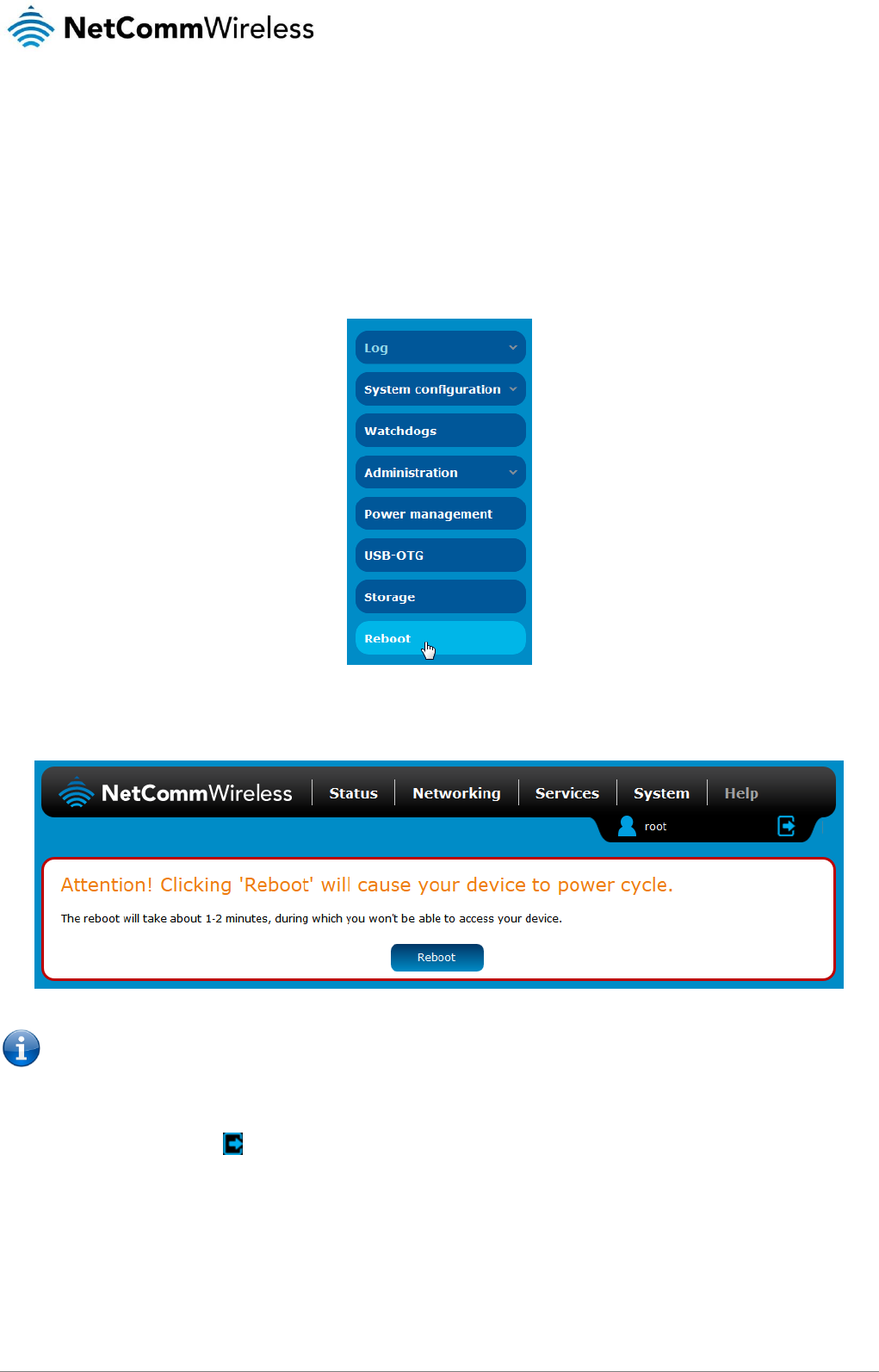
132
NetComm Wireless 4G M2M Router
www.netcommwireless.com
v1.0
Reboot
The reboot option in the System section performs a soft reboot of the router. This can be useful if you have made configuration
changes you want to implement.
To reboot the router:
1. Click the System menu item from the top menu bar.
2. Click the Reboot button from the menu on the left side of the screen.
Figure 135 - Reboot menu option
3. The router displays a warning that you are about to perform a reboot. If you wish to proceed, click the Reboot button then
click OK on the confirmation window which appears.
Figure 136 - Reboot confirmation
Note: It can take up to 2 minutes for the router to reboot.
Logging out
To log out of the router, click the icon at the top right corner of the web user interface.

www.netcommwireless.com
NetComm Wireless 4G M2M Router
133
v1.0
Appendix A: Tables
Table 1 - Document Revision History ............................................................................................................................................... 3
Table 2 - Device Dimensions ............................................................................................................................................................ 8
Table 3 - LED Indicators .................................................................................................................................................................. 9
Table 4 - Signal strength LED descriptions ..................................................................................................................................... 10
Table 5 - Ethernet port LED indicators description.......................................................................................................................... 11
Table 6 – Interfaces........................................................................................................................................................................ 12
Table 7 - Locking power block pin outs .......................................................................................................................................... 18
Table 8 - Management account login details – Root manager ........................................................................................................ 19
Table 9 - Management account login details – Admin manager ...................................................................................................... 19
Table 10 - Status page item details ................................................................................................................................................ 22
Table 11 - Data connection item details ......................................................................................................................................... 24
Table 12 - Connect on demand - Connect and disconnect timers descriptions .............................................................................. 29
Table 13 - Ethernet group configuration items ................................................................................................................................ 40
Table 14 - Ethernet WAN configuration options .............................................................................................................................. 41
Table 15 - Failover configuration - Hardware link monitoring ........................................................................................................... 43
Table 16 - Failover configuration - Ping monitoring ......................................................................................................................... 44
Table 17 - Current MAC / IP / Port filtering rules in effect ................................................................................................................ 53
Table 18 - IPSec Configuration Items ............................................................................................................................................. 56
Table 19 - Modem emulator endpoint options ................................................................................................................................ 73
Table 20 – CSD endpoint options .................................................................................................................................................. 74
Table 21 – TCP connect-on-demand endpoint options .................................................................................................................. 75
Table 22 - Data stream applications ............................................................................................................................................... 77
Table 23 – OMA Lightweight M2M configuration options ................................................................................................................ 84
Table 24 - IO configuration options ................................................................................................................................................ 85
Table 25 - IO pin modes ................................................................................................................................................................ 86
Table 26 - Event notification configuration options .......................................................................................................................... 88
Table 27 - Event notification – event types ..................................................................................................................................... 88
Table 28 - Email client settings ....................................................................................................................................................... 90
Table 29 - SMS Setup Settings ...................................................................................................................................................... 92
Table 30 - Inbox/Outbox icons ....................................................................................................................................................... 94
Table 31 - SMS Diagnostic Command Syntax ................................................................................................................................ 99
Table 32 - List of basic SMS diagnostic commands ..................................................................................................................... 100
Table 33 - List of get/set commands ............................................................................................................................................ 102
Table 34 - List of basic SMS diagnostics RDB variables ............................................................................................................... 102
Table 35 - Network types returned by get plmnscan SMS command ........................................................................................... 103
Table 36 - Operator status codes returned by get plmnscan SMS command ............................................................................... 103
Table 37 - SMS diagnostics example commands ......................................................................................................................... 106
Table 38 - System log detail levels ............................................................................................................................................... 111
Table 39 - Administration configuration options ............................................................................................................................ 117
Table 40 - Network Samba storage settings ................................................................................................................................ 131
Table 41 - LAN Management Default Settings .............................................................................................................................. 134
Table 42 - Web Interface Default Settings .................................................................................................................................... 134
Table 43 - Telnet Access ............................................................................................................................................................. 134
Table 44 - RJ-45 connector pin outs ............................................................................................................................................ 141
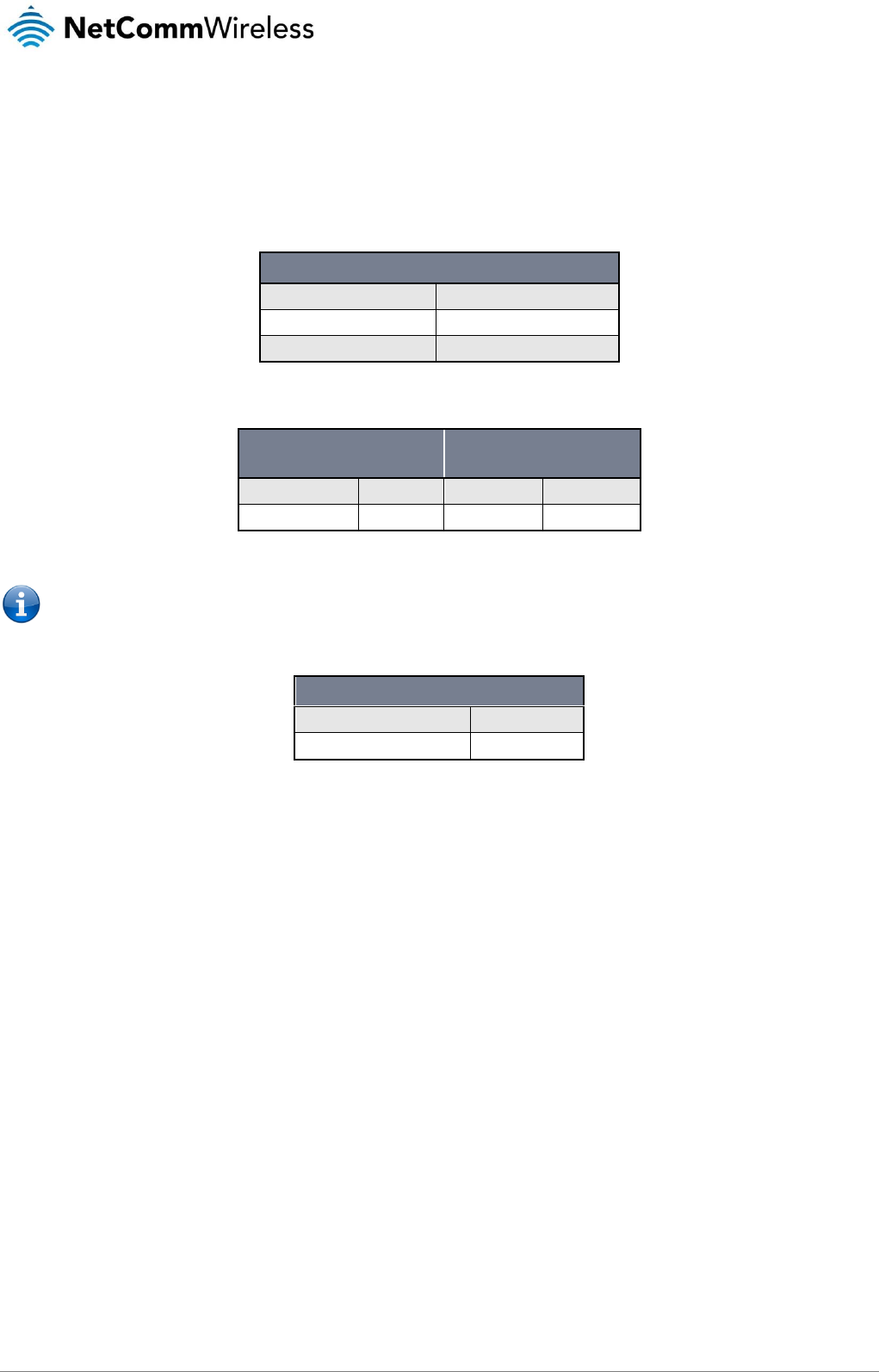
134
NetComm Wireless 4G M2M Router
www.netcommwireless.com
v1.0
Appendix B: Default Settings
The following tables list the default settings for the NTC-140-01 router.
LAN (MANAGEMENT)
Static IP Address:
192.168.0.1
Subnet Mask:
255.255.255.0
Default Gateway:
192.168.0.1
Table 41 - LAN Management Default Settings
ADMIN MANAGER
ACCOUNT
ROOT MANAGER
ACCOUNT
Username:
admin
Username:
root
Password:
tkemAx177a
Password:
tkemAx177a
Table 42 - Web Interface Default Settings
Note: The admin manager account allows you to manage all settings of the router except functions such as firmware
upgrade, device configuration backup and restore and reset to factory default settings, which are privileged only to the root
manager account.
NTC-140-01 ROUTER SSH ACCESS
Username:
root
Password:
tkemAx177a
Table 43 - Telnet Access

www.netcommwireless.com
NetComm Wireless 4G M2M Router
135
v1.0
Restoring factory default settings
Restoring factory defaults will reset the NTC-140-01 router to its factory default configuration. You may encounter a situation where
you need to restore the factory defaults on your NTC-140-01 router such as:
You have lost your username and password and are unable to login to the web configuration page;
You are asked to perform a factory reset by support staff.
There are two methods you can use to restore factory default settings on your NTC-140-01 router:
Using the web-based user interface
Using the reset button on the interface panel of the router
Using the web-based user interface
To restore your router to its factory default settings, please follow these steps:
1. Open a browser window and navigate to the IP address of the router (default address is http://192.168.1.1). Login to the
router using root as the User Name and admin as the password.
2. Click the System item from the top menu bar, then System configuration on the left menu and then click Settings backup
and restore.
3. Under the Restore factory defaults section, click the Restore defaults button. The router asks you to confirm that you wish
to restore factory defaults. Click OK to continue. The router sets all settings to default. Click OK again to reboot the router.
4. When the Power light returns to a steady red, the reset is complete. The default settings are now restored.
Using the reset button on the interface panel of the router
Use a pen to depress the Reset button on the device for 15-20 seconds. The router will restore the factory default settings and
reboot.
When you have reset your NTC-140-01 router to its default settings you will be able to access the device’s configuration web
interface using http://192.168.1.1 with username admin or root and password admin.
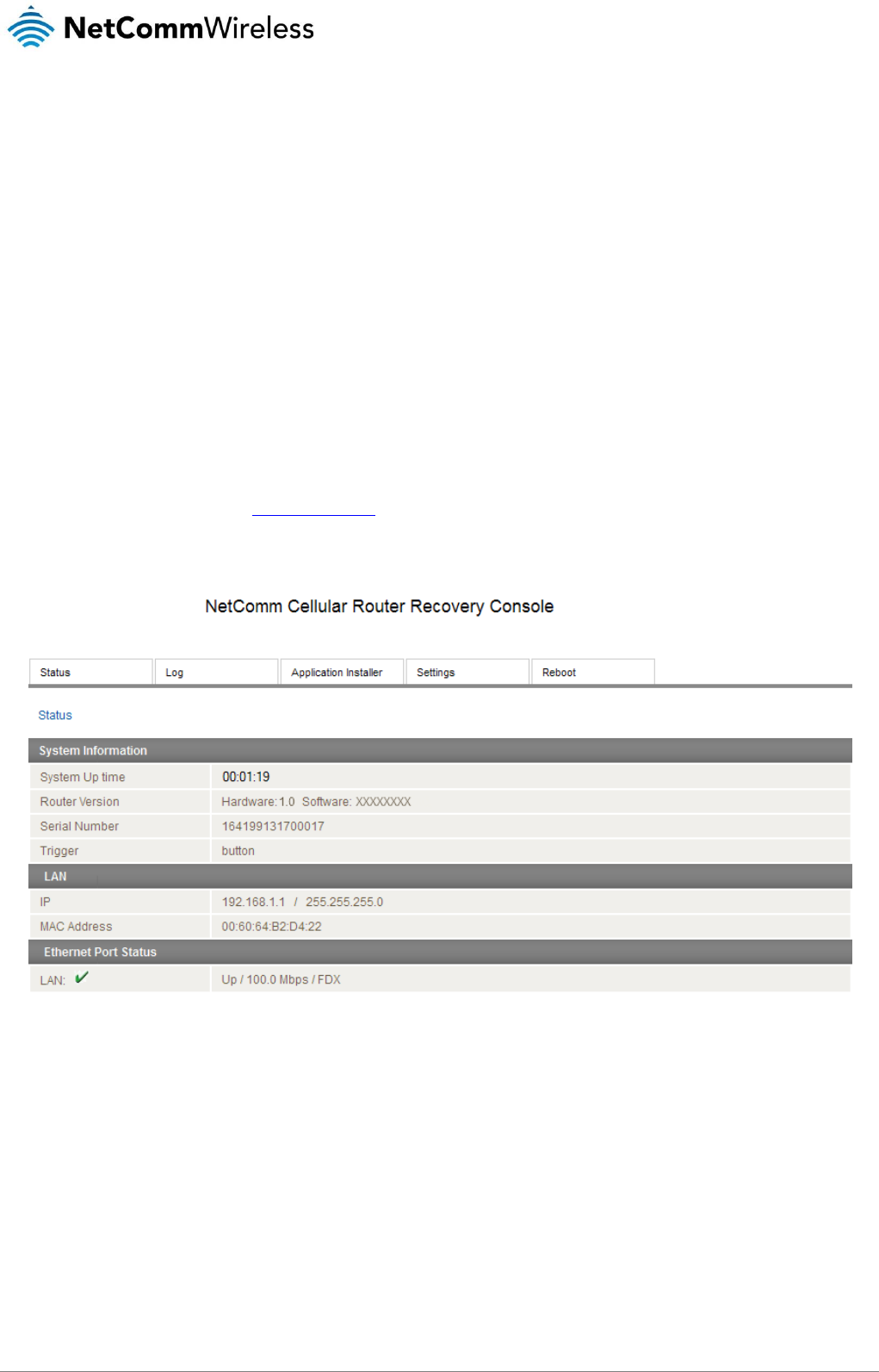
136
NetComm Wireless 4G M2M Router
www.netcommwireless.com
v1.0
Appendix C: Recovery mode
The NTC-140-01 Router features two independent operating systems, each with its own file systems. These two systems are
referred to as 'Main' and 'Recovery'. It is always possible to use one in order to restore the other in the event that one system
becomes damaged or corrupted (such as during a firmware upgrade failure). The recovery console provides limited functionality and
is typically used to restore the main firmware image in the case of a problem.
Accessing recovery mode
Both systems have web interfaces that can be used to manipulate the other inactive system. The NTC-140-01 Router starts up by
default in the Main system mode, however the router may be triggered to start in recovery mode if desired.
To start the router in recovery mode:
1. Press and hold the physical reset button on the interface panel of the router for 5 to 15 seconds. When the LEDs on the
front panel change to amber and countdown in a sequence, release the reset button. The router then boots into recovery
mode.
2. In your browser, navigate to http://192.168.1.1. The router’s recovery mode is hardcoded to use this address regardless
of the IP address that was configured in the main system. The router’s recovery console is displayed.
Figure 137 - Recovery console
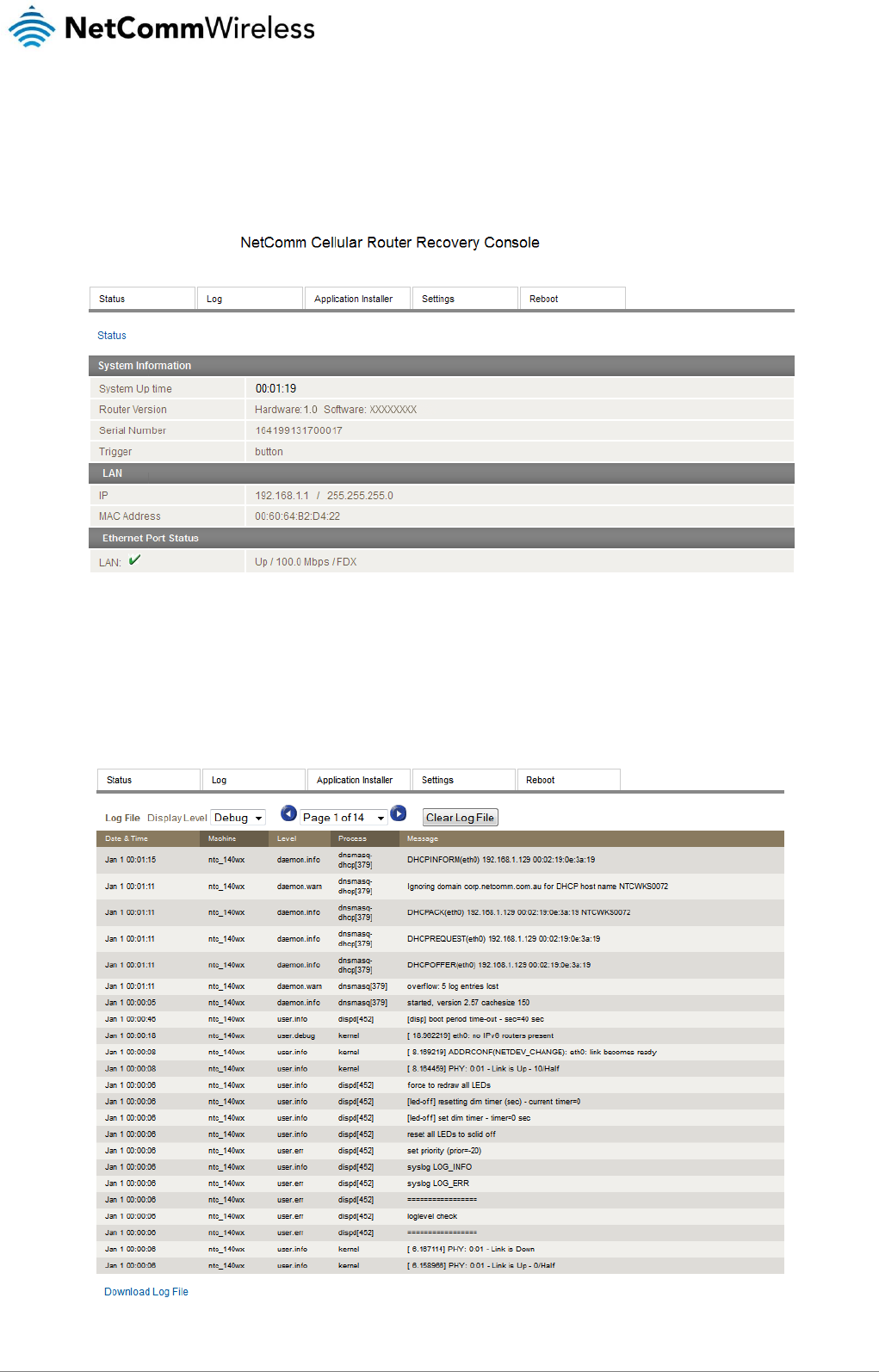
www.netcommwireless.com
NetComm Wireless 4G M2M Router
137
v1.0
Status
The status page provides basic information such as the system up time, hardware and software router versions, the router’s serial
number, the method used to trigger the recovery mode, the IP and MAC address of the router and the status of the Ethernet port.
Figure 138 - Recovery mode - Status
Log
The log page displays the system log which is useful in troubleshooting problems which may have led to the router booting up in
recovery mode. The only functionality provided here is the ability to clear the system log, filter by log level and downloading of the
log file.
Figure 139 - Recovery mode – Log
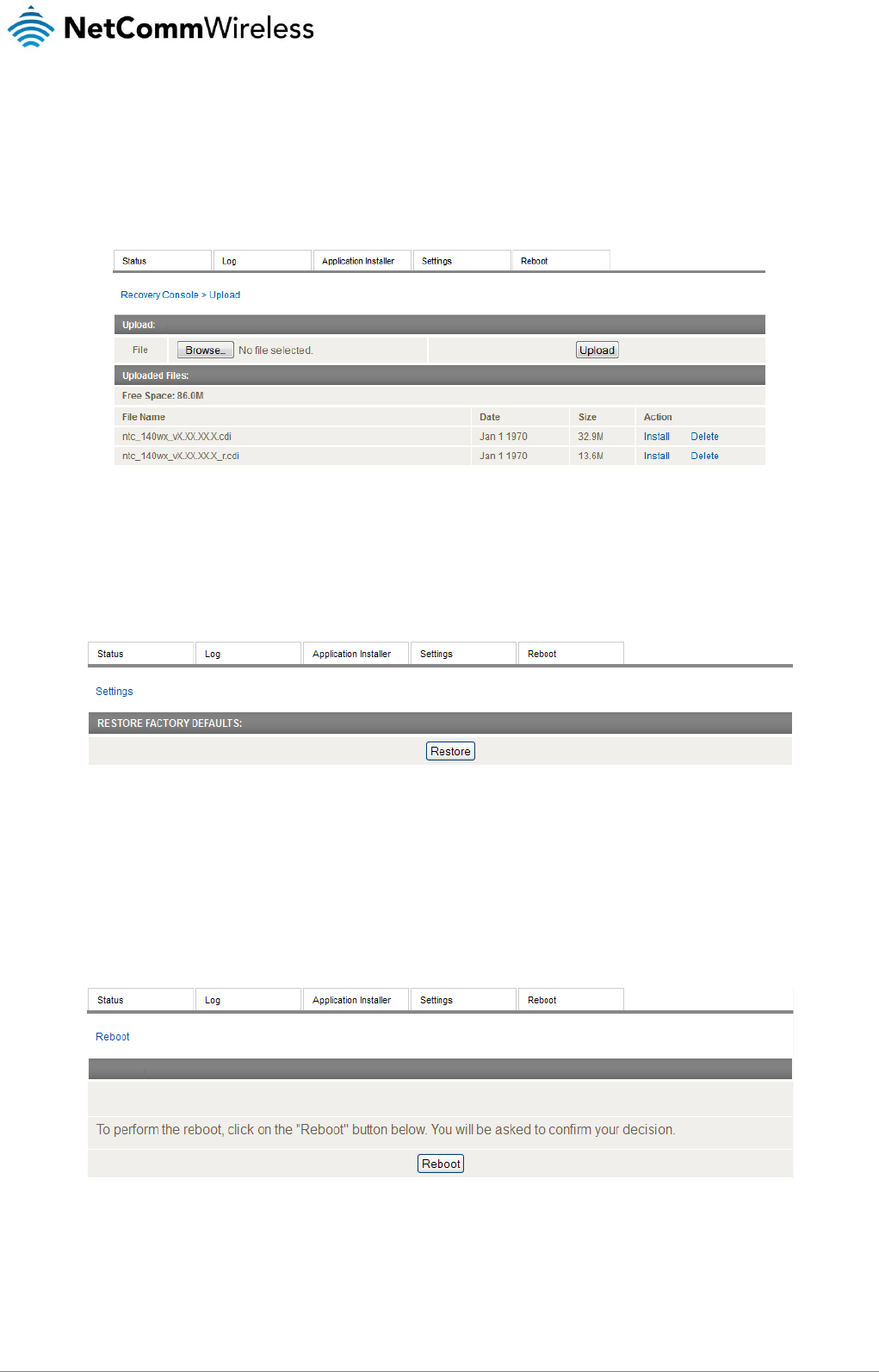
138
NetComm Wireless 4G M2M Router
www.netcommwireless.com
v1.0
Application Installer
The Application installer is designed to upload and install main firmware images, upload recovery firmware images, custom
applications and HTTPS certificates. Use the Browse button to select a file to be uploaded to the router. When it has been selected,
press the Upload button. The file is sent to the router and when the transfer is complete, the file appears in the Uploaded files list.
From the Uploaded files list, you are able to either Install or Delete a file.
Figure 140 - Recovery mode - Application Installer
Settings
The settings page provides the option of restoring the router to factory default settings. Click the Restore button to set the router
back to the original factory settings.
Figure 141 - Recovery mode – Settings
Reboot
The reboot page allows you to reboot the router when you have finished using recovery mode. When rebooting the router from
recovery mode, the router boots into the main firmware image unless there is some fault preventing it from doing so, in which case
the recovery console will be loaded.
Click the Reboot button to reboot the router to the main firmware image.
Figure 142 - Recovery mode - Reboot
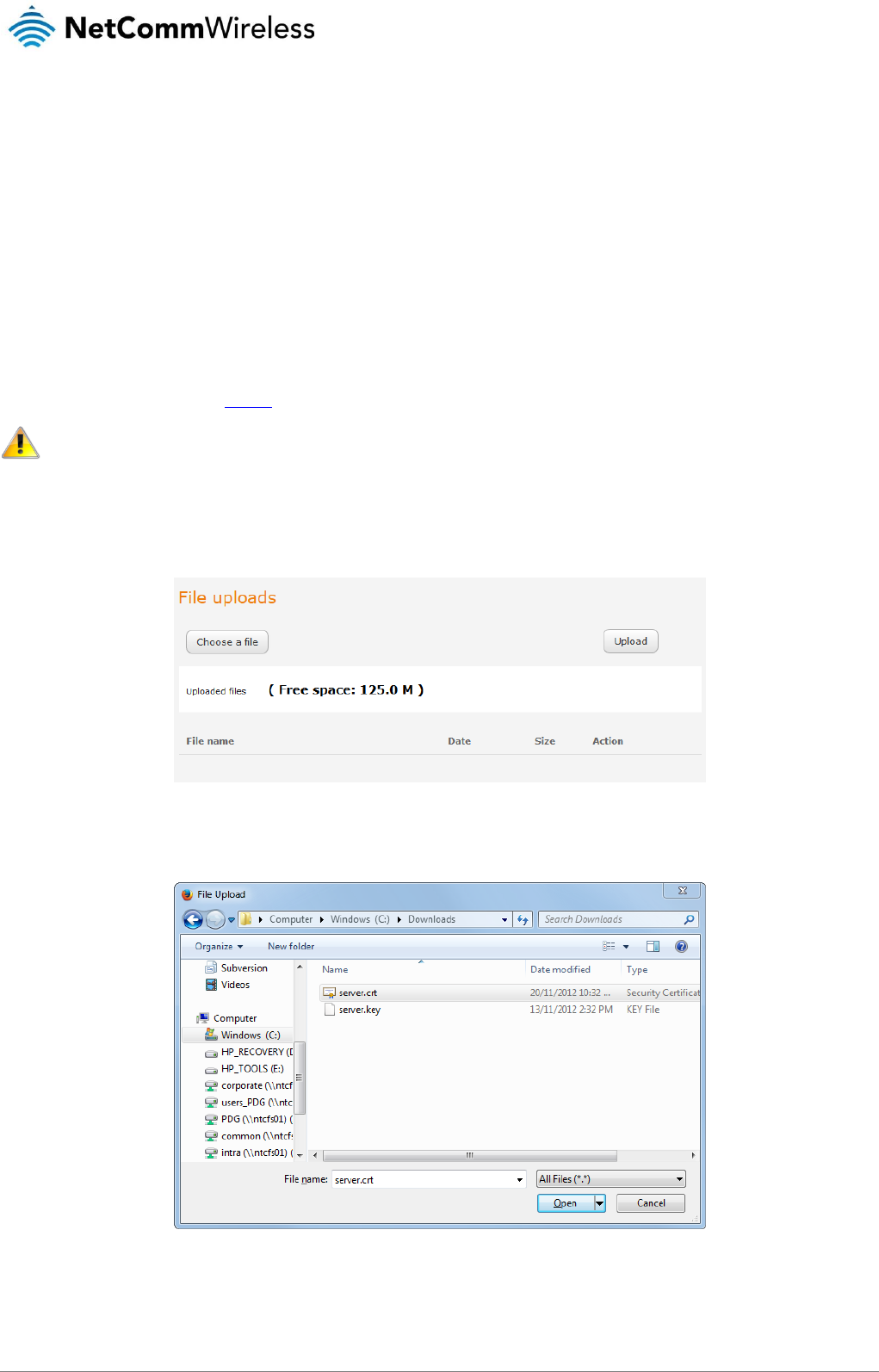
www.netcommwireless.com
NetComm Wireless 4G M2M Router
139
v1.0
Appendix D: HTTPS -
Uploading a self-signed
certificate
If you have your own self-signed certificate or one purchased elsewhere and signed by a Certificate Authority, you can upload it to
the NTC-140-01 router using the Upload page.
Note: Your key and certificate files must be named server.key and server.crt respectively otherwise they will not work.
To upload your certificate:
1. Click on the System item from the top menu bar. From the side menu bar, select System Configuration and then Upload.
The file upload screen is displayed.
Figure 143 - Upload page
2. Click the Choose a File button and locate your server certificate file and click Open.
Figure 144 - Browse for server.crt
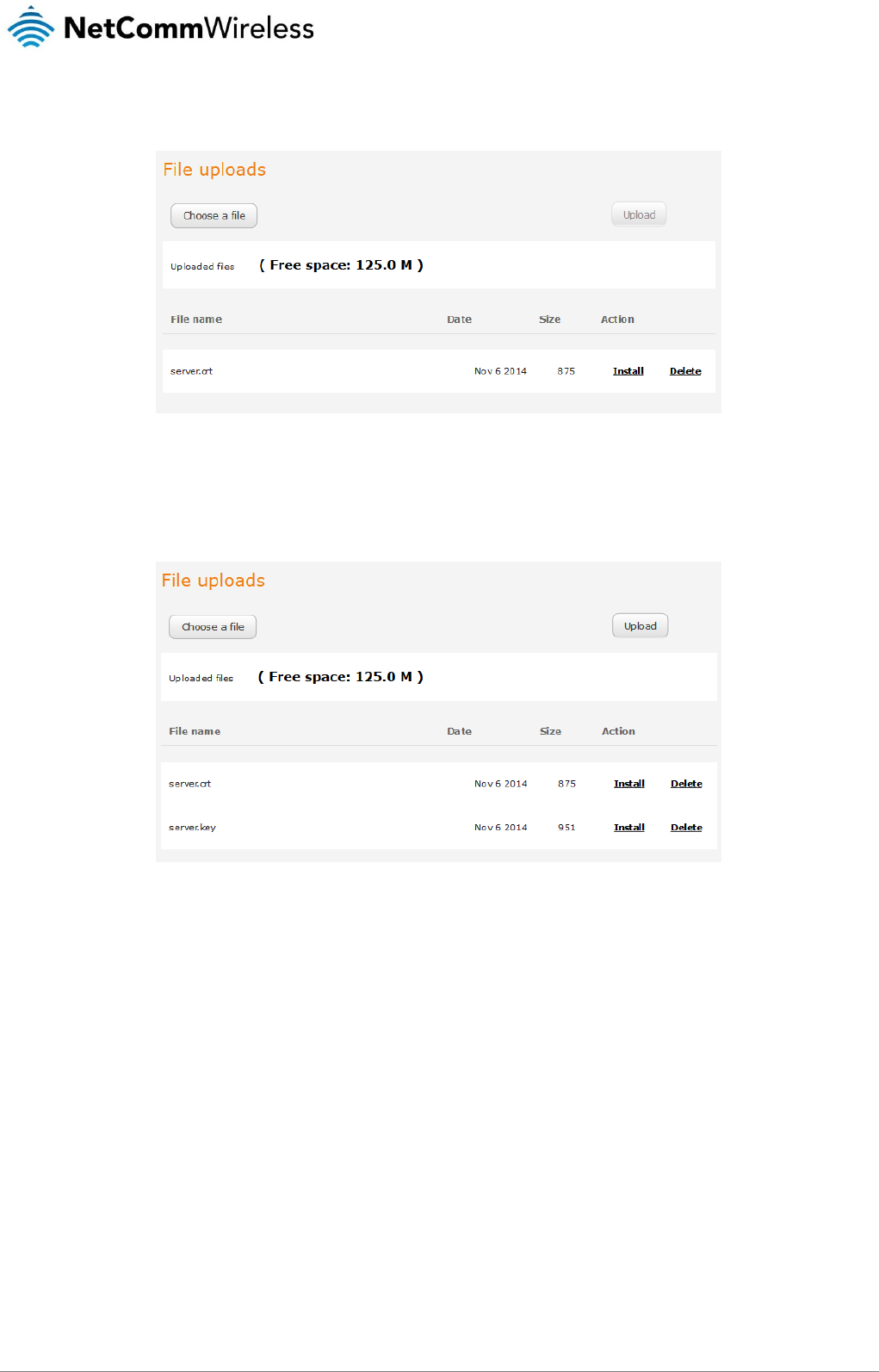
140
NetComm Wireless 4G M2M Router
www.netcommwireless.com
v1.0
3. Click the Upload button to begin uploading it to the router. The file appears in the list of files stored on the router.
Figure 145 - Server certificate file uploaded
4. Repeat steps 2 and 3 for the server key file.
5. Click the Install link next to the server.crt file then click OK on the prompt that is displayed. The certificate file is installed.
Repeat this for the key file. When each file is installed it is removed from the list of stored files.
Figure 146 - Installing the server.crt file
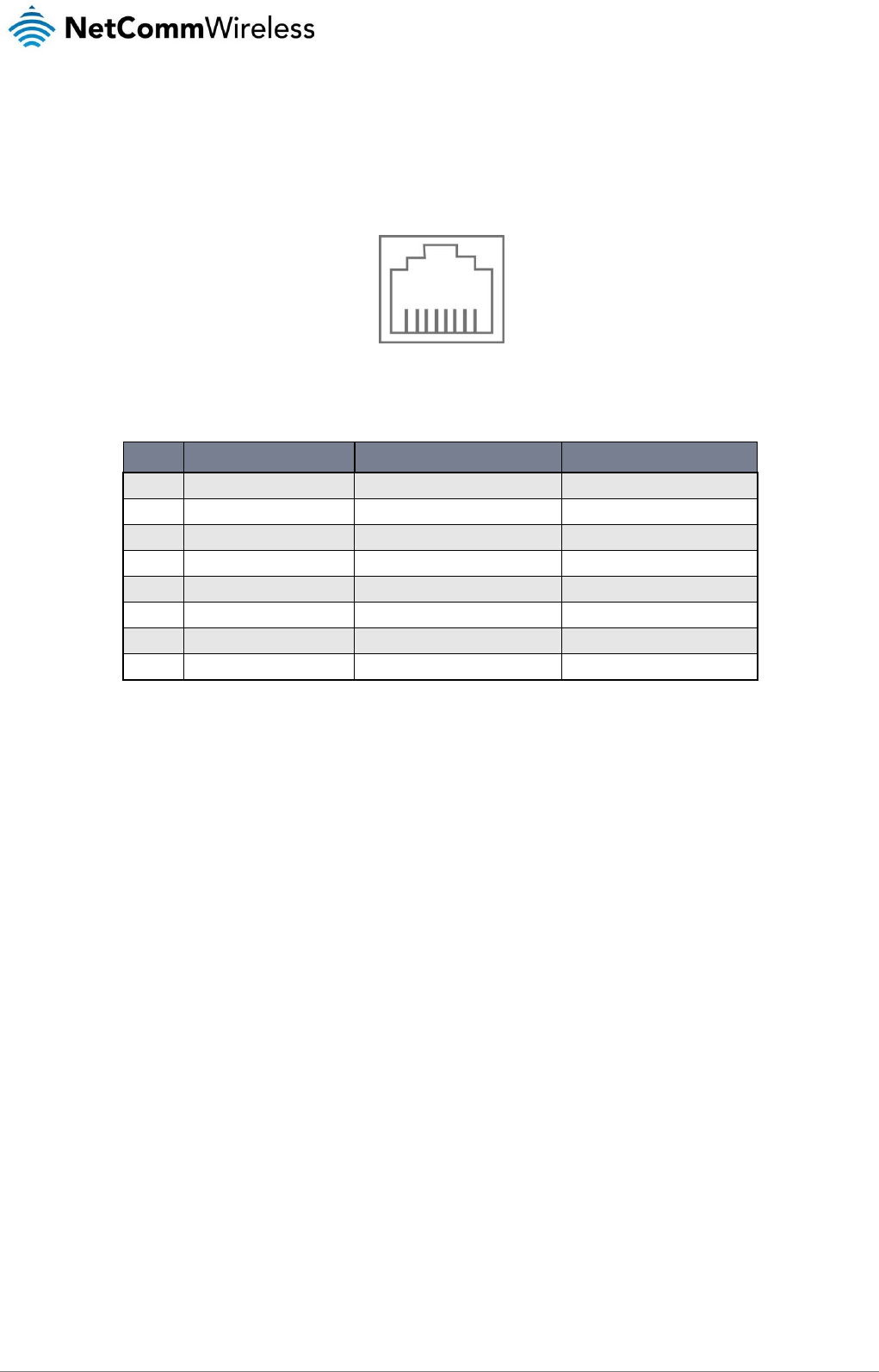
www.netcommwireless.com
NetComm Wireless 4G M2M Router
141
v1.0
Appendix E: RJ-45 connectors
The RJ-45 connectors provide an interface for a data connection and for device input power using the pin layout shown below.
Pin: 8 1
Figure 147 -The RJ-45 connector
PIN
COLOUR
SIGNAL (10/100)
SIGNAL (1000)
1
White/Orange stripe
Rx + DC +
+BI_DA
2
Orange Solid
Rx - DC +
-BI_DA
3
White/Green stripe
Tx + DC -
+BI_DB
4
Blue solid
unused
+BI_DC
5
White/Blue stripe
unused
-BI_DC
6
Green solid
Tx - DC -
-BI_DB
7
White/Brown stripe
unused
+BI_DD
8
Brown solid
unused
-BI_DD
Table 44 - RJ-45 connector pin outs
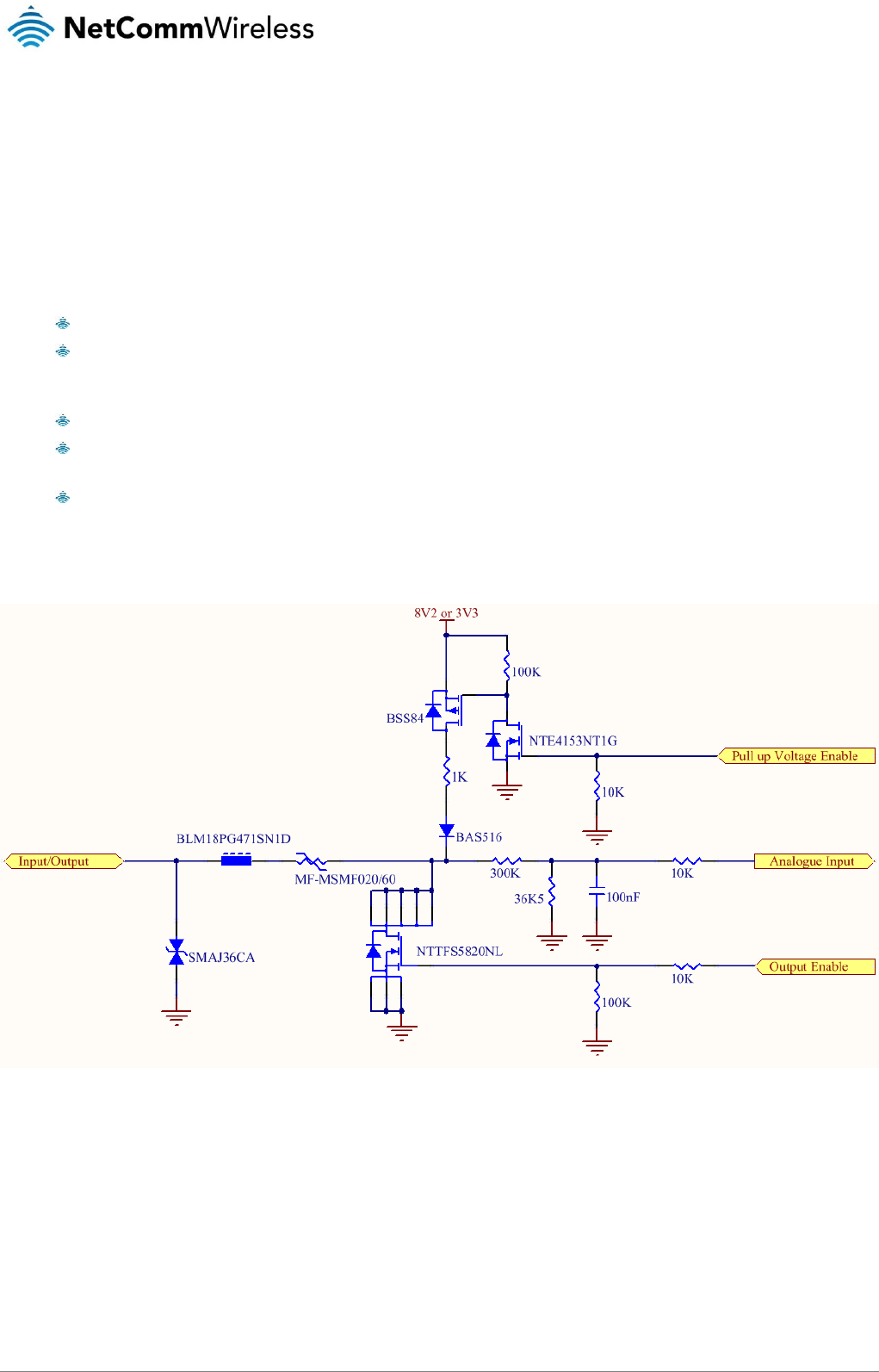
142
NetComm Wireless 4G M2M Router
www.netcommwireless.com
v1.0
Appendix G: Input/Output
Overview
The NTC-140-01 router is equipped with a 2 x 2 Molex connector providing a multipurpose input and output terminal as well as a
dedicated ignition input. The I/O terminal may be independently configured for various functions, including:
NAMUR (EN 60947-5-6 / IEC 60947-5-6) compatible sensor input
Proximity sensor input for use with contact closure (open/closed) type of sensors (PIR sensors, door/window sensors
for security applications) with the input tamper detection possible (four states detected: open, closed, short and break)
by the use of external resistors
Analogue 0V to 30V input
Digital input (the I/O voltage measured by the Analogue input and the software making a decision about the input state)
with the threshold levels configurable in software
Open collector output.
Hardware Interface
The interface of the input/output terminals are based on the circuit diagram below
The Input/Output label is the physical connection to the outside world. There are protection devices and resistor dividers to
condition the signal prior to it going into the processor. The three labels to the right are the interface to the processor. Output
Enable activates the Transistor which provides an open collector (ground) output and can sink 200mA at 230C. It is protected by a
resettable fuse and transient protection diode. If used with the pull up resistor, which can be activated by the Pull up Voltage Enable
pin, then you can have a High or Low output rather than open drain. The resistor can be pulled up to 3V3 for Cmos compatible
output or 8.2V by software. The Analogue Input pin can read values from 0V to 30V. It is divided by a resistor network to read
appropriate levels in the processor. Depending on the sensor type used, the pull up resistor can be switched on or off. If using the
NAMUR sensor configuration the pull up will be activated to 8V2 by default.
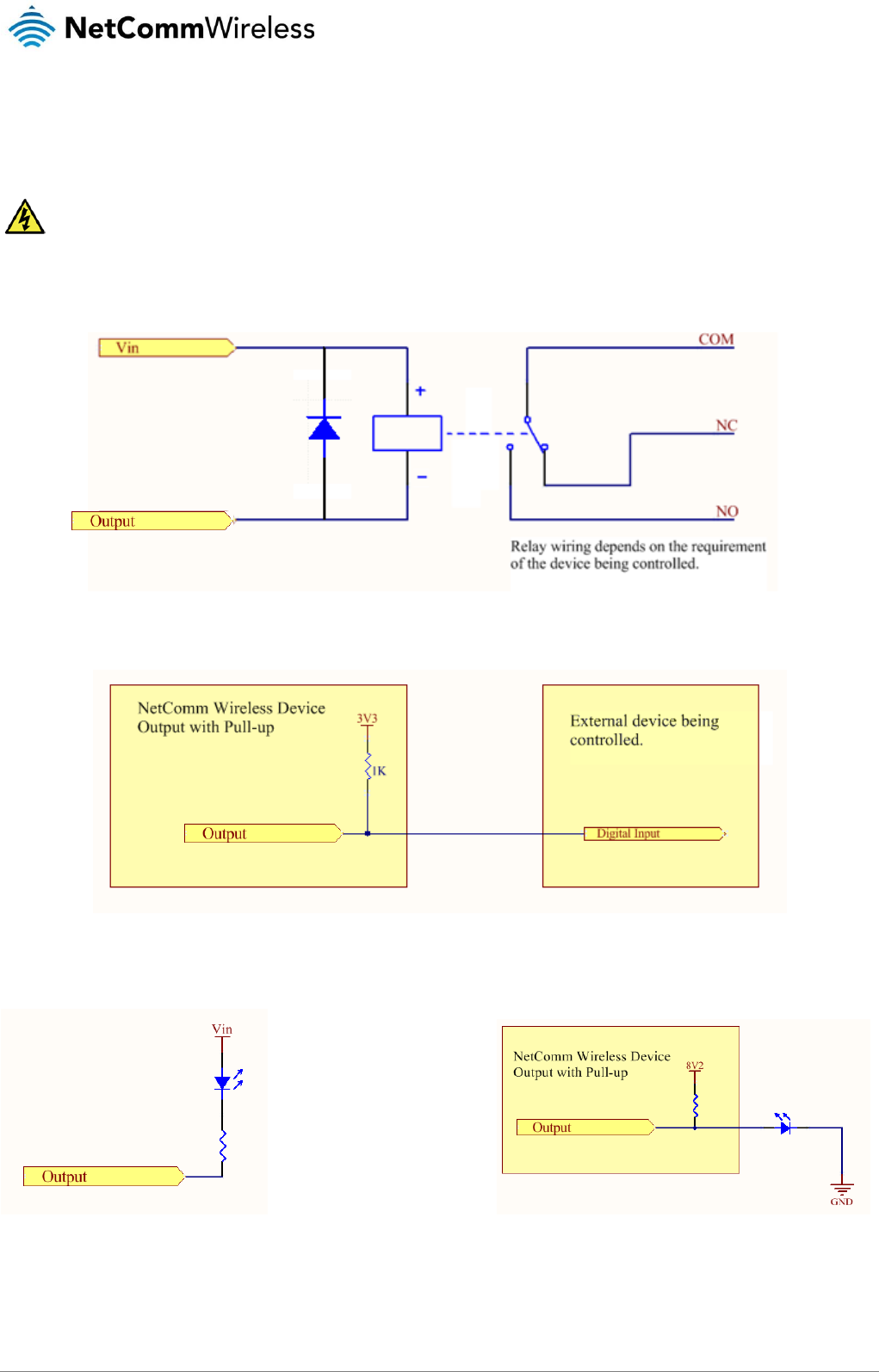
www.netcommwireless.com
NetComm Wireless 4G M2M Router
143
v1.0
Wiring Examples
The following examples are shown as a guide as to what can be achieved by the I/O features. It is up to the system integrator to
have enough knowledge about the interface to be able to achieve the required results.
Note: NetComm Wireless does not offer any further advice on the external wiring requirements or wiring to particular
sensors, and will not be responsible for any damage to the unit or any other device used in conjunction with it. Using
outputs to control high voltage equipment can be dangerous. The integrator must be a qualified electrician if dealing with
mains voltages controlled by this unit.
Open Collector Output driving a relay
Any output can be configured to control a relay. This is an example where the transistor will supply the ground terminal of the
solenoid. External voltage is supplied to the other side of the solenoid.
Logic level Output
An output can be used with the pull up resistor to provide a logic level output which would be suitable to control an external digital
device.
LED Output
An LED can be controlled by simply providing an open collector ground to an externally powered LED Resistor value and Voltage
will need to suit the LED type used. Alternatively an LED can be powered using 8V2 via 1K resistor. The suitability of the LED will
need to be investigated.
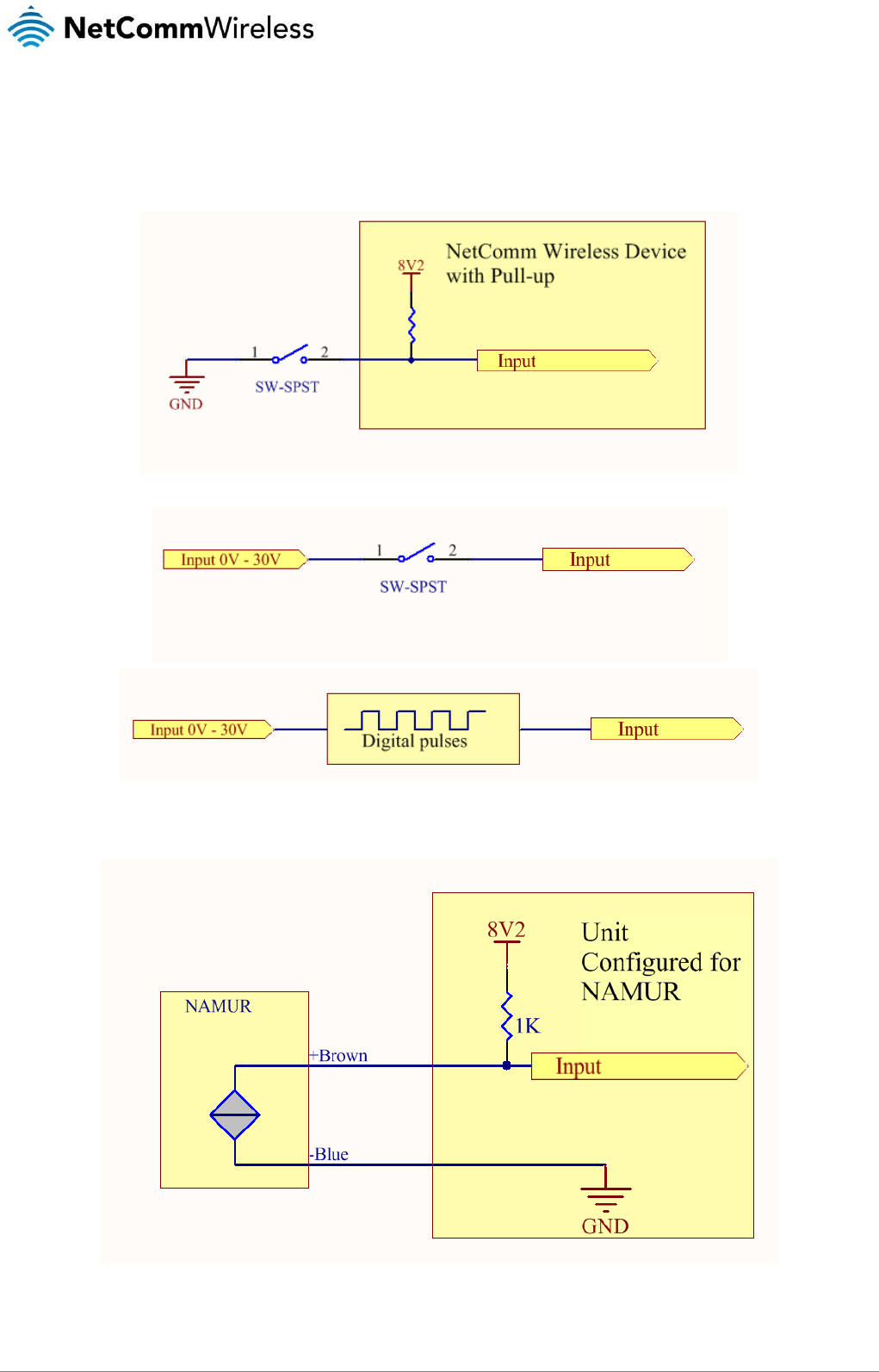
144
NetComm Wireless 4G M2M Router
www.netcommwireless.com
v1.0
Digital inputs
There are several ways to connect a digital input. A digital input can be anything from a simple switch to a digital waveform or
pulses. The unit will read the voltage in as an analogue input and the software will decode it in a certain way depending on your
configuration.
Below is a contact closure type input, which is detecting an Earth. Pull up is activated for this to work.
The following input detects an input going high. The turn on/off threshold can be set in the software.
NAMUR Sensor
A NAMUR sensor is a range of sensors which conform to the EN 60947-5-6 / IEC 60947-5-6 standards. They basically have two
states which are reflected by the amount of current running through a sense resistor.
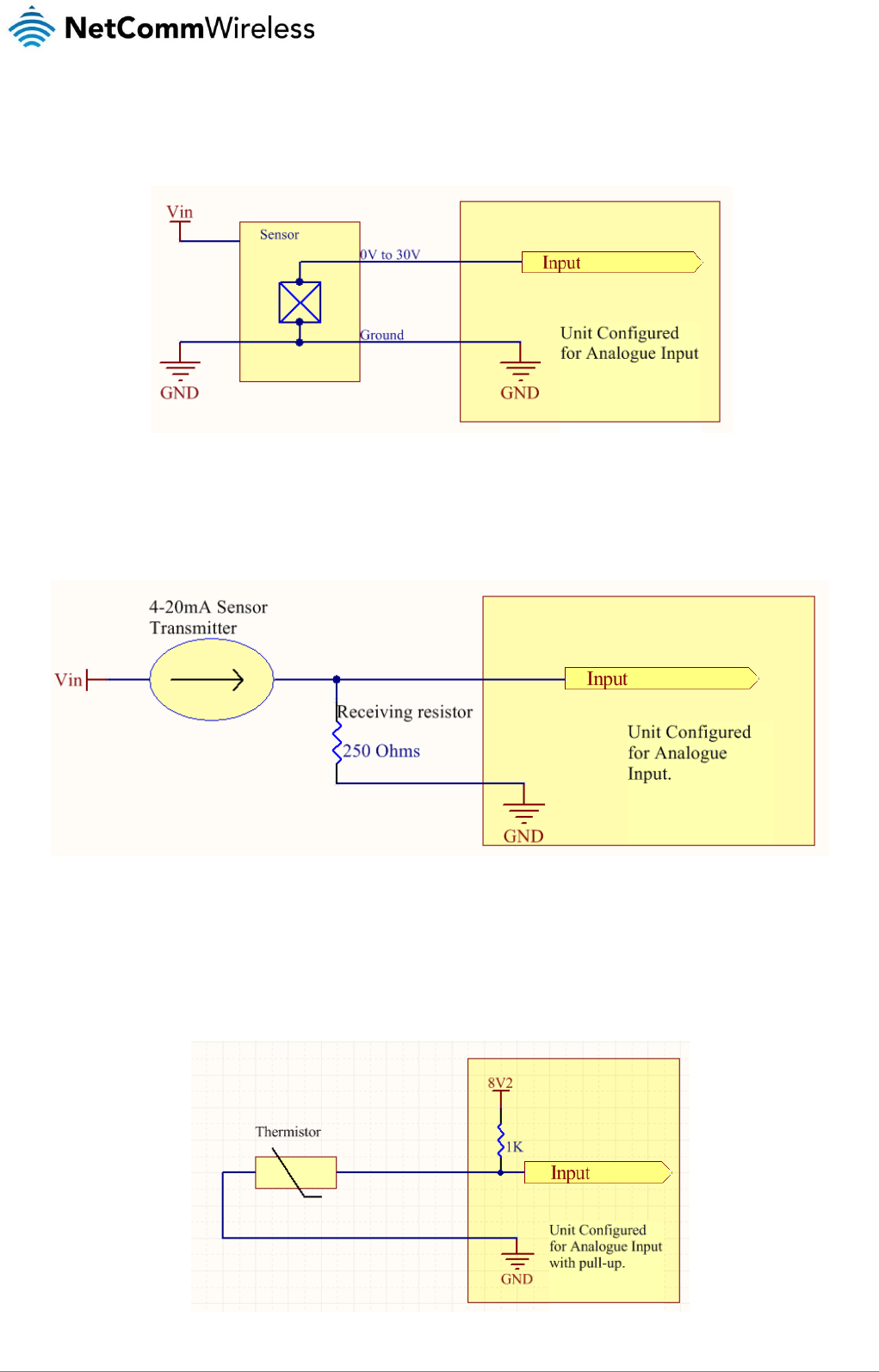
www.netcommwireless.com
NetComm Wireless 4G M2M Router
145
v1.0
Analogue Sensor with Voltage output
There are various analogue sensors that connect directly to the unit which can provide a voltage output. These would require an
external power source which may or may not be the same as the unit itself. The voltage range they provide can be between 0V and
30V. Some common sensor output ranges include 0V to 10V. The pull up resistor is not activated in this case.
Analogue Sensor with 4 to 20mA output
Another common type of sensor type is the 4-20mA current loop sensor. It provides a known current through a fixed resistor,
usually 250 ohms thus producing a voltage of 0v to 5V at the input. The sensor would require an external power source which may
or may not be the same as the unit itself. It will also require an external resistor. The internal pull up resistor is not activated.
Analogue Sensor with Thermistor
Some sensors work by changing resistance due to a change, such as temperature, light etc. These may be wired up to an external
or internal power source and the resistance can be read into the analogue signal. This will require some software calibration like
scaling or offset to map the voltage received to the sensor resistor value. An example below shows the internal pull-up voltage and
1K resistor activated. The voltage received depends on the combination of resistors and the value of the resistance of the sensor
itself.
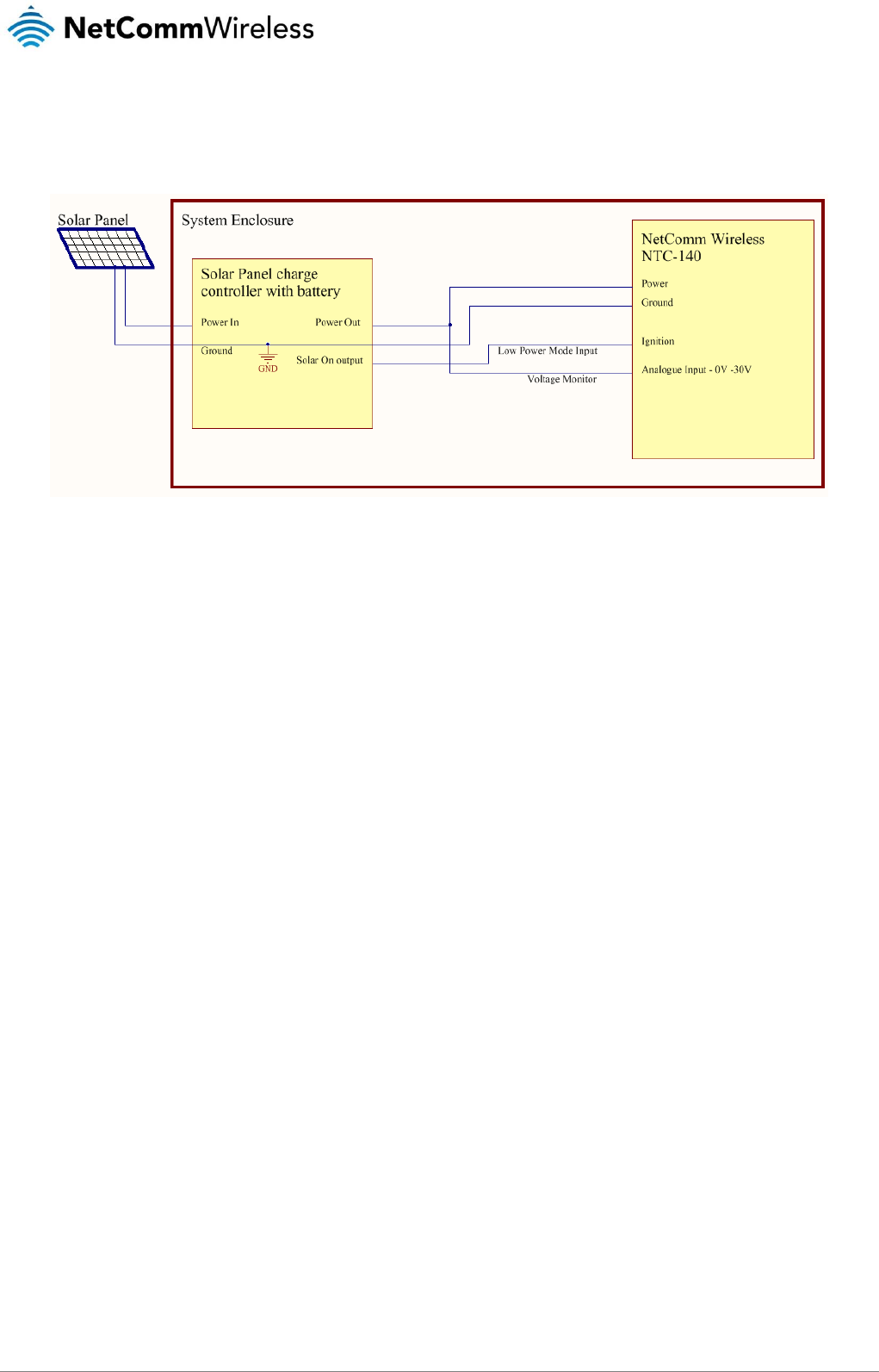
146
NetComm Wireless 4G M2M Router
www.netcommwireless.com
v1.0
System Example –Solar powered Router with battery backup
The previous examples of wiring can be used to come up with a system. The following test case is an example of how the I/O’s can
be used to enhance a simple router setup.
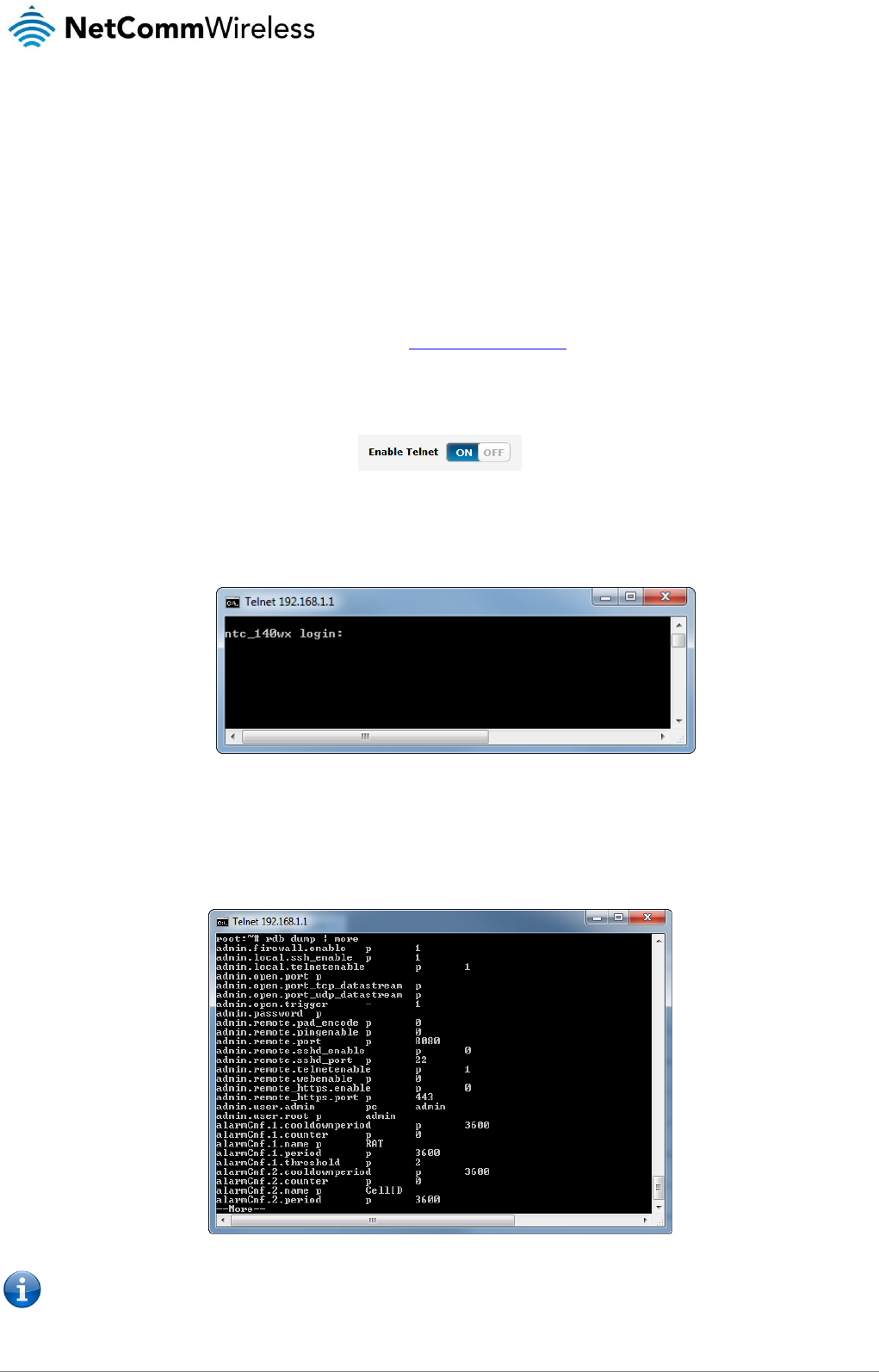
www.netcommwireless.com
NetComm Wireless 4G M2M Router
147
v1.0
Appendix H: Obtaining a list of
RDB variables
The RDB is a database of variables that contain settings on the router. You can retrieve (get) and set the values of these variables
through the command-line or via SMS Diagnostics. To access a full list of the RDB variables, follow these steps:
1. Log in to the web user interface as described in the Advanced configuration section of this guide.
2. Click the System menu at the top of the screen, then select the Administration menu on the left. Finally, select the
Administration settings menu item.
3. Click the Enable Telnet toggle key so that it is in the ON position.
4. Under the Telnet/SSH account section, enter a telnet password and then re-enter it in the Confirm password field.
5. Click the Save button at the bottom of the screen.
6. Open a terminal client such as PuTTY and telnet to the router using its IP address.
7. At the login prompt, type root and press Enter. At the password prompt, enter the password that you configured in step
4.
8. At the root prompt, enter the command rdb dump | more. This will display a list of every rdb variable on the router one
page at a time.
Note: Omitting the | more parameter will dump a complete list without pagination. For easier access, some terminal clients
such as PuTTY have the ability to log all telnet output to a text file.

148
NetComm Wireless 4G M2M Router
www.netcommwireless.com
v1.0
Appendix I: Using USB devices
and MicroSD™ cards
The NTC-140-01 router features a Micro USB 2.0 OTG port capable of supplying 0.5A to connected devices and a microSD™ card
slot allowing additional storage. The Micro USB port supports both USB storage devices as well as certain USB accessories,
including USB-to-Ethernet adapters and USB-to-Serial cables.
Accessing USB/SD card storage devices
When a USB storage device or microSD™ card is inserted, the router automatically mounts the storage. To access storage
devices:
Windows
1. Open Windows Explorer.
2. In the address bar, type in the network address of the router (\\my.router or \\192.168.1.1 by default), and press Enter.
The storage devices are labelled Disk A, Disk B or Disk C.
Mac OS
1. In Mac OS, open a Finder window.
2. Select Go -> Connect to Server.
3. Enter the server address smb://my.router or smb://192.168.1.1
4. Select the volumes you want to mount. Storage devices are labelled Disk A, Disk B or Disk C.
Linux / Smartphones
You can use any Samba client on Linux and Smartphones to access the connected storage devices by navigating to “my.router” or
“192.168.1.1” in your chosen Samba client.
Host and Device mode
The USB port automatically detects whether to run in host or device mode. When in host mode, the router automatically mounts
USB storage devices. When in device mode, the router supports Ethernet over USB. It is also possible to configure the USB
Ethernet port as a WAN port.

www.netcommwireless.com
NetComm Wireless 4G M2M Router
149
v1.0
Safety and product care
RF Exposure
Your device contains a transmitter and a receiver. When it is on, it receives and transmits RF energy. When you communicate with
your device, the system handling your connection controls the power level at which your device transmits.
This device meets the government’s requirements for exposure to radio waves.
This device is designed and manufactured not to exceed the emission limits for exposure to radio frequency (RF) energy set by the
Federal Communications Commission of the U.S. Government.
This equipment complies with radio frequency (RF) exposure limits adopted by the Federal Communications Commission for an
uncontrolled environment. This equipment should be installed and operated with minimum distance 30 cm between the radiator &
your body.
Déclaration d'exposition aux radiations:
Cet équipement est conforme aux limites d'exposition aux rayonnements IC établies pour un environnement non contrôlé. Cet
équipement doit être installé et utilisé avec un minimum de 30 cm de distance entre la source de rayonnement et votre corps.
Tout gain d'antenne externe doit répondre l'exposition aux radiofréquences et les limites de puissance de sortie maximum rayonnée
de la section de la règle applicable. Le gain maximal de l'antenne de cet appareil est:
Conformément à la réglementation d'Industrie Canada, le présent émetteur radio peut fonctionner avec une antenne d'un type et
d'un gain maximal (ou inférieur) approuvé pour l'émetteur par Industrie Canada. Dans le but de réduire les risques de brouillage
radioélectrique à l'intention des autres utilisateurs, il faut choisir le type d'antenne et son gain de sorte que la puissance isotrope
rayonnée quivalente (p.i.r.e.) ne dépassepas l'intensité nécessaire à l'établissement d'une communication satisfaisante.
Le présent émetteur radio FCC ID: XIA-NTC140W, IC: 8847A-NTC140W a été approuvé par Industrie Canada pour fonctionner
avec les types d'antenne énumérés ci-dessus et ayant un gain admissible maximal et l'impédance requise pour chaque type
d'antenne. Les types d'antenne non inclus dans cette liste, ou dont le gain est supérieur au gain maximal indiqué, sont strictement
interdits pour l'exploitation de l'émetteur.
External antenna
Any optional external antenna used for this transmitter must be installed to provide a separation distance of at least 30 cm from all
persons and must not be co-located or operated in conjunction with any other antenna or transmitter. Please consult the health and
safety guide of the chosen antenna for specific body separation guidelines as a greater distance of separation may be required for
high-gain antennas.
Any external antenna gain must meet RF exposure and maximum radiated output power limits of the applicable rule section. The
maximum antenna gain for this device is:
NTC-140-01
WWAN: 3.03 dBi (1710-1855MHz)
WLAN: 2dBi
Type d’antenne WLAN: Antenne dipolaire
NTC-140-01
WWAN: 3.03 dBi (1710-1855MHz)
WLAN: 2dBi
WLAN antenna type: Dipole antenna

150
NetComm Wireless 4G M2M Router
www.netcommwireless.com
v1.0
Under Industry Canada regulations, this radio transmitter may only operate using an antenna of a type and maximum (or lesser) gain
approved for the transmitter by Industry Canada. To reduce potential radio interference to other users, the antenna type and its gain
should be so chosen that the equivalent isotropically radiated power (e.i.r.p.) is not more than that necessary for successful
communication
This radio transmitter FCC ID: XIA-NTC140W, IC: 8847A-NTC140W has been approved by Industry Canada to operate with the
antenna types listed below with the maximum permissible gain and required antenna impedance for each antenna type indicated.
Antenna types not included in this list, having a gain greater than the maximum gain indicated for that type, are strictly prohibited for
use with this device.
CE Approval
This device has been tested to and conforms to the regulatory requirements of the European Union and attained CE Marking. The
CE Mark is a conformity marking consisting of the letters “CE.” The CE Mark applies to the products regulated by the central
European health, safety and environmental protection legislation. The CE Mark is obligatory for products it applies to: the
manufacturer affixes the marking in order to be allowed to sell their product in the European market.
The wireless device is approved to be used in the member states of the EU. NetComm Wireless declares that the wireless device is
in compliance with the essential requirements and other relevant provisions of the Radio and Telecommunications Terminal
Equipment Directive 1999/5/EC (R&TTE Directive). Compliance with this directive implies conformity to the following European
Norms – N 60950 – Product Safety, EN 301 489 EMC, EN301511 GSM RF, EN301908 UMTS RF, EN 62311 SAR Technical
requirement for radio equipment. A notified body has determined that this device has properly demonstrated that the requirements
of the directive have been met and has issued a favourable certificate of expert opinion. As such the device will bear the notified
body number 0682 after the CE mark.
The CE Marking is not a quality mark. Foremost, it refers to the safety rather than to the quality of the product. Secondly, CE
Marking is mandatory for the product it applies to whereas most quality markings are voluntary.
Marking: The product shall bear the CE mark, the notified body number(s) as depicted to the right.
NOTE: To comply with the RF exposure requirements, this equipment must be operated with a minimum of 30 cm separation from
the user.
This is a regulatory requirement and applies to all 3G capable devices meeting standard regulatory compliance such as the
compliance standards listed above.
FCC Statement
FCC compliance
Federal Communications Commission Notice (United States): Before a wireless device model is available for sale to the public, it
must be tested and certified to the FCC that it does not exceed the limit established by the government-adopted requirement for
safe exposure.
FCC regulations
This device complies with part 15 of the FCC Rules. Operation is subject to the following two conditions: (1) This device may not
cause harmful interference, and (2) this device must accept any interference received, including interference that may cause
undesired operation.
This device has been tested and found to comply with the limits for a Class B digital device, pursuant to Part 15 of the FCC Rules.
These limits are designed to provide reasonable protection against harmful interference in a residential installation. This equipment
generates, uses and can radiate radio frequency energy and, if not installed and used in accordance with the instructions, may
cause harmful interference to radio communications. However, there is no guarantee that interference will not occur in a particular
installation. If this equipment does cause harmful interference to radio or television reception, which can be determined by turning
the equipment off and on, the user is encouraged to try to correct the interference by one or more of the following measures:
Reorient or relocate the receiving antenna.
Increase the separation between the equipment and receiver.
Connect the equipment into an outlet on a circuit different from that to which the receiver is connected.
Consult the dealer or an experienced radio/TV technician for help.
Changes or modifications not expressly approved by the party responsible for compliance could void the user‘s authority to operate
the equipment.

www.netcommwireless.com
NetComm Wireless 4G M2M Router
151
v1.0
IC regulations
CAN ICES-3(B)/NMB-3(B)
This device complies with Industry Canada licence-exempt RSS standard(s). Operation is subject to the following two conditions:
(1) this device may not cause interference, and
(2) this device must accept any interference, including interference that may cause undesired operation of the device.
Le présent appareil est conforme aux CNR d’Industrie Canada applicables aux appareils radio exempts de licence. L’exploitation
est autorisée aux deux conditions suivantes:
(1) l’appareil ne doit pas produire de brouillage, et
(2) l’utilisateur de l’appareil doit accepter tout brouillage radioélectrique subi, même si le brouillage est susceptible d’en
compromettre le fonctionnement.”
This Class B digital apparatus complies with Canadian CAN ICES-3 (B)/NMB-3(B).
Cet appareil numérique de la classe B est conforme à la norme NMB-003 du Canada.
IMPORTANT NOTE:
IC radiation exposure statement:
This equipment complies with IC RSS-102 radiation exposure limits set forth for an uncontrolled environment. This equipment
should be installed and operated with minimum distance 30cm between the radiator and users body.
Electrical safety
Accessories
Only use approved accessories.
Do not connect with incompatible products or accessories.
Connection to a car
Seek professional advice when connecting a device interface to the vehicle electrical system.
Distraction
Operating machinery
Full attention must be given to operating the machinery in order to reduce the risk of an accident.

152
NetComm Wireless 4G M2M Router
www.netcommwireless.com
v1.0
Product handling
You alone are responsible for how you use your device and any consequences of its use.
You must always switch off your device wherever the use of a mobile phone is prohibited. Do not use the device without the clip-on
covers attached, and do not remove or change the covers while using the device. Use of your device is subject to safety measures
designed to protect users and their environment.
Always treat your device and its accessories with care and keep it in a clean and dust-free place.
Do not expose your device or its accessories to open flames or lit tobacco products.
Do not expose your device or its accessories to liquid, moisture or high humidity.
Do not drop, throw or try to bend your device or its accessories.
Do not use harsh chemicals, cleaning solvents, or aerosols to clean the device or its accessories.
Do not paint your device or its accessories.
Do not attempt to disassemble your device or its accessories, only authorised personnel must do so.
Do not use or install this product in extremely hot or cold areas. Ensure that the device is installed in an area where the temperature
is within the supported operating temperature range (-20°C to 70°C)
Do not use or install this product outside of the supported altitude range (Sea level to 2,000 metres).
Do not use your device in an enclosed environment or where heat dissipation is poor. Prolonged use in such space may cause
excessive heat and raise ambient temperature, which will lead to automatic shutdown of your device or the disconnection of the
mobile network connection for your safety. To use your device normally again after such shutdown, cool it in a well-ventilated place
before turning it on.
Please check local regulations for disposal of electronic products.
Do not operate the device where ventilation is restricted
Installation and configuration should be performed by trained personnel only.
Do not use or install this product near water to avoid fire or shock hazard. Avoid exposing the equipment to rain or damp areas.
Arrange power and Ethernet cables in a manner such that they are not likely to be stepped on or have items placed on them.
Ensure that the voltage, rated current and rated temperature of the power source match the requirements of the device. Do not
connect the device to an inappropriate power source.
Small children
Do not leave your device and its accessories within the reach of small children or allow them to play with it.
They could hurt themselves or others, or could accidentally damage the device.
Your device contains small parts with sharp edges that may cause an injury or which could become detached and create a choking
hazard.
Emergency & other situations requiring continuous connectivity
This device, like any wireless device, operates using radio signals, which cannot guarantee connection in all conditions. Therefore,
you must never rely solely on any wireless device for emergency communications or otherwise use the device in situations where
the interruption of data connectivity could lead to death, personal injury, property damage, data loss, or other loss.
Device heating
Your device may become warm during normal use.
Faulty and damaged products
Do not attempt to disassemble the device or its accessories.
Only qualified personnel must service or repair the device or its accessories.
If your device or its accessories have been submerged in water punctured or subjected to a severe fall, do not use until they have
been checked at an authorised service centre.

www.netcommwireless.com
NetComm Wireless 4G M2M Router
153
v1.0
Interference
Care must be taken when using the device in close proximity to personal medical devices, such as pacemakers and hearing aids.
Pacemakers
Pacemaker manufacturers recommend that a minimum separation of 15cm be maintained between a device and a pacemaker to
avoid potential interference with the pacemaker.
Hearing aids
People with hearing aids or other cochlear implants may experience interfering noises when using wireless devices or when one is
nearby.
The level of interference will depend on the type of hearing device and the distance from the interference source, increasing the
separation between them may reduce the interference. You may also consult your hearing aid manufacturer to discuss alternatives.
Medical devices
Please consult your doctor and the device manufacturer to determine if operation of your device may interfere with the operation of
your medical device.
Hospitals
Switch off your wireless device when requested to do so in hospitals, clinics or health care facilities. These requests are designed to
prevent possible interference with sensitive medical equipment.
Interference in cars
Please note that because of possible interference to electronic equipment, some vehicle manufacturers forbid the use of devices in
their vehicles unless an external antenna is included in the installation.
Explosive environments
Petrol stations and explosive atmospheres
In locations with potentially explosive atmospheres, obey all posted signs to turn off wireless devices such as your device or other
radio equipment.
Areas with potentially explosive atmospheres include fuelling areas, below decks on boats, fuel or chemical transfer or storage
facilities, areas where the air contains chemicals or particles, such as grain, dust, or metal powders.
Blasting caps and areas
Turn off your device or wireless device when in a blasting area or in areas posted turn off “two-way radios” or “electronic devices” to
avoid interfering with blasting operations.
